Australian
and international
exploratory
performance and
media arts
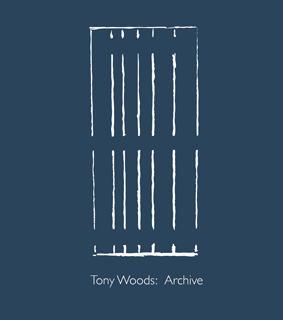
Book & DVD: Tony Woods: Archive
This large format book features excellent reproductions of this leading Melbourne artist’s works along with a DVD of his films and a documentary about the artist and their making. In her review of the book, Danni Zuvela writes:
“We are drawn into this complex and talented artist’s world, given access to his creative inspiration and evolution at a deeper level than other modes of artist biography that might sacrifice depth for gloss. Invited to muse on the aesthetic and conceptual relations between the artist’s practice across canvas, celluloid, pixels and audio tape, we start to develop insights into how the dialectic of representation and abstraction powers an artist like Tony Woods, finding varied expression across forms, materials and decades… Tony Woods: Archive, with its detailed understanding of an artist whose work should be more widely known, is a rare and worthwhile addition to the annals of Australian art history.”
1 copy of Tony Woods: Archive, courtesy of publisher www.artinfo.com.au and distributor Australian Scholarly Publishing ASP.
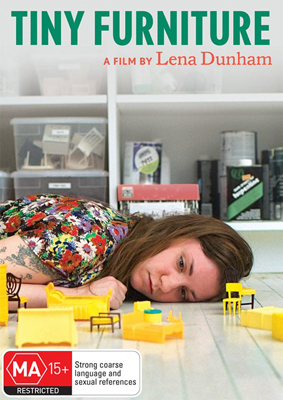
DVD: Lena Dunham, Tiny Furniture
We first heard of Lena Dunham’s film Tiny Furniture a couple of years ago from one of those succinct reviews at the front of The New Yorker. Now the film is finally available in Australia, no doubt due to the fact that since 2010 when she made the film, Dunham has created the wickedly funny and brutally frank hit TV series Girls.
In Tiny Furniture you not only see the emergence of the 20-something preoccupations and anxieties that govern Girls, you’ll also meet Dunham’s mother—the artist/photographer Laurie Simmons—and sister who play themselves. If you’re a fan of Girls you won’t want to miss this low key but fascinating precursor.
5 copies courtesy of Transmission Films
Please note you can nominate for ONLY ONE GIVEAWAY.
Email us at giveaways@realtimearts.net with your name, postal address and phone number.
Include ‘Giveaway’ and the name of the item in the subject line.
RealTime issue #117 Oct-Nov 2013 pg. 48
© RealTime ; for permission to reproduce apply to realtime@realtimearts.net
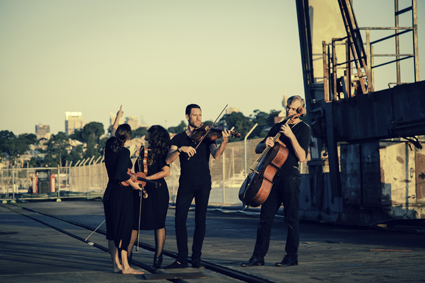
Mirabai Peart, Veronique Serret, James Eccles, Ollie Miller, The NOISE
photo Andrew Wholley
Mirabai Peart, Veronique Serret, James Eccles, Ollie Miller, The NOISE
After six years honing his viola playing skills in Berlin, James Eccles returned to Australia with an unusual ambition—to pursue a career in improvisational music-making in the contemporary classical music idiom and beyond. In the 18th and 19th century musicians and, not least, composers would be expected to publicly extemporize. In a return to tradition, Eccles is however not looking to the past so much as creating new musical possibilities for the future, realised in performances by The NOISE string quartet, which he leads, and its collaborators.
Ambition—and courage—are signalled by The NOISE’s latest venture, Composed NOISE: seven newly commissioned string quartets to be performed over two nights in Sydney’s Cellblock Theatre. These works by Australian composers— Andrew Ford, Rosalind Page, Paul Cutlan, Lyle Chan, Andrew Batt-Rawden, Alex Pozniak and Amanda Cole—“have been created through a collaborative process of workshopping and improvising, where the performers and composers function as equals. In this innovative process, performers become co-writers of the work, through their ability to improvise (or compose in real time)” (press release).
The NOISE
I met with Eccles to discuss Composed NOISE, but first asked about the musical background of the quartet’s players. The NOISE is made up of classically trained violinists Veronique Serret and Mirabai Peart, violist James Eccles and cellist Ollie Miller. Peart also has a busy career playing in the free-improvising Splinter Orchestra, jazz groups and the world music collective Tapestries of Sound. Miller, who plays classical and jazz piano as well as percussion is a member of the jazz group Amphibious. Having played with the Malaysian Philharmonic, the Tasmanian Symphony Orchestra and the ACO, Serret has also been a core member of Ensemble Offspring, was a founding member of the electronic/rock/classical band CODA and plays amplified violin for Inga Liljestrom’s band, elk. Eccles has played with Judy Bailey, DJ Spooky, Sydney Philharmonia Orchestra, Taikoz and Ensemble Offspring among others. With Miller he does an “avant garde rock thing,” performing recently at the VIVID festival in collaboration with electric guitarist Zane Banks. Soon Eccles and Miller will improvise over drones created by Julian Day as part of Day’s Infinity Room project.
The NOISE took shape, says Eccles, “after three of us were inspired by a Necks concert at the beginning of 2008. We found another violinist, started out as very much a little fun project and after several jam sessions said, let’s do a gig. There was a push factor from playing a lot of contemporary music and struggling with notes all the time, which can be great—it’s its own challenge. But we wanted to make our own music, to be creative and get a real kick out of it.”
Dealing wild cards
I ask Eccles about the kinds of improvisation involved in playing the seven quartets in Composed NOISE. He tells me that the degree of improvising varies considerably, from little to much, if in a variety of ways—sometimes where the composer has left space, or one or two players might improvise against the notated playing of the others, or when the composer might specify notes but not some other aspect of realization, like texture. However, for the quartet an important component of Composed NOISE has been the compositional-collaborative process. “I’ve had various meetings with the composers, starting last year. Lyle Chan based his piece on the blackjack card game. I liked the idea but then thought, hang on, we’re a quartet let’s have a real four-person game and immediately thought of bridge and 500.
“So we play a game of 500 before we perform the piece and that becomes the score. Lyall did a really good job finding a balance between what the cards stipulate and adding other instructions on top of that. There are 10 tricks in a hand of 500, so it’s a 10-movement piece and each trick has a specific instruction—glissando, pizzicato non-vibrato etcetera. Particular cards carry instructions: suits dictate register—hearts is the highest—and a number card will dictate certain rhythmic or grouping parameters. The face cards are complex and solo-istic, so the stronger the card, the stronger your part, while a number card will suggest a more accompanying role.”
As well as having to learn these rules, the players have to handle another quite lateral stipulation: “that the person who leads off the trick leads off the movement; but before they play they have to think of a type of weather, hence the work’s title, Smoke Weather Stone Weather. You don’t tell anyone what you’re thinking, they just react to what you’re playing. So that’s a real curve ball.
“For the purpose of the first performance we’ll video the game the day before, given all the logistics we have to get our heads around. But it won’t be rehearsed. It’ll still be spontaneous. Lyall’s piece is the most like what we do as The NOISE, reacting in the moment. We’ll probably do it many, many times.”
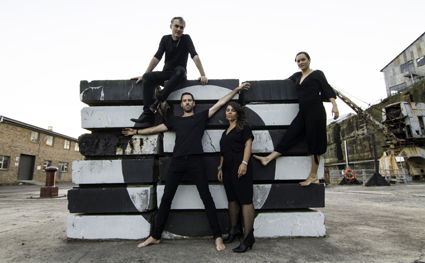
Ollie Miller, James Eccles, Veronique Serret, Mirabai Peart, The NOISE
photo Andrew Wholley
Ollie Miller, James Eccles, Veronique Serret, Mirabai Peart, The NOISE
Improvisation by degrees
Paul Cutlan’s contribution, Merge/Emerge, will also involve ample improvisation in a work “rooted in rhythm and harmony, in the tradition of Shostakovich and Britten, and with one delicious jazz moment when it comes.” The kinds of improvisation indicated in the score vary: “three of us will play the score with one player improvising, or there’ll be a bridging section with two people improvising and then we all come in and play a notated page and then one of us goes to a solo. Paul is a performer himself and really knew what we wanted to engage with and he knows the balance of how much to write and not write.”
Andrew Batt-Rawden has created “28” in which, says Eccles, the composer is “video-ed live writing the music—some of it pre-written over which he’ll overlay other elements as we play.” Alex Pozniak’s Force Fields, for amplified instruments, “ends with screaming feedback—a logical conclusion to a very intense piece. Some will love and some will hate it. It deserves to be picked up by other quartets. It’s more interpretive for us than improvisatory—Alex knows what he wants—but you have to determine how you might, say, make a stuttering effect on scratch tones.” Rosalind Page, Eccles tells me, “wrote her Master’s Thesis on Tarkvosky. Ollie’s also a big fan. I wasn’t convinced at first but now I’m a fan of The Mirror [1975], the film that’s inspired Rosalind’s piece, Zerkalo (Mirror). The film is autobiographical, about a father leaving his family, so each instrument plays a character—mother, child, father, poet—in musical dialogues. It’s hauntingly beautiful. Tarkovsky himself used soundscapes and music so strongly, referencing Bach. We’ll be improvising around some of the Pergolesi Stabat Mater.”
The other works in Composed NOISE are Amanda Cole’s Ecliptica and Andrew Ford’s String Quartet No 4, plus a bonus work by The NOISE themselves in the first concert of the two-night program. Ford’s composition was commissioned by Julian Burnside, while the other quartets were commissioned with funds from the Australia Council and those raised by The NOISE and Chronology Arts.
Ambition and freedom
Finally, I ask Eccles how ambitious he is for The NOISE. He laughs and says “Very!” But it’s no easy task given how busy the quartet members are. The goal is to work together one to two months a year, ideally on a major project like Composed NOISE but with an expanded palette that might include “a world music focus or an electric work or a studio album with overdubs.”
As for recordings, Composed NOISE will soon be available on CD and The NOISE has been recording Sydney-based composer George Lentz’s String Quartets—seven hours of it on NAXOS BluRay (apparently the only way to conveniently issue such a huge work). “It’s quite extraordinary playing beautiful chorale writing and improvising, providing source material for the mix—all tremolo, say, or all glissando. When we thought we were finished, George called to say he needed one more chorale section! It’s an installation work, but it might become a live performance,” says Eccles, apparently more excited than daunted by the work’s length.
I wonder if, after six years in Berlin, Eccles is happy working in Australia. He’s emphatically positive. “In Berlin it was mostly about learning to play the viola rather than being really creative—the good violist getting my viola chops up to work in an orchestras. I went to lots of Arditti Quartet concerts, but didn’t do much contemporary playing myself; it was mostly with orchestras doing Mozart and Beethoven. Here I’m a bit bigger fish in a smaller pond, I know the people, it’s my scene. I want to make things happen. It’s patriotic. I want to do things for Australian music. I’m inspired by nature and the sense of freedom here among my fellow collaborators.”
IMPORTANT NOTE: Due to a unforseen circumstances, the Composed NOISE concerts have had to be cancelled.
The CD Composed NOISE is now available on iTunes
For more information, www.thenoise.com.au; www.vexations840.com.
RealTime issue #116 Aug-Sept 2013 pg. web
© Keith Gallasch; for permission to reproduce apply to realtime@realtimearts.net
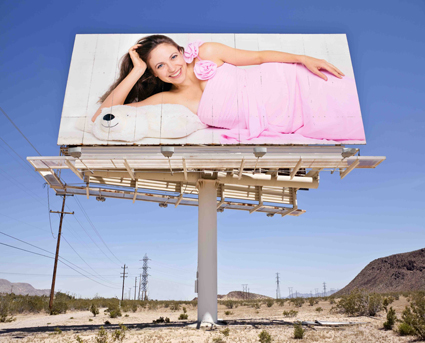
Nicola Gunn, In Spite of Myself
Melbourne Festival, quick picks from local works
The Melbourne Festival will kick off just before our next print edition hits the streets so here’s a run down of some of the local works. Particularly impressive are the number of festival co-commissions, nurturing Melbourne artists and the creation of exciting new performance experiences.
In Spite of Myself, Nicola Gunn, co-commission with Arts Centre Melbourne
Nicola Gunn and the Sans Hotel team have been in residence at the Arts Centre dreaming up an almost true life story for Gunn, presented as a faux retrospective of performance art titled Exercises in Hopelessness: Nicola Gunn (1979-present). Arts Centre Melbourne, Fairfax Studio; 9-13 October; http://www.artscentremelbourne.com.au/whats-on/event.aspx?id=3684
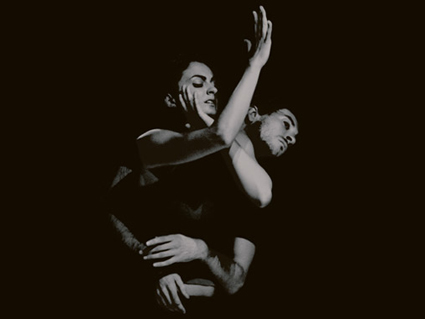
A Small Prometheus, Stephanie Lake & Robin Fox
photo Robin Fox
A Small Prometheus, Stephanie Lake & Robin Fox
A Small Prometheus, Stephanie Lake and Robin Fox, co-commission with Arts House
A dance work involving fire-driven kinetic sculptures and interactive sound. Arts House North Melbourne Town Hal 15-20 Oct; http://www.melbournefestival.com.au/program/genre/dance/a-small-prometheus.html
The Shadow King, co-commission with Malthouse
Michael Kantor and Tom E Lewis have co-created this Indigenous re-interpretation of King Lear melding “Shakespearian pathos with Aboriginal language, music and dance” (website). Malthouse, 11-27 Oct; http://www.melbournefestival.com.au/program/genre/theatre/the-shadow-king.html
M+M, co-commission with Theatre Works
Daniel Schlusser tackles Mikhail Bulgakov’s The Master and Margarita. Theatre Works, 8-16 Oct; http://www.melbournefestival.com.au/program/genre/theatre/mm.html
Room of Regret, co-commission with Theatre Works
The Rabble takes on Oscar Wilde’s The Picture of Dorian Gray filtering it through performance art, installation and audience interaction. Theatre Works, 21 Oct – Nov 3; http://www.melbournefestival.com.au/program/genre/theatre/room-of-regret.html
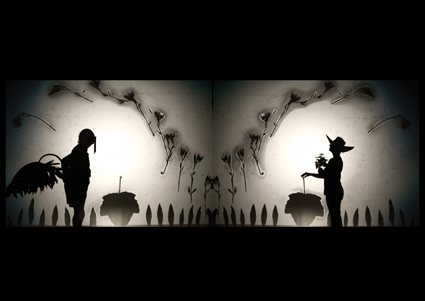
Sonic Flock, Click Clack Project
courtesy the company
Sonic Flock, Click Clack Project
Sonic Flock, Click Clack Project, presented by Footscray Community Arts Centre and the University of Melbourne
Enter a tee-pee and experience intimate music performed just for you. Over at Footscray Arts Centre there’ll also be performances by the Amplified Elephants, Rawcus and visiting Japanese sound artists. Atrium, Federation Square & Footscray Arts Centre, 12-13 Oct; http://www.melbournefestival.com.au/program/genre/music-classical/the-sonic-flock.html
The Black of the Star (Le Noir de L’Etoile), presented by Speak Percussion and SIAL Sound Studios
A percussion masterpiece by French composer Gérard Grisey featuring the pulses of neutron stars. (See review from Totally Huge 2011) Deakin Edge, Federation Square, 16-17 Oct; http://www.melbournefestival.com.au/program/genre/music-contemporary/the-black-of-the-star.html
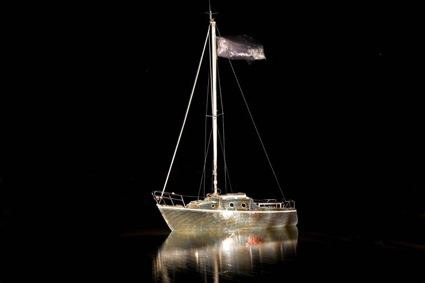
Celestial Radio 2012, Zoe Walker and Neil Bromwich, originally commissioned by Performance Space and the Museum of Contemporary Art Australia with the support of the Keir Foundation
photo Colin Gray
Celestial Radio 2012, Zoe Walker and Neil Bromwich, originally commissioned by Performance Space and the Museum of Contemporary Art Australia with the support of the Keir Foundation
Niteworks, Bundanon
This year’s Siteworks at Bundanon Trust’s Riversdale complex will be a Niteworks. The star of the evening will in fact be the stars with a presentation by scientists from the Anglo Australian Observatory. The Shoalhaven Astronomers club will also be bringing their telescopes for audience members to peer at the heavens. David Haines and Joyce Hinterding will create sounds via natural VLF transmissions and Nancy Mauro-Flude and Linda Dement will conduct a starlight séance of sorts calling up recently deceased rockers Ari Up (The Slits), Poly Styrene (X-Ray Specs) and Chrissie Amphlett (Divinyls). UK artists Zoe Walker and Neil Bromwich will sail their glittering vessel transmitting Celestial Radio sounds down the Shoalhaven and Diego Bonetto and Caterina Mocciola will take the audience on a moonwalk. There’s also the option of some rustic overnight camping.
The Bundanon Trust, Niteworks, Riversdale, 12 Oct; https://www.bundanon.com.au/siteworks
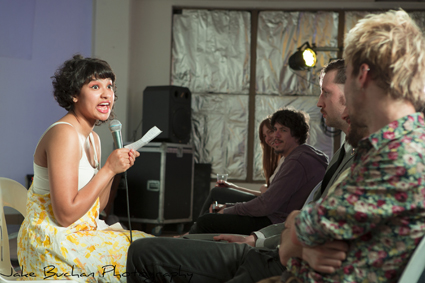
Nicole Henriksen. (For the 2013 festival Nicole will be performing a piece enticingly titled Naked Unicorn Vomit.)
courtesy Cracked Theatre Festival
Nicole Henriksen. (For the 2013 festival Nicole will be performing a piece enticingly titled Naked Unicorn Vomit.)
This Is Not Art, Newcastle
It’s the time of year to head north to Newcastle to experience the multi-headed beast that is This Is Not Art. This year the Crack Theatre Festival showcases a diverse selection of performances ranging across “circus, dance, cabaret, verbatim theatre, installation, multi media, comedy and live art” (press release). The National Young Writer’s Festival provides activities for budding scribes, including a writing workshop on the streets of Newcastle in the Paper Trail Tour, a Penguin Plays Rough presentation in the tunnels of Fort Scratchely, plus tips from celebrity chef Adam Liaw on cook book writing. The quiet achiever of TINA, the creative research symposium Critical Animals offers an impressive program of artists and thinkers including Tega Brain, Julian Day, Erica Secombe and Ben Kolaitis. There’s also the return of prodigal festival Electrofringe, presenting a day of showcases and the final festival party.
This Is Not Art, Newcastle, NSW 3-6 Oct; http://thisisnotart.org/
Festival of Toy Music, Brisbane Powerhouse
Curated by the tricksters of new music, Clocked Out, the Festival of Toy Music will feature performances by Margaret Leng Tan from the US (the queen of the toy piano we’re told), plus Australian musicians Matthew Horsley, Adam Simmonds, Clocked Out and of course there’s no show without the circuit-bent Barbies of Toy Death. There’s also a Dream Percussion installation sited in the Turbine Hall and available for everyone to unleash their inner percussionist.
Festival of Toy Music, 5 Oct, Brisbane Powerhouse; http://brisbanepowerhouse.org/events/2013/10/05/festival-of-toy-music/
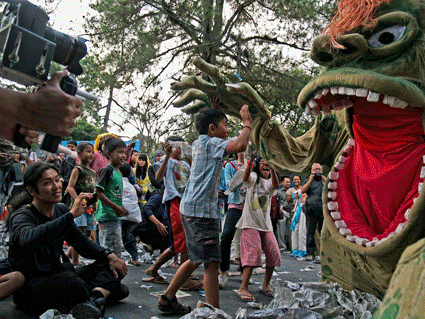
Wedhus Gembel, Snuff Puppets
Wedhus Gembel, Snuff Puppets
Wedhus Gembel is a long-time collaboration between the Snuff Puppets and a range of Indonesian artists. An outdoor performance, it’s “a parable about the cycle of life, the destructive power of nature and how innocence and beauty can be disguised in a monster” (website). Premiering in Yogyakarta and Jakarta in 2011, the wild mega-puppet antics of Wedhus Gembel will have its Australian debut at Federation Square featuring six guest artists from Indonesia.
Wedhus Gembel, Snuff Puppets, Federation Square Amphitheatre, 2-5 Oct; http://www.snuffpuppets.com/shows/Wedhus_Gembel
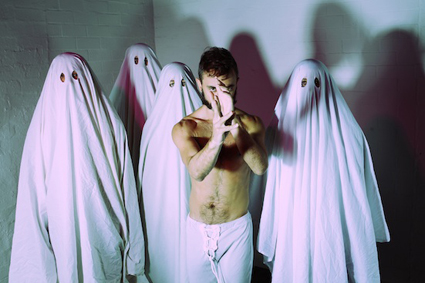
Not About Face, Luke George and collaborators
photo Jeff Busby
Not About Face, Luke George and collaborators
Not About Face, Luke George
In RT115 Rennie McDoougall gave us a sneak peak of Luke George’s work in development, Not About Face. “[T]he audience enters a rehearsal studio like cheap Halloween ghosts, donning bedsheets with eyeholes cut out…George, at first unidentifiable from the rest of us ‘ghosts,’ eventually emerges to claim his presence as shepherd to our flock. Once revealed he undergoes a series of transformations: channelling deceased performers, communing with a past version of himself through a television set and guiding us into summoning incantations of colour, to name a few.” George and collaborators are now ready to present the show to live a be-shrouded public at Dancehouse.
Luke George and Collaborators, Dancehouse, Melbourne, 9-13 Oct; http://www.dancehouse.com.au/performance/performancedetails.php?id=165
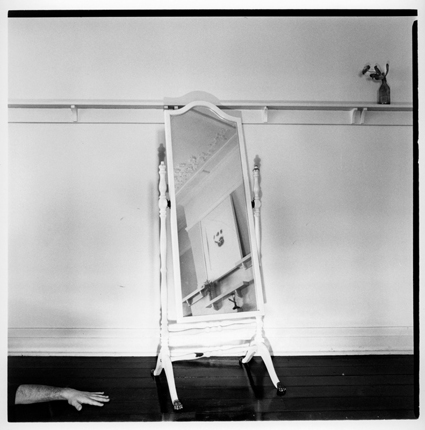
Aaron Bradbrook, Borderlands
© the artist
Aaron Bradbrook, Borderlands
Aaron Bradbrook, Perth Centre for Photography
Aaron Bradbrook is the 2012 winner of the Perth Centre for Photography’s UNCOVER Award which offers an emerging artist printing support, mentorship and a solo exhibition. Bradbrook’s exhibition Borderland focuses on the house as a site of endless playful possibilities, but also suggests a darker side as people appear only as segmented body parts. Bradbrook writes, “Like the subjects themselves, I want the viewer to feel they are being held captive in another world, a world in which they cannot leave” (press release).
Aaron Bradbrook, Borderland, Perth Centre for Photography,
26 Sept – 26 Oct, http://www.pcp.org.au
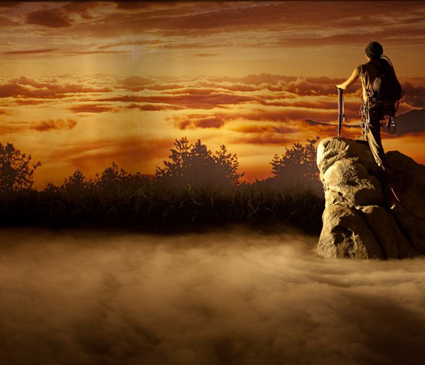
Yeondoo Jung, Documentary Nostalgia, video still, 2007
Yeondoo Jung, MAAP Space
The next exhibtion at MAAP Space in Brisbane presents South Korean artist Yeondoo Jung. Jung creates ambitious video works that explore memory truth and construction. The centerpiece of the exhibition is Documentary Nostalgia. shot in a single 84-minute take. Various scenes from the artist’s memory are literally constructed as theatre sets. More intimate in scale is Twilight Seoul created in collaboration with German artist Luka Fineisen. Using materials lying around in the studio the artists recreate by hand a scene of the hills around Seoul.
Yeondoo Jung, MAAP Space, 27 Sept-8 Nov; http://www.maap.org.au/projects/maap-space/yeondoo-jung/
in/Visible Women, Magdalena Australia
So if Tony Abbot is Minister for Women, it’s time to get a little forthright about women’s issues. Magdalena Australia, a coalition of female arts workers, is a long time advocate for women in the arts, but given the current political climate they are stepping up their activities. In particular they are responding to what they’ve identified as “an apparent lack of strong images of women in the printed program” of the current Brisbane Festival (press release). They will be presenting a Long Table discussion (a performative public talk format pioneered by Split Britches [US/UK]) around the visibility of women in performance. The discussion will be followed by a cabaret co-presented with Access Arts and Vulcana Women’s Circus.
Magdalena Australia Long Table, 27 Sept 5pm, cabaret 7pm; The Stores Studio, Brisbane Powerhouse; http://www.themagdalenaproject.org/en/content/invisible-women
Women’s issues continued… Live Art Development Agency
While we’re on the matter, the visibility of women in the arts is of course an international concern, one being addressed by a number of upcoming activities by London’s Live Art Development Agency. Through their Restock, Rethink, Reflect (RRR) series they’ll be presenting Just like a Woman, a program of talks and performances as part of the City of Women Festival in Ljubljana (Slovenia, 11-12 Oct). Back in London, Lois Weaver, inventor of the Long Table discussion format, will present a Long Table about Live Art and Feminism (16 Oct). Then the LADA partnership project Re.act, a performance archive of “feminist, gendercritical and queer performance art” (website) will return to Berlin, after a tour of Europe collecting even more material. Check out the website for workshops, performances, talks and other activities.
http://www.thisisliveart.co.uk/
Still in the loop
OzAsia, Adelaide Festival Centre
13-29 Sept
http://www.ozasiafestival.com.au/
Art and About, City of Sydney
20 Sept-20 Oct
http://www.artandabout.com.au/; http://metroscreen.org.au/whatson/
Gigi Scaria, Dust, Ian Potter Museum
18 September 2013 – 2 February 2014
http://www.art-museum.unimelb.edu.au/
Memory Collective, Toowoomba Art Gallery
Memory Collective, Toowoomba Art Gallery, 21 Sept-5 Nov; http://ww2.toowoombarc.qld.gov.au
User Generated Architecture, Tin Sheds Gallery
27 September-15 November
http://emergencity.net/user-generated-architecture/
Super Discount, Back to Back, STC, Malthouse
Sydney Theatre Company
20 Sept-19 Oct
http://www.sydneytheatre.com.au/what’s-on/productions/2013/super-discount.aspx
Nought, ADT, Samstag Museum
25 -27 Sept
http://adt.org.au/; http://w3.unisa.edu.au/samstagmuseum/
Kate Murphy, Probable Portraits
Shepparton Art Museum (SAM), 13 Sept-14 Nov
http://www.sheppartonartmuseum.com.au/
Open Frame, Room40
Brisbane Powerhouse and various venues
12-28 Sept
http://openframe.room40.org/2013
Craig Walsh, Embedded & Primavera, MCA
12 Sept-24 Nov
http://www.mca.com.au/
ikono On Air Festival
global, online
6-29 September
http://ikono.org/festival/
2013 Brisbane Festival
7-28 Sept
http://www.brisbanefestival.com.au/
arte magra: from the opaque, AEAF
5 Sept-5 Oct
http://www.aeaf.org.au/exhibitions/ArteMagra.html
The boat goes over the mountain, Happy Dagger Theatre
The Blue Room, Perth
10-28 Sept
http://blueroom.org.au/events/the-boat-goes-over-the-mountain/
Windows to the Sacred, S.H. Ervin Gallery
presented in association with Buratti Fine Art; 30 Aug-29 Sept
http://www.shervingallery.com.au/
Malthouse’s Helium
Little Ones Theatre, Salomé, 30 Aug-14 Sept
Smack! Bang, City of Shadows, Rachael Dease, 21 Sept-5 Oct
http://www.malthousetheatre.com.au/helium-2013/
In Confidence: Reorientations in Recent Art, PICA
31 Aug-13 Oct
http://www.pica.org.au
RealTime issue #116 Aug-Sept 2013 pg. web
© RealTime ; for permission to reproduce apply to realtime@realtimearts.net
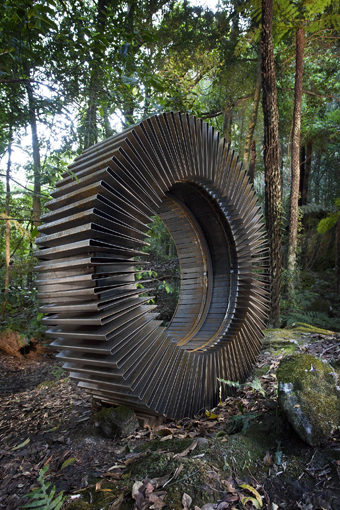
Al Phemister, Kern, Sculpture at Scenic World
photo Keith Maxwell
Al Phemister, Kern, Sculpture at Scenic World
Sculpture at Scenic World 2014
There’s still time to submit proposals for the annual Sculpture at Scenic World in the Blue Mountains which sees up to 40 works installed on the floor of the Jamieson Valley (see review of 2013 exhibition http://www.realtimearts.net/article/issue114/11099). The main acquisitive prize is $20,000 with a number of smaller awards. The 2014 exhibition (24 April-18 May) will also serve as the launch of a permanent sculpture commissioned from Ken Unsworth.
Applications due 14 Oct; http://www.scenicworld.com.au/experiences/sculpture/
Platform X: Transmedia Storyworld Writing, AWG
The Australian Writers’ Guild is seeking writers interested in interactive and multi-platform story telling to take part in Platform X: Transmedia Storyworld Writing. Eight writers from NSW and ACT will be selected for a three-day master class (30 Nov, 1 Dec, 7 Dec) run by Mike Jones, head of story development for Portal Entertainment UK and co-author of the multiplatform project Bloodline for publisher Simon & Schuster.
Applications due 17 Oct; http://awg.blacklight.com.au/images/pdfs/Platform%20X%20Entry%20Form%20and%20Guidelines.pdf
Still in the loop
raumlabor, Tin Sheds Gallery
Workshop 12-13 Oct (plus one day ATSC workshop induction if required 11 Oct); http://emergencity.net/special-workshop-with-raumlabour-berlin-book-now/
Nude models, Deborah Kelly, Sydney Biennale
Volunteers as portrait subjects, please send a picture of your face (only) to kellyproject@biennaleofsydney.com.au by Friday, 11 October 2013. For collage workshops, please send expressions of interest to frances@biennaleofsydney.com.au
Public Art major works, City of Sydney
Expressions of Interest due 31 October; http://www.cityartsydney.com.au/cityart/news/?p=1739
Revelation Film Festival 2014
Entries close 11 April 2014 http://www.revelationfilmfest.org/go/news/call-for-entries-now-open
Blacktown Arts Centre Residencies
Applications close 30 Sept
http://www.artscentre.blacktown.nsw.gov.au/performance/2014-performing-arts-residencies.cfm
Fisher’s Ghost Prize, Campbelltown Arts Centre
Entries due 4 Oct, 2013
http://www.campbelltown.nsw.gov.au/FishersGhostArtAward
House Proud 2014, Boroondara City Council
Applications close 30 Sept
http://www.boroondara.vic.gov.au/our-city/arts-culture/kewcourthouse/house-proud
version 1.0 masterclass
Masterclass 19 Oct, and bookings now open.
http://www.trybooking.com/Booking/BookingEventSummary.aspx?eid=60167
Melbourne White Night
Submissions close 1 Oct 2013
http://whitenightmelbourne.com.au/
Fast+Fresh Dance, FORM Dance
Registration closes 14 October
http://form.org.au/2013/01/fastfresh-dance-2/
FlickerFest call for entries
Deadline for Australian & International entries 11 Oct; for GreenFlicks & FlickerUp 18 Oct
http://www.flickerfest.com.au/
Next Generation Placement, ASSITEJ
Deadline for applicants 30 Sept
http://www.assitej-international.org/next-generation/
Forever Now
Applications open until June 2015
http://forevernow.me/
Selected Australia Council Grants
for full list see http://www.australiacouncil.gov.au/grants
Emerging and Experimental Arts – 4 October, 2013
http://www.australiacouncil.gov.au/grants/2013/experimental-arts-grants-4-october
RealTime issue #116 Aug-Sept 2013 pg. web
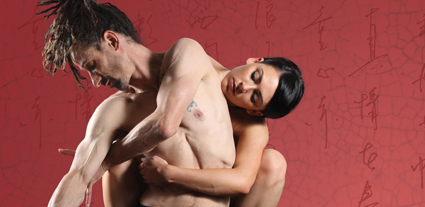
Leigh Warren Dance, Not According to Plan
OzAsia, Adelaide Festival Centre
The annual OzAsia festival is already in full swing, but there are plenty of festivities still to come. Leigh Warren Dance presents the premier of Not According to Plan, following the journey of dancer, photographer, choreographer and calligrapher Xiao Xiong Zhang “from a life of unimaginable isolation into one of a worldwide dance family” (website). There’s a mini-focus on Malaysia with Parah by Instant Café Theatre looking at the hidden political rifts in Malaysian society, and SuperEverything*, a live cinema collaboration between UK video outfit The Light Surgeons and Malaysian artists Ng Chor Guan, Hands Percussion and Rhythm in Bronze. Touching down in Adelaide on a national tour is Fight the Landlord, a collaboration between Ireland’s Pan Pan Theatre and Beijing’s Square Moon Culture performed in the round by ladies in panda suits (see review RT111). There’s also the quiet charmer Stories Then and Now directed by Annette Shun Wah and William Yang (see RT115). This weekend join the Moon Lantern festivities, and of course you wouldn’t want to miss Kamahl in concert!
Adelaide Festival Centre: OzAsia Festival, 13-29 Sept; http://www.ozasiafestival.com.au/
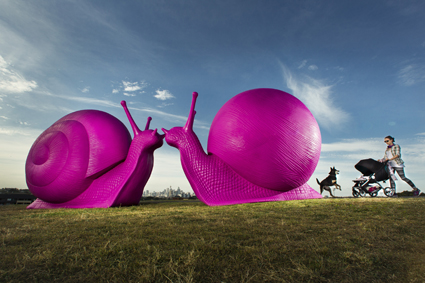
Snailovation, Cracking Art Group
Art and About, City of Sydney
Art and About is hitting Sydney with a plethora of public art adventures. Watch out for giant pink snails made entirely from recyclable materials by UK artists Cracking Art Group; or see yourself multiplied in the 324 mirrors that will populate Hyde Park in Field by New Zealand team Out of the Dark. You can take on a virtual persona and immerse yourself in the micro-world of a model railway in I Think I Can by Sam Routledge, Martyn Coutts and Performance Space. Or you can experience the thrills of Spill, a high energy dance work in several public parks around the city created by Shaun Parker. A special commission by Carbon Arts, Keith Deverell’s Building Run manifests the energy consumption data of five CBD buildings represented by five avatars running for their future. Extending the festivities to East Sydney, Metro Screen will be running a Pop-up Cinema and Bar at the Paddington Town Hall, including a whole night of shorts from a RealTime favourite, Lena “Girls” Dunham.
Art & About, various venues Sydney, 20 Sept-20 Oct; http://www.artandabout.com.au/; http://metroscreen.org.au/whatson/
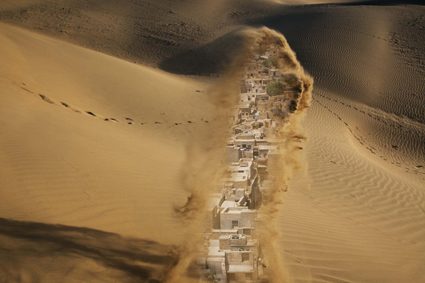
Gigi Scaria, Dust
Gigi Scaria, Dust, Ian Potter Museum
Gigi Scaria was one of the artists to appear in the first ever Indian Pavillion at the Venice Biennale in 2011. Over the last two years he’s spent time in Australia on a cultural exchange courtesy of the Macgeorge Fellowship, University of Melbourne. Dust is his first major solo exhibition here and draws on what he sees as a “strong connection between the Australian and Indian continents” (press release). Through video, large-scale photography and painting Scaria explores the salt plains of the Kutch area, presenting quite a different vision of India from those we normally see.
Gigi Scaria, Dust, Ian Potter Museum, 18 September 2013 – 2 February 2014; http://www.art-museum.unimelb.edu.au/
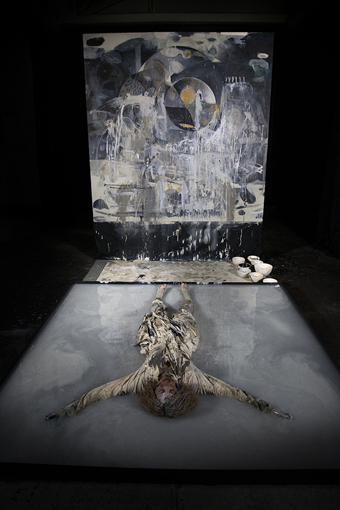
Memory Collective
photo Victoria Cooper+Doug Spowart
Memory Collective
Memory Collective, Toowoomba Art Gallery
Soon to be exhibited at the Toowoomba Art Gallery in south-east Queensland are the results of a large scale collaborative artmaking project by the Memory Collective. Painter and project initiator Damien Kamholtz first created a large format painting. He then invited 12 local artists from a range of disciplines including dance, ceramics, sculpture, textile design, music, photography and filmmaking to respond to the work over various stages. This interaction has both transformed the original painting and created a number of related artworks. (See clip for performance documentation).
Memory Collective, Toowoomba Art Gallery, 21 Sept-5 Nov; http://ww2.toowoombarc.qld.gov.au
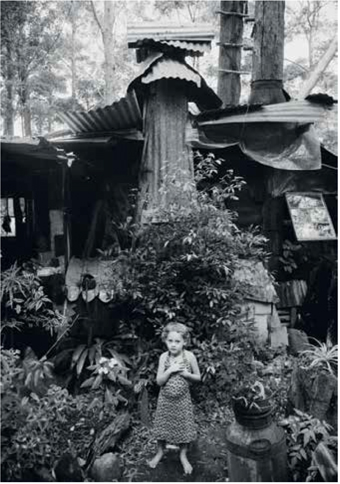
Tim Hixson, Main Arm Mullumbimby (detail), mid 1970s
User Generated Architecture, Tin Sheds Gallery
As part of the Sydney Architecture Festival, Tin Sheds Gallery will be presenting two exhibitions under the umbrella title User Generated Architecture. Not Quite Square, a joint venture with Lismore Regional Gallery, surveys the alternative owner-builder culture that developed in the Northern Rivers region in the 1970s. The partner exhibition features the architecture collective raumlabor berlin. Working at the intersection of urban planning, architecture and intervention the collective creates large-scale installations in public space exploring architecture as an “experimental laboratory” and a “participatory practice” (press release). They will also be conducting a two-day workshop (see opportunities).
Tin Sheds Gallery, Faculty of Architecture Design and Planning, University of Sydney; 27 September-15 November; http://emergencity.net/user-generated-architecture/
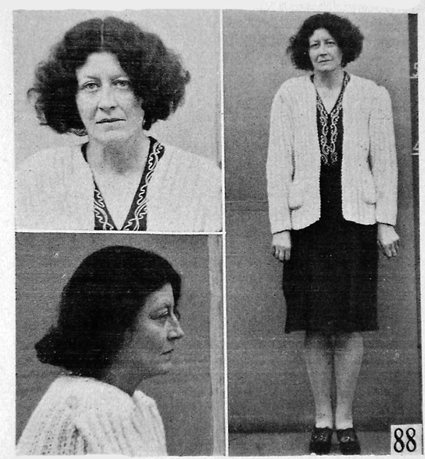
Underworld Songs, Astra
Martin Friedel’s Underworld Songs, Astra
The choral chamber society Astra’s next concert presents a new work by composer Martin Friedel, Underworld Songs. Friedel has been a Creative fellow at the State Library of Victoria where he has been rummaging through tabloid and police reports from the 1950s. He’s created a six-scene suite for choir, soloists, small instrumental ensemble and projected image that looks at “ordinary lives that have gone wrong” (press release). Performed across two atmospheric venues at the Abbotsford Convent, Underworld Songs is complemented by choral pieces by Mendelssohn and Riccardo Vaglini.
Astra Chamber Music Society, Martin Friedel’s Underworld Songs,
Abbotsford Convent, 21-22 Sept 3pm; http://www.astramusic.org.au/
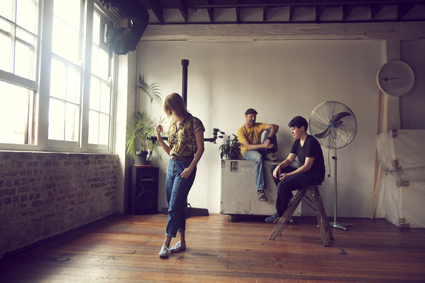
Whips & Tendrils, Triangulate
Whips and Tendril, Campbelltown Arts Centre
The next New Music Network Mini-Series concert is at Campbelltown Arts Centre and focuses on native bird sounds. Whips and Tendrils will be in 9.1 surround sound and features compositions by Triangulate—Sarah-Leith Izzard, Karin Senff and Andrew Bluff. The concert is also part of the Sydney Sacred Music Festival. (View a previous piece by this interesting trio here.)
Triangulate, Whips and Tendrils, Campbelltown Arts Centre; 21 Sept; http://www.campbelltown.nsw.gov.au/WhipsandTendrils; http://sydneysacredmusicfestival.org/events/
Still in the loop
Super Discount, Back to Back, STC, Malthouse
Sydney Theatre Company
20 Sept-19 Oct
http://www.sydneytheatre.com.au/what’s-on/productions/2013/super-discount.aspx
Flock, Weave Movement Theatre
Mechanic Institute Performing Arts Centre, Brunswick
19-22 Sept
http://www.melbournefringe.com.au/fringe-festival/show/flock/
Nought, ADT, Samstag Museum
25 -27 Sept
http://adt.org.au/; http://w3.unisa.edu.au/samstagmuseum/
Kate Murphy, Probable Portraits
Shepparton Art Museum (SAM), 13 Sept-14 Nov
http://www.sheppartonartmuseum.com.au/
Open Frame, Room40
Brisbane Powerhouse and various venues
12-28 Sept
http://openframe.room40.org/2013
Craig Walsh, Embedded & Primavera, MCA
12 Sept-24 Nov
http://www.mca.com.au/
Drawn to Experience: Performance Drawing
POP Gallery (Postgraduates and Other Projects) , Queensland College of Art, Griffith University
12-21 Sept
http://www.kellieo.com/?page_id=1213
ikono On Air Festival
global, online
6-29 September
http://ikono.org/festival/
2013 Brisbane Festival
7-28 Sept
http://www.brisbanefestival.com.au/
arte magra: from the opaque, AEAF
5 Sept-5 Oct
http://www.aeaf.org.au/exhibitions/ArteMagra.html
The boat goes over the mountain, Happy Dagger Theatre
The Blue Room, Perth
10-28 Sept
http://blueroom.org.au/events/the-boat-goes-over-the-mountain/
Windows to the Sacred, S.H. Ervin Gallery
presented in association with Buratti Fine Art; 30 Aug-29 Sept
http://www.shervingallery.com.au/
Malthouse’s Helium
Little Ones Theatre, Salomé, 30 Aug-14 Sept
Smack! Bang, City of Shadows, Rachael Dease, 21 Sept-5 Oct
http://www.malthousetheatre.com.au/helium-2013/
In Confidence: Reorientations in Recent Art, PICA
31 Aug-13 Oct
http://www.pica.org.au
RealTime issue #116 Aug-Sept 2013 pg. web
© RealTime ; for permission to reproduce apply to realtime@realtimearts.net
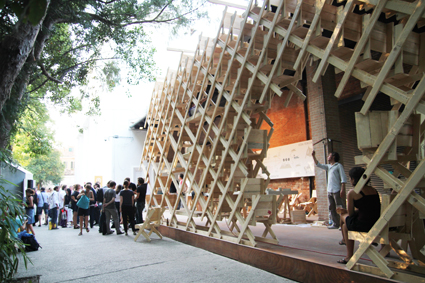
Generator workshop, raumlabor berlin
raumlabor, Tin Sheds Gallery
To complement the exhibition User Generated Architecture (see quick picks), Christof Mayer and Andreas Krauth, artists from the collective raumlabor berlin will be conducting a two-day workshop in “instant, participatory building practices in public space” (press release). The workshop is free but places are limited.
Workshop 12-13 Oct (plus one day ATSC workshop induction if required 11 Oct); http://emergencity.net/special-workshop-with-raumlabour-berlin-book-now/
Nude models, Deborah Kelly, Sydney Biennale
Artist Deborah Kelly is calling for subjects to pose for a number of life-sized nude portraits. These will then be integrated into collages in a series of public workshops starting in October with the final works exhibited during the 19th Biennale of Sydney.
Volunteers as portrait subjects, please send a picture of your face (only) to kellyproject@biennaleofsydney.com.au by Friday, 11 October 2013. For collage workshops, please send expressions of interest to frances@biennaleofsydney.com.au
Public Art major works, City of Sydney
Sydney’s CBD will be changing dramatically over the next few years with traffic rerouted, pedestrian zones created and a light rail system installed. Expressions of interests from artists are now invited for major public artworks to be sited on what is being called the George Street Spine and the smaller East-West cross streets.
Expressions of Interest due 31 October; http://www.cityartsydney.com.au/cityart/news/?p=1739
Revelation Film Festival 2014
The dates are set for next year’s Revelation Film Festival 3-13 July (see Keith Gallasch’s report on this year’s event), and submissions are now open. Categories include narrative features, documentary, short film, animation and experimental projects. There’s a pretty long lead-time so you could start something now and still be ready for the deadline.
Entries close 11 April 2014 http://www.revelationfilmfest.org/go/news/call-for-entries-now-open
Still in the loop
Blacktown Arts Centre Residencies
Applications close 30 Sept
http://www.artscentre.blacktown.nsw.gov.au/performance/2014-performing-arts-residencies.cfm
Fisher’s Ghost Prize, Campbelltown Arts Centre
Entries due 4 Oct, 2013
http://www.campbelltown.nsw.gov.au/FishersGhostArtAward
House Proud 2014, Boroondara City Council
Applications close 30 Sept
http://www.boroondara.vic.gov.au/our-city/arts-culture/kewcourthouse/house-proud
version 1.0 masterclass
Masterclass 19 Oct, and bookings now open.
http://www.trybooking.com/Booking/BookingEventSummary.aspx?eid=60167
Melbourne White Night
Submissions close 1 Oct 2013
http://whitenightmelbourne.com.au/
Fast+Fresh Dance, FORM Dance
Registration closes 14 October
http://form.org.au/2013/01/fastfresh-dance-2/
FlickerFest call for entries
Deadline for Australian & International entries 11 Oct; for GreenFlicks & FlickerUp 18 Oct
http://www.flickerfest.com.au/
Workshops & Residencies, Lucy Guerin Inc
Applications for studio residencies & workshop places due 23 Sept
http://www.lucyguerininc.com/studio-projects/Studio_Residency; http://www.lucyguerininc.com/studio-projects/Hotbed
Next Generation Placement, ASSITEJ
Deadline for applicants 30 Sept
http://www.assitej-international.org/next-generation/
Forever Now
Applications open until June 2015
http://forevernow.me/
Selected Australia Council Grants
for full list see http://www.australiacouncil.gov.au/grants
Music: Fellowships – 17 September 2013
http://www.australiacouncil.gov.au/grants/2013/music-fellowships
Music: Project Fellowships – 17 September 2013
http://www.australiacouncil.gov.au/grants/2013/music-project-fellowships
Music: Don Banks Music Award – 17 September 2013
http://www.australiacouncil.gov.au/grants/2013/don-banks-music-award
Music: Skills and Arts Development – Artist Development – 17 September 2013
http://www.australiacouncil.gov.au/grants/2013/music-skills-and-arts-development-artist-development-17-september
ArtStart – 23 September 2013
http://www.australiacouncil.gov.au/grants/2013/artstart2
Emerging and Experimental Arts – 4 October, 2013
http://www.australiacouncil.gov.au/grants/2013/experimental-arts-grants-4-october
RealTime issue #116 Aug-Sept 2013 pg. web
© RealTime ; for permission to reproduce apply to realtime@realtimearts.net
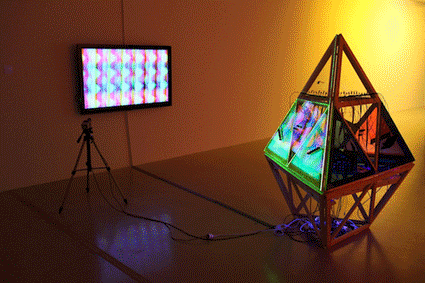
Tetra Synth, 2013, Pia van Gelder & Stephen Jones
courtesy the artists
Tetra Synth, 2013, Pia van Gelder & Stephen Jones
Pia van Gelder is the “Overlord”of the Sydney chapter of Dorkbot, a loose international network of “people doing strange things with electricity.” She is also incredibly active as a curator (co-director of the Moduluxx festival and the now-ended Serial Space), an educator and artist.
Van Gelder’s practice involves performance and installation works utilising what she describes as “media machines” which she hacks and reconfigures. She says “hacking or tinkering is a way to look for a new aesthetic…to explore or reveal the machine’s intrinsic visual or audio language, sometimes arriving at surprising results. But mostly I’m looking at how a machine can have its own form of expression [either through an] electronic aesthetic or the machine’s connection to the outside world and the people around it.” In her artist statement van Gelder talks of the pursuit of an “AV mysticism.”
Heirloom machines
Van Gelder is particularly interested in older technologies, which she refers to as heirloom machines. “This is a term Joyce Hinterding and I came up with when I was doing my masters. There are machines, like the video synthesiser for instance, that are historic and rare…a prize possession.” There’s an interestingly female flavour to the term—a small reclamation of machines from an assumed male custodianship.
Van Gelder has recently collaborated with Stephen Jones to recreate one of these machines. Based on Jones’ original 1996 designs for a video synthesiser, they have recreated the Tetrasynth. It’s a pyramidal object with one colour from the video spectrum—red/green/blue—assigned to each side. It allows users to play, manipulating the colours via generators and filters to create abstract video images. The work was commissioned by Campbelltown Art Centre for their exhibition Catching Light, part of ISEA 2013 (see realtimeTV and review).
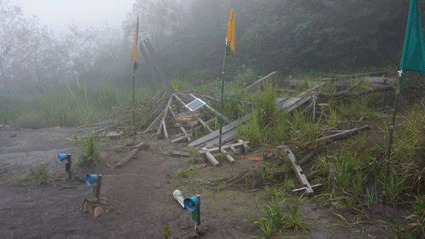
Mountain Operated Synthesiser (MOS), 2013, Mt Mehrapi, Pia van Gelder, Michael Candy, Andreas Siagian
courtesy the artists
Mountain Operated Synthesiser (MOS), 2013, Mt Mehrapi, Pia van Gelder, Michael Candy, Andreas Siagian
Collaboration
While the term ‘geek’ offers the impression of lonely souls working in isolation, only communicating virtually, the contemporary use of the term ‘hacker’ infers a shift beyond software to actual object modification and is strongly associated with the idea of real-world communities. Hacker spaces are popping up all around the world where people come to share tinkering tips, tools and resources. Before this year, Van Gelder had not participated in many collaborative art processes (curating aside), but now she’s making up for this.
As well as the Tetrasynth project, she has also recently taken part in the Instrument Builders Project in which Australian and Indonesian artists came together at iCAN in Yogyakarta (see review). Van Gelder teamed up with Brisbane-based artist Michael Candy and Indonesian artist Andreas Siagian to create the Mountain Operated Synthesiser. Inspired by a solar-powered seismic monitoring station half way up Mt Mehrapi, an active volcano 28 kilometres north of Yogyakarta, the trio have created an instrument that is played by the mountain. It comprises three flags dug into the ground, each holding three oscillators. The flags have analogue senses sewn on or built into them, capturing wind and moisture levels and soil activity. This data then activates the oscillators creating a raucous sonification of the mountain’s conditions. It doesn’t sound very pretty but it’s a wonderfully integrated concept.
Gender issues
Hacking is an area of practice notoriously dominated by males and I asked Van Gelder how this affects her practice. “The Instrument Builders Project was a very good example—there were no other female practitioners on that bill of artists. (There was, of course, Kristi [Monfries] who was one of the curators.) And it came up in discussion from time to time. You have to recognise that imbalance and talk about it, but you also can’t let it get to you, even though it can feel quite isolating…If we don’t recognise that it’s a male dominated field then it becomes even more unappealing [for women]. But if you make a point of making space, making women feel recognised and comfortable, that’s a way of moving past it, just a little bit.”
What’s next
Van Gelder has already achieved a lot this year, but there’s still more to come. She’s one of five artists who have been commissioned to make works for the Tele-Visions festival celebrating the passing of analogue TV (part of Performance Space’s 30th birthday celebrations). For Tele-Visions Van Gelder will perform a series of experiments for live television broadcast involving participation from the audience in the studio. “It’s kind of like a cross between a global groove and a science show.” If only the Curiosity Show was still around today—Pia van Gelder would make the perfect host(ess)!
COMING UP: Pia van Gelder (represented by First Draft) will exhibiting at the inaugural Sydney Contemporary, Carriageworks, Sydney; 20-22 September 2013 ; http://piavangelder.com/
RealTime issue #116 Aug-Sept 2013 pg. web
© Gail Priest; for permission to reproduce apply to realtime@realtimearts.net
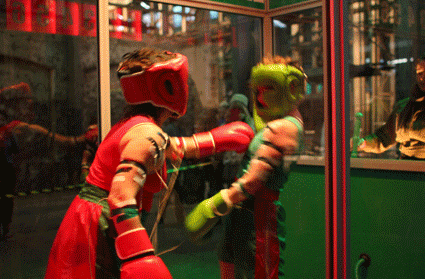
Game On, Michaela Davies
photos Claire Conroy & Geoff Ambler
Game On, Michaela Davies
Michaela Davies is not a woman to mess with. Not only is she well trained in boxing but she also has a PhD in Psychology. She has combined these skills in her latest work, Game On, which premiered at this year’s Underbelly Arts Festival.
Involuntary art & vicarious violence
Game On extends the work that Davies has been making with electric muscle stimulation (EMS), in particular her Compositions for Involuntary Strings. She composes works that are translated into midi data, then converted to EMS messages that are transmitted to the wired-up musicians who are literally shocked into playing the compositions, their involuntary muscle spasms providing wonderfully idiosyncratic extra musical sounds. (See RT113 and our ISEA blog).
For Game On, Davies uses a similar EMS technique, but ups the ante considerably. Inspired by a scene in Richard T Heffron’s film Future World (1973), she built a gaming booth in which live ‘boxers’ are controlled by audience members via oversized joysticks. The boxers’ muscles are stimulated into sequences that replicate the action of swinging, punching and blocking. The resulting match is curiously languid and hysterically wonky. Things hot up as the controlling masters of the game get increasingly more skilled and sometimes more aggressive.
GAME ON. Documentation from installation on Cockatoo Island for Underbelly Arts Festival. Sydney, Australia (2013), video by Boris Bagattini from Michaela Davies on Vimeo.
While the piece is evidently fun, it also poses questions about our pleasure in vicarious violence. The work also references the infamous Milgram experiment, in which people were given permission by a perceived authority figure to inflict lethal levels of electric current on unseen participants. In the Milgram experiment there were no actual victims (the participants’ cries were revealed to be pre-recorded), so Davies’ piece, in effect, takes this experiment a step further. Game On also removes the authority figure but replaces it with the performance context. Davies says: “the authority comes from the fact that it’s an artwork—they are doing it for art. But it’s still looking at where the responsibility lies. Maybe the players wouldn’t go up and shock someone on the street but because they’ve been given permission here, that makes it okay for them.”
Game On illustrates an interesting tension between Davies’ psychology and art practices: “There’s no way you could do something like Game On in a research environment, or as a psychological study because of ethics. Making art you have more freedom to explore ideas that you can’t explore in research because you simply wouldn’t be allowed. Or it would be so far removed from any kind of reality that it would be pointless. I’m wondering how long [this freedom] will last before artists will have to submit ethics applications to make an artwork that involves the public.” [This is already an issue for art practice as research within universities; see Kate McNeill and Barbara Bolt, “The ‘legitimate’ limits of artistic practice,” RealTime 104, Eds]
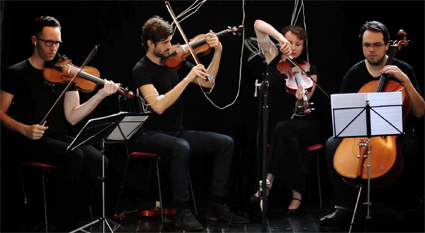
“Untitled for Cyborg String Quartet” (voluntary & involuntary players), Michaela Davies in collaboration with Kyle Sanna
Obstructionism
Game on and the Involuntary Strings project are of course about more than sadism: they reflect Davies’ overarching interest in agency and free will. Her next project involves a series of videos in which musicians play a piece which they know very well but have to battle an obstruction—for example a guitarist wears mittens while trying to play “Stairway to Heaven.” Davies says, “I am interested in the way obstruction can change performance, or change behaviour—how people cope with different obstruction. I’m also looking at this from an historical experimental music perspective—chance operations… Those artists were trying to remove people from what they’re making, to give them more freedom—through obstruction—to create something new.”
A work Davies is developing for her appearance at the Sonica Festival in Glasgow will involve a pianist performing a classic piece (yet to be decided) which Davies, in a duet of sorts, will interrupt with EMS impulses. She says, “She’ll be fighting against the involuntary EMS to try and play. I’m really interested in that struggle.” With this and the video pieces Davies is “interested how performance becomes a recital. It’s easy for musicians to not really think about what they’re playing any more. I’m looking at ways of changing that.” In the early Involuntary Strings pieces it seems musicians voluntarily relinquish control. In these later works Davies allows the musicians a semblance of control and then actively interferes with it.
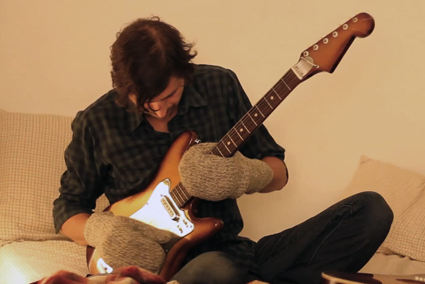
Kyle Sanna plays Stairway to Heaven, Michaela Davies
courtesy the artists
Kyle Sanna plays Stairway to Heaven, Michaela Davies
This development reflects Davies’ thinking as a psychologist: “People develop disorders and problems because of conflicts between themselves and society and what society expects. I don’t think they actually need free will or more will power to get better. It’s more about looking at the contexts these things develop in, rather than having more control over yourself. I don’t think anyone ultimately has much control over anything. We’re just rats pressing a bar for food.” I look forward to that experiment manifesting as an artwork.
COMING UP: Sonica: Compositions for Involuntary Strings, Tramway, Glasgow, 2 November; http://sonic-a.co.uk/compositions-for-involuntary-strings/; Game On, Damien Minton Ballery, opening 12 November; http://www.michaeladavies.net/
RealTime issue #116 Aug-Sept 2013 pg. web
© Gail Priest; for permission to reproduce apply to realtime@realtimearts.net
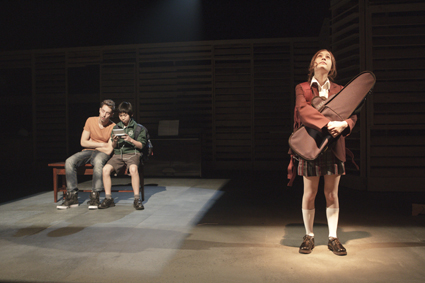
Matt Crook, Lawrence Mau, Danielle Catanzariti, Babyteeth, STCSA
photo Shane Reid
Matt Crook, Lawrence Mau, Danielle Catanzariti, Babyteeth, STCSA
A protracted gasp somewhere in the auditorium. An incredulous intake of breath? A snore? A derisory snort? No. Something darker. A shout, and the houselights go up, actors frozen on stage, suddenly displaced. The audience files out as green-jacketed paramedics file in. “She’s okay,” word comes down the line a little while later; a drop in blood pressure, she’ll go on, but some unexpected synchrony seems to have taken place, this irruption of the real underscoring playwright Rita Kalnejais’ overriding theme: the fragility of life in the face of omnipresent mortality.
Babyteeth charts, with filmic concentration, the last days in the life of Milla (Danielle Catanzariti), a fourteen-year-old with a terminal illness. The play is bookended by her death in the company of an unlikely bestie, gormless twenty-five-year-old druggie Moses (Matt Crook) whom Milla meets while waiting for her train after school. Fraught, fractured individuals surround them: Milla’s parents, Henry (Chris Pitman) and Anna (Claire Jones), her Latvian violin tutor Gidon (Paul Blackwell), her pregnant neighbour Toby (Alyssa Mason). The milieu, amplified by director Chris Drummond’s fussy, televisual instincts is again filmic, part Alan Ball, part David Lynch in its dark, coiled domesticity and depiction of suburban unease. Milla’s illness has pushed Anna towards seemingly irreversible neurosis, Henry, a psychologist, into smiling stereotypy and professional corruption. These are “etherised” lives, measured out, like Eliot’s J. Alfred Prufrock, “in coffee spoons.”
As Milla’s lifeforce wanes, her hair falling out—reducing the already slight Catanzariti to a glinting, gossamer ghost—it seems to take root elsewhere. Toby’s imminent baby is its physical manifestation. Gidon’s precocious Vietnamese student Thuong (Lawrence Mau or James Min on alternate nights) seems also to represent something that will be lost once Milla has gone. The moment when, provoked by her mother’s coaxing and the pain beginning to wrack her tiny body, she hurls her violin to the floor mid-practice, is one of the play’s most affecting. We share, then, for the first time, Milla’s knowledge that she will not live long enough to get as good as Thuong, that whatever promise she possesses—as a musician or, indeed, as anything else—will never be fulfilled.
Finally there is Moses, the object of Milla’s affection and prematurely burgeoning sexual ambition. There is, in their lovemaking, a further transmission of life. It is one of the final acts of Milla’s too short life and, like life, it is confused and unsatisfying. Moses may retain something, but what? A chemical memory? A point of access to a world normally refused him? Kalnejais does not provide a ready answer, nor position Milla as a redeeming angel. Their relationship—fumbling, clingy, unarticulated—remains shrouded in ambiguity even as its great charm overcomes our initial discomfort at the age gap and the sometimes brutal discrepancies in social status. As Moses, Matt Crook, in a contained and intelligent performance, lends the underwritten part of Moses depth and dignity, but it is Danielle Catanzariti who most impresses, finding endlessly variegated shades of emotional and physical nuance as both Milla’s body and innocence diminish.
Kalnejais asks that, at the play’s end, the stage revolves to reveal a negative image of the play’s opening scene. Milla’s incorporeal presence hovers on the outside looking in, peering through set designer Wendy Todd’s oversized wooden slats into the family home; her life, suddenly, without her in it. Light streams in from seemingly distant sources. Thuong plays something on the violin which swirls heavenwards like the first movement of Górecki’s Symphony No 3. Softly, dreamily, the stage is saturated with light and sound.
Milla’s tragedy, momentarily, defocuses the everyday, transcending the ordinary illusions and transgressions that we know will continue to master the lives of those she knew in life. It is these cracked, unresolved stories—of Milla’s mum and dad, of Moses, Gidon and Toby—which an elegiac death cannot reduce and which, in the end, may give the heart the greatest cause to ache—life as fragile, blundering onwards.
State Theatre Company of South Australia, Babyteeth, writer Rita Kalnejais, director Chris Drummond, designer Wendy Todd, lighting Geoff Cobham, composer Hilary Kleinig; Space Theatre, 16 Aug-7 Sept
See Keith Gallasch’s review of the premier production of Babyteeth at Belvoir
RealTime issue #116 Aug-Sept 2013 pg. web
© Ben Brooker; for permission to reproduce apply to realtime@realtimearts.net
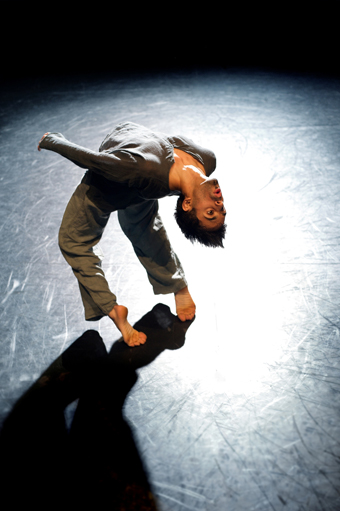
Aakash Rising
photo Chris Nash
Aakash Rising
One of Sydney’s most enjoyable festivals is Parramasala, a celebration of the South Asian culture of Western Sydney, featuring local performers and international visiting artists. Most striking, in the crowds at outdoor concerts, the marketplace, food stalls and indoor performances is evidence of cultural diversity that extends far beyond South Asia to eager audiences of South-East Asian, Chinese, Korean, Filipino, Pacific and Anglo and European heritage. There’s a palpable sense of curiosity and community.
Artistic director David Malacari (taking over from founding director Phillip Rolfe) tells me that he was attracted to Parramasala “because of the type of the festival it is. One of my hobbyhorses in New Zealand (Malacari was director of the Auckland Arts Festival, 2004-11) was for festivals to reflect the neighbourhood we’re in, and in Western Sydney it’s even more important. When you step onto the streets of Parramatta you encounter so many communities and cultures.”
Malacari feels that “what goes on on our stages should reflect this, and the audiences too, which are still largely of European background. It’s changing, with a few wonderful exceptions, but I’d like to see it change faster to reflect a new Australia. The festival introduces communities to each other, making the culture more than a sum of its parts—that attracted me to Parramasala.”
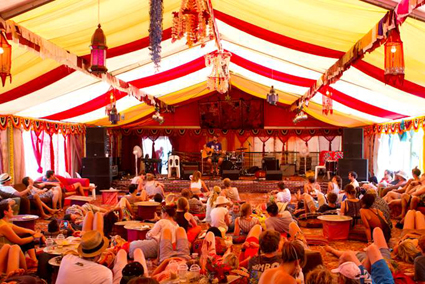
The Chai Temple
photo Kevin Bull
The Chai Temple
Completing the continuum
In the 2012 festival it was noticeable that ticketed shows were not, for the most part, well attended, while large, enthusiastic crowds gathered day and night for the free outdoor events. Doubtless many young families cannot afford tickets and some people may not be familiar with theatre-going. Malacari has wisely brought the outdoor and indoor events spatially closer together, locating the former in Prince Alfred Park right next door to the Riverside Theatres, instead of at the Town Square (a successful site but a distance from the theatres).
He sees this as providing a continuum on several fronts. There’ll be free events in the Riverside Theatres: in the sociable Chai Temple in the courtyard (chai, coffee, music from 5pm and a party on Saturday 5 October with famed musician Raghu Dixit), exhibited art and, in Rafferty’s Studio at 5pm over three days, free screenings of significant documentaries (see below). Malacari hopes these will tempt the curious into the theatre complex and perhaps even seduce them into a buying a ticket for a show.
A striking aspect of the 2012 outdoor program was the mix of professional, pro-am and community performances, ranging from traditional to contemporary, and hybrids in between, and largely of a high standard. Malacari sees this as important—the community performers and the professional virtuosi in the ticketed shows “being part of a continuum, with one being the bedrock of the other.” He also likes the idea of visiting professional artists walking out of the theatre into a rich community ambience,’ with the feeling of “a greater sense of a single festival.”
Fearless Nadia
Malacari saw Fearless Nadia, a 1940 Indian film accompanied by a large band of Australian and Indian players led by Ben Walsh, at the 2012 OzAsia in Adelaide: “It was fun—too good to pass up, a great centrepiece for the festival.” Featuring the incredibly popular Perth-born Mary Evans as its heroine who demolishes villains with slapstick ease, the film is an action-filled romp, replete with singing and dancing in the Bollywood tradition. Walsh and his musicians will be joined by visiting composer and virtuoso improviser Aneesh Pradhan, who will perform the tabla passages in Fearless Nadia.
Aakash Odedra
The many fans of choreographer and dancer Akram Khan will not want to miss seeing his protégé, Aakash Odedra. In Rising, this young, critically lauded star of British and South Indian dance will perform works created for him by Khan, Russell Maliphant and Sidi Larbi Cherkaoui alongside one of his own. Fusing the classical Indian dance disciplines of Kathak and Bharatanatyam with contemporary dance modes, Odedra is renowned for fast and intricate hand and footwork. With only two performance, Rising will be presented in the intimate Lennox Theatre.
Zameen
Another dance feature, this time with a political dimension, is the multimedia Australian-Indian creation Zameen, The Dam(n) Project. Malacari tells me he had been following the Attakkalari Centre for Movement Art, based in Banaglore, for a number of years only to serendipitously discover that they were already working with an Australian creative team: Jehan Kanga, composer Leah Barclay and Curious Works’ Artistic Director S Shakthidharan (whose The Other Journey was a Parramasala hit in 2011). After seeing an early version of Zameen at the Sunshine Coast’s Floating Land Festival, Malacari committed to presenting it at Parramasala. Reputedly a work of great beauty enhanced by the dancing of two members of the Attakkalari dance company, Zameen evokes the struggle of a remote community to preserve their land in the face of the building of a massive dam, a battle which it lost in large part, if managing to claw back some land. Malacari says, “the loss of land and water rights is germaine the world over, including in Australia.”
Manakottai In association with Information & Cultural Exchange (ICE), Malacari has programmed Sydney Nadaka Priyar, a local Tamil group, to perform Manakottai, a work they’ve devised in their own language but to be staged with English surtitles. “It’s a first for Parramasala,” says Malacari, “and could be a model for the future. I’m keen to use more language in the festival.” Katrina Douglas is director and dramaturg for the production—Malacari wants the work to be given the best opportunity to be professionally realised. The play focuses, with some humour, on the meaning of home, addressing “the expectations and experiences of two Tamil couples on intersecting journeys—one couple migrating to Australia and the other couple returning to India”—at Singapore’s Changi airport (website).
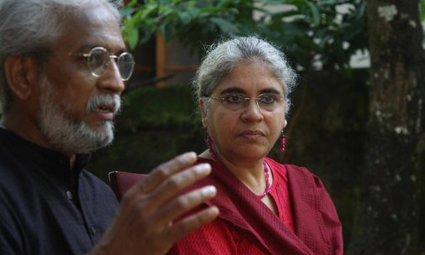
KP Jayasankar and Anjali Monteiro
Film: Anjali Monteiro and KP Jayasankar
The ICE Documentary Program (partnered with UWS and UTS) at Riverside, will screen three films over three nights at 5pm, each with a focus on significant social issues, ethnic tensions and declining cultural assets in India.
The prominent Indian documentary filmmaker pair Anjali Monteiro and KP Jayasankar, acclaimed around the world for their films about marginalised peoples, are guests of ICE and Parramasala, showing one of their best known films, Naata (2003), and a recent one, Like Here Like There (So Heddan So Hoddan; 2011). The latter “explores the worlds of three cousins, their families and the Fakirani Jat community to which they belong.” These people are devotees of Shah Abdul Latif Bhitai, a medieval Sufi poet, and inheritors of a rich tradition of poetry, song and instrumental playing that is fast dying out as the nomadism of these people is increasingly curtailed.
Naata (The Bond; 2003) is about Bhau Korde and Waqar Khan, “two activists and friends, who have been involved in conflict resolution, working with neighbourhood peace committees in Dharavi, Mumbai, reputedly, the largest ‘slum’ in Asia.” The two men use video, posters, audio-cassettes and above all a film they made, Ekta Sandesh, which they show with a portable screen and projector at their own expense. One writer says, “Their film is unabashed in its exploitation of Bollywood” and its use of celebrities and public officials arguing passionately for civic harmony. Anjali Monteiro and KP Jayasankar will participate in post-screening Q&As.
The third film in the ICE series also looks likely to be fascinating, Pritham K Chakravarthy’s Our Family (2007), a filmed solo performance about a family of three generations of trans-gendered female subjects and, says Malacari, “their tumultuous lives” in Tamilnadu.
Khovar Rewind and Semblance of Order
Another ICE contribution to Parramasala includes Khovar Rewind (at ICE, Parramatta, 30sept-31 Oct) an exhibition of mural works on paper, made in 1994 by tribal women artists from the Haziribagh region of Bihar in India “in response to the threat of physical and cultural displacement due to open cut coal mining. Created in the style of traditional Khovar (bridal) murals, each artwork is a delicate celebration of love, marriage and cultural unease” (website). The works, unseen for some 20 years, are from the Liverpool City Council Collection. Another indiosyncratic, paper-based exhibition Semblance of Order, presented with Parramatta Artist Studios, will show etchings and silkscreen prints by five artists from Pakistan and Australia.
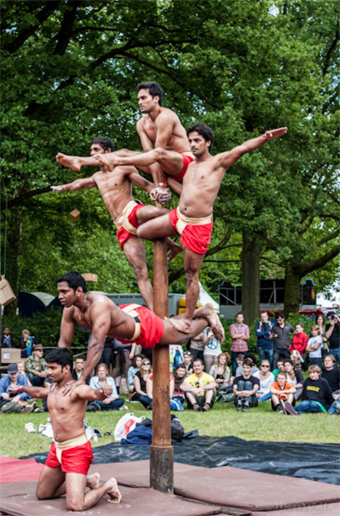
The Allakhamb Acrobats
courtesy Parramasala
The Allakhamb Acrobats
Mallakhamb Acrobats
When you’re in Prince Alfred Park look out for the Mallakhamb Acrobats from Mumbai with their astonishing gymnastics, balancing, for example, on their stomachs at the very top of the poles which are central to their work. As David Malacari says, this is something most people will never have seen.
My brief survey of the performances, films and exhibitions (let alone the music events you can read about on the festival’s website) suggests that much of Parramasala 2013 is likely to expand our sense of the nature of our relationship with Asia.
Parramasala 2013, 4-7 Oct; Khovar Rewind, ICE, 30 Sept-31 Oct; http://www.parramasala.com
RealTime issue #116 Aug-Sept 2013 pg. web
© Keith Gallasch; for permission to reproduce apply to realtime@realtimearts.net
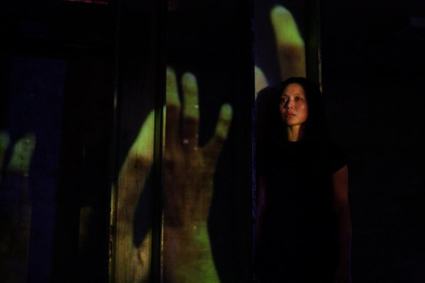
Weizen Ho, 2011, Blacktown Performing Arts Residency
photo Mayu Kanamori
Weizen Ho, 2011, Blacktown Performing Arts Residency
Blacktown Arts Centre Residencies
Blacktown Arts Centre is calling for applicants for their residency program which offers both funded (up to $5000) and unfunded opportunities (ie in-kind space only). Applications are open to residents in the Blacktown area or artists who can demonstrate a connection to the region.
Applications close 30 Sept; http://www.artscentre.blacktown.nsw.gov.au/performance/2014-performing-arts-residencies.cfm
Fisher’s Ghost Prize, Campbelltown Arts Centre
The organisers of the Annual Fisher’s Ghost Prize are calling for entries from artists around Australia. There are a number of entry categories including Contemporary, Photography, Sculpture, Drawing and MACABILITY (for artists with a disability). The overall winner receives $20,000 and their work is acquired for the Campbelltown Art Gallery’s permanent collection. The exhibition will take place 2 Nov-16 Dec.
Entries due 4 Oct, 2013; http://www.campbelltown.nsw.gov.au/FishersGhostArtAward
House Proud 2014, Boroondara City Council
Applications are now sought from independent artists and companies to present performance activities (theatre, dance, music, comedy or cabaret) between February and June 2014 at the Kew Court House in Melbourne’s north-east. Successful applicants will receive access to the venue and a range of associated services free of charge.
Applications close 30 Sept; http://www.boroondara.vic.gov.au/our-city/arts-culture/kewcourthouse/house-proud
version 1.0 masterclass
Carriageworks and performance company version 1.0 and are presenting a masterclass in performance devising. Version 1.0 are renowned for their highly political and frequently humorous investigations into Australian politics and culture (for examples see RT113, RT105, RT81; RT68).
Masterclass 19 Oct, and bookings now open.
http://www.trybooking.com/Booking/BookingEventSummary.aspx?eid=60167
Still in the loop
Melbourne White Night
Submissions close 1 Oct 2013
http://whitenightmelbourne.com.au/
Summer Studio Residency, Penrith Regional Art Gallery
Applications due 14 Sept
http://www.penrithregionalgallery.org/
Fast+Fresh Dance, FORM Dance
Registration closes 14 October
http://form.org.au/2013/01/fastfresh-dance-2/
FlickerFest call for entries
Deadline for Australian & International entries 11 Oct; for GreenFlicks & FlickerUp 18 Oct
http://www.flickerfest.com.au/
Workshops & Residencies, Lucy Guerin Inc
Applications for studio residencies & workshop places due 23 Sept
http://www.lucyguerininc.com/studio-projects/Studio_Residency; http://www.lucyguerininc.com/studio-projects/Hotbed
Next Generation Placement, ASSITEJ
Deadline for applicants 30 Sept
http://www.assitej-international.org/next-generation/
Forever Now
Applications open until June 2015
http://forevernow.me/
Selected Australia Council Grants
for full list see http://www.australiacouncil.gov.au/grants
Music: Fellowships – 17 September 2013
http://www.australiacouncil.gov.au/grants/2013/music-fellowships
Music: Project Fellowships – 17 September 2013
http://www.australiacouncil.gov.au/grants/2013/music-project-fellowships
Music: Don Banks Music Award – 17 September 2013
http://www.australiacouncil.gov.au/grants/2013/don-banks-music-award
Music: Skills and Arts Development – Artist Development – 17 September 2013
http://www.australiacouncil.gov.au/grants/2013/music-skills-and-arts-development-artist-development-17-september
ArtStart – 23 September 2013
http://www.australiacouncil.gov.au/grants/2013/artstart2
Emerging and Experimental Arts – 4 October, 2013
http://www.australiacouncil.gov.au/grants/2013/experimental-arts-grants-4-october
RealTime issue #116 Aug-Sept 2013 pg. web
© RealTime ; for permission to reproduce apply to realtime@realtimearts.net
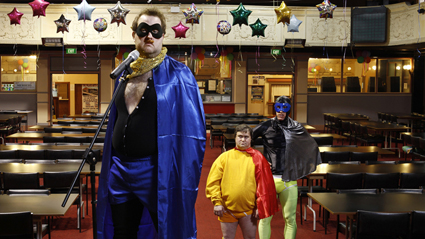
Super Discount, Back to Back Theatre
photo Jeff Busby
Super Discount, Back to Back Theatre
Super Discount, Back to Back, STC
Back to Back has continued to impress with a performance vision that is utterly unique, endlessly inventive and thoroughly brave (see RT’s Arts and Disability archive highlight for a collection of Back to Back articles). The Geelong-based company will be premiering their new show, Super Discount, as part of the 2013 Sydney Theatre Company season, continuing at Malthouse later in the year. Directed by Bruce Gladwin, devised by company members and featuring choreography by Antony Hamilton, Super Discount interrogates the archetypal comic book action hero, fighting against all odds. “Sticky notions of identity, representation and power are pulled apart and investigated with humour and candour” (press release).
Back to Back, STC, Malthouse: Super Discount, Sydney Theatre Company; 20 Sept-19 Oct; http://www.sydneytheatre.com.au/what’s-on/productions/2013/super-discount.aspx
SUPER DISCOUNT DISCOUNT: STC is offering RealTime readers $30 tickets for previews Sept 20, 21, 23, 24. Use this link to book with the code REALTIME.
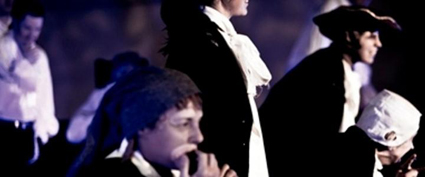
Flock, Weave Movement Theatre
photo Pippa Dodd
Flock, Weave Movement Theatre
Flock, Weave Movement Theatre
Another “ability inclusive” company, Weave Movement Theatre will be presenting their new work, Flock, as part of the Melbourne Fringe Festival. Directed by Janice Florence, a paraplegic dance artist, Flock looks at “social connectedness, human interactions and social exchanges” via movement, dance and theatre. (See Philipa Rothfield on Weave’s Capsule; and an article by Janice Florence on the Art of Difference)
Flock, Weave Movement Theatre, Mechanic Institute Performing Arts Centre, Brunswick, 19-22 Sept; http://www.melbournefringe.com.au/fringe-festival/show/flock/
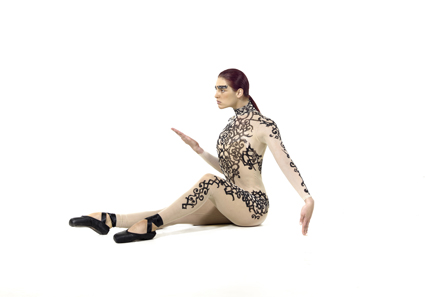
Nought, Australian Dance Theatre
photo credit Chris Herzfeld – Camlight Productions
Nought, Australian Dance Theatre
Nought, ADT, Samstag Museum
Australian Dance Theatre will be premiering a new work choreographed by Daniel Jaber at the Samstag Museum. Jaber has danced with ADT since 2004 and Nought represents a number of firsts for both him and the company: it’s Jaber’s first full length work; the first show to be commissioned by ADT from a company dancer; and the first ADT show be presented in a gallery setting. Jaber says “Nought is an experiential performance where the audience is taken through a process of discovery, ending with a poignant insight into the dancing body and the dancer’s fragility” (press release).
ADT: Nought, choreographer Daniel Jaber, Anne and Gordon Samstag Art Museum, 25 -27 Sept; http://adt.org.au/; http://w3.unisa.edu.au/samstagmuseum/
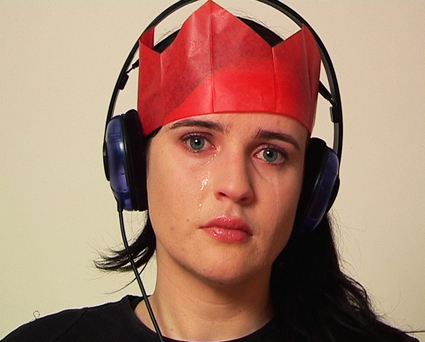
Kate Murphy Cry me a future (Dublin), 2006
courtesy of the artist and BREENSPACE, Sydney © the artist
Kate Murphy Cry me a future (Dublin), 2006
Kate Murphy, Probable Portraits, SAM
Shepparton Art Museum is presenting their largest screen-based exhibition to date with this survey of the video practice of Kate Murphy. The exhibition will feature key pieces exploring themes of family, ritual and aspiration including Prayers of a Mother (1999, see RT57 http://www.realtimearts.net/article/issue57/7262), the Britney Love series (2000/2007), Assembly (2009) and Yia Yia’s Song (2010, see RT100 http://www.realtimearts.net/article/issue100/10128). Murphy also turns the camera on herself in Cry me a river (Dublin) (2007) which depicts the artist’s tearful response to a clairvoyant’s reading.
Kate Murphy, Probable Portraits, Shepparton Art Museum (SAM), 13 Sept-14 Nov; http://www.sheppartonartmuseum.com.au/
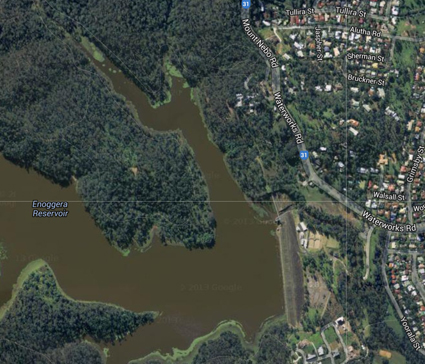
Sound walk with Anthony Magen & WestHead Projects, Open Frame
Open Frame, Room40
There have already been a few activities staged for Room40’s annual festival, this year themed The Future is Noise. David Toop, David Grainge (author of the recently released book Noise Matters, Bloomsbury 2013) and Amelia Barrakin have already duked it out in a forum at IMA. Plus the amazing Japanese sound artist Akio Suzuki has performed in Brisbane and at Lismore Regional Gallery. The festival will culminate in a concert series at Brisbane Powerhouse featuring Francisco López (Spain), Mark McGuire (US), Laurel Halo (US), Objekt (Germany) and local artists. There’ll also be a soundwalk led by Anthony Magen through the Brisbane State Forest Park featuring the West Head Project crew, Monica Brooks, Jim Denley and Dale Gorfinkel.
Room40: Open Frame, Brisbane Powerhouse and various venues; 12-28 Sept; http://openframe.room40.org/2013
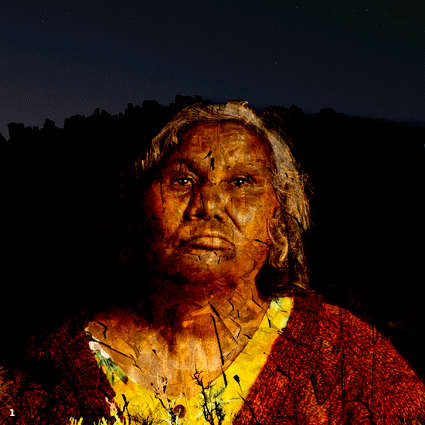
Craig Walsh, In Country (2012); 1) Pansy Hicks, courtesy the artist and Pansy Hicks; 2) Tim Douglas, courtesy the artist and Tim Douglas; 3) Tootsie Daniels, courtesy the artist and Tootsie Daniels; © the artist
Embedded & Primavera, MCA
Embedded is a follow-up to Craig Walsh’s 18-month regional tour, Digital Odyssey (2010-11). For this project Walsh resided for four weeks in and around the Burrup Peninsula in north-west Western Australia, courtesy of the MCA and Rio Tinto. He worked with the community, Indigenous elders and the mining company exploring differing attitudes to the environment: “’land’ as commodity and ‘Land’ as spiritual and cultural guidance” (Walsh, press release). The exhibition comprises a wide-screen video work, Standing stone site (2012) and a multi-channel piece, In Country (2012), in which community elders are literally embedded in the rock-scape as they discuss spiritual aspects of the land.
Spring is also Primavera time at the MCA with this year’s exhibition for artists under 35 curated by Robert Cook (Art Gallery of Western Australia). His vision includes painting, sculpture, video and sound works by Jacqueline Ball (WA), Jackson Eaton (WA/VIC), Heath Franco (NSW), Brendan Huntley (VIC), Thomas Jeppe (WA/VIC), Jess Johnson (VIC), Juz Kitson (NSW) and Kusum Normoyle (NSW).
Craig Walsh, Embedded & Primavera, MCA, 12 Sept-24 Nov; http://www.mca.com.au/exhibition/craig-walsh/
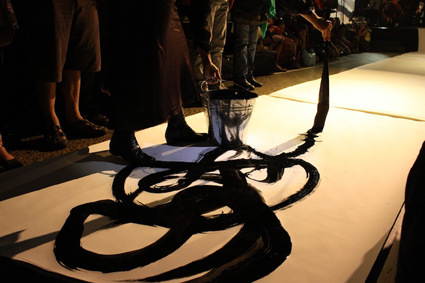
Kellie O’Dempsey, MONA FOMA, 2012
photo Goegina Tait, courtesy the artists
Kellie O’Dempsey, MONA FOMA, 2012
Drawn to Experience, POP Gallery, QLD College of Art
Drawn to Experience is a survey of performance drawing curated by Kellie O’Dempsey. The exhibition will feature works by international artists Morgan O’Hara (New York), Tony Orrico’s (Chicago), Mar Serinya (Barcelona) and Jaanika Peerna (Estonia/New York) alongside Australian practitioners O’Dempsey, Rebecca Kinsey and Gosia Wlodarzcak. It will include works on paper, digital drawings, video and a live drawing performance.
Drawn to Experience: Performance Drawing, POP Gallery (Postgraduates and Other Projects) , Queensland College of Art, Griffith University, 12-21 Sept; http://www.kellieo.com/?page_id=1213
Still in the loop
ikono On Air Festival
global, online
6-29 September
http://ikono.org/festival/
2013 Brisbane Festival
7-28 Sept
http://www.brisbanefestival.com.au/
arte magra: from the opaque, AEAF
5 Sept-5 Oct
http://www.aeaf.org.au/exhibitions/ArteMagra.html
The boat goes over the mountain, Happy Dagger Theatre
The Blue Room, Perth
10-28 Sept
http://blueroom.org.au/events/the-boat-goes-over-the-mountain/
Windows to the Sacred, S.H. Ervin Gallery
presented in association with Buratti Fine Art; 30 Aug-29 Sept
http://www.shervingallery.com.au/
Malthouse’s Helium
Little Ones Theatre, Salomé, 30 Aug-14 Sept
Smack! Bang, City of Shadows, Rachael Dease, 21 Sept-5 Oct
http://www.malthousetheatre.com.au/helium-2013/
In Confidence: Reorientations in Recent Art, PICA
31 Aug-13 Oct
http://www.pica.org.au
RealTime issue #116 Aug-Sept 2013 pg. web
© RealTime ; for permission to reproduce apply to realtime@realtimearts.net
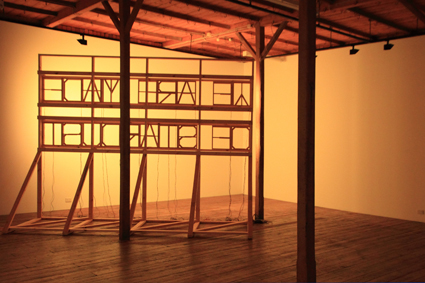
Michaela Gleave, We Are Made of Stardust, 2013
courtesy of the artist and Anna Pappas Gallery
Michaela Gleave, We Are Made of Stardust, 2013
The expression “We are made of stardust” both positions humankind within a vast, magnificent universe and reduces us, notionally, to the ashes of which everything consists. It’s the central message—at face value, at least—of Michaela Gleave’s Universal Truths, an exploration of the search for meaning inspired by a research residency with the CSIRO’s Astronomy and Space Science Division.
At Anna Pappas Gallery in Melbourne, Universal Truths comprised five works ranging from the quietly mesmerising We Are Made of Stardust—a large billboard-like installation emanating coloured LED light along with its message—to smaller LED pieces and a series of Lambda prints on photographic rag paper. The works responded in different but interrelated ways to the artist’s time at facilities including the Australia Telescope Compact Array at Narrabri and the Bureau of Meteorology solar observatory on the same site.
Asked about the ideas the residency prompted, Gleave first describes her fascination with the language she encountered—hearing how astronomers use the word ‘sky’ for example, “which I’d thought might be a very old-fashioned way of approaching the universe,” and discovering first-hand how the terminology used exposes the historical evolution of science.
“The residency made me acutely aware of how fleeting ideas about reality can be, especially in astronomy, where the field is leaping ahead in such vast steps […] I also thought a lot about the knowledge that is left behind by so-called advances: there is a process of forgetting that comes about through the de-valuing of older knowledge systems, and we potentially lose valuable ‘truths’ as a result.”
Ultimately, says Gleave, the science of cosmology is “just about trying to find meaning in our own lives. It becomes about how we see ourselves in relation to our surroundings.”
We Are Made of Stardust dominated the small upstairs room at Anna Pappas. On a utilitarian wooden frame were arrayed hundreds of LEDs, spelling out the work’s eponymous message and linked to an RGB controller, wiring exposed and dangling. The coloured light morphed through the rainbow—pink to red to vermilion to gold to lemon to lime to emerald and beyond—a visually lush reference to advertising, constellations, starfields. Crucially, the entire structure was positioned to face the meeting of two walls, rendering the message obscure until the viewer walked into its blind corner. From ‘inside’ the corner the words shone bright, searing into the retina; while ‘outside’ the impression was of nebulous but ever-present influence.
The glowing LEDs are, says Gleave, an extension of previous experiments with light as a tactile medium; suggesting romance and whimsy, as well as advertising’s false promises.
“With We Are Made of Stardust I [also] wanted to capture the extreme senses of scale that are often behind my atmospheric installations, using text as a means of conveying large ideas whilst maintaining a very personal and tactile response to the physicality of the object and the present-ness of the individual’s experience. Billboards are vehicles for fiction, often used to stand in for much larger physical presences.”
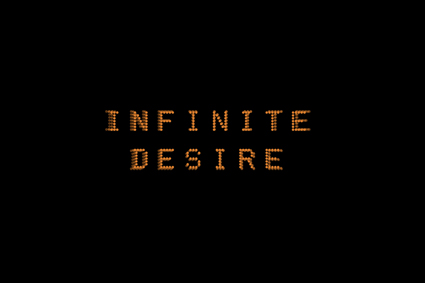
Michaela Gleave, Infinite Desire, 2013
courtesy of the artist and Anna Pappas Gallery
Michaela Gleave, Infinite Desire, 2013
A pair of small works, Universal Truth and Infinite Desire, echoed We Are Made of Stardust with their aspirational sentiment; each was a small wall-mounted sign, again made of LEDs, referencing, in Gleave’s words, “tacky signs hanging in convenience store windows or cheap beauty salons, hyper-luminous…” In their deep box frames, between panes of dark glass, the LEDs, mounted at the front surface, reflected their monochromatic dots of light off the back panel to create a receding procession of images; truth and desire fading into a false third dimension. The signs drew attention humbly, while around them on the white walls the shifting colours of the larger work provided a constant reminder of that eternally morphic stardust.
“The text in [both Universal Truth and Infinite Desire] recedes into the infinite darkness,” says Gleave, “[they are] bittersweet pronouncements commenting on the contradictions of our human desire for understanding. There are no universal truths when even the speed of light, thought to be a universal constant, has been seen to change. And despite science telling us that there is no meaning to life, science’s very existence is due to the persistent human desire to find meaning.”
Model for the end of the universe (1–4) and Untitled (Teufelsberg, 2010) scaled the viewer’s experience down further, towards its limits. The former, a series of four Lambda prints, presented sets of small symbols on deep black backgrounds—curving arrowheads, or little dots like abstracted entities. Each print refers to a potential entropic ‘end-point’ proposed by current scientific thinking, says Gleave; they are based around dance notation and created as “an event-based score.” The latter work was a photograph—a close-up of concrete tarmac covered in fragments of broken glass. The image, so pedestrian, seemed to zoom back out to infinite scale, asking ‘where are we in all this?’
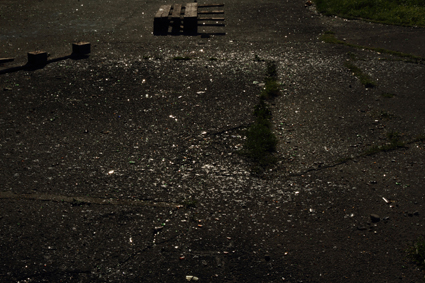
Michaela Gleave, Untitled (Teufelsberg 2010), 2010
courtesy of the artist and Anna Pappas Gallery
Michaela Gleave, Untitled (Teufelsberg 2010), 2010
Gleave points to the inevitable interpretations of images that, as humans, we’re driven to make: “The broken glass appears as a field of stars, blues and reds refracted from the white light, with cracks in the concrete and strips of grass standing in for the dark of gas clouds. […] To me this image is a partner piece for the billboard. We are made of stardust, yet ultimately we’re grounded and our immediate present is all we really have.”
Though dominated by its quasi-billboard, Universal Truths was an understated show, requiring—and rewarding—contemplation. Somewhat coolly, Michaela Gleave presented a field of observation, referencing the stars but subtly illuminating points of reference closer to home: our billboards and petty concerns, blinking lights and everyday desires. Far from suggesting that we are insignificant, the work somehow raised pavement debris, consumer-driven desire, human finitude and the mysteries of the universe to the same level. The ‘gallery space’ perhaps mirrored ‘outer space’—distant and inscrutable at first, but opening up to investigation. Not quite able to place ourselves, visitors were there, nevertheless, bathed in light—observers implicated (and somehow validated) in the process of observing.
Michaela Gleave, Universal Truths, Anna Pappas Gallery, Prahran, Melbourne, 2 July-3 August, 2013; http://annapappasgallery.com/
See also Darren Jorgensen’s review of A day is longer than a year at PICA
This article first appeared as part of RT’s online e-dition 11 Sept, 2013
RealTime issue #117 Oct-Nov 2013 pg. 45
© Urszula Dawkins; for permission to reproduce apply to realtime@realtimearts.net
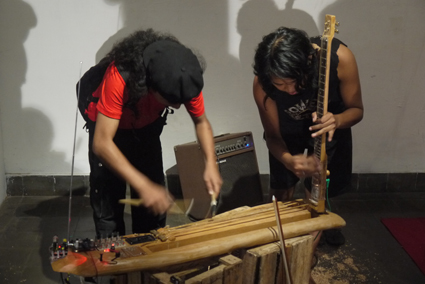
Lintang Radittya, Ikbal S. Lubys performing with Wukir Suryadi’s Akar Mahoni (Mahogany Root)
photo Joel Stern
Lintang Radittya, Ikbal S. Lubys performing with Wukir Suryadi’s Akar Mahoni (Mahogany Root)
Recently the Australian International Cultural Council (AICC) announced funding for a number of Australian/Indonesian cultural projects and the first of these was The Instrument Builders Project. I wanted to check it out not only because it sounded like fun, but as an Australian artist living in Indonesia, I’m very interested in the broader issues surrounding the Australian Government’s re-definition of ‘cultural diplomacy’ in light of the recent Australia in the Asian Century White Paper.
Within days of the instrument builders arriving I’d heard rumours about the artists who had hiked up Mt Merapi (the active volcano about 40km from the city centre) and installed devices that produced sounds from shifts in the atmospheric conditions near the crater. The installation was devised by Andreas Siagian, one of the founders of Lifepatch, a Yogya geek/art collective, in collaboration with Pia Van Gelder from Dorkbot and Serial Space in Sydney and Michael Candy, a young media artist from Brisbane. (For more on this project read next week’s In Profile feature on Pia van Gelder.)
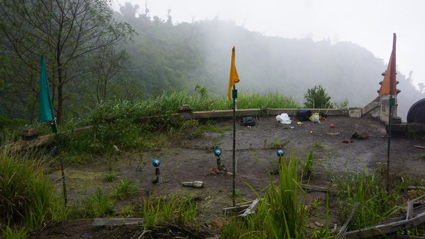
Michael Candy, Pia Van Gelder, Andreas Siagian
MOS (Mountain Operated Synthesizer), 2013
The rest of The Instrument Builders Project took place at iCan (Indonesian Contemporary Art Network), a space for open ended, research driven, multidisciplinary projects in Yogyakarta. Given the short time that the Australian artists had in the country (three weeks), they got straight to work constructing and modifying instruments, discussing their various approaches, playing together and preparing to exhibit their work.
I’m a big fan of Wukir Suryardi’s work, in particular his band Senyawa which combines rigorous research into traditional music, experimental approaches and a disciplined theatricality. Other participants came from very different backgrounds and I was curious to know how this combination would resolve itself. Dylan Martorell for example, makes percussive instruments from found objects with a loose DIY aesthetic, Rod Cooper is a sculptor and Ardi Gunawan is fast developing a profile in both Australia and Indonesia as a visual artist interested in process driven projects.
I attended the three public presentations in the final week of the project, each of which had moments of brilliance, where the dialogue between all of the participants was resonant and compelling, and at other times descended into noisy chaos. One of the sweetest moments came after a particularly loud section, when ethnomusicologist Asep Nata played a minimal, unamplified interlude with a jaw harp and a steel bell. For an excruciating moment it seemed something had gone horribly wrong, until one by one the other musicians returned to the performance.
To the curators’ credit the performances were not so structured that they eliminated risk or the possibility of failure, or tried to pander to the audience’s expectations. Instead they presented the instruments in different contexts over the three public showings. The first was a group improvisation with a choreographed dance work. The second showcased each instrument, followed by a loosely structured composition (arranged by Gatot D Sulistiyanto and Tony Maryaan from the Yogya group Art Music Today). For the final showing the instruments were presented as an installation that could be played by the audience. Without sacrificing its experimental nature, the project was framed in a way that gave the audience a number of entry points and just enough information to see where they were going. Yogya can be fabulously DIY but sometimes a little lazy when it comes to presentation and The Instrument Builders Project certainly raised the bar in terms of professionalism.
I talked to a number of the participants about their experiences and their thoughts about cross-cultural exchanges. Dylan Martorell pointed out that this project happened within a continuum of projects between experimental sound artists in Australia, Indonesia and elsewhere. Several of the Indonesian artists had performed in Australia and some of the Australians (including Martorell) had previously worked in Indonesia. “It’s not like we suddenly turned up in a remote village wanting to collaborate with traditional musicians. Basically everyone involved here is interested in the same kinds of music, so in that sense we already shared a common language.”
Kristi Monfries, one of the project co-curators, was a little more circumspect. “Working in a cross-cultural environment, like it or not, there’s often misunderstanding, mainly through language or a misreading of cultural conditions. In many ways our job as the curators of this highly collaborative project was to not only select artists on their artistic merit but also on their openness to adventure and experimentation.”
Co-curator Joel Stern added, “There are differences, but mostly practical ones. In Indonesia the cost of living is cheap and so is the cost to build or buy stuff and work on a scale that is unaffordable for most artists in Australia. On the other hand, in Australia you can access funding for experimental projects a lot more easily than in Indonesia.”
Indonesian artists don’t have the luxury of government grants to fund their projects and often rely on money from foreign governments to fund non-commercial or experimental projects. It’s significant to note that Japan, the US, France, Germany, Holland and other countries generously fund Indonesian artists and organisations. Until recently, Australia has been conspicuously reticent, only willing to fund projects that promote Australian product abroad.
AICC’s recent shift to funding collaborative projects is welcome, although still falls short of what other countries contribute. Given the rapid social change currently happening in this region and the accompanying explosion of cultural debates and artistic production, it seems a lost opportunity for Australia to not participate more proactively.
Collaborative projects, when they work, can be transformative for everyone involved, opening up ongoing dialogues and exchanges and sometimes producing unexpectedly great results. While ‘cultural difference’ is an overused and often misunderstood term, practical differences in each country undeniably influence the way a work is produced and received—well conceived collaborations such as The Instrument Builders Project are able to harness the best of both worlds.
The Instrument Builders Project, curators Joel Stern & Kristi Monfries, artists Rod Cooper, Dylan Martorell, Pia Van Gelder, Michael Candy, Wukir Suryadi, Asep Nata, Ardi Gunawan, Andreas Siagian, iCan (Indonesian Contemporary Art Network), Yogyakarta, Indonesia; 24 June-16 July, 2013; http://theinstrumentbuildersproject.com/
RealTime issue #116 Aug-Sept 2013 pg. web
© Malcolm Smith; for permission to reproduce apply to realtime@realtimearts.net
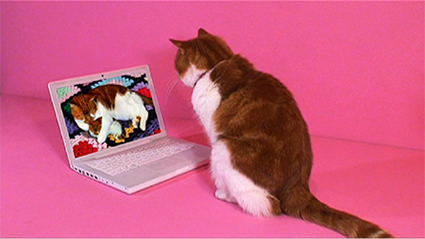
Jessica McElhinney, CatTube, 2011
At the turn of the millennium video festivals and screening programs were reaching plague proportions, but now that screens themselves have become infestations and we live on a drip-feed diet of YouTube, the festivities have been floundering for want of a cohesive context. This is a challenge Channels, the newest video festival on the block, is tackling head on.
Channels has been initiated by an all-lady curatorial team of Jessie Scott, Rachel Feery and Eugenia Lim. The women met while participating in the Next Wave Kickstart program and over the years have, independently and collaboratively, curated a range of video and time-based media events. I asked Lim what compelled them to launch a new video festival. She suggested that perhaps there is currently “a loss of criticality about the medium. It seems like the history of video gets lost and re-invented with each generation. I think we felt that now was a good time to try and connect to that past but also to look at the directions video is going in. It seems to be in constant mutation. [The impetus] was a combination of our own experiences of programming and curating up to this point, trying to look critically at the practice, and also [a desire] to promote video to a wider audience, making it accessible but with a certain rigour to it. [We want] artists working in this way to feel like they’re part of a larger community and audiences to get a look at some of the finest work that we feel is being made at the moment.”
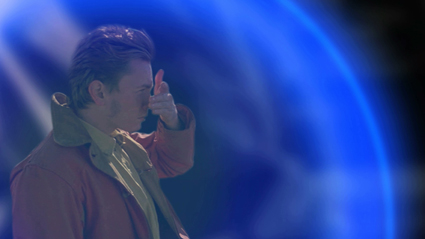
Soda_Jerk, The Phoenix Portal, 2005
Channels is attempting to present video as a medium in a range of manifestations. At the core of the event are the single-channel screenings drawn from an international open call that attracted 900 entries. These have been narrowed down to 33 works split across two thematic screening sessions; Sensory Drive + Media Mash-ups and Constructed Worlds + Bodies Collide (see ticket giveaway at the end of this article).
In an attempt to reach a wider audience, the main screenings will be in the ACMI Cinemas. There’s also a program specifically curated for Federation Square’s big screen, Channel Surf, which has been carefully programmed to suit the less concentrated viewing context. Lim says, “Channel Surf is a nod to that transient experience of passing through. The works that we are showing there are almost visual billboard works that you can come in and out of […] There are some really great artists being shown—Jessica McElhinney has made a really great work called CatTube. It’s a wonderful, concise look at internet and video culture…For us it was a great opportunity to try and screen something in such a high foot-traffic, general public kind of space. It’s a way of broadening the reach and the awareness of what else we’re doing.”
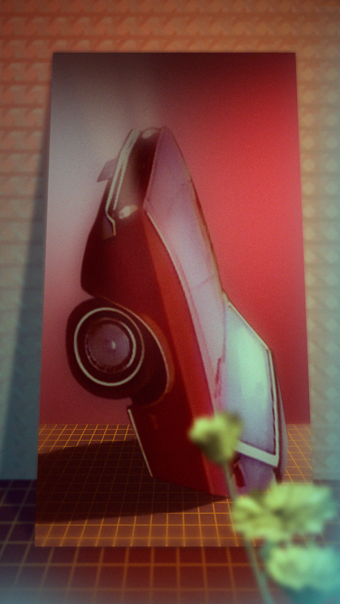
Ms&Mr, Videodromes for the Alone series: Amputee of the Neurotic Future 1988:2012
The other cornerstone of the festival is Transformer, an exhibition at ScreenSpace comprising two commissioned video installations. Ms&Mr will continue their Videodromes for the Alone series with Amputee of the Neurotic Future 1988:2012 which incorporates footage from the artists’ own videographic past into a JG Ballard-Cronenbergian contemporary reality. This will be exhibited as a three-channel work with an automotive sculptural component. Both complementing and contrasting with this will be Benjamin Ducroz’s Cumulo, filmed in the Pilbara, combining stop motion animation of cloud formations and a kinetic sculpture which appears on screen and as an object in the space.
Exploring the relationship between video and performance art is Mirror Screens, co-curated with Laura Castagnini. This comprises three specially commissioned performances by Emile Zile, Hannah Raisin and Salote Tawale where each artist has made a new performance/video piece (ie performance on, for or with video) inspired by a work from the historical avant-garde canon. For example Zile, appearing via Skype, will conduct a wake, using a roll call of names generated from Russian spam and scam sites that references Ant Farm’s 1975 performance Media Burn.
But don’t turn the dial yet—there’s more. Co-presented with the Victorian College of the Arts, US performance and video artist Barbara Rosenthal is a special guest delivering her lecture “Old Masters of New Media,” an overview of her prolific career from 1963 to 2013. There’s also a forum, Video Art In The Internet Era featuring Vernon Ah Kee, Ian Haig and Norie Neumark with video postcards from Skip Blumberg, Joel Stern and Soda_Jerk. Channels has also teamed up with the ikono On Air Festival, an international event which sees artfilms broadcast across the world on satellite channels and via internet streaming (see last week’s In the Loop).
No video festival is complete without some outdoor projections, in this case a program called Nocturnes screening on Chin Chin’s Wall of Art on the corner of Higson and Flinders Lanes. And of course there’s a party to finish off the event in style. Channels has teamed up with Speakeasy Cinema (run by Ghita Loebenstein) to present Videodromes, including VJ performances, smoke installations and a beanbag cinema. So if you’re in Melbourne, get off the couch and go surfing.
Channels Video Festival, curators Jessie Scott, Rachel Feery, Eugenia Lim, program associate Ghita Loebenstein, Memory Screens co-curator Laura Castagnini, ACMI and various venues, Melbourne, 18-21 Sept; Transformer exhibition, ScreenSpace, 12-21 Sept; http://www.channelsfestival.net.au/
GIVEAWAY: Channels festival is offering one double pass to the Video Visions sessions 1 & 2; email onlinegiveaways@realtimearts.net with Channels in the subject line (by Sept COB Sept 12).
Barbara Rosenthal will also be appearing in Brisbane at Metro Arts (Oct 4), Audiopollen (Oct 6), Room60 Talks (Oct 9) and IMA (Oct 10).
RealTime issue #116 Aug-Sept 2013 pg. web
© Gail Priest; for permission to reproduce apply to realtime@realtimearts.net
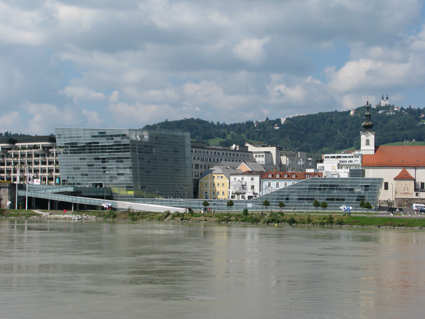
Ars Electronica Centre on the Danube, Linz
photo Gail Priest
Ars Electronica Centre on the Danube, Linz
It’s that time of year again, the first week of September and you are in Linz for Ars Electronica. Let’s imagine you’ve been lucky enough to win a Golden Nica. You’ve arrived, installed your work at the O.K. (say oh-kah) Offenes Kulturhaus for the Cyberarts Exhibition. Everything’s working, you’ve done your interviews with ORF (Österreichischer Rundfunk/Austrian Broadcasting), been through the Ars Electronica Centre , met up with some friends at the Futurelab and now what? What else is there to do in Linz other than Ars Electronica? It does appear to have embraced almost every cultural venue in the city. Well the simple answer is enjoy as much Austrian cuisine and lifestyle as possible.
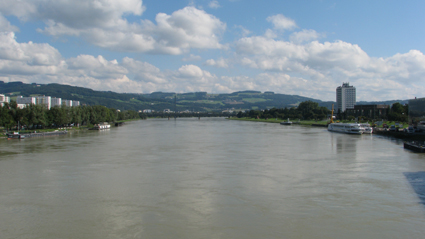
The Danube, Linz
photo Gail Priest
The Danube, Linz
Walk whenever you have time through the most charming areas of the city: Herrengasse, Altstadt, Hauptplatz and along the Danube. A Linzer looking to relax might start the day with a Viennese style breakfast. Perhaps Traxlymayr on the Promenade for those living the high life, or Café Meier on Pfarrplatz.
A brief but essential note on coffee for the Australian traveller. Ordering a café latte will get you something quite unlike what you love from your local coffee house. Don’t go there! A long black is called verlängeter (fer-leng-e-ter), a cappucino is still a cappucino and my recommendation for the would-be latte drinker would be to try a Wiener Melange.
A walk along Herrengasse can be recommended at any time of the day and close to the Dom (St Mary’s Cathedral) you’ll find Jindrak Conditorei, the one cake shop in town that can claim the right to the Original Linzer Torte (I use blind faith as a basis for this claim since every other cake shop in Linz claims to own the original recipe dating from 1653). Their other cakes are also amazing with unlimited combinations of sponge cake and flavoured creams. Definites to try are Apfelstrudel and Sacher Torte in any Austrian establishment. The Dom itself is magnificent inside and in recent years has hosted a night-time program of sound works during the festival.
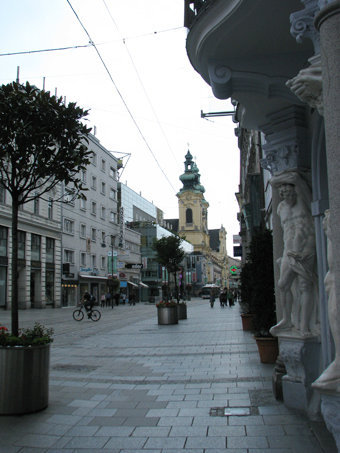
Linz
photo Gail Priest
Linz
Wander up to the Linzer Schloss. In fine weather the Schloss Cafe garden is a fine place to have a light meal or drink and look out across the Danube and the Nibelungen Bridge. If it happens to be Friday morning, there is a little farmers’ market on the Hauptplatz, a great place to buy yourself some bread and fresh produce.
If the weather happens to be awful and/or your hangover from celebrating your Nica for the third night in a row happens to be too much, then a visit to the Parkbad Sauna Oasis is just the ticket. A swimming pool, indoor and outdoor in summer, combined with an excellent array of saunas and spa baths, makes a good comedown after all your hard work.
For Dinner there are many options. If you have fine weather then find your way to Schindler’s Heuriger and order a Schindler’s Jauser. It’s perfect for two people, a simple meal of sliced cold meats, fresh brown bread, a few special dips like Kartoffelkäse (potato cheese) and a schnapps in the centre. Combine that with a Wieselberger beer or two and you’ll be feeling fine. A local wine festival has also wedged itself into the festival weekend in the Altstadt (old town) and this makes for a romantic evening sipping fine wines; try the Zwiegelt.
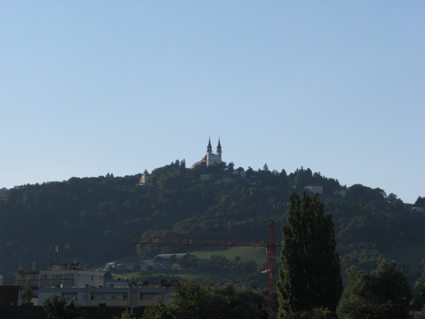
Pöstlingberg, Linz
photo Gail Priest
Pöstlingberg, Linz
Alternatives, keeping with some Austrian traditions, include making your way to Gelbes Krokodil at the O.K. Platz or to Alte Welt off the Hauptplatz. Wirt am Graben (on a street called Graben) is really great if you can get a table, or embrace the beer hall tradition with the Stieglitz on Landstrasse. Cubus atop Ars Electronica always serves an excellent meal with a great view. If you want to feel super special however, take the tram up to Pöstlingberg (that little Disney looking church overlooking Linz) and dine at the Pöstlingberg Schlossl with a table on the balcony. You’ll spend your hard earned Nica money, but you’ll eat and drink in fine style.
And if after all that coffee, food, cake, wine, meat, beer you still want more and all those ice cream stands on the hauptplatz are tempting you, don’t try them yet. Walk around to Eisdieler on the Promenade and enjoy one of the best ice creams ever. Seriously!
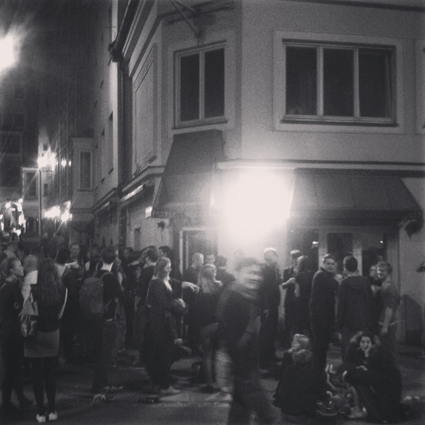
Rote Krebs, Linz
photo Matthew Gardiner
Rote Krebs, Linz
If you’ve slept the whole day, you’re just waking up at night time and you’re back in festival mode, the two bars that are a must for the festival goers are Strom on the main deck of Ars Electronica and the Roter Krebs across the river. Going back along the Landstrasse you’ll find a few other watering holes including Walkers on Hauptplatz, which serves good burgers, or the Chelsey on Domgasse, a little English pub serving Guiness on tap. Extrablatt on Spittelwiese also serves good burgers and is open late. Finally you should be seen at Solaris in the O.K. or, on the Saturday night of the festival, upstairs at the O.K. festival party.
—-
Matthew Gardiner has lived in Linz as an artist and researcher at the Ars Electronica Futurelab since 2011. He recently curated “Projekt Genesis: life out of the laboratory” at the Ars Electronica Center. You can find him in the festival program, usually giving a talk, or else out late with beer in hand; if you are an Australian in Linz don’t be a stranger. http://www.matthewgardiner.net/
Check out RealTime’s Media Art Archive for coverage of Ars Electronica over the last 19 years
Links
Ars Electronica Festival http://www.aec.at/totalrecall/en/
Ars Electronica Centre http://www.aec.at/
Offenes Kulturhaus http://www.ok-centrum.at/?q=en
Traxlymayr http://www.cafe-traxlmayr.at/
Café Meier http://www.cafe-meier.at/
Schindler’s Heuriger http://schindlers-heuriger.stadtausstellung.at/
Gelbes Krokodil http://www.krokodil.at/
Alte Welt http://www.altewelt.at/
Wirt am Graben http://www.wirtamgraben.at/
Cubus http://www.cubus.at/
Pöstlingberg Schlossl http://poestlingberg.at/
Eisdieler http://www.eisdieler.at/
Strom http://www.stwst.at/index.php?m=4&sm=1
Roter Krebs http://www.roterkrebs.net/
Walkers http://www.walker-bar.at/
Solaris http://www.solarisbar.at/
RealTime issue #116 Aug-Sept 2013 pg. web
© Matthew Gardiner; for permission to reproduce apply to realtime@realtimearts.net
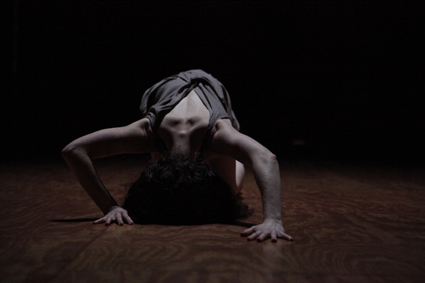
Blizzard, Nat Cursio Co
photo Rachel Bernhaut
Blizzard, Nat Cursio Co
Nat Cursio has written that Blizzard, her latest work for three dancers, presents “animal/human bodies” as “acute listening devices” proposing “a reminder of the delicacy of an ecosystem…a tribute to the ongoing capacity of animal life to…adapt.” At a glance this is a compelling premise for meaningful work and Blizzard does yield some exquisite moments, but as the attempt to translate bodies into devices might suggest, it is not without risk and confusion.
The show opens with confidence and an entrancing sensorial scheme. We are seated in a circle and asked to keep our eyes closed for the initial 10 minutes: a prompt that transforms the vast Newport substation into a nerve-tingling and purely aural field. Sounds are born in the darkness: body-generated, mingling with the whoosh and rumble of nearby trains; sporadic squishing; a rhythmic shuffle of someone—something—prowling about. Alert and somehow prepared by a slightly fearful awe, we open our eyes. The image before us holds something of the sublime.
Head down, the nape of its neck exposed, hair dragging over the floor, a dancer/creature advances in hypnotic slowness into the circle’s centre and out. Its lithe muscles ripple under lunar light; its palms slap the floor; its husky, bronchial purr is in equal parts sleepy, menacing, sensual. What creature is this?
A biped with searching feelers follows, then the intricate undulations of some kind of grub, both with faces averted downward. The enchanted focus of a nature documentary is engendered here. The creatures convince us, with their reconfigured anatomies. At best, we forget we are watching people (then remember); a sensibility beyond the confines of our own species may arise. It’s a beautiful spell, but soon broken.
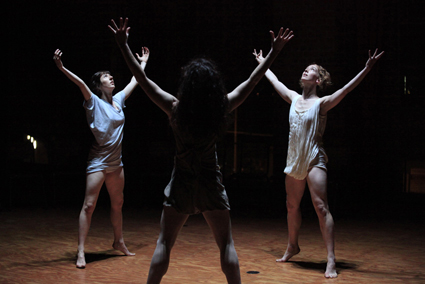
Blizzard, Nat Cursio Co
photo Rachel Bernhaut
Blizzard, Nat Cursio Co
The three dancers return to the circle—heads lifted, bipedal—and attune to a series of partly synchronised moves: tip-toed, sideways shuffles; pumping elbows; adjustments of footing; full-bodied flourishes with raised legs. There are synchronised gasps too and the timing is impeccable, but the vocabulary is often more mechanistic than organic, laden with nuances that conflict and confuse. Whether these are now insects or mammals is irrelevant, the style itself is unclear: a cerebral medley that evolves very little beyond the rise of an anxious mood.
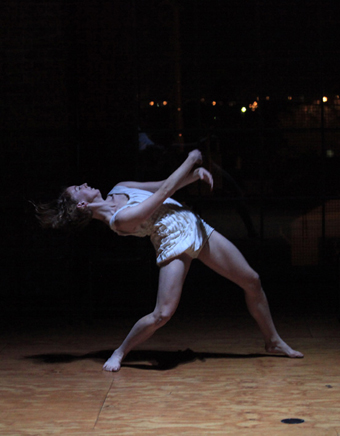
Blizzard, Nat Cursio Co
photo Rachel Bernhaut
Blizzard, Nat Cursio Co
What really aches in this piece is the dancers’ isolation, the absence of palpable relationships between them and toward us, the circled audience. Ecosystems operate through webs of symbiosis and reciprocity, cause and effect, yet in Blizzard we are presented with, at most, synchronisation, and otherwise with self-absorbed dancers who do not make contact by touch or gaze. Yes, they appear to be threatened, sometimes injured, perhaps endangered, but their neurotic loops of movement resemble the distress of captive animals, not the canny adaptation and outward-directed intelligence of the wild. This may be misguided anthropomorphism: more about the pain of the modern human condition than of creatures of the wild. Whatever the case, the cool distance inspires no affinity.
Just one moment toward the end unites the three dancers, as they gradually find and hold each other’s hands. But it is overdue, too slight and fleeting to mean very much. The great moments, in fact, are played at the start, through bold use of aural and sensory space, and the hushed arrival of that faceless, purring creature as it forges its path.
Blizzard, choreographer Nat Cursio, performers Alice Dixon, Melissa Jones, Caroline Meaden, The Substation, Melbourne, 30 July-4 August
See Philipa Rothfield’s preview of Blizzard in RT’s Online e-dition July 24
This article first appeared as part of RT’s online e-dition 4 Sept, 2013
RealTime issue #117 Oct-Nov 2013 pg. web
© Jessica Sabatini; for permission to reproduce apply to realtime@realtimearts.net
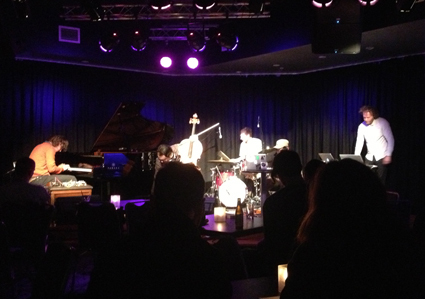
Tangents
photo Gail Priest
Tangents
The New Music Network soiree in the Sound Lounge starts when Sam Gillies, the electronic half of Cycle ~440, issues from his laptop a dirty sonic remnant. It has just enough timbre intact to be recognisable as something that might emanate from the currently silent piano on the corner of the stage.
After a meditative while he’s joined by Kevin Penkin whose cleanly placed real-time piano notes are sampled by Gillies—he catches them, hanging on to their tails, extending, bending and shredding them. The piano notes begin to accumulate forming rippling figures chased by electronic spectres.
Cycle ~440 offers a complex approach to the electro-acoustic relationship. While electronic instruments so frequently deliver sustained drone and continuity, it’s the fluidity of the piano that hold this music together. Gillies is a master of restraint (or so it seems), delicately adding staticky beds and glitchy half-beats wrestled from the live sampled piano, or sharpening the jingle-jangle of tones. Penkin surfs the waves—both those emanating from his own playing in the moment and the delayed and dirtied version of himself. His harmonic predilections are sweet and melancholic, reminiscent of surging film scoring. (He cites a love of Japanese anime music in the program notes.)
Then Gillies lets rip—a blast of noisy static, out of nowhere, then gone. While there has been grit in the under-layers, this discharge of detritus is disturbing not just for its suddenness but its brevity. This occurs one or two times more within the set. It seems harder to contextualise these eruptions of noise within the otherwise very pretty frame, than if noise were to swallow the niceness whole for the remainder of the piece. I’m off-balance, both wanting more noise to create a new context, yet feeling resentful of its intrusion.
The set concludes with Gillies, back to his genteel self, spinning out a tiny, sweet harmonic drone suspending the final utterance of the once more silent piano. It’s been a beautiful ride, and while I’m not totally convinced by the ruptures, I’m interested in their power to perplex my structural expectations.
Headlining the evening is Tangents, a veritable supergroup for the exploratory music lover: Adrian Klumpes (Triosk) on piano and electronics; Peter Hollo (Four Play/Raven) on cello and electronics; Ollie Bown (Icarus) on computers; Shoeb Ahmad (guitar, vocals, computer) and Evan Dorrian (drums) both from Spartak. True to their name they play a meandering, tangential free jazz with enough harmonic confluences and electronic kinks to keep everyone happy.
As often happens with this style it starts minimally with Klumpes playing simple chords in mid and low registers, with just a whiff of delay and dirt. Dorrian finger-flicks his tom and issues spatters from his cymbals, while Hollo emits mournful ‘screaks’ from his cello. There’s a remarkably early peak as they all find each other, the rhythm section locking into tit-for-tat syncopation.
What’s particularly interesting about this group is how easily the alliances shift: a brief tonal coalition between Klumpes and Hollo creates satisfying warm harmonics; Bown and Ahmad’s electronic squelches intermingle to become a textural undertow; Klumpes and Dorrian come together with jazzy jibes and angular phrases that propel the action. These connections allow the music to develop contours often missing in this crescendo oriented form. This is a music of coming together and falling apart but with someone always ready on the ground to move things forward.
In contrast to their first section the second starts with everyone smashing it out in a free-jazz noise assault until Klumpes and Dorrian ground everyone again with a groove. Bown and Ahmad maintain a mild scream of noise and Dorrian provides a skittering coherence. Without noticing the shift they are playing faster and faster, reaching a well-earned final crescendo and succinct wind down to finish.
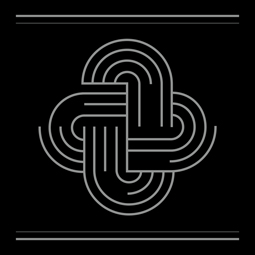
Tangents I, hellosQuares recordings
This gig was also the digital soft-launch (the physical product still in transit at the time) of Tangents’ debut album on Ahmad’s own label hellosQuares. While it was recorded in 2010 when the group was just forming, the current style is well represented, comprising five tracks each quite different in tone and approach—both spacious and complexly layered. While there might be a propensity to compare this group to The Necks, Tangents present a restless searching rather than the sustained single mindedness of that trio, however they manage to avoid a sense of attention deficit disorder often prevalent in this kind of music. Both live and recorded, Tangents offer a music of consensual diversions that makes for pleasantly discursive listening.
New Music Network: Cycle ~440, Sam Gillies, Ken Penkin; Tangents, Ollie Bown, Peter Hollow, Shoeb Ahmad, Adrian Lim-Klumpes, Evan Dorrian; The Sound Lounge, Seymour Centre, 1 Aug; http://www.tangentsmusic.com/; http://www.newmusicnetwork.com.au/
See RT116 giveaways for copies of the New Music Network Sampler.
RealTime issue #116 Aug-Sept 2013 pg. web
© Gail Priest; for permission to reproduce apply to realtime@realtimearts.net
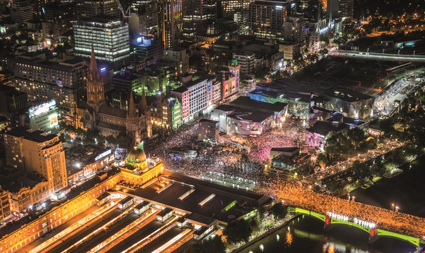
White Night Melbourne 2013
courtesy of the Victorian Major Events Company
White Night Melbourne 2013
Melbourne White Night
The White Night (Nuit Blanche) began in Paris in 2002—for one night, dusk till dawn, major arts institutions open their doors and culture fills the streets. In 2013 Melbourne joined 22 other international cities to present this 12-hour cultural extravaganza and now they’re planning the 2014 edition. They are calling for expressions of interest from musicians, visual and performing artists to infiltrate the centre of Melbourne on 22 Feb, 2014
Submissions close 1 Oct 2013; http://whitenightmelbourne.com.au/
Jump Mentoring
The Australia Council’s Jump mentorship applications close soon. Mentees can apply for up to $10,000 (solo artist) or $20,000 (group) to assist with professional and creative development. The program also involves an intensive in Feb 2014 where all mentees meet up for further networking, skills development and discussion.
Deadline 9 Sept; http://www.australiacouncil.gov.au/grants/2013/jump
Summer Studio Residency, Penrith Regional Art Gallery
Penrith Regional Art Gallery has announced an inaugural summer residency for an early career artist. The spacious Sonia Farley Studio (52sq metres) is available for a six-week period (non-residential) 2 Dec-10 Jan. At the conclusion the artists will make a presentation and have the opportunity to propose their work for the Artist Board program.
Applications due 14 Sept; http://www.penrithregionalgallery.org/
Fast+Fresh Dance, FORM Dance
Fostering young dancers and choreographers, Form’s Fast+Fresh Dance competition is open to artists 21 and under. Works must be five minutes or less and all styles are welcome. Awards will be given for Most Outstanding Choreography, Best Male and Female Dancer, Best Solo, Best Duet and Best Group and People’s Choice Award.
Registration closes 14 October; http://form.org.au/2013/01/fastfresh-dance-2/
FlickerFest call for entries
Flickerfest, celebrating its 23rd year, has opened its call for short films (under 35mins) for the 2014 competition. Categories include Australian, International, Documentary, GreenFlicks (environmentally focussed) and FlickerUp (for high school and primary students) with awards for Best Short, Best Animation and Best Australian Short.
Deadline for Australian & International entries 11 Oct; for GreenFlicks & FlickerUp 18 Oct; http://www.flickerfest.com.au/
Still in the loop
Workshops & Residencies, Lucy Guerin Inc
Applications for studio residencies & workshop places due 23 Sept; http://www.lucyguerininc.com/studio-projects/Studio_Residency; http://www.lucyguerininc.com/studio-projects/Hotbed
Critical Path Responsive Residencies
Deadline for Responsive Residencies 9 Sept; Research Room residencies no deadline, subject to availability; http://www.criticalpath.org.au/documents/2014_ResponsiveProgram_GuidelinesforApplying.pdf
Next Generation Placement, ASSITEJ
Deadline for applicants 30 Sept; http://www.assitej-international.org/next-generation/
Forever Now
Applications open until June 2015; http://forevernow.me/
Selected Australia Council Grants
for full list see http://www.australiacouncil.gov.au/grants
Community Partnerships: Projects – 6 September 2013
http://www.australiacouncil.gov.au/grants/2013/community-partnerships-projects-6-september
Community Partnerships: Cité Residency – 6 September 2013
http://www.australiacouncil.gov.au/grants/2013/community-partnerships-cite-residency
Community Partnerships: Career Pathways – Structured Mentorships – 6 September 2013
http://www.australiacouncil.gov.au/grants/2013/career-pathways-structured-mentorships-community-partnerships-6-september
Community Partnerships: Projects with Public Outcomes – 6 September 2013
http://www.australiacouncil.gov.au/grants/2013/community-partnerships-projects-with-public-outcomes-6-september
Festivals Australia – 6 September 2013
http://www.australiacouncil.gov.au/grants/2013/festivals-australia-6-september
JUMP Mentoring – 9 September 2013
http://www.australiacouncil.gov.au/grants/2013/jump
Music: Fellowships – 17 September 2013
http://www.australiacouncil.gov.au/grants/2013/music-fellowships
Music: Project Fellowships – 17 September 2013
http://www.australiacouncil.gov.au/grants/2013/music-project-fellowships
Music: Don Banks Music Award – 17 September 2013
http://www.australiacouncil.gov.au/grants/2013/don-banks-music-award
Music: Skills and Arts Development – Artist Development – 17 September 2013
http://www.australiacouncil.gov.au/grants/2013/music-skills-and-arts-development-artist-development-17-september
ArtStart – 23 September 2013
http://www.australiacouncil.gov.au/grants/2013/artstart2
RealTime issue #116 Aug-Sept 2013 pg. web
© RealTime ; for permission to reproduce apply to realtime@realtimearts.net
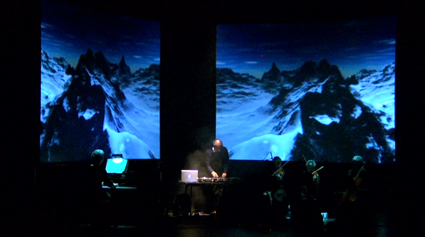
DJ Spooky
All rights reserved by New Mexico PBS
DJ Spooky
Curating Cities, NIEA
NIEA will be presenting a forum led by Paul Miller (aka DJ Spooky) as part of the ongoing Curating Cities project, researching how “the arts can generate environmentally beneficial behavioural change” (website). He will be discussing his participation in a sustainable art and music project at the Tanna Center for The Arts in Vanuatu. He will also be joined by Professors Douglas Kahn and Richard Goodwin.
NIEA (National Institute for Experimental Arts): Curating Cities, EG02, E Block, College of Fine Arts (COFA), UNSW, Paddington; 6 September 2013, 2.30-3.30pm; http://www.niea.unsw.edu.au/events/20130823/curating-cities-forum
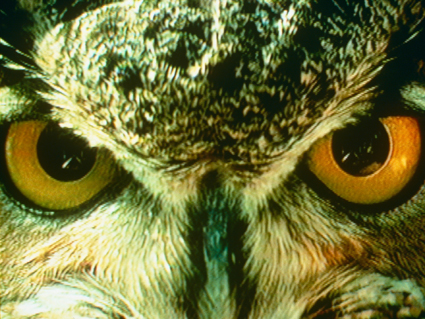
Bill Viola, I Do Not Know What It Is I Am Like, 1986 Videotape, colour, stereo sound; 89 minutes (still) © Bill Viola
photo Kira Perov
Bill Viola, I Do Not Know What It Is I Am Like, 1986 Videotape, colour, stereo sound; 89 minutes (still) © Bill Viola
ikono On Air Festival
ikono is a German-based organisation with an agenda to broadcast innovative art from across the world, both historic and contemporary. Across September they are presenting an “on air” arts festival viewed via a range of satellite and cable channels across the world, as well as an internet streaming option. The festival will focus on non-narrative and time-base art practices showing an enormous catalogue of works by 120 artists including Bill Viola, Alfredo Jaar, Anthony McCall and Brian Eno. As well as the festival they also produce mini-documentaries taking tours through great museums of the world—check out their website for a cornucopia of trailers and art-bites.
ikono On Air Festival, 6-29 September, http://ikono.org/festival/
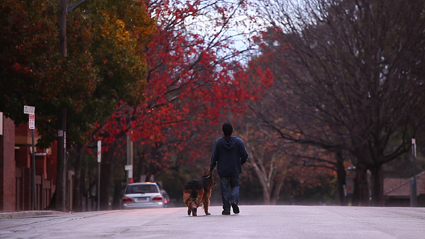
Post Life, ICE
Post Life, ICE
Based in Parramatta, Information and Cultural Exchange (ICE) has been running the Screen Transfusion project, a series of film and television production workshops for young people in Western Sydney. Some of these participants have then gone on to be part of the production team making the seven-part web series, Post Life. The ‘dramedy’ (dramatic comedy) follows John—a postal worker recently made redundant—as he tries to find a new path in life. Action is spiced up by Booboo, his daughter’s dog, an old lady sending mysterious packages and a love interest. The series will be launched with a screening at Riverside Theatres and will also be available online from 10 September.
ICE: Post Life, launch Riverside Theatres Parramatta, 10 Sept; http://ice.org.au/2013/08/web-series-trailer-post-life/
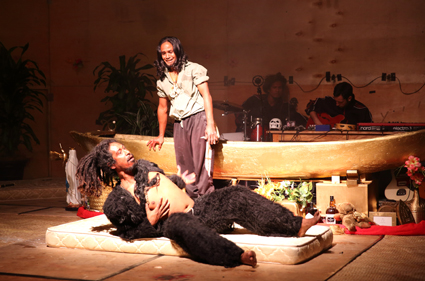
Doku Rai, Black Lung Theatre & Whaling C0mpnay, Liurai Fo’er and Galaxy
photo Tony Lewis, courtesy Adelaide Festival 2013
Doku Rai, Black Lung Theatre & Whaling C0mpnay, Liurai Fo’er and Galaxy
2013 Brisbane Festival
Read the small print in the 2013 Brisbane Festival program to find the really intriguing works. RealTime’s picks are, from Cairns, the magical Bonemap’s Terrestrial Nerve (11-14 Sept), their short free work Nerve Engine, (Sept 10, 11) where you help generate art [book online], Cut Snake (10-14 Sept), Insomnia Cat Came to Stay (24-28 Sept), Nicola Gunn’s Hello May Name Is (10-14 Sept) and MKA Theatre’s The Unspoken Word is Joe (10-14 Sept). Also in the program, the wonderful East Timorese-Australian collaboration Doku Rai, China’s Fight the Landlord, I Malvolio from the UK and Australia’s CASUS physical theatre.
Brisbane Festival, 7-28 Sept, http://www.brisbanefestival.com.au/
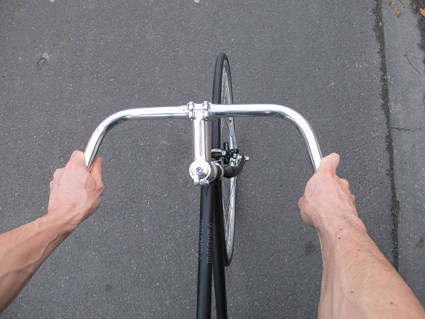
Akira Akira, Bicycle (a model for making-thinking), 2013, work-in-progress, Allegro Pista bicycle, mixed media
photo Sarah crowEST
Akira Akira, Bicycle (a model for making-thinking), 2013, work-in-progress, Allegro Pista bicycle, mixed media
arte magra: from the opaque, AEAF
Curated by Domenico de Clario and Mary Knights, arte magra: from the opaque exhibits the work/performances of 14 artists/collaborative teams. Arte magre—translated as lean or meagre art—builds on ideas explored by the Art Povera movement which preferenced conceptual pieces using simple, everyday materials. Many of the works will be site specific, such as Akira Akira’s Bicycle (a model for making-thinking), which can be hired from the BikeSA. Akira believes that making and thinking are as conjoined and co-dependent as the left and right leg, thus by riding his bike you experience this physical and conceptual balance. Other pieces include David Cross’s inflatable experiential sculptures; Joan Grounds’ documentation of shared walks with her dog; Jessica Lumb’s self-guided tour of the chewing gum on Hindley Street; and a site-specific performance by dancers Tony Yap and Janette Hoe. There will also be an accompanying symposium on 6 September.
arte magra: from the opaque, AEAF and various sites around Adelaide; 5 Sept-5 Oct, http://www.aeaf.org.au/exhibitions/ArteMagra.html
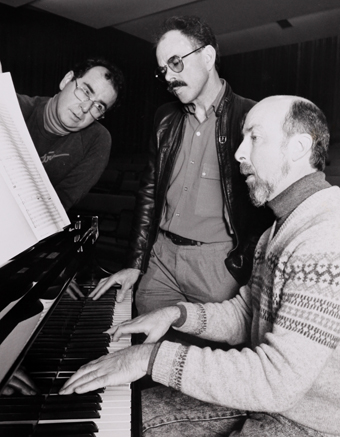
Ian McGrath, Peter Shepherd and David Vance in rehearsal, 1990, School of Creative Arts, University of Wollongong
30 years celebrations, Creative Arts, University of Wollongong
Congratulations to the School of Creative Arts, Wollongong University which is celebrating its 30th birthday. It’s no mean feat for a creative arts school to survive economic rationalism and the department will celebrate with a cocktail party, public performances, artist presentations and an exhibition, Transitions, featuring works by the staff, curated by Jelle Van De Berg.
Creative Arts Wollongong 30th Anniversary; Sept 9-11, http://lha.uow.edu.au/crearts/news/30thanniversary/index.html
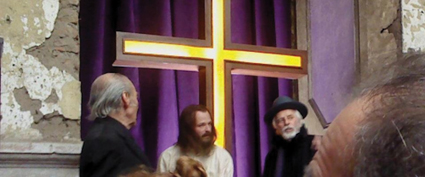
Dance of Reality, Alejandro Jodorowsky
Sydney Underground Film Festival
The Sydney Underground Film Festival is on again presenting over 30 of “the year’s most subversive, underground and cult films from around the world” (press release). The festival opens with Dance of Reality, the first film in 23 years by Chilean auteur Alejandro Jodorowsky—a psycho-magical interpretation of his life. Bookending the event is The Canyons written by Bret Easton Ellis, directed by Paul Schrader and starring Lindsay Lohan. In between, as well as other features, are shorts programs with titles such as LSD Factory, Lovesick, Reality Bites, Free Radicals and Ozploit.
Sydney Underground Film Festival, Factory Theatre, Marrickville, 5-9 Sept; http://suff.com.au
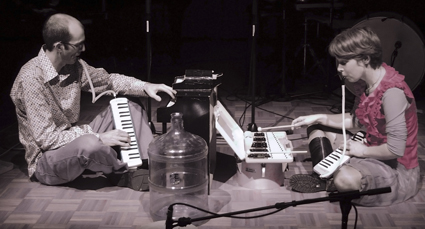
Clocked Out Duo
Melbourne Recital Centre
Diverse offerings at the Recital Centre this week. Clocked Out Duo perform Time Crystals (4 Sept) which premiered at Tura’s 25th birthday celebrations last year and of which Sam Gillies wrote, “The musical ground covered by the work is impressive. From the contemporary classical motifs of the opener, “Time Crystals,” to the jazz-like “Quantum Harmonics” and the rock-and-roll feel of “X-Ray Diffraction,” each work manages to balance its more distinctive sonic elements with cohesive structures that develop the work in exciting and unpredictable directions” (RT113).
On the same evening is Conversations with Ghosts, a collaboration between singer/songwriter Paul Kelly, composer James Ledger and recorder player Genevieve Lacy presented by the Australian National Academy of Music. The song cycle will feature texts by Kelly, Yeats, Tennyson, Judith Wright, Les Murray and Kenneth Slessor (4 Sept). Then riding high after his Festival of Slow Music (see last weeks in the loop), Adam Simmonds will perform with Wang Zheng Ting, master of the sheng, a Chinese mouth organ (7 Sept).
Various 4-7 Sept, Melbourne Recital Centre; http://www.melbournerecital.com.au/
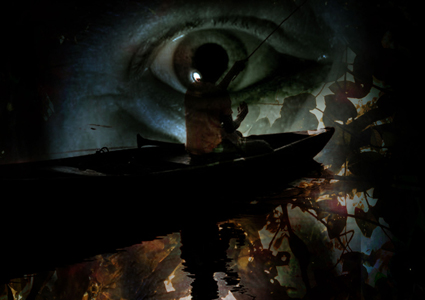
The boat goes over the mountain, Happy Dagger Theatre
The boat goes over the mountain, Happy Dagger Theatre
To make his film Fitzcarraldo, Werner Herzog faithfully recreated the titular rubber baron’s attempt to pull a steamship over a mountain in Peru. This new work, written and performed by Andrew Hale, pits his own experiences in Peru against Herzog’s, adding terrifying doses of the hallucinogen ayahuasca (yagé) used in shamanic rituals.
Happy Dagger Theatre, The Boat Goes Over the Mountain, Perth, 10-28 Sept, http://blueroom.org.au/events/the-boat-goes-over-the-mountain/
Still in the loop
Windows to the Sacred, S.H. Ervin Gallery
presented in association with Buratti Fine Art; 30 Aug-29 Sept
http://www.shervingallery.com.au/
Moogahlin Performing Arts, This Fella, My Memory
Carriageworks, 4-7 Sept
http://www.carriageworks.com.au/
Malthouse’s Helium
Little Ones Theatre, Salomé, 30 Aug-14 Sept
Smack! Bang, City of Shadows, Rachael Dease, 21 Sept-5 Oct
http://www.malthousetheatre.com.au/helium-2013/
In Confidence: Reorientations in Recent Art, PICA
31 Aug-13 Oct
http://www.pica.org.au
RealTime issue #116 Aug-Sept 2013 pg. web
© RealTime ; for permission to reproduce apply to realtime@realtimearts.net
Oscillation between deepening despair and jittery anxiety has been replaced by a sense of numb hopelessness in the last week of the 2013 federal government election campaign. If it weren’t for Crikey.com’s First Dog on the Moon and other doses of wisdom from that publication, The Conversation and Mungo McCallum in The Monthly, insanity might have ensued.
In contrast, the ABC’s ever-cautious entertainments, Gruen Nation and the tirelessly undergrad The Chaser, offer only mild relief. Perhaps one day we’ll have our own brave equivalents of Jon Stewart and Stephen Colbert. Meanwhile, with the polls having ‘determined’ the election outcome, hopelessness is slowly being usurped by fear of the election aftermath.
Peak panic
On the arts front, after all the hard yards peak organisations, companies, groups and individuals had put into debating the construction of the Creative Australia National Cultural Policy and the future of the Australia Council, a sense of impending doom has manifested late in the election campaign. Would the millions promised the arts via an expanded Australia Council be subject to an Abbott government’s austerity measures? [Among ‘austerity’ critics is US graduate economics student Thomas Herndon who famously revealed ‘austerity economics’ to be a fraudulent notion. Austerity has further weakened GFC-blitzed countries by pulling massive numbers of people out of economies that need empowered citizens, consumers and, not least, taxpayers. Queensland and New South Wales have already come to that Neoliberal party.] Despite Shadow Arts Minister George Brandis’ assurances that he’s not about to disappear the Australia Council, anxiety is widely felt in the arts community. We all know the Black Hole ruse only too well.
A “new arts coalition,” comprising Australian Major Performing Arts Group, Australian Performing Arts Centres Association, AUSDANCE, Media, Entertainment & Arts Alliance, Performing Arts Touring Alliance, Regional Arts Australia and Theatre Network Victoria has put it to the Coalition that the increased funding to the Australia Council be retained; all arts grant funding be fully indexed and the efficiency dividend dropped; national touring be increased; international cultural relationships developed; and the “industry connection with the education and training sector” be strengthened. If Abbott wins I imagine that the first of these requests is the only one likely to be met (pending the size of said ‘Black Hole’) but under what conditions, with Brandis already having declared the Council too Sydney and Melbourne oriented?
At the Blacktown Arts Centre in a one-off debate about arts funding with Arts Minister Tony Burke, Brandis declared, “Arts policy—and public money invested in the arts—have too often rewarded inwardness, mediocrity and political correctness, in the name of avoiding the elitist tag.” As Ben Eltham argued in his report on the debate in ArtsHub, Brandis’ aversion to ‘politically correct’ work doesn’t connect with his commitment to artistic freedom, his aversion to the inner city arts predominance doesn’t mesh with his high arts focus and his Hansard-documented proposal that “a direction by the Minister will in all cases prevail over a direction by the Board,” bodes ill in terms of ministerial influence—although the shadow minister said that it would not affect funding decisions.
Keep moving regardless: A Ministry of Culture
Griffith Review Editor Julianne Schultz at a Currency House (the publisher of Platform Papers) Art and Public Life Breakfast on 14 August adopted a long-term view, arguing for the establishment of a Ministry of Culture (instead of the arts being tossed from mixed portfolio to mixed portfolio government to government). She acknowledges that “The intersection of politics, authority and culture makes us nervous about being directed by the state,’ but, if we are to fully recognize the importance of culture “as an essential pillar…for any successful society or civilization” then we must do more than pay it lip service or having it “tacked on to another ministry.”
Schultz points to the way in which “thirty years ago [the environment] was not something that was valued, now it is.” Similarly, “the cultural economy is now significant; it reaches into everyone’s life every day…” She adds, “[D]epending on the personal commitment and interest of the Minister [for the Arts] is good, but not sufficient. It runs the risk of maintaining a patronage model, which rarely transcends subsistence.” A key advantage of having a Ministry of Culture says Schultz, is the opportunity it provides for negotiating with other ministries and departments, many of which invest in art and culture in various ways.” There is currently no cohesion:
“At the moment not even all the national collecting institutions answer to the same minister, heritage is in environment, cultural diplomacy and UNESCO are in DFAT, industry assistance for the creative industries is in innovation and climate change, tourism and sport are elsewhere, trade is not linked in any consistent way, broadcasting is in broadband and the digital economy, there are programs in education and health, and regional affairs funds the building cultural facilities and gives prizes for regional arts. And this is just the beginning. There are cultural activities and arts programs in immigration, Indigenous, communities and other departments—even defence spends hundreds of millions a year on cultural activities.”
Following the Government’s adoption of a national cultural policy and the re-shaping of the Australia Council, Schultz’s proposal is a welcome and logical one although it is hard to imagine a Coalition Government establishing a Ministry of Culture—the title likely to bristle with Soviet era connotations for some. Artists might worry that such a ministry could be tempted to exercise authority by intervening in the (already diminishing) arm’s length funding procedures and policy making exercised by the Australia Council and Screen Australia.
Julianne Schultz delivered her paper at a time when the arts were getting little if any traction in election campaigning. Every little bit counts, even this likely very contentious long-term proposal.
Arts overshadowed
I guess that many of us naively hoped that the arts were in a stronger and safer position as a result of the Creative Australia outcomes. Most of us have doubtless been focused on anxieties about health, education, employment, the low profile of the environment and the major parties’ race to the bottom (no moral compass needed) in dealing with the refugee issue in the most disgracefully self-serving campaign I can recall.
There was a glimmer of hope for TAFE in Kevin Rudd’s apparently off-the-cuff suggestion that the federal government take it over—doubtless too late for arts teachers in TAFE NSW and the hundreds of other TAFE teachers gone in Victoria while the country cries out for skilled labour.
Be afraid
The Coalition has charged the Labor Party with running a scare campaign about austerity cuts. Why shouldn’t we be afraid if we have such a limited idea of the extent of Coalition budget cuts?
The time has come for the public to demand that budgets be delivered no less than four weeks before the election date, and that they be costed by Treasury and not outsourced in a calculated, dogmatically Neoliberal attempt to convince the people of Australia that their Public Service is not trustworthy.
I do live in fear—of unnecessary and cruel austerity measures, for what they will do to the already poor, those who will join them, the unemployed and the marginally employed, many of them artists. I also worry about refugees, the environment, whoever wins, and I’m anxious about a B-grade NBN, unable to adequately serve businesses and especially the arts.
These accumulated concerns make it very difficult to think in terms of making an ‘art vote,’ not least because Labor and the Coalition’s responses to refugees and the environment are equally deplorable.
The arts vote
Artists and artsworkers I’ve spoken with agree that Labor has a comprehensive arts policy and welcome the $235 million Creative Australia already being allocated by the Australia Council and Screen Australia. The Coalition has no clear plan, let alone figures. Brandis says, “Whatever economies there are in the portfolio will be modest and will be apparent from the costings…I think people in the arts who listened to Mr Burke’s scare campaign will be very happy.”
From what I’ve been hearing, not a few artists—and their audiences—will vote Green where they can and spurn Labor in their disapproval of the party’s asylum seekers and environmental policies. They assume that whatever the Coalition does, much of what Labor has made will stay intact even if trimmed. Although censorious, elitist and inclined to interference (witness the Melba Foundation multi-million dollar direct funding scandal), LNP governments have had enough arts sympathisers among their supporters in the past to require them to maintain and even grow arts funding.
Should artists have lobbied more strongly during the campaign? Marcus O’Donnell writes in The Conversation, “the arts lobby seems to be missing in action this election, and secondly, given most publications have arts editors and arts sections this area ought to have been given more coverage.” The new “arts coalition” certainly came late on the scene, if with large representation, and Julianne Schultz’s proposal for a Ministry of Culture offered politicians a significant policy opportunity which, however, they were unlikely to pick up. As for media coverage Artshub and especially (as O’Donnell points out) The Australian, have provided recurrent coverage. But there has been little else.
Even had there been a more active arts lobby and wider media coverage of arts policies during the election campaign I suspect that ‘arts voters’ would, to put it bluntly, be voting about more than the arts. Art is about more than art.
Getting hysterical
As politics and opinion making become increasingly un-nuanced and absolutist, hysteria ensues. But having a good laugh or a copious weep, or both at once, can provide relief. My daily solace comes in the form of First Dog on the Moon. My favourite pre-campaign episode (among many like Night of the Living Rudd) features the retiring Black Caviar who insists, to everyone’s surprise, on having her lips sewn up (as did Mike Parr) in sympathy with imprisoned asylum seekers who had done just that. What First Dog says about Australian sporting and anthropomorphic inclinations, protest and politics, and performance art, is complexly funny and sad.
RealTime issue #116 Aug-Sept 2013 pg. web
© Keith Gallasch; for permission to reproduce apply to realtime@realtimearts.net
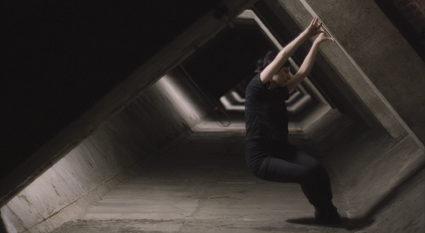
Gabriella Mangano & Silvana Mangano, Hidden Spaces, Ready Stages (production still), 2013
courtesy of the artists and Anna Schwartz Gallery
Gabriella Mangano & Silvana Mangano, Hidden Spaces, Ready Stages (production still), 2013
While the freshly remodelled Hamer Hall glows, mirrors and glints at the darkening streets outside, the old BlackBox space on its Southbank concourse, re-christened the Riverhouse, remains unrenovated. It’s an apt location for a twilight reflection on the raw guts of Melbourne’s Arts Centre, titled Hidden Spaces, Ready Stages.
The multi-screen installation, with sound by James Brown, results from a two-month exploration of the Arts Centre’s labyrinthine underbelly; an environment of machine rooms, tunnels, vents and wells. On entering the gutted exhibition space, the riverside stroll and chatter recedes, replaced by sounds both harshly industrial and uncannily evocative of nature—metallic purrings, cicadas humming amid clangs and grinds. They palpate the air between four large video components around the walls that operate almost as a trompe l’oeil, bringing what lies beneath to the surface.
The largest of the video works, near monochrome, is projected onto a stained concrete wall between two enormous, half-jackhammered pillars. A slow pan reveals curved aluminium vents and supporting frames, pipes and sprayed-on markings, shadowy mesh in the darkness behind. The sound rumbles, groans, hisses and taps. The camera starts to turn in curves too, the ‘pan’ seeming to track in three dimensions—it would be dizzying if not so deliberately sedate. The grain of the concrete projection surface mimics that of film—but the effect is painterly, not cinematic. A woman appears amid this study of shifting, 2D geometry. She moves a spotlight over herself to reveal not her own body so much as the depth and chiaroscuro of the surrounding space, as a long, slow swish blankets the room.
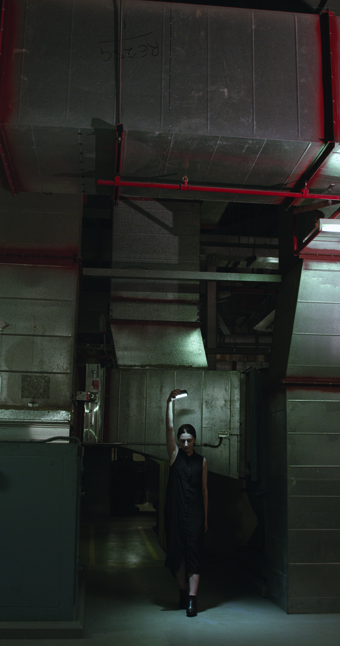
Gabriella Mangano & Silvana Mangano, Hidden Spaces, Ready Stages (production still), 2013
courtesy of the artists and Anna Schwartz Gallery
Gabriella Mangano & Silvana Mangano, Hidden Spaces, Ready Stages (production still), 2013
Another intervention takes place on the screen opposite: within a long, triangular tunnel lit sporadically by what could be cracks of daylight, a figure interacts with the inert cement walls and struts, responding to the repeating polygonal shapes around her. She adds to the geometry, rather than revealing it. There’s a discomfort to her postures—it’s as though she’s trying to ‘be’ the space and I’m reminded of Zoe Scoglio’s Rock Bodies video, in which ‘person-becomes-rock’ through a cross-fading superposition of images. The awkwardness of trying to meet the inanimate draws attention to both ‘fleshy human’ and ‘impenetrable (though now-penetrated) edifice.’
An unwieldy piece of black board in the third video both connects its exploring protagonist to the hard shapes of her surroundings and reveals the space she’s in as not-so-inert. Against a red brick wall beneath a circular cutout vent, she holds the cumbersome board horizontal, sharing its weight with a fluctuating updraught that shirrs and tugs at her clothing. The sound is uterine, evocative of the exterior, but muffled: a field of unidentifiable blurs and echoes. The appearance of colour here is a further echo of the front-window projection outside, which is not painterly but ripe and real, a split-screen study populated with lime green columns and hydraulics, splashes of orange and yellow light. In this video, again, there’s something pedestrian and awkward about a movement that tries to place itself within the hidden, mechanistic underworld, as trapped as the fluoros in their wire cages. Hands move back and forth in slowed-down clapping motion, repelled like magnets before they can meet; opening and closing or marching up and down, vaguely robotic. On the other half of the screen the camera travels, anonymous, across what’s now a landscape of terse, utilitarian forms; cables snaked and bound in hanks. This video is visible from the boardwalk, beside a noisy restaurant blaring bad pop music. I prefer to experience it from within though, reversed in slight soft-focus, in the dark; where it feels like a natural progression from the monochrome restraint and stillness of the other videos.
The guts of the theatre are traditionally hidden and the stage traditionally silent in the absence of ‘performance.’ But Hidden Spaces, Ready Stages inserts the human into the void, the artists spelunking into spaces designed never-to-be-seen-or-heard. James Brown’s pulsing, luffing, almost sexual sounds inhabit these ‘stages’ as evocatively as any operatic diva or head-slamming rock muso, seemingly sucked down through the vents from foyer to pit to boiler-room. And the curious, almost-guileless exploration and posture of the human presence in the work de-tunes the relentless chug of these spaces too, while still according them their stark predominance. These almost spectral figures create visual refrains that are subtle, intersubjective. Both straightforward and vulnerable, their presence lingers as you leave the space; living reminder of and relief from the utilitarian depths, as you step back out into the night.
Hidden Spaces, Ready Stages, Gabriella Mangano and Silvana Mangano, cinematography Tim Metherall, directors Gabriella Mangano and Silvana Mangano, sound James Brown, Arts Centre Melbourne, Riverhouse, 27 July-4 August
RealTime issue #116 Aug-Sept 2013 pg. web
© Urszula Dawkins; for permission to reproduce apply to realtime@realtimearts.net
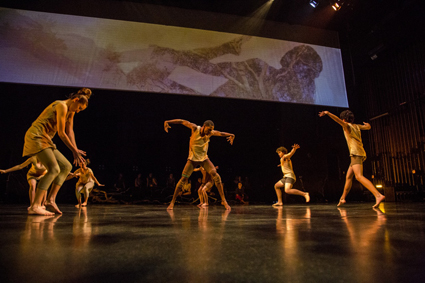
Quantum Leap ensemble, Hit the floor together, QL2 Dance
photo Lorna Sim
Quantum Leap ensemble, Hit the floor together, QL2 Dance
“I barely danced before this. It was extremely hard work. You better enjoy it.” Richard Allan, dancer, Hit the Floor Together
The value of youth dance development is bifold. Young performers reach into what they can’t yet imagine; emerging choreographers get to stretch their limbs. And sometimes one gets to see both choreographer and performers spread some surprisingly eloquent wings.
Hit the Floor Together is a project initiated by Daniel Riley McKinley (a choreographer with Bangarra Dance Theatre), incorporating young QL2 and regional dancers with older NAISDA (National Aboriginal Islander Skills Development Association) Dance College trainees. . It begins with Bearcage Productions’ short film revealing a grid of dancers in a long scrubby horizon, establishing some of this show’s major themes. How do Australians of different backgrounds understand identity? What are the cultural differences? The film establishes an interplay of surfaces and excavations. Adam Ventoura’s soundscape scrabbles glissandi (contemporary doubt) and muted thunderclaps (a threatening future) against a pulsing ostinato (our collective mythic histories).
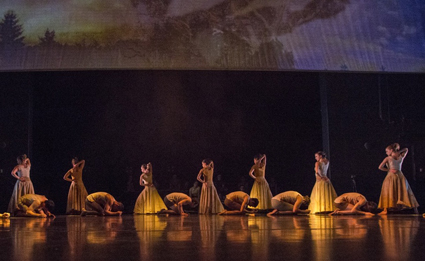
Quantum Leap ensemble, Hit the floor together, QL2 Dance
photo Lorna Sim
Quantum Leap ensemble, Hit the floor together, QL2 Dance
The projection fades, dusk to the opening’s daytime to begin McKinley’s Where We Gather. The stage is backlit to reveal dancers possibly less human than spinifex. As they blow to the wings, others appear, still, like cassowaries on a mound. Or are they already soil and ground?
The scrim remains a projection screen but is scrolled up to a narrow strip along the gantry, becoming one layer of visual geology in the landscape of the stage. A pan shot projection of arid land is intercepted by shadows of birds’ wings. Below this film, dancers become trios and sextets—dispersing, hovering, sliding, scrambling. A Shakespearean question is posed, regarding the value and meaning of existence [shadows which strut and fret…what meaning more?]. Dancers become mere seeds blown across the stage.
This is a curtain-less arena: even during focused duets, the entire company is always visible, watching from the wings. In a tradition greatly valued in Indigenous practice, no one can speak or stand for anyone else. Within the characteristic resistance to the solo (McKinley echoing Bangarra’s consistent practice) is a sophisticated concept of interdependent mutuality.
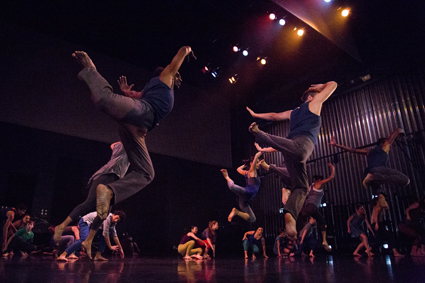
Quantum Leap ensemble, Hit the floor together, QL2 Dance
photo Lorna Sim
Quantum Leap ensemble, Hit the floor together, QL2 Dance
A sextet of white dancers is succeeded by an Indigenous mob, almost identical in their low-slung dance. But they look out further, their eyes are softer, their skins ripple distance. This is an Indigenous connection to horizon, a subtly different way of being. Strong bodies drag lighter ones, like water-reeds, across the stage. Men lift then dip their women—a romantic catch?—but the women walk away. The men then spin in strange testosterone dreams. We are left with a sense of aloneness—but who or what has done the abandoning? It is perhaps an understated reflection on lost connection to land.
Bloom begins in bright, contemporary colours, the company in T-shirts and stretch jeans. Dean Cross’ choreography is staccato and jagged. A young boy prowls; the larger group forms circles, lines, plays Chinese whispers. Clustered hands open out like petals of a waratah.
Standing frontstage, Ses Bero speaks in his native tongue until his story (about lineage and totems) morphs into English. We realise Oonagh Slater has not been translating his story after all. Ses’s pride in his heritage and Oonagh’s own story about ‘worry dolls’ both lose their respective integrities. In the evening’s overall context—so delicately respectful of cultural values and differences—this is simply poor dramaturgy. The projection for this segment has gone from sound wave to the birth of a galaxy to an endless kaleidoscope. It is hip but does not progress very far (and perhaps is not meant to). Reuben Ingall’s sound track is a hip-hop based score with live guitar feed. Repeated single keyboard notes couple electronic bolts and slides; a car-tyre pressure gauge eventually becomes an ambiguous noise suggesting an EEC machine. The soundscape is not always well matched but best contributes in the weighty, dragged, slumping choreography of Cross’s powerful ‘judging and being judged’ final scene.
Deon Hastie’s Storm begins with clouds whirling across the scrim, and angel voices (are they?) singing. The company walks backwards, forwards in repeating grids. A voice-over of storm warnings creates a build-up of static electricity. Then sparks fly: testosterone tensions flare as male dancers challenge one another in virile leaps and throws. Hastie eventually creates a curious resolution to this outbreak of violence in small group unisons with breakouts of idiosyncratic gesturing. I note the gawky angularity of work by Ryan Stone. Hastie brings in some culturally specific movement from the NAISDA dancers, both men and women, the dance becoming an interplay of similarities and differences. At times, the absorption of form from one culture (and gender) by another is quite stunningly realised, echoing Riley’s black-white pairings. Hastie has a gift for letting this happen in transformative ways.
In McKinley’s words, “feeling connected to a landscape shouldn’t be limited to First Nations, as long as you pay the proper respect to what and who was there before you.” Here’s to an ecumenical future.
Canberra 100, QL2’s Quantum Leap, Hit the Ground Together, video by Bearcage Productions, choreography Ruth Osborne, Jacqui Cornforth, Adelina Larsson and dancers; Where We Gather, choreography Daniel Riley McKinley; Bloom, choreography Dean Cross; Storm, choreography Deon Hastie; Together, choreography Ruth Osborne, Adelina Larsson and dancers; Playhouse Theatre, Canberra, 31 July-3August
This article was originally published online in RT’s August 28, 2013 e-dition.
RealTime issue #117 Oct-Nov 2013 pg. web
© Zsuzsanna Soboslay; for permission to reproduce apply to realtime@realtimearts.net
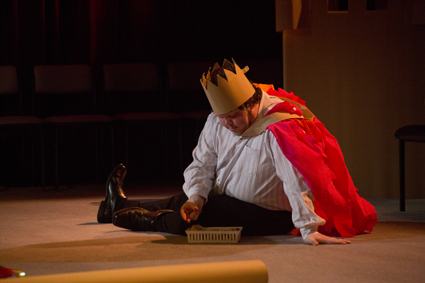
Jeremy Broom, Catalogue of Dreams, Urban Theatre Projects
photo Fred Harden
Jeremy Broom, Catalogue of Dreams, Urban Theatre Projects
There is a central visual focus to Urban Theatre Projects’ Catalogue of Dreams: a small boy on a circular carpet, within a larger square. A fostered boy. He plays with a toy, his eyes remaining lowered. A man sits beside him on the floor, cross-legged, inviting him to eat at the table, if and when he wants to. The voice is delicate, even tentative; not pushing.
The contrast between man and boy is striking: the man, large, articulate, soft; the boy, mute but not unmoving. He stays within his own rhythm, his game, his routine, where he is sure.
We see three other adults, aloof at a dinner table. No enticing smells waft towards us: we are sharing the square chamber with something bland. But the playing space is also an arena or boxing ring, without a visible referee. Anything imperious in this scene is invisible, or leaches out through sound—the scrape of cutlery, cutting, slicing, measuring all the unspeakables, the gaps in experience and understanding between the order and routine of ‘normal’ lives and the disorder that must have thrown the boy into this, his foster child circumstance. What is striking is how much delicacy is manifest in this scene, and yet, one doubts to what extent touch, contact, redemption, is actually achieved.
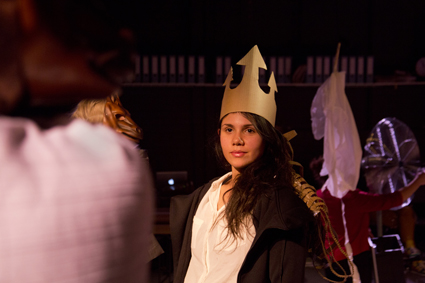
Casey Keed, Catalogue of Dreams, Urban Theatre Projects
photo Fred Harden
Casey Keed, Catalogue of Dreams, Urban Theatre Projects
This is a work—whether about or beyond the subject of fostering children—created in a city “perceived as the centre of decision-making.” The set largely comprises office desks and chairs. We, as audience, line the walls in plastic chairs (oh how like a Centrelink waiting-room!) and above our heads, shelves are lined with lever arch files which occasionally are shuffled around. There is a nice interplay between the number of files (hard to count how many) and not actually descending into a Kafkaesque hell where one completely loses count. One could count, if one wanted to. There is still hope here.
The strongest parts of this work are not in direct verbal exchange: they are in the soft voices, attempts at kindness, options offered, spaciousness, don’t push too hard; and where the adult actor Jeremy Broom—perhaps the boy when he grows up, pretending a coherent ascendancy—dons a messy, orange-gold cloak and cardboard crown and sings Coldplay’s “Viva la Vida” as if his companions, as if the world, cannot contain him. His voice charges the room; the other performers give space for his illusion to unfold, spend its time, and be done.
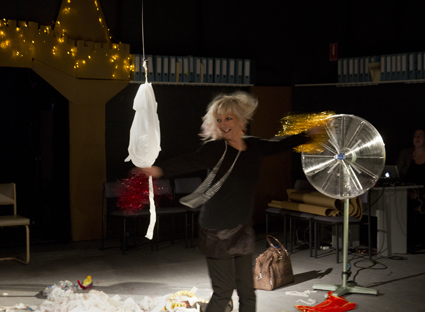
Moya Simpson, Catalogue of Dreams, Urban Theatre Projects
photo Fred Harden
Moya Simpson, Catalogue of Dreams, Urban Theatre Projects
Indeed, in this production, the voice and the voice-over give the work its finest power. Broadcast excerpts of interviews and oral histories carry tremendous force, and the piece ends with a nice return: the voiceover of a young boy, 11 going on 50, who describes his only real concern as whether or not his incapable mother (a parent surely failing psychologist Donald Winnicott’s critical category of ‘good enough’) is safe and well. Curiously, the boy (if indeed it is the same boy, or an archetypal foster-child) has not appeared on stage for the last 20 minutes; he could be the hero of a radio-play.
The meaning of the animal masks—so significant a part of the marketing for this production—seems unclear as to its benevolence or malevolence, whether intended to hide, reveal, or represent the irrational taking hold. But aside from this underdeveloped point, the production is finely judged, not overbearing, not overdone, but delicate, nuanced and strange.
Catalogue of Dreams is a collaboration between seasoned theatre practitioners, newcomers, Indigenous and non-indigenous people and some on the ‘inside’ of the welfare system. It reaches no conclusions—about the inadequacies of the welfare system, of people, of parents, or of life itself—but opens a window wide enough for us to feel the breeze of lives surviving disarray, and wonder at what can be done.
Canberra100: Urban Theatre Projects, Catalogue of Dreams, co-directors: Rosie Dennis, Alicia Talbot, performers: Jeremy Broom, Mercedes Ellis, Casey Keed, Kasey Mitchell, Isiah Ritchie, Benjamin Slabb, Moya Simpson, contributors Myall Weazel, Amber Spooner, design Imogen Keen, lighting Daniel McCusker; Commissioned by the Centenary of Canberra; Canberra Theatre Centre, 13-27 July
This article first appeared as part of RT’s online e-dition August 28, 2013
RealTime issue #117 Oct-Nov 2013 pg. 31
© Zsuzsanna Soboslay; for permission to reproduce apply to realtime@realtimearts.net
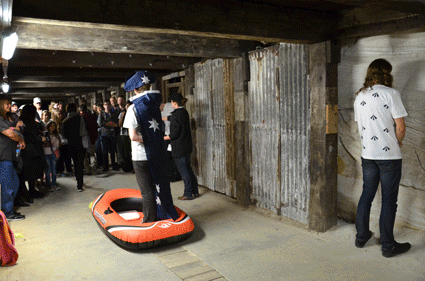
Stations of the Southern Cross, Applespiel, Underbelly 2013
photo Rafaela Pandolfini
Stations of the Southern Cross, Applespiel, Underbelly 2013
Stations of the Southern Cross, in the 2013 Underbelly Festival, was the latest from self-described “small but likeable theatre group” Applespiel. Taking audiences on a faux-tourist walk through Cockatoo Island’s Dog Leg Tunnel with various stops and stagings along the way, they told their own sham history of Cockatoo Island, which gradually imploded in on itself as its contradictions mounted.
Stations of the Southern Cross’ hysterical conclusion saw the arrest of Applespiel’s members by History Police for crimes against truth, the idea being that the mainstream story of Australian history is itself a giant fallacy with less to do with reality than continuing colonial mythology.
Despite, or rather because of, a dedicated lo-tech anti-aesthetic, the show was punctuated by a series of seemingly disparate but extremely beautiful images that remain sharply inscribed in my memory: the choppy waters of Sydney Harbour rendered as ruffled blue cellophane in a home-movie-style shadow projection; Ned Kelly singing Cold Chisel at a pub karaoke, under a disco ball looming from the tunnel’s recesses, his infamous helmet re-fashioned from VB tins; and tiny white origami ships, floating in pink- and blue-lit silvery steel buckets, symbolising the first fleets of boat people that came through the heads over 200 years ago.
Braided narratives that tie plot-knots around themselves are now standard in theatre and cinema. The worst of these self-referential projects invariably emit an annoyingly smug, post-postmodern vibe of all-knowingness. Applespiel do indeed turn their narratives inside out, but their childlike humour, sincerity and perceptiveness endear rather than alienate them from their audiences, whom they clearly regard with the utmost intelligence. Applespiel seem to really know what they’re doing. This latest smart, self-assured, formally inventive work cements the troupe as true cultural innovators, although I assume, a little sadly, that the site-specific nature of the project will most likely preclude its presentation elsewhere.
The real genius of Stations of the Southern Cross was the way it worked with and not against its setting in the chilly Dog Leg Tunnel. The site of Cockatoo Island was key to the experience of Underbelly Arts—traipsing around this place gives audiences the sense that their city is expanding internally and into the harbour rather than away from the CBD. But many artists are still most accustomed to working in black boxes or white cubes, and the projects that tried to simulate the self-contained conditions of a traditional gallery or theatre were the least successful. Art events on Cockatoo Island must almost program against the location by curating works that can hold up against the imposing industrial ruins.
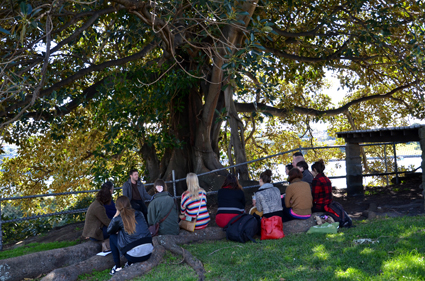
Filibust, Nick Keys, Underbelly 2013
photo Rafaela Pandolfini
Filibust, Nick Keys, Underbelly 2013
Nick Keys was an artist who communed successfully with the site during his work Filibust, under a Moreton Bay fig in the Convict Precinct. His was a work of halves. The first was a sprawling hour-long group discussion akin to a very egalitarian university tutorial. Keys analysed the filibuster, an American congressional procedure that allows politicians to delay and obstruct bills they oppose by speaking at length, using the language of durational performance art—a flat-out great idea that successfully overlayed politics and art. A teacher and writer, Keys conversationally showed how an epic and absurd tradition could be both a sign of a broken political system and an elegant performance piece. As he said, “it’s not hard to see why artists are attracted to a gesture of great symbolic potency with marginal real effect.”
The second half of Keys’ performance was a 75-minute filibuster-style talk on the art of rhetoric, using clips from the unlikely foursome of Martin Luther King, Malcolm X, Kanye West and Jay-Z. Weirdly, it worked as a kind of “intergenerational double date” on the inheritance of the civil rights debate, and not just because it excavated the almost infinite connections between the language of these four, but because Keys was one of the few artists who questioned the politics of using Cockatoo Island as a rehabilitated destination for cultural tourists.
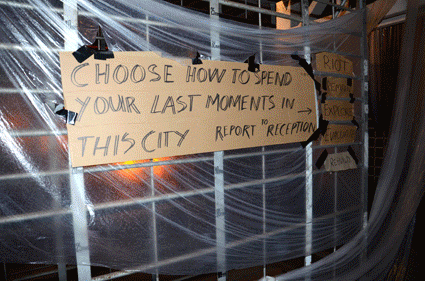
I Met You In A City That Isn’t On The Map, we do not unhappen, Underbelly 2013
photo Rafaela Pandolfini
I Met You In A City That Isn’t On The Map, we do not unhappen, Underbelly 2013
Otherwise, the mandate of the festival was fun. For the wonderfully titled I Met You in a City That Isn’t on the Map, by We Do Not Unhappen, this sense of fun came at no conceptual expense. A simple premise–what would you do if today was our last?—melded participatory art with the imagery of disaster films to produce a project that anyone could engage with, regardless of age or art expertise. Audiences were unleashed into a cardboard shantytown and given four choices: riot, remain, repair or explore. Explorers were given sheets of blank yellow stickers on which to scrawl their own messages (“Happiness is almost here,’ “S.O.S.”) and dot them around the city. I slapped one of mine onto a decrepit skyscraper, only to see it overthrown a minute later by a gleeful ‘rioter’ and then crazily restacked by a small child. The whole sprawling mess coalesced with a sweeping soundscape by local composer James Brown. Quite simply, it worked, making a functional collective out of an audience of strangers. If this is the art of today, I’m on board, and so it seems is a hefty slice of Sydney’s art-going populace.
Underbelly Arts Festival 2013, Cockatoo Island Sydney, Aug 3-4
RealTime issue #116 Aug-Sept 2013 pg. web
© Lauren Carroll Harris; for permission to reproduce apply to realtime@realtimearts.net
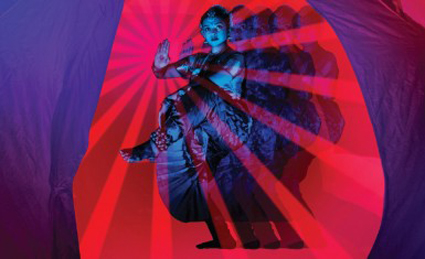
Private Dances, Nat Cursio Co.
photo Jorge de Araujo
Private Dances, Nat Cursio Co.
Private Dances, Northcote Town Hall
Nat Cursio is on a roll—Blizzard just premiered at Melbourne’s newest art centre, the Substation (see preview—review will appear next week) and now she is reprising Private Dances, a work created for Next Wave 2010 (see RT98 online). The Northcote Town Hall will become a tent city with dances performed to intimate audiences. Some tents will also screen dance-based films and there’s even rumour of action in the back seat of a car.
Darebin Speakeasy presents Nat Cursio Co. and Insite Arts’ Private Dances, 28-31 Aug, Northcote Town Hall; http://darebinarts.com.au/speakeasy/
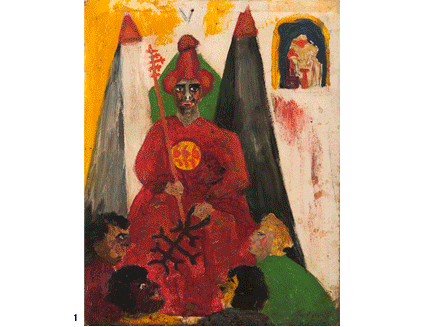
1. Aleister Crowley, The Hierophant (study for Tarot), 1921; 2. James Gleeson, A Moment in the Process, (detail), 2006; 3. Rosaleen Norton, Lucifer and the Goat of Mendes; 4. Danie Mellor, A Trace of History (of Death and Resurrection), 2010
Windows to the Sacred, S.H. Ervin Gallery
Coming up at S.H. Ervin Gallery is a fascinating survey of the “esoteric” in art—a field of practice defined by curator Robert Buratti as “man’s search for hidden knowledge of himself and his place in the universe” (press release). Windows to the Sacred places the work of renowned occultist Aleister Crowley alongside significant Australian artists such as “the father of Surrealism in Australia” James Gleeson, “the Witch of Kings Cross” Rosalee Norton and award-winning Indigenous artist Danie Mellor. It also incorporates moving image and music, exhibiting works by Kenneth Anger, Harry Smith, Alex Proyas, Jeff Martin (lead singer of Canadian band The Tea Party) and audiovisual group Masonik. A Gnostic temple will also be constructed by Collective 777, an art guild of the Ordo Templi Orientis Australia, in which a mass will be conducted on Sept 17.
Windows to the Sacred, S.H. Ervin Gallery, presented in association with Buratti Fine Art; 30 Aug-29 Sept; http://www.shervingallery.com.au/
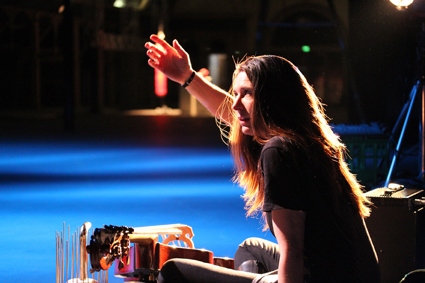
Anita Hustas, Festival of Slow Music
courtesy the artist
Anita Hustas, Festival of Slow Music
Festival of Slow Music
Taking inspiration from the slow food movement, musician and curator Adam Simmonds has started the Festival of Slow Music. He says, “It is not the music that will be slow, but the listening—the audience will be encouraged to slow down and enjoy the experience” (website). In a range of venues around Ballarat you can experience strictly acoustic music by artists such as new music duo Vanessa Tomlinson & Erik Griswold (Clocked Out); bassist/waterphonist Anita Hustas (best get along to see what that entails); renowned movement improviser Al Wunder exploring his own style of “hum-drumming;” and ukulele queen Rose Turtle Ertler. The event kicks off with a mass choral ‘OM,’ open to public participation, lead by Sweet Mona’s Choir.
Festival of Slow Music, Art Gallery of Ballarat & various venues, Ballarat, 30 Aug-1 Sept; http://www.festivalofslowmusic.com/
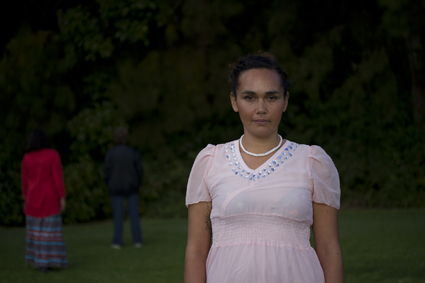
This Fella, My Memory, Moogahlin Performing Arts & Carriageworks
photo Gabriella Lo Presti
This Fella, My Memory, Moogahlin Performing Arts & Carriageworks
This Fella, My Memory, Carriageworks
Produced and devised by Moogahlin Performing Arts and Linden Wilkinson, This Fella, My Memory looks at the stories of three older women and their relationships with friends, family and country. Directed by Frederick Copperwaite and created in consultation with Aboriginal Elders Aunty Christine Blakeney and Uncle Max (Dulumunmun) Harrison, the work is “a road trip across Aboriginal NSW where the boundaries, kinships and songlines are invisible to the eye, but felt deep within” (website). After the vibrant history of the Black Theatre in the 1970s, this marks the first play to be devised and written from a company in Redfern in 40 years. The work has been created using a combination of western playmaking techniques and traditional cultural practices and Copperwaite feels that they’ve managed to “collectively imagine and share ownership of a story about the community in which we all live and work” (press release).
Moogahlin Performing Arts, This Fella, My Memory, Carriageworks, 4-7 Sept; http://www.carriageworks.com.au/
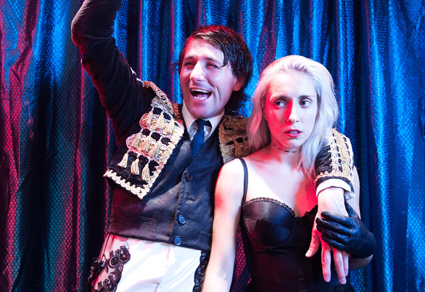
Salomé, Little Ones Theatre
photo Sarah Walker
Salomé, Little Ones Theatre
Salomé & City of Shadows, Helium, Malthouse
Malthouse’s Helium season of shows by independent artists and companies is drawing to a close with two quite contrasting pieces. Salomé, directed by Stephen Nicolas (see review of his sex.violence.blood.gore) takes the Oscar Wilde classic and gives it an 80s gender-bending makeover complete with New Wave soundtrack. Then Perth composer and chanteuse Rachael Dease goes noir with City of Shadows, a song cycle of murder, misfortune and forensics based on the highly evocative collection of crime scene photos housed at the Sydney Justice & Police Museum (material initially explored in a series of impressive multimedia works by Ross Gibson and Kate Richards).
Malthouse’s Helium: Little Ones Theatre, Salomé, 30 Aug-14 Sept; Smack! Bang, City of Shadows, Rachael Dease, 21 Sept-5 Oct; http://www.malthousetheatre.com.au/helium-2013/
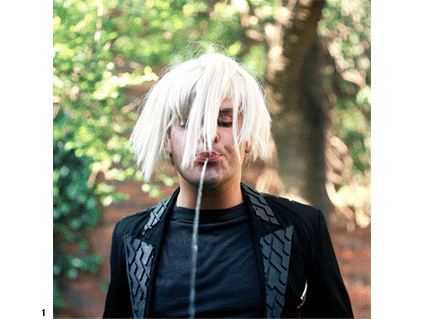
1. Christian Thompson, Andy; 2. Max Pam, Reporting Madagascar (excerpt); 3. Tom Nicholson, Indefinite distribution (After Dili action); 4. PUNKASILA, La Misión a Cuba del Rock Combativo. (See entry for full caption info)
In Confidence: Reorientations in Recent Art, PICA
Curated by John Mateer, In Confidence: Reorientations in Recent Art is an exhibition of artists described as “transnational,” exploring a “genuine, grass-roots style globalism” (website). Mateer sees this balancing act of the international and local as particularly “meaningful to the West Coast of Australia.” Artists from Australia and Southeast Asia include Simryn Gill, Tom Nicholson, Max Pam, Christian Thompson, Hossein Valamanesh and Indonesian punk band Punkasila.
(Caption: 1. Christian Thompson, Andy, from the series The Gates of Tambo, 2004. Courtesy the artist and Gabrielle Pizzi Gallery, Melbourne; 2. Max Pam, Reporting Madagascar (excerpt), 2003. Image courtesy the artist; 3. Tom Nicholson, Indefinite distribution (After Dili action), 1999-2010 (detail). Image courtesy the artist and Milani Gallery, Brisbane; 4. PUNKASILA, La Misión a Cuba del Rock Combativo, 2009. 10th Havana Biennial, Cuba. Courtesy of the artists and Darren Knight Gallery, Sydney.)
In Confidence: Reorientations in Recent Art, PICA, 31 Aug-13 Oct, http://www.pica.org.au
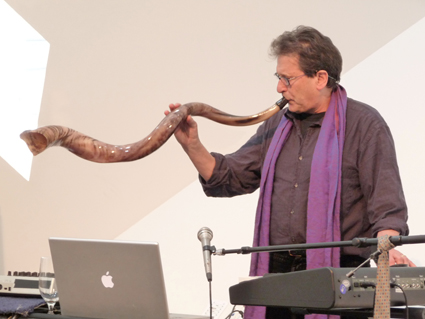
Alvin Curran, Shofar III concert with William Winant, Contemporary Jewish Museum, San Francisco, 2009
photo Susan Levenstein
Alvin Curran, Shofar III concert with William Winant, Contemporary Jewish Museum, San Francisco, 2009
Alvin Curran, Melbourne, Sydney
It may have already started by the time this reaches your inbox but it goes for six hours so you might catch some of it—Soundstream’s Gabriella Smart will be performing Alvin Curran’s Inner Cities at the Religious Centre, Monash University. Curran has been touring Australia, a guest of Tura’s Totally Huge New Music Festival (see feature) and Soundstream, Adelaide (just announced as winner of the Award for Excellence by an Organisation in the 2013 Art Music Awards). In Sydney Curran himself will perform at SIMA’s Sound Lounge with Jon Rose, Cor Fuhler and Robbie Avenaim, plus there will be a semi-secret rendering of Inner Cities at a private residence.
Alvin Curran, Inner Cities, Monash University, Melbourne, 18 Aug, http://www.monash.edu/news/events/show/inner-cities; SIMA, Curran, Rose, Fuhler, Avenaim, Sound Lounge, Seymour Centre, Sydney, 31 Aug, http://sima.org.au/August31AlvinCurranjonRose/879/n/3/0/0/; Inner Cities, private residence, Sydney, 1 Sept, email for details
RealTime issue #116 Aug-Sept 2013 pg. web
© RealTime ; for permission to reproduce apply to realtime@realtimearts.net
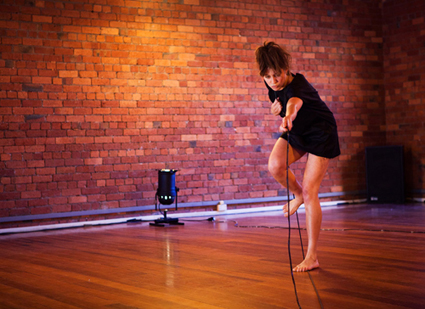
Natalie Abbot, Lucy Guerin Studio Residencies & Workshops
Workshops & Residencies, Lucy Guerin Inc
Applications are open for the 2014 studio residency program at Lucy Guerin Inc. These residencies provide studio/rehearsal space free of charge for the development of new work. Places are also available in their next Hotbed professional development workshop titled Defining Practice, presented by US/Belgian-based choreographer Eleanor Bauer (Nov 25).
Applications for studio residencies & workshop places due 23 Sept; http://www.lucyguerininc.com/studio-projects/Studio_Residency; http://www.lucyguerininc.com/studio-projects/Hotbed
Indigenous Production Scholarship, Metro Screen
Scholarships are now available for 15 Indigenous people looking to work across film producing and production management. The course starting September 13 results in a Certificate IV in Screen & Media (Partial Qualification). Metro Screen also offers free access for Indigenous filmmakers to a number of their other short courses.
Applications for Production Scholarship 2 Sept; http://metroscreen.org.au/funding/indigenous-support/
Critical Path Responsive Residencies
For 2014 Critical Path is dividing its Responsive Residencies for NSW-based choreographers into Tasters/Testers, for processes trying out new ideas (up to $10,000); and Investigate/Extend for longer-term research projects (up to $20,000). They also offer research room residencies to NSW, national and international artists (non-financial) providing artists with office and research space, including access to video editing equipment, for up to three months.
Deadline for Responsive Residencies 9 Sept; Research Room residencies no deadline, subject to availability; http://www.criticalpath.org.au/documents/2014_ResponsiveProgram_GuidelinesforApplying.pdf
Bivouac 2013
Bivouac is a video exhibition with an emphasis on multichannel pieces that are not so much site-specific as site responsive. Ten works will be chosen to be exhibited at a yet to be disclosed public site in Melbourne in October/November. Preferred format is three-channel works two to nine minutes long.
Deadline 2 Sept; http://blog.cofa.unsw.edu.au/wp-content/uploads/2013/08/Attachment-Bivouac-2013-CALL-OUT.pdf
Next Generation Placement, ASSITEJ
The International Association of Theatre for Children & Young People (ASSITEJ) is calling for organisations to register for their Next Generation Placement program. This offers young artists opportunities to experience temporary secondments in a range of companies across the world. Artists under 35 may apply for placements via the ASSITEJ site with successful applicants eligible to apply for financial assistance.
Deadline for placement offers 30 Aug; deadline for applicants 30 Sept; http://www.assitej-international.org/next-generation/
Forever Now
The Forever Now team of Willoh S Weiland, Brian Ritchie, Jeff Khan, Thea Baumann and Susan Cohn are calling for content to include on the three gold discs that they intend to send into space. In one minute of sound or video you are invited to contemplate infinity and an audience a billion light years away.
Applications open until June 2015; http://forevernow.me/
Blue Mountains Film Festival
Last week to submit entries to the Blue Mountains Film Festival for a chance to win a Yowie and the $5000 grand prize. Categories for short film entries are Animation, Drama, Documentary, Comedy, Open, Music Video and Family. Feature films will also be considered. The film festival is Oct 3-7 at Scenic World.
Entries due 2 Sept; http://www.bluemountainsfilmfestival.com/enter.htm
Selected Australia Council Grants
for full list see http://www.australiacouncil.gov.au/grants
Aboriginal and Torres Strait Islander Curator Exchange Program – 2 September 2013
http://www.australiacouncil.gov.au/grants/2013/Aboriginal-and-Torres-Strait-Islander-Curator-Exchange-program
Community Partnerships: Projects – 6 September 2013
http://www.australiacouncil.gov.au/grants/2013/community-partnerships-projects-6-september
Community Partnerships: Cité Residency – 6 September 2013
http://www.australiacouncil.gov.au/grants/2013/community-partnerships-cite-residency
Community Partnerships: Career Pathways – Structured Mentorships – 6 September 2013
http://www.australiacouncil.gov.au/grants/2013/career-pathways-structured-mentorships-community-partnerships-6-september
Community Partnerships: Projects with Public Outcomes – 6 September 2013
http://www.australiacouncil.gov.au/grants/2013/community-partnerships-projects-with-public-outcomes-6-september
Festivals Australia – 6 September 2013
http://www.australiacouncil.gov.au/grants/2013/festivals-australia-6-september
JUMP Mentoring – 9 September 2013
http://www.australiacouncil.gov.au/grants/2013/jump
RealTime issue #116 Aug-Sept 2013 pg. web
© RealTime ; for permission to reproduce apply to realtime@realtimearts.net
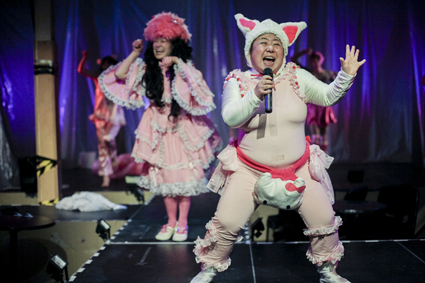
DasSHOKU SHAKE!
photo Vikk Shayen
DasSHOKU SHAKE!
If you want to be seized and dropped into a bizarre and cacophonous world of extreme entertainment then see DasShoku SHAKE!—a Japanese Australian butoh cabaret extravaganza. Inspired by the 2011 earthquake and tsunami in Japan this production is an exploration of the shaking of the physical world, the psychological self and culture.
In a series of butoh/cabaret acts linked by Yumi Umiumare’s character searching for “the Light” in a world that is unravelling, the audience is exposed to a heightened and exuberant subverting of cultural stereotypes—the Japanese businessman frantically bowing and pressing his business card on members of the audience before losing his intestines, the mother dressed in outrageous pink, vomiting at the smell of her child and inhaling air freshener, the very ‘nice’ and too clean American girl/boy pair, fast-food culture, office workers, game show hosts, dancing poo, a fairy-tale that appears drug-fuelled, a parody of sex and desire with a woman in a costume of numerous huge breasts that dancers crawl after and suck on, modern Geisha in grand punk/Geisha costume, orgasms and balloons. It’s all here, in your face and as gripping as it is deliberately excessive and carefully crafted.
DasShoku SHAKE! immerses us in an extreme state in which people have experienced the unimaginable. The butoh-trained performers are compelling. When they shake from their core they seem almost inhuman.
There are moments of quiet within this maelstrom that touch on the simplicity of life. The electronic blips, drum beats and static stop. Umiumare alone on stage, spotlit, asks the audience if we’re following so far. She searches for clarity in the program, asks us how we’re going and then advises us to “breathe deep and return to who you are.”
In among the wild excess of the cabaret-punk costumes and a driving soundtrack that goes from cheesy tunes to grand classical to unsettling electronica, there are bone-chilling moments as unseen performers move inside huge silver tubes to embody nuclear seepage from a wrecked reactor.
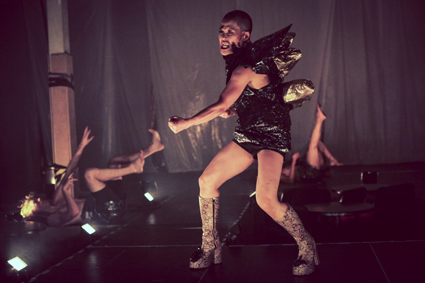
DasSHOKU SHAKE!
photo Vikk Shayen
DasSHOKU SHAKE!
In a show awash with invention the makers of DasShoku SHAKE! satisfyingly use the common device of repeating an opening image to bring the work full circle. In the first scene the ‘ordinary girl’ (Umiumare) holds a round mirror that obscures her face as she journeys through the madness around her looking for the Light. At the end of the performance she returns changed by the journey, wigless, head shaven and emotionally naked with the mirror held up but now cracked.
After all the mayhem and delight the piece has arrived at a brilliantly performed butoh solo—Umiumare crying as she retreats, drawn backwards towards the light, which ultimately consumes her. It is emotionally gutting, but full of hope.
Yumi Umiumare says this piece is “a modern ritual for both calming and provoking the souls and paying homage to the departed…” She adds that “the Japanese indigenous Ainu people consider ‘shaking the spirit’ as simply ‘thinking’…” (program note).
I felt greedy for it and shaken out of the ordinariness of everyday life.
2013 Darwin Festival, Yumi Umiumare with Theatre Gumbo and DasShoku Triangle. DasSHOKU SHAKE!, concept Yumi Umiumare and Theatre Gumbo, direction Yumi Umiumare, Kayo Tamure in collaboration with the artists, set design Ellen Strasser, sound design Dan West, lighting design Tony Moore; George Brown Botanic Gardens, Darwin, Aug 20-22
The NT Writers’ Centre’s RealTime Workshop project is supported by the Australian Government Regional Arts Fund and the Northern Territory Government.
For reviews of the 2013 Darwin Festival by Mike Bodnar, Kaye Hall, Fiona Carter, Kyle Walmsley and Nicola Fearn go to www.realtimearts.net/features.
RealTime issue #117 Oct-Nov 2013 pg. web
© Nicola Fearn; for permission to reproduce apply to realtime@realtimearts.net
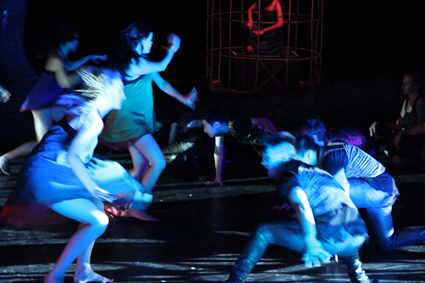
Zombies in the Banyan Tree, Tracks Dance Company
photo Jess Devereux
Zombies in the Banyan Tree, Tracks Dance Company
In August, RealTime Managing Editors Keith Gallasch and Virginia Baxter were in Darwin mentoring five writers—Fiona Carter, Nicola Fearn, Kaye Hall, Kyle Walmsley and, from Alice Springs, Mike Bodnar—to produce reviews of works in the final week of the 2013 Darwin Festival program. The NT Writers’ Centre’s RealTime Workshop project was supported by the Australian Government Regional Arts Fund and the Northern Territory Government. You can read 13 reviews at www.realtimearts.net/features [Eds].
A lone musician appears in the fading light of dusk, seats himself centre stage at a bamboo gamelan and begins to play. The audience is hushed, drawn into the rhythm of the gamelan and the surrounding sounds of the approaching night.
Integral to this production are the live beats and myriad sounds of traditional Balinese music, Kecak choir and Beat Boxer K-Fuzz. Placing live musicians directly into a dance or theatre work allows a relationship to build between performers and music. Rather than simply waiting for the next beat to fall, musicians and dancers have the opportunity to respond to each other, creating a tight link and potentially strengthening the power of the delivery.
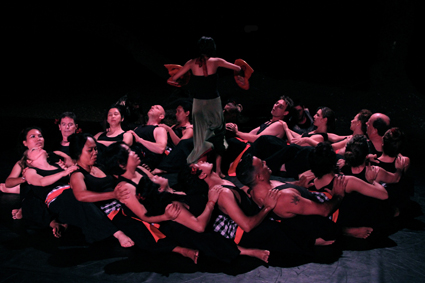
Zombies in the Banyan Tree, Tracks Dance Company
photo Jess Devereux
Zombies in the Banyan Tree, Tracks Dance Company
While at times this two-way relationship was evident, in particular between the lead Zombie and the Beat Boxer, much of the performance felt as though the dancers were performing to pre-recorded music, relying on the backing sounds to fall into place with their choreography. This seemed like an opportunity missed.
Tracks has built a reputation on inserting dance venues into Darwin’s everyday landscape, transforming these sites from the usual to the unusual and magical. Set against two rain trees in Darwin’s George Brown Botanical Gardens, the obvious question arose: “Where’s the Banyan?” Despite Artistic Director Tim Newth’s best laid plans, the banyan he had sited the work around was cut down and removed just weeks before opening night, highlighting just one of the many challenges to creating your own venue.
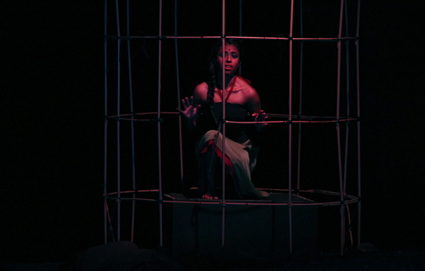
Zombies in the Banyan Tree, Tracks Dance Company
photo Jess Devereux
Zombies in the Banyan Tree, Tracks Dance Company
Odd jibes about Tracks’ botanical mislabelling aside, Newth’s design brought together nature, set and light to evoke images of a shadowy world in the thick limbs of trees where Zombies and Butterflies do battle over good and evil. Cold purple lighting for the snarling Zombies, a soft yellow for the delicate Butterflies, red to create a world in mayhem and nature’s own contribution of a rising full moon underpinned the mood and drew the elements of the setting together.
The concept of seemingly opposite forces and their interconnection in the natural world is a strong theme in Balinese culture and this theme was woven through the performance. From the black and white check of the Kecak performers’ costumes to the same pattern on the floor of the set, to contemporary and traditional cultural forms being presented side by side, the sense of yin and yang was constantly reinforced.
The Butterflies, all female, wore dramatically bright makeup, airy dresses and flapped intricately designed handheld wings. In contrast, the Zombies, predominantly male, wore muted colours of black and grey and lurked in the protection of the rain tree. This central theme of opposition was, however, at times compromised causing conflicting emotional responses.
We were set up to feel sympathy for the Butterflies as one of their community was dragged from the stage by the Zombies, her wings violently plucked. This damaged Butterfly spent most of the remainder of the performance caged. Yet as the Zombies and Butterflies clashed in battle, and the Zombies began to show dominance, audience members cheered the squelchingly gory deaths of the Butterflies. A mix of graphic sound effects and cheeky choreography had brought the audience to the side of the Zombies.
In such a dark piece, it was curious to see humour introduced at such a late stage. Once again I felt conflicted when Michael Jackson’s “Thriller” made a fleeting appearance and when some of the more grotesque moments were suddenly made light of with humorous sounds or gestures.
The Kecak choir is the centerpiece of Zombies in the Banyan Tree and is another artistic form drawn directly from traditional Balinese culture. Perhaps made most famous by its appearance in the 1992 film Baraka, the Kecak choir works its way to a state of frenzied trance through rhythmically mechanical chanting and unison movement. Led by Balinese dancer Desak Putu Warti and her brother I Dewa Putu Sudiantara, the choir was made up of local community members who had answered a general call-out to take part.
The Kecak choir represents two areas of particular interest shown by Tracks’ Artistic Directors—the involvement of the general community in their shows and the incorporation of elements drawn from a variety of cultures represented locally. While I understand the philosophy to explore and create work that speaks about the community in which we live, this performance left me wondering about the introduction of a complex cultural form to untrained performers in such a direct translation. I waited excitedly for the Kecak choir, and the work, to build to its predicted climax, only to find that it never arrived. For me this poses the question—in order to make the work their own, how does an artist overcome expectations like mine when using a well-known cultural form?
Moments of this performance will remain with me: Putu’s wailing lament drew a bleak yet beautiful image and the vocal flexibility of K-Fuzz sustained the performance. Zombies Under the Banyan Tree reminded me just how culturally rich this community I live in really is.
Tracks Dance Company, Zombies in the Banyan Tree, concept, direction David McMicken, Tim Newth, choreographers Desak Putu Warti, Jessica Devereux, Nick Power, musicians I Dewa Putu Sudiantara (Bali), Megan Atfield, Desak Putu Warti, Michael Koufos (K-Fuzz), George Brown Botanic Gardens, Darwin, Aug 9-20
The NT Writers’ Centre’s RealTime Workshop project is supported by the Australian Government Regional Arts Fund and the Northern Territory Government.
RealTime issue #117 Oct-Nov 2013 pg. web
© Fiona Carter; for permission to reproduce apply to realtime@realtimearts.net
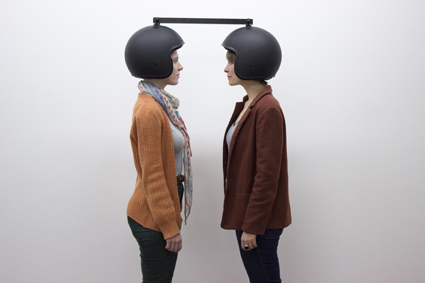
Caitlin Franzmann, Courtney Coombs, Focus, 2012, Fresh Cut exhibition
image courtesy the artists and IMA
Caitlin Franzmann, Courtney Coombs, Focus, 2012, Fresh Cut exhibition
Our 2013 Arts Education feature, Utopias & Horrors, reveals the Zombification of tertiary education but salves the pain with utopian antidotes in which intimacy, the studio, laboratory and the transdisciplinary figure strongly.
Parts 2 and 3 of our Women + Performance column feature an interview with Melbourne director Anne-Louise Sarks and thoughts on the nature of female humour prompted by a performance night at the Backflip exhibition at the VCA.
While right-wing commentators regard Paul Clarke’s Whitlam, The Power & the Passion as left-wing, Dan Edwards in his On the Dox column takes exception to a conservative documentary with a severely limited viewpoint, poorly chosen commentators and a pop cliché style.
Ian Haig sees Paul McCarthy’s vast “psycho-sexual retelling” of Walt Disney’s Snow White at New York’s Park Avenue Armory, while Vincent Leveridge welcomes a “return of broader political art about Indigenous Australia” in Ghost Citizens: Witnessing the Intervention.
RealTime issue #116 Aug-Sept 2013 pg. 3
© RealTime ; for permission to reproduce apply to realtime@realtimearts.net
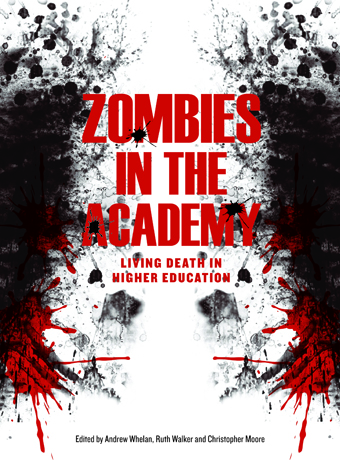 Academics in the humanities and the social sciences like to write about popular culture. They like to use ‘high’ theory, the accredited and validated discourse of the academy, to do so.
Academics in the humanities and the social sciences like to write about popular culture. They like to use ‘high’ theory, the accredited and validated discourse of the academy, to do so.
‘What does World War Z really mean? What would [insert European theorist’s name here] make of it?’ This mode is so common, it has become a kind of bait-and-switch: academics end up talking about popular culture (after all, it is ‘relatable’ for students), while somehow forgetting (how) to talk about the real economic, social and political context in which they are operating. Reality, after all—with its economics, politics, and society—is actually pretty boring, if not outright confusing. Where popular culture becomes the dominant allegory through which the truth of social reality can be understood, academics should engage with it too, or rather, explain at a ‘higher’ level what it all really means. This model of cultural interpretation looks something like this:
High theory → popular culture → social reality
The allegories of popular culture must be decoded, using the most sophisticated, elegant and fashionable intellectual resources available. Meanwhile that real world context, at which the high theory was originally pointed, gets steadily, incrementally eviscerated, such that the grounds on which to say anything at all become increasingly precarious. After the disquisition, the fall.
This old-school critical line is quite well established. However, we would argue for something else: what if popular culture is something we can use, but coming from the other direction? The university: what does it mean? What would George A. Romero or Dan O’Bannon make of it? Better: what would zombies make of it? That is to say: instead of using academic discourses to understand popular culture, let’s use popular culture to understand academic discourses. Rather than having popular culture as a ‘passive’ mass on which the ‘active’ academic analyst performs hermeneutic operations, revealing for our collective benefit what the ephemera of the contemporary really means, let’s have popular culture as a resource with which to understand this curious academic game. This model could look a bit like this:
Popular culture → social reality → high theory
Specifically, let’s take the opportunity to poke a finger into the festering hole which is the blind spot academic critique has about the material conditions sustaining (read: degrading) its own production. Being manoeuvred into social obsolescence is something in which academics have actively cooperated. As our public culture becomes slowly more anti-intellectual, academics have been siloed away, forced by the bureaucratic imperatives of institutional audit culture to produce regular ‘outputs’ of scholarship for paywalled scholarly journals. The public, to whom such erudition is entirely and deliberately invisible, justifiably wonders what academics draw salaries for. Making the outputs unavailable (and thereby, incidentally, allowing corporate publishers to bleed university libraries dry, as they simultaneously profit from the taxpayer-funded labour of academics) is certainly a rather dainty strategy for social closure. But it does not do much for academic activism in a context where budget justification is the highest priority.
This redundant make-work is compounded by the grotesque pretence that everything is ok: that universities effectively serve labour markets and this is their best and true purpose, that ongoing economic ‘growth,’ in the higher education sector and elsewhere, is not only ecologically sustainable but actually feasible, and so on. Exacerbating the problem is the way that universities now operate as incorporated entities producing and delivering various kinds of ‘products’ (degrees, courses, research, students). Students are still the biggest cash-cow for Australian universities, counted as full time participants while their brains and bodies are occupied elsewhere, in the retail and hospitality jobs that serve as the real means of production for their student status.
Contemporary universities insist with revolutionary fervour on ‘business as usual’: in their structure, their branding and their public voice. The idea that scholars might use the knowledge and resources at their disposal to actually unsettle the status quo is increasingly unthinkable. What kind of business model is predicated on actively telling the punters that things—starting with the product that is their education—are not going to be ok? Opposition is foreclosed by the structures of academic labour, the normalisation of short-term or casual teaching contracts. Sessional staff, usually on hourly rates and semester-long contracts, now do 50-60% of all teaching at Australian universities. Besides, who has the time to voice dissent, between filling out forms and massaging the Faculty strategic plan? Between forcing our snouts into the shrinking trough of research grants and the actual work of teaching? Academics have surrendered their social and political responsibilities, becoming hypocrites while doing so. This is in bizarre contradiction to what appears to be going on in the real world, where ‘business as usual’ has been globally confronted with mass protest, financial crisis and austerity, and glaring evidence of systematic governmental abuse of power.
So, let’s run a few scenarios, taking our lead from where we really learnt everything we know: zombie movies. A constitutive feature of this genre is that, whatever happens, there will be some kind of a siege, where survivors fend off legions of the undead. This is a bit like being at a university, in the following ways:
The apocalypse: everything is dead, or will be.
In the archetype, Romero’s Night of the Living Dead (1968), the last stand occurs in a farmhouse. The uni is the farmhouse. Everything outside is undead. The state, the market, the military, the family, religion, mass media, civil society, all other social forms barring the university itself are dead. They keep shuffling about, but it’s all over.
Students are alive. Academic culture is undead.
Academic culture is a living dead culture. It is a ghastly and infectious miasma of putridity, feeding the most pernicious monster: ‘theory.’ It is obsessed with the minutia of the past; corpses we dig up and bury over and over to the antediluvian rhythms of the academic calendar, dismembered into neatly segmented chunks of learning. Preoccupied with archives and protocols, it presents itself to young people as a paradigm case of their own disempowerment and marginalisation. After 14 years of schooling in the hope of something better —nope, all dead here too. At uni nobody can hear you scream, and nobody cares.
Academics are alive. Student culture is undead.
The standard line. Students are dead on arrival, shuffling into the mausoleums of the lecture halls, entombed in their tutorial seats. They are zombies distracted by the pretty lights of their cybernetic devices and the endless noise of their ‘social’ lives mediated across desktop, portable and mobile screens. They push lifeless words around on paper for grades, and don’t think. If students are dead, academics probably had a hand in killing them (the first time, and maybe the second too).
Academics are alive. Administrative culture is undead.
Another popular approach. New public management is a soft target—because it is a bloated and rotting corpse! In Shaun of the Dead (2004), the last bastion of solace is the local pub. The outdated public house is a site of the tired and retired, the misaligned and misanthropic. The administrative culture once serviced the operations of higher education, but now we hunker down as it calls for our brains, fending it off as best we can. Last chance to get a few rounds in, and maybe, just maybe, wait out the apocalypse.
Administration is alive. Academics and students: both undead
.
This variant is a bit more esoteric, and therefore apparently challenging. But think about it: someone has to feed (us to) the bureaucratic machine. Managerialism triumphed in the university sector because academics were unwilling or unable to come to terms with financial and governance structures imposed from without, and so they relinquished control. The only reason academics and students are even populating the frame is because administrators are still fighting to make the frame possible. It makes no difference to the administration if the brains are dead as long as the bodies keep moving.
Technology is undead.
This version is encountered in relation to the discussion around MOOCs, Online Learning, and other ‘systems’ for content delivery and asynchronous communications and content delivery between pedagogues and the student masses. These are tools for systematisation and standardisation. Technology in the many forms in which it colonises academic work is ‘undeadening,’ in that machine processes supplant both intellectual labour and people. Learning and teaching are reduced to clicking.
It is also a convention of the zombie genre that inside the farmhouse, the real threat is the living, with their ignorance, greed and selfishness. The survivors are the real monsters. In this way, contemplating the undead actually teaches us something about what we value about our humanity—ideals that, like community, collaboration, and collegiality, are not best served by contemporary university culture. It is for these sorts of reasons that the contributors to a recent book about zombies in universities have all taken a bite out of the scenarios listed above.
Armed with dead metaphors, the 34 collaborators involved in the collection Zombies in the Academy: Living Death in Higher Education, recently published by Intellect Books, are looking for survivors in the post apocalyptic setting, splattering the brains of high theory with the material critique of those who live, work, study and think under the current conditions in which universities operate. They reanimate debates around theory, pedagogy and the structures of the massified systems of learning. Each chapter directs familiar zombie allegories at corporatised higher education, with often surprisingly optimistic responses to the challenges and pressures presented. None is ambivalent. Rather, each is ‘undeadened’: relentlessly critical, humorous, searching and always informed by the pantheon of the living dead.
Whelan, Moore and Walker are the editors of Zombies in the Academy, Living Death in Higher Education, Intellect Books, London, 2013
RealTime issue #116 Aug-Sept 2013 pg. 5
© Andrew Whelan & Christopher Moore & Ruth Walker; for permission to reproduce apply to realtime@realtimearts.net
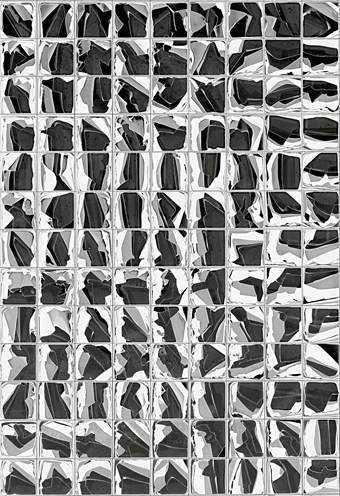
Matt Higgins, Master of Philosophy candidate, Photography and Media Arts, ANU School of Art, Untitled, chemigram, 2013, detail
The invitation from RealTime to ‘think utopian’ lobbed into our email inboxes with startling precision. We feel as though we’ve been down in the educational trenches for so long, only putting our heads above the parapet occasionally, that an invitation for long-term wish lists of new ways to encourage and enhance creativity seemed like a pretty but fragile present delivered from far away.
Utopian beginnings
But of course art schools, despite all the obvious constraints and compromises, still are utopian, or perhaps quixotic, places in which to teach and learn, because the outcomes of creativity are so precious but elusive. We were reminded of this, even before the RealTime invitation, because this year is Canberra’s Centenary, so there’s been much activity celebrating the historical ideal of the city, which was itself in part a utopian project, as well as the history of the ANU School of Art going back 40 years. For instance last semester we had two visiting artists from the UK, Neil Bromwich and Zoe Walker, working with students from across the school’s various workshops on a performance called Art School Anecdote, that celebrated the school’s philosophical roots in the Bauhaus tradition as well as its place in the community; and this semester performance artist Barbara Campbell is working with a different school-wide group of students on RE:ACT which will ‘reactivate’ the historically significant ACT3 performance event, which took place at the School in 1982.
Art school spirit
Seen in this longer historical duration the big deal about art education remains that it is now a thoroughly university education. We have now been an academic unit within the Russian doll of the university system, as opposed to a stand-alone institution, for over half our history. Nonetheless the ANU School of Art today still looks, feels, sounds and smells like an art school, and that sense of a complete creative environment has to be part of any future. It has its own culture where students still spend big chunks of time in the studio, or darkroom or lab, working with their bodies, hands, muscles or brains on detailed, skills-based processes, within disciplines that they feel part of as artists.
The studio as utopia
Our students still engage with materials, be they virtual or physical, and deal with the specific qualities and resistances of those materials. We recite the mantra of ‘studio-based teaching’ so many times that we forget how profound it is, but it has to be the bedrock of any future utopia. Our utopia would therefore still encourage students like master’s student Matt Higgins, who has revived an arcane photographic process called the chemigram, where through the successive application of photographic chemistry, as well as various resists, to photographic paper, either an extraordinary tessellated, lapidary surface is built up, or a remarkably illusory space of abstract 3D forms and swirls is created. This intense, concentrated, studio-based work has not only produced jaw-dropping images (‘How did you do that?,’ people are always asking) but has also led to Matt forming international networks across Europe and the US, linking some of the older generation of ‘chemigramists’ from decades ago with younger artists such as himself on collaborative workshops.
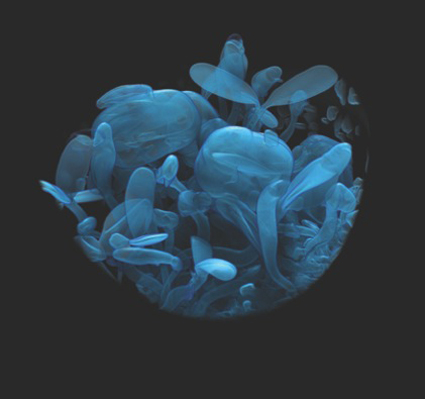
Erica Seccombe, PhD candidate ANU School of Art, Grow: visualising nature at nanoscale
courtesy the artist
Erica Seccombe, PhD candidate ANU School of Art, Grow: visualising nature at nanoscale
The transdisciplinary studio
But disciplines aren’t silos. We’ve also been saying that our teaching encourages ‘multidisciplinarity’ or ‘interdisciplinarity’, or ‘transdisciplinarity’ for so long that we tend forget the future implications of those sometimes glib throwaway lines, which are unfolding right now. The future of interdisciplinarity isn’t so much the simple partnering of artists, or the combining of skills or the translation of forms from one medium to another, it is the fundamental integration of creative spaces—‘studios’ if you like—across wide stretches of creative interest. This can only happen in a university, where there are also creative people down in their own Russian dolls elsewhere, in computer science, applied mathematics, physics, music performance, anthropology, archaeology and so on. Increasingly we are seeing collaborations not only between interdisciplinary students and researchers, but within transdisciplinary spaces.
One such space is custom software called Drishti, developed by the ANU Department of Applied Mathematics, which enables researchers to view virtual microscopic data recorded over time in three dimensions. Visual arts PhD candidate Erica Seccombe has a background in printmedia, but she is now testing the limits and possibilities of this virtual 3D data visualisation in Drishti. In Grow: visualising nature at nanoscale, she has been using 3D microscopy and x-ray tomography to capture the very moment agricultural seeds germinate in three-dimensional, time-lapsed, x-rays. Erica has been working integrally within this leading research group of applied mathematicians and computer visualisers over several years and has mastered the Drishti environment in close dialogue with the software engineers who have also continually developed and refined it. By ‘controlling,’ ‘sculpting’ or ‘moulding’ the data parameters, Erica is producing a work where her audience experiences the moment a seed comes to life in an up-close and personal way they have never experienced before. They not only see the outside of the seed develop as they might with conventional time-lapse photography, but because it is x-ray data they see the internal structure of the seed grow at the same time.
Why seeds? Her project is a response to a prediction of future food shortages due to the environmental crises of global warming and overpopulation. She says, “Our culture grew out of the human ability to harvest and grow seeds for crops, so seeds really are symbolic of what we understand as progress. However, without the natural environment we are nothing, so I think it is crucial to understand the importance of plant conservation. There is a growing understanding that contemporary installation art can provide phenomenological experiences in a way that the hard facts of science cannot. In the digital age it is scientific research and emerging technologies that provide us with a new way of looking at the world. As an artist I’m tapping into that development but resolving the work with an artistic research question, not a scientific one, and this perspective should be considered equally valuable.”

Ursula Frederick, PhD candidate ANU School of Art, Back seats
courtesy the artist
Ursula Frederick, PhD candidate ANU School of Art, Back seats
Trained as an archaeologist and artist Ursula Frederick has just submitted a PhD project on the contemporary archaeology of car culture. Her work seamlessly incorporates tried and tested archaeological techniques and methods, visual anthropology, documentary photography and fine art formal strategies (the grid), in an efficiently integrated transdisciplinary package which would have been hard to imagine as either ‘art school’ or ‘archaeology department’ project 20 years ago, but is becoming more and more commonplace now.
Studio togetherness
The ongoing moment of performance is also being returned to as a transdisciplinary space. Spontaneous and ephemeral creativity, like the repetitive and consistent techniques of the studio, has become a rallying point for explorations between technological innovation and human expression. Ben Swift, a research fellow from the ANU School of Computer Science, asked the question: could the moment in musical performance understood as ‘groove’ be identified in data? Most musicians or performers have vivid memories of that moment in a performance when the shared experience is at its most sublime. It is the consequence of a ‘togetherness’ that is all but indescribable. Using Ben’s custom musical instrument, an iPod Touch App, students from the Schools of Art and Music ‘jammed’ over a number of sessions acquiring both expertise and a shared aesthetic that resulted in moments that were clearly greater than the sum of the parts. The sessions established that the intimate tactile experience of music-making with the touchscreen devices still provided the opportunity to ‘groove’ as musicians.
The studio looks outwards
The utopian vision we have is still ‘studio based,’ still intense and focused, and still potentially across disciplines. And in universities, despite all the current angst, other disciplines—in the performing arts, in computer science, in the hard sciences and in the social sciences—are looking outwards as well. We are all now looking not just for others to ‘interpret’ or ‘present’ our work, but to share creative spaces. Researchers are leading the way, but this future is working its way down through shared graduate and undergraduate courses, and through combined degrees.
RealTime issue #116 Aug-Sept 2013 pg. 6
© Martyn Jolly & Denise Ferris & Alistair Riddell; for permission to reproduce apply to realtime@realtimearts.net
Talking to those who work in the area, it’s exciting to find that what’s utopian to them includes not only ways of teaching screen education, but what that education leads to, the wide variety of activities and employment that expertise in this area is opening up. And it’s even more exciting to realise that it’s not really utopian, because it’s already here. As reported in the Tertiary Open Days supplement in the Sydney Morning Herald on 1 August, “the creative services economy—in particular services such as digital content and web design in fields such as architecture and marketing—is growing strongly.”
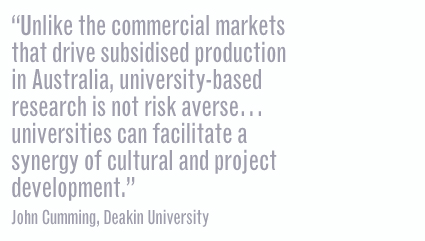
What is still utopian, however, is a better and more fulfilling relationship between the universities and the industry. There’s a belief that universities really need to engage the industry in conversations about ways they can co-operate, and argue that university postgraduate research can actually provide a much-needed forum for innovation in Australian film.
“In terms of employment, media is everywhere, in industries of all types, and media skills are really important for almost every professional these days,” Associate Professor Gillian Leahy explains. “Since our last review at UTS we’ve adopted a much more forward thinking course structure and content in both our undergraduate and postgraduate Media Production courses. While developing film and video skills still constitutes the majority of our course work, all students are learning some sound and new media and working with the web as well. And the image-making, storytelling and structure skills they get from film and video are useful across all media. So they’re all equipped to go out in this time of change and evolving work practices with skill sets that set them up for employment as well as for their own filmmaking.” She adds, “screen production is being used in all sorts of contexts—even wedding videos are now being made with a complete romantic pre-wedding narrative!”
As Leahy explains, UTS has a revised Masters and Graduate Diploma in Media Arts and Production, with more students enrolling for the new pathways provided. “They are forming better teams, as they all have to find work on each other’s projects, and the work itself is looking more sophisticated and with better production values. We don’t really know why the numbers have improved, or why they’re working better together, but it’s happening.”
Stuart Cunningham, QUT
Someone who specialises in forward thinking is Stuart Cunningham, Distinguished Professor of Media and Communications at QUT and Director of the ARC Centre of Excellence for Creative Industries and Innovation. He currently has two projects with great relevance to this area. QUT has just received a Linkage grant from ARC, in partnership with Screen Australia, SBS and the ABC which should contribute to improving the viability of the screen education sector, and the growth of the whole educational market for screen production. With the new requirement in the National Curriculum from next year that Media Arts is to be compulsory in primary schools and expanded in secondary schools, they’ll be carrying out a three-stage survey of schools in terms of their needs in resources, budgets and time for this change, as well as identifying what material is being used and how it’s being used. It’s a three-year project looking at the market for Australian screen content in education, from both supply and demand sides.
Cunningham has also just seen the publication of his new book written with John Silver, Senior Lecturer in Film, Television and Digital Media at QUT. Screen Distribution and the New King Kongs of the Online World (Palgrave McMillan, 2013, and available on Kindle) looks at the impact of the new technologies on screen distribution and the development of viable business models which deliver content to larger and larger audiences across multiple screens, from iTunes, Netflix, Amazon and Hulu to the increasingly dominant YouTube and its global clones. The authors survey the possibilities that are emerging not only for new players in online distribution, but also to what this offers to providers of new content.
Cunningham and Silver argue that there is “good news for independents around the world because the opportunity is there for good content and a sufficient number of more openly accessible video platforms now exist to distribute that content. The potential is there for next generation filmmakers, as long as they grasp the dynamics of social media and the intense feedback loops it creates, to find the right audience online.”
Nicolette Freeman, VCA
The Victorian College of Art, however, has resisted the urge to teach multimedia and gaming, to concentrate on storytelling. “What we’re currently doing is close to utopian,” says Nicolette Freeman, Head of the School of Film and Television. Last year the school introduced a Masters in Screenwriting, and this year a Bachelor of Screenwriting. “We’re putting the writing students together with the writer/director students. They’ll be doing workshops together; they will be on the set, following the process of how a script becomes a film, right through the production to the editing. We’re really interested to see how that impacts on the work that comes out, and the difference between the scripts written by writing students and the writer/director students over the three years.”
Having survived its stoush with the University of Melbourne, VCA is now able to offer electives in filmmaking, not only to VCA students in areas such as dance, but to Melbourne Uni students from totally different areas of study. “We hope students from areas such as science or law could see filmmaking, documentary in particular, as a way to be engaged in their discipline. The electives will offer everything they want to know about how movies are made, then move on to more specific aspects such as acting, censorship, other national cinemas. We’re tailoring the electives to encourage interest in filmmaking.”
John Cumming, Deakin University
At Deakin, they’re also interested in narrative. Script development is integrated with critical evaluation and production through identifying and building narrative structures. Film and Television course director John Cumming says, “The students work with genre in their second year to learn about narrative form and structure, making everything from Westerns to films employing the methods and codes of the French New Wave. They also work in TV studio production, documentary and experimental modes.”
Cumming believes the really utopian future for screen production education would see postgraduate research in creative practice that engages leading professionals. “Unlike the commercial markets that drive subsidised production in Australia, university-based research is not risk averse. At Deakin we’ve begun working with a number of leading producers, writers and directors who see that universities can facilitate a synergy of cultural and project development. Such work can enhance the capacity of industry to critically drive its own development whilst building forums of ongoing support for a new generation of creators who are focused on effectively reaching and challenging audiences.”
Cumming says that, with more than 60% of people now working in the industry having a degree, there is increased understanding of university study and research. “This brings more scrutiny to the contribution that the university sector makes. This needs to be rigorously independent but also relevant and responsive. The film industry in particular is now facing the fact it has had no effective process for high level professional development or succession planning. The university sector can help address this need, as it does in many other industries where the active participation of senior industry figures is integral to academic work. These ‘professors’ of professional practice are a brains trust that can be tapped in a coherent way by engaging them with younger personnel who are now regularly pursuing projects, including feature films, through PhD programs and post-doctoral research.”
A universities – film industry – state screen funders future
Still utopian, however, is a better relationship between universities and the film industry itself, with the federal and state screen-funding organisations still not open to university-industry research linkage, and with postgraduate practice-based researchers still excluded from accessing production funding through government film financing. John Cumming believes that the academy and the industry need to engage in conversations about ways they can co-operate, and that industry needs to understand that universities are not just turning out technicians, but providing graduates and an increasing number of post-graduates who will ultimately determine the future of screen culture. “University research isn’t just about providing statistics, it is engaging with issues of creativity in an applied way and with increasing sophistication. Serious programs of research can explore issues like how Australian films can better identify and reach their audiences, especially for those critical first and second features and documentaries. With the doors of the funding bodies effectively closed to emerging screen practitioners, much of their production is conducted, not only independently, but in near-isolation—on a credit card or with crowd funding. A little bit of academic oversight, professional mentorship and a supportive collegiate of peers couldn’t hurt.”
RealTime issue #116 Aug-Sept 2013 pg. 8
© Tina Kaufman; for permission to reproduce apply to realtime@realtimearts.net
Is there an alternative to institutional flexibility in music education that is not simple conservatism? Such ideas abound in other fields, from slow food to renewable energy to sustainable manufacturing. What might ‘slow music’ sound like and what shift in values would have to come about for it to be taught?
The heads of Australian tertiary music departments interviewed in researching this article overwhelmingly advocated for the flexibility to adapt to a rapidly changing cultural landscape and job market. We may read under “flexibility” the changes that the 400-year-old conservatorium system has undergone in the past three decades, including the introduction of courses in professional practice, the move away from core courses in history, aural studies and music theory, the broadening of the range of musics taught and the appearance of courses in music technology. Conservatoria have always changed with the times and today’s students are hardly the least likely to find a job. The first students were orphans (the “conservatori”) for whom music was a way out of the orphanage in the arms of someone willing to pay. Composer Ernst Krenek (1900-91) remembered the enormous body of casual Privatdozenten at the School of Music of the University of Vienna in 1919 who were paid only from the fees of the students who registered for their courses and who had only the vaguest hopes of achieving stable employment. Still, hoping that the utopian exercise might highlight some educational priorities that could serve as guides no matter what the circumstances, I decided to answer the survey myself as the imaginary Head of the Utopian School of Music.
Long-term into the future
Firstly, the USoM would trade a short-term conception of music’s economic value for a long-term one. With the chances of permanent employment as a musician currently diminishing, music schools are increasingly preparing students for portfolio careers. Such an approach promotes music’s short-term, bread-and-butter economic value. Short-term musical value is produced by the musician who sells works or performances within a particular genre. The professional songwriter, the band and the film-music composer can sell their work for a fee, seemingly creating value out of thin air and making them the darlings of the creative class. Long-term musical value is to be found in the paradigm-changing moments in music that produce their own music industries. Consider the numbers of musicians, administrators, institutions and related industries that have grown out of the introduction of the interval of a third in the Renaissance, figured bass in the Baroque, the 12-bar blues, innumerable traditional song forms or even the explosion of post-WW1 serial techniques. These are enabling moments in music akin to the invention of arithmetic or the formalisation of computation in science. They come about not once every career, but once or twice a century, historically.
Music’s paradigm-changing moments occur in an environment of diverse, parallel musical paradigms and among the short-term production of musical works. At the USoM short-term musical production would be balanced with an overarching view of Western and non-Western music history, theory and performance practice to nurture the next “big bang.” A 13-century student frustrated with the monotony of rhythmic modes would be able to develop proportional notation; we would finally be able to ask a medieval Troubadour whether they sang in multiple parts and Monteverdi would scandalously add chromatic decoration into his madrigals.
Flexibility of human encounters
Secondly, the USoM would trade institutional flexibility for the flexibility of human encounters. As well as existing in a formal community of works, paradigm-changing moments in music rarely occur in social isolation. As contact hours at university decrease, students are discovering that the medium is indeed the message. Even theory and analysis teachers do not just deliver content, but demonstrate how it is navigated, how one thinks in real time. At the USoM Iannis Xenakis would still be able to approach Olivier Messiaen in person and receive that life-changing advice, “you have the good fortune of being Greek, of being an architect and having studied special mathematics. Take advantage of these things. Do them in your music.”
Teachers of all genres and disciplines have this capacity to encourage and inspire while communicating technical nuts and bolts. In my experience they have also been the most flexible part of the educational enterprise. Fifteen years ago my ideal music institution was one where somebody suggested I take up an instrument. Ten years ago it was one in which somebody told me to loosen my right thumb. Five years ago it was one where somebody suggested I trade the library for the archive. One year ago it was one where somebody taught me to program. Last week it was one in which somebody told me about a particular book on music analysis. In some of those cases I was able to be that ‘somebody,’ but in most I was not and relied on the intervention of that most flexible of resources, the human teacher working in a dynamic face-to-face learning environment.
Most importantly, disadvantaged students would be included in the intensive, personalised teaching program of the institution. Just as providing access to information is no longer the task of any educational institution, providing access to information to disadvantaged students is no longer an adequate access strategy. Participation is key. It is only when such students are engaging in music at a high level that measures to increase access will be successful. This means actively teaching and engaging with them from an early age.
Appropriate use of technology
Thirdly, The USoM would trade the buzzwords “innovative use of technology” for “appropriate use of technology.” We are only now, after many expensive failures, learning what technology can and can’t do in education. At the USoM Students would download their textbooks but attend lectures in person, the electronic music students would know when a visual mapping of audio data looked naff and arbitrary, teleconferencing suites would not substitute for studio teachers but be reserved for masterclasses, and interactive performance technology would be developed with musical ends in mind. Tom Dowd would record the first albums onto four-track tape and Elisha Gray would invent the musical bathtub.
A product of one’s own
Yes, a modern musician must have business acumen, but they must also have a specialised product to distinguish them from others. The USoM would nurture a culture of distinct musicians between the globe-trotting musathletes and the community orchestra enthusiasts, a level akin to German Mittelstand businesses that have proven resilient to competition and a changing economy through specialised manufacturing processes. Can we incorporate a long-term view of musical value, social flexibility and the appropriate use of technology into today’s mercurial funding environment? Thankfully the USoM exists in a utopia of unlimited funding where Messiaen and Monteverdi stalk the halls, but as a student in a world flooded with capable performers and easily accessible information, there are definitely reasons to choose a school that offers an intensive, face-to-face and rewardingly high-tech learning environment.
Matthew Lorenzon hosts the Partial Durations new music blog. He is currently completing a PhD in musicology on the rapport of music and philosophy in the works of the philosopher Alain Badiou and the composer François Nicolas.
RealTime issue #116 Aug-Sept 2013 pg. 10
© Matthew Lorenzon; for permission to reproduce apply to realtime@realtimearts.net
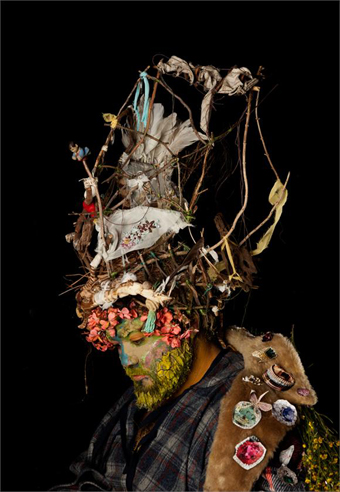
Shan Turner-Carroll, Shan, from the series Primal Crown, 2012, HATCHED National Graduate Show, 2013, PICA
image courtesy the artist
Shan Turner-Carroll, Shan, from the series Primal Crown, 2012, HATCHED National Graduate Show, 2013, PICA
Each year in the Arts Education issue of RealTime, we feature works that catch our eye by recent graduates, often sourced from the annual HATCHED National Graduate Show, presented by PICA in Perth.
Our intriguing cover image is by Shan Turner-Carroll, a Fine Arts graduate from the University of Newcastle, winner of the prestigious Dr Harold Schenberg prize at this year’s HATCHED. In a new take on the portrait, Turner-Carroll displayed a series of “makeshift crowns for his family made from found objects that hold personal significance—relics embedded with present memories and future thoughts” (catalogue). Recently returned to Australia after traveling to his ancestral homeland of Myanmar where he met with local artists and curators and exhibited at 7000 Padauk, a contemporary art space, Taylor-Carroll is currently looking at producing a body of work responding to his time there.
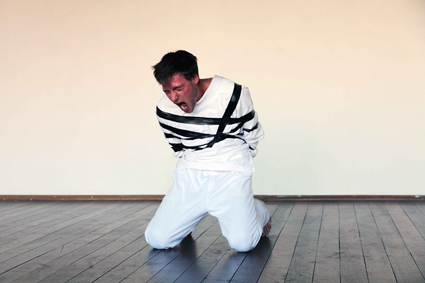
Alex Wolman, Brief Candle, 2012; Hatched: National Graduate Show 2013, Perth Institute of Contemporary Art
photo Maren Jorgensen
Alex Wolman, Brief Candle, 2012; Hatched: National Graduate Show 2013, Perth Institute of Contemporary Art
For our education feature profile a further two HATCHED artists. In his hour-long performance Brief Candle, Alex Wolman, currently completing an Arts History degree at the University of WA, gives us the body in extremis, freeing itself from bonds and shouting until it’s hoarse. Wolman “sees the body as a sensitive and articulate yet deeply flawed medium through which to interact with the world, and is captivated by the thought that every human has one. In this he sees a unique opportunity to utilize a medium that is at once both familiar and strange to all” (catalogue).
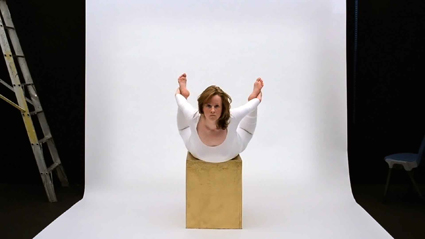
Jen Broadhurst, Abstract Feminism, Historical Construction, 2012; Hatched: National Graduate Show 2013, Perth Institute of Contemporary Art
The work of Jen Broadhurst (Fine Arts/Painting, Monash University) is less visceral but just as sharply focused on the body. She says, “As I have developed my practice I have become increasingly influenced by Feminism and Formalism.” Predominately video-based, with performance as a key element, Broadhurst’s works propose “a dialogue between certain feminist concerns, such as idealisation, perfection, objectification and neo-maternalism and how these ideas have manifested throughout art history” (catalogue).

Caitlin Franzmann, Courtney Coombs, Focus, 2012, Fresh Cut exhibition
image courtesy the artists and IMA
Caitlin Franzmann, Courtney Coombs, Focus, 2012, Fresh Cut exhibition
On page 2, the image is from Focus by Caitlin Franzmann, an interactive installation developed in collaboration with Courtney Coombs during a Backdoor Gallery residency at Room60 and featuring in Fresh Cut, this year’s IMA exhibition of emerging artists. Franzmann completed a Bachelor of Fine Art (Honours) in 2012 at the Queensland College of Art, and recently has been awarded an Australia Council Artstart Grant. “Focus…literally positions the audience to face one another in close proximity and focus on the act of making or not making direct eye contact. The sound component of the work focuses the individual experiences of the participants; one helmet directs attention to the act of looking, the other heightens the awareness of one’s self being looked at” (Rachel Parsons, catalogue). RT
HATCHED: National Graduate Show, 2013, PICA, Perth, 20 April-9 June; Fresh Cut, 2013, IMA, Brisbane, 3 August-21 September
RealTime issue #116 Aug-Sept 2013 pg. 10
© RealTime ; for permission to reproduce apply to realtime@realtimearts.net
As the afterglow of ISEA2013 in Sydney begins to fade it’s a good time to reflect on where media art, an area of practice that has always been inextricably linked to the academy, is headed at the outset of the 21st century.
While ISEA2013 was a dynamic gathering of innovative practices, it also highlighted a significant turning point. Occurring 21 years after TISEA in Sydney—remembered fondly as celebrating the beginning of ‘new’ media art in Australia—maybe ISEA2013 marked the end of this first idealistic epoch. (See RealTime’s Media Art Archive which charts the development of media art practices over this time.)
The idea of ‘newness’ in media art was discarded around the turn of the century/millennium. Given the ubiquity of technology in our lives and the rise of a generation who have grown up switched on and plugged in, is the idea of media art as a distinct form still meaningful at all? (There are, of course, some who would argue it never has been.)
If we look at the relevant funding arm of the Australia Council and its morphing nomenclature, the term ceased to be meaningful in 2005 with the disbanding of the New Media Arts Board in favour of an inter-arts blend. As of May this year, we enter the more expansive, though perhaps more elusive territory of the ‘experimental and emerging.’ This latest change brings back the idea of the ‘new,’ associating it directly with the ‘art,’ leaving the ‘media’ open to interpretation.
So what are the ramifications for education in this area? Are institutions leading, following or fighting this shift away from media as a specific medium towards a more general emphasis on ‘new’ and ‘experimental?’ I interviewed Associate Professor Paul Thomas, from the College of Fine Arts [COFA], University of NSW and asked several key academics from universities around the country, teaching in both fine arts and media studies, for their thoughts on what might constitute a utopian education system for their area of practice.
Demolishing the silos
Paul Thomas’s career trajectory is an interesting case in point. Thomas is one of the early advocates and pioneers of electronic arts, co-founding the group Media-Space in Perth in 1981. He went on to found and direct the Biennial of Electronic Arts Perth [BEAP] as well as developing the Electronic Arts course at Curtin University. Now at COFA he is Head of Painting. Thomas says, “The whole rise of technology, the input of technology into the art school became a misguided direction. It’s just another layer of complexity in the potential to construct and make art.” He believes that as technology has become more ubiquitous, as computers and digital cameras have become part of everyone’s daily expression, students don’t “see why it would be a separate subject. It’s just part of the way they make art.”
Thomas is now working with the idea of the transdisciplinary rather than interdisciplinary. “Interdisciplinarity is part of the major problem of the silos. We say you can do anything you like in media arts, you can paint, you can sculpt, you can make installations and so on, and sculpture and painting would say the same thing. So if everyone is saying this, why don’t we have one course instead of all these different courses?”
Dr Gavin Sade, Head of Interaction and Visual Design at the School of Design, Creative Industries, QUT in part agrees: “Any ideal program would be transdisciplinary in nature—not just multidisciplinary through a combination of classes drawn from within essaying faculty silos, but instead a dedicated curriculum designed by academics with an interest across disciplines.”
Science, the new/old frontier
Sade believes “the challenging question is the importance of media art education. For me the most interesting aspect of media arts is actually the intersection of art and science which occurs within the media arts community as seen for example in the publication Leonardo.” Sade suggests a more complex relationship between the arts and science based on the idea of difference. “Value needs to be recognised beyond instrumental readings of Art as an input for innovation, or Art as a form of visualisation of scientific data.” He seeks “development focused on the difference and similarities of art and science and an appreciation that it is from the difference that new knowledge emerges.”
Thomas is of the same mind. “We’ve shifted away from the media arts and back into arts and science. [Our] understanding of the state of the world, how we deal with different concepts of reality, nanotechnology, how atoms work, how matter is formed [is] becoming a new materialism…There are a number of possibilities to explore the world and the university has a lot of them on its doorstep; so how do we access the sort of atomic force microscopes, the biological and chemistry areas, the spatial sciences?”
Australia does boast a leading example of this art-science fusion, the first of its kind in the world, at the University of Western Australia. SymbioticA was established in 2000 by Professor Miranda Grounds, Dr Stuart Bunt and Oron Catts, offering hands-on laboratory access for artists researching in the areas of art and biology, ecology, bio-ethics, neuroscience, tissue engineering and sleep science. It seems that utopia may lie in the development of more laboratory/studios such as these.
Cutting red tape
Dr Mark Cypher, Senior Lecturer and Academic Chair, Digital Media at Murdoch University, also expresses the desire for a transdisciplinary approach which he sees is currently hampered by bureaucracy and inflexible infrastructures. His utopian wish-list includes: “access to disciplines across campus IT/design/art/science/engineering without the politics; university infrastructure and teaching spaces that enable a wide range of teaching practices rather than chalk and talk or lab models; easy national and international university partnerships and collaborations; and a system that enables the diversification of university funding models rather than relying on bums on seats (student numbers) with a churn and burn mentality to education.”
Pedagogy and the internet of things
A common desire from these academics is for the realisation of total connectivity and subsequent access to ever more vast amounts of information. Katie Cavanagh, course co-ordinator of the Bachelor of Media, Department of Screen and Media, Flinders University shared the story of the first time a student appeared to be ‘fact checking’ her lecture on his iPad. After initially feeling nervous about the idea of being “exposed” she came to the conclusion “that he wasn’t distracted by his iPad, he was entirely immersed in everything we were discussing.” Cavanagh sees future teaching methods as incorporating “live discussions where all threads are visited [online] and the experiential multi-tentacled intermingling of knowledge, research, interaction and discussion in class becomes a critical organic part of every unique lesson.”
Cypher and Dwyer also emphasise the potential of easily accessible online information via what Cypher terms “an open Internet…that enables access to meta-data about all things all the time.” Dwyer gets specific, suggesting a database of interactive projects via something like YouTube: “We could see the code, how a new project co-opts existing projects and the mistakes. The teaching possibilities would be amazing.”
Pragmatic futures
Natasha Dwyer, Senior Lecturer in Multimedia at the Victoria University, offered thoughts on the employment landscape for students: “I hope that one day the word ‘entrepreneur’ can lose its status as a ‘dirty’ word…The fact is that industry is changing (for better or worse) and all types of people in the creative industries such as media arts will need to find their way on unproven paths. We need to be able to help students navigate this competitive environment and somehow inform the shy, the unassertive and others without the ‘entrepreneurial image’ that they too can find a place.”
So who is inhabiting this utopian education environment? Paul Thomas sees the utopian student as a kind of “transdisciplinary nomad.” He asks, “What would this student need if they were to land anywhere in the university, to engage from an arts point of view.” His answer brings us back to the basics of a creative education: “The ability to think, the ability to make and play.”
Whether it’s old or new, trans, inter or hybrid, it seems that these basic creative principles remain immutable.
RealTime issue #116 Aug-Sept 2013 pg. 12
© Gail Priest; for permission to reproduce apply to realtime@realtimearts.net
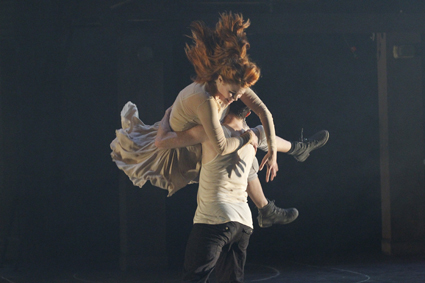
Andrew Carolane, Annabel Marshall-Roth, Article One devised by Bagryana Popov in collaboration with Acting Company 2012, School of Performing Arts, VCA, University of Melbourne
photo Jeff Busby
Andrew Carolane, Annabel Marshall-Roth, Article One devised by Bagryana Popov in collaboration with Acting Company 2012, School of Performing Arts, VCA, University of Melbourne
The university can be a haven for the developing performer, a place to learn, fail, experiment and take risks. It can be a site for safe creative interplay between students, lecturer performance makers and experienced artists seeking postgraduate refuge in which to reflect on their careers and to be challenged.
I asked teachers to share utopian visions for the training of students. It was clear they believed they were already achieving much, above all a sense of community, the transmission of expertise, intergenerational exchange and many ways of thinking and making, above all collaboratively, in an increasing range of forms. The common utopian wish is to make the student experience even more experiential, more immersive and more directly related to the industry in which students hope to be employed or, more importantly, that they will in the long-term create, having been trained to be inventive, flexible and independent.
In this scenario, industry comes to the theatre and performance school, participates in projects and recognizes, as Helen Trenos of the University of Tasmania puts it, that students are in fact emerging artists. As Flinders University’s Julian Meyrick argues, It’s time to get some solidarity back into our profession. To remember, that it is a profession, a lifetime’s commitment, not just a market niche…”
Meyrick urges “real thinking in an ideal vein” rather than ‘utopian,’ while Peta Tait at La Trobe University worries that inconsistencies in the tertiary sector risk making the sustained teaching of performance uncertain, with ramifications for the whole industry.
Melanie Beddie, Robert Walton, VCA Theatre
VCA Theatre Lecturers dramaturg Melanie Beddie and playwright Robert Walton emphasise the opportunity in the BFA (Bachelor Fine Arts, Theatre Practice) for students “to enter a community of extraordinary theatre artists all in the process of learning by doing and making.” The “comprehensively trained actor,” they believe, “will ultimately bring about change and improvement in their art form.” At the same time each will continue “to grow as a performer and theatre maker throughout their working life.”
This optimism is predicated on the belief that “the best makers of theatre have emerged from a context of understanding performance through an experiential immersion in it. In other words an embodied dramaturgy. We focus on enabling each year of actors to work well together. Of key importance is the ability to collaborate. The development and practice of the individual’s agency within the group is paramount.”
Beddie and Walton’s approach extends to a political vision: “When they work well, collaborative ensembles can offer models of alternative society, of sites of resistance, anarchy, radical democracy and inclusion. Staff and students repeatedly ask themselves Brecht’s question “what would you do to make the world a better place?” You can’t wait for some fabled time when you will be ‘ready’ to be an artist: rehearsals are never long enough, you could be more skilled, and there is always greater insight just around the corner. We look to the world and respond with what we have, wherever we are in our training. The practice of being an artist starts now: responding extraordinarily with what you have to hand.”
Rather than offering a ‘personal utopia’ of “becoming famous, becoming ‘someone,’” what Beddie and Walton say the VCA offers “is a set of skills that can allow people to live a life seemingly doing what they enjoy. In Marxist terms, working hard but not toiling. Creating standards of good work for oneself and choosing to live up to them is hard. Shouldn’t utopia be easy?”
Rosalba Clemente, Flinders University
Head of Acting and theatre director Rosalba Clemente declares from the outset, “I am not really into utopian visions but more interested in what is possible—what we can do rather than what we can’t…Students need mostly to work with the absolute best practitioners who have articulated, strong working processes and something to actually teach and know how to teach it—how to help students execute their ideas in three dimensional space—this is a huge task.”
As our surveys of film and media arts education indicate, there is a desire for greater connection between schools and their respective industries. For Clemente that would involve an intensive artists’ residency program: “It would be wonderful to have theorists and practitioners working closely with students in an artistic community—made up of playwrights, devisors, directors, actors, designers—being trained towards the making of new work and how to participate in varied processes, dramaturgical and otherwise. In an ideal world one would then have all the production assistance, including high level digital media etc [required] to realise the work—a way to fully test the ideas.” Clemente wonders if “state and federal agencies could fund a revolving schedule of resident artists to work with schools to make a new work a year, teaching and utilising students throughout.”
On the other hand, Clemente is in no doubt that already “we stimulate our students across our theory and practice units to examine many ways of making work. The Co-Creation unit in the acting course aims to stimulate the actor as dramaturg and creator. It would be great to do more of this work. And more…”
Helen Trenos, University of Tasmania
Helen Trenos is Program Director for Theatre in the Visual and Performing Arts faculty at the University of Tasmania. In an exciting move, analogous to the creation of WAAPA’s graduate dance company LINK, Trenos says, “We are currently working towards the formation of a graduate company comprising our Honours and Postgraduate (MFA and PhD) students…to provide students with the opportunity to showcase their own works as well as enabling professional theatre/performance practitioners to work with students to realise a script or devised work.”
Beyond what one could already regard as a utopian move, Trenos, like Rosalba Clemente, would like “the Australia Council and state funding bodies to establish a grant scheme for professional mentors working in tertiary contexts. Professional mentoring is enormously important for emerging artists and university students should not be exempt from this category. They are emerging artists. Mentoring can be equally enriching for those professional artists sharing their expertise and skills.”
Cath McKinnon, University of Wollongong
Playwright and Lecturer in Performance, Cath McKinnon delineates the approach to training in the University of Wollongong’s School of Creative Arts: “we offer different approaches to the development of new work: creating and workshopping original texts; re-writing classic texts; mashing up texts; collective devising from research. Our push is on students developing skills in several areas so that when they leave they can self-start projects.” The aim is “to teach students how to develop an aesthetic and critical conceptual plan that will frame their mad cultural dreams, desires, passions, interests, so that their audiences can engage with a theatrical or film project in ways that are fun, meaningful, whimsical, real, truly felt, exhilarating. We also want our undergraduate students to connect with our postgraduate students, so that they have the opportunity to influence each other. We aim to create a post-graduate ‘space’ that offers writers and devisors reflective time-out from the industry. A place to regenerate, engage with other artists, ponder where they’ve been and where they want to go.”
As for utopia, McKinnon would like to see “the development of a wider cultural environment where the university is the hub (or one of the hubs) of new theatrical or film work; where the university links those just emerging into the industry (undergraduate) and those coming back to the university for some reflection time (post graduate), with the industry itself.” This, she thinks, would develop an environment of “critical collaboration and celebration” where “critical and aesthetic responses to what is happening around us locally and globally are connected in a way that resonates with audiences…In an ideal world the community and various government bodies would celebrate this emerging stage [for students] and support financially those universities whose major concern is training and mentoring writers and performance-makers…”
Peta Tait, La Trobe University
At a time when mining corporations and their ilk demand ‘certainty’ from governments, the creative arts in universities frequently suffer uncertainty. Writer, playwright and editor Professor Peta Tait writes, “My utopian wish is influenced by recent developments at the National Institute of Circus Arts which threaten the continuation of NICA’s degree course and its unique and irreplaceable training opportunities, and my observations over years of how courses in performance have been threatened or weakened or disappeared overnight.
“I want to see studies and training in the arts in the university sector respectfully and appropriately maintained by all tertiary institution managements so that students continue to receive a high level of teaching and learning across a diverse range of art forms.”
Tait argues that a consistent approach is vital not just for students but for the industries “reliant on the graduates from courses offered in the tertiary sector. Therefore a university cannot be allowed to suddenly change direction and/or reject responsibility for a vital area of cultural activity. There is such a wide variation in the approaches of different university managements to artist training even within a single university, and given how crucial this is for Australian culture as a whole, I want to see study and training in the arts guaranteed reliable specialist decision-making which is transparent and consistent over time. The arts need self managed approaches to study and training that fully recognise what is needed to create an artist.”
Julian Meyrick, Flinders University
Writer, director, theatre scholar and now Strategic Professor of Creative Arts at Flinders University, Julian Meyrick argues,“The ‘new’ in and of itself is not accessible as an intelligible performance result except through new relationships” between processes and product. “Everywhere we see something ‘new’ claimed by an old configuration of order, we find a ‘look’ only. Today’s theatre is very good at looking new when, underneath, it’s nothing of the sort.”
If without indicating what the acceptably ‘new’ might look like, Meyrick turns dialectically to the past: “we also need to step back, to identify axioms and foundations, to draw strength from our history, tradition, and lines of generational transmission…It’s important as part of a living conversation that asks us to interrogate our practice as part of an on-going, collective project. That asks us to be more than just individual producers hawking our wares in a saturated cultural marketplace.”
Like Beddie and Walton, Meyrick believes, “We need to equip students with a sense of what the field is actually like but also with the courage and consideration to effect change within it. Utopian thinking alone is not enough. It just feeds fantasies of personal difference—feeds the cultural marketplace. Another generation of industrial fodder would be a disgrace. It’s time to put a little hope back into the system by fostering the possibility of real transformation.” Meyrick suggests that “This double movement—of forwards into the future and backwards into the past—can only come about through a broad and inclusive conversation.” Such a conversation is vital given that artists “have been played off against each other to general defeat. It’s time to get some solidarity back into our profession. To remember, that it is a profession, a lifetime’s commitment, not just a market niche….”
* * * *
Here is the full text of Julian Meyrick’s response.
Historians joke ‘all ages are ages of transition.’ Theatre and performance-making is ephemeral in the strictest sense of that word, so naturally the processes they use, the things that get made and the values linking the two are also in a constant state of flux. What should be our response to this as educators?
It should be two-fold. On the one hand, we should be reaching out to new ideas and possibilities. To new relationships, in other words. The ‘new’ in and of itself is not accessible as an intelligible performance result except through new relationships. Everywhere we see something ‘new’ claimed by an old configuration of order, we find a ‘look’ only. Today’s theatre is very good at looking new when, underneath, it’s nothing of the sort.
On the other hand, we also need to step back, to identify axioms and foundations, to draw strength from our history, tradition, and lines of generational transmission. In the Australia context, this is a revolution of thought, a radical and usually unwelcome insistence that the past matters. And it does, though not in the way its detractors fear. The past is not important in itself. It’s important as part of a living conversation that asks us to interrogate our practice as part of an on-going, collective project. That asks us to be more than just individual producers hocking our wares in a saturated cultural marketplace.
This isn’t the time for ‘ideal thinking’ in my view, but for ‘real thinking in an ideal vein.’ That sounds complicated, but it’s a simple thought. We need to equip students with a sense of what the field is actually like but also with the courage and consideration to effect change within it. Utopian thinking alone is not enough. It just feeds fantasies of personal difference—feeds the cultural marketplace. Another generation of industrial fodder would be a disgrace. It’s time to put a little hope back into the system by fostering the possibility of real transformation.
This double movement—of forwards into the future and backwards into the past—can only come about through a broad and inclusive conversation. I am tired of one kind of creative practice being ranked over another, one kind of artist over another. The proclaimed tolerance for diversity just leads to shorter shelf lives for hard-won aesthetics, a higher churn rate of creative practitioners. We have been played off against each other to general defeat. It’s time to get some solidarity back into our profession. To remember, that it is a profession, a lifetime’s commitment, not just a market niche.
We need to look at the politics of our creative practices, not in the sense of being over-determined by non-creative goals, but in being mindful of the forces of the contemporary world that militate against the true artistic life. And there are many. We need to discover not ‘our individual market difference’ but our collective, professional vision. We need to discover what it is to be artists.
Julian Meyrick is Strategic Professor of Creative Arts, Flinders University
RealTime issue #116 Aug-Sept 2013 pg. 14,16
© Keith Gallasch; for permission to reproduce apply to realtime@realtimearts.net
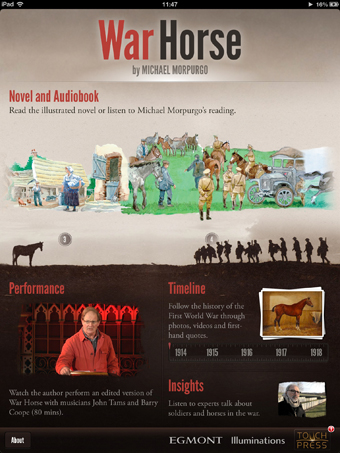
Michael Morpurgo’s War Horse App
With the migration of readership from paper to the e-page, there’s a tide of change in publishing and writing outcomes. But university Creative Writing departments seem reluctant to deal with it. They’re not yet thinking seriously about the fiction and nonfiction of the future. Not even the near future. They’re not yet designing infrastructures for it. When paper publishing is a thing of the past, there’s a danger they’ll still be teaching writing for the past.
Learning the skills of writing for the future already involves the novel as app. An example of the form is this year’s Bologna Children’s Book Fair prize-winning version of Michael Morpurgo’s War Horse. This interactive book produced for the iPad is published jointly by children’s publisher Egmont and Touch Press. The blurb says:
“At the heart of the app is the complete text of the novel, together with an unabridged audiobook reading by the author. Alongside the text sits a Timeline which tells the real story of the First World War through documents, maps, photographs and film. As in the novel, the war is seen from both Allied and German perspectives, with professionally narrated first-hand quotes and over 200 original photographs to bring you closer to the soldiers’ experience.
“The Insights section presents 34 video interviews with historians, experts and the author, which shed light on the inspiration for the book and its historical setting… There is also an exclusive, 80-minute live filmed Performance of War Horse which completes this rich digital experience…The performance includes synchronised transcript and song lyrics. The Performance and Insights can also be streamed full screen to AppleTV.”
So, it’s a fictional, non-fictional, performance, musical and historical work, and it’s exegetical. It’s richly illustrated with photography, graphics and digital cleverness. It boasts various performers, including the author, and has a number of music soundtracks. All it costs is $6.99.
Children are growing up reading books like this. There are many picture storybook and young reader examples. Experimental novelists too have embraced the app. It has been said that the older, conservative generations are grieving over the passing of the paper book, and are still in the first stage of that process—denial. What they also deny is the brilliant future of the book. The War Horse app novel, and others like it, indicate exciting opportunities for reading, for multidisciplinary teaching and for creative writing.
But Creative Writing courses have not caught up. Creative Writing courses have been so excited about actually getting accreditation (and high enrolment numbers) in almost 40 universities in Australia, they have forgotten to think about how radically writing is changing. Ironically, the rise of Creative Writing in Australian universities in the 1990s and 2000s coincided with the rise of the computer and the internet, and especially, the concept of interactivity. Hypertext showed readers that the reading process did not have to be passive. Of course, it never had been actually so—reading was always about interacting—reacting with one’s intellect, imagination and emotions. But hypertext extended the possibilities beyond the limits of the bound-at-the-spine, ink-marks-on-paper, MONOgraph book as we knew it.
Hypertext expanded the book into realms which previously involved further and separate acts of production—the incorporation of visuals, the adaptation to performance, the addition of commentary and glossing mechanisms. All of which required processes of their own—that is: creativity, research and production classified as other than the book. With hypertext, however, illustration, the play or film based on the book, the talking book, the index or concordance and exegetical/critical discussions of the book can be part of the book itself.
Clearly now, the digital book can contain what was previously called research for, adaptation of and extension to the text. This is the new definition of the book—a multi-modal, multi-disciplinary, multi-artform entity. A multigraph, not a monograph.
Strangely, though, I haven’t yet found my students turning up in first year wanting to write the digital book. They actually say they want to be published on paper—they see it as somehow prestigious or authentic—and they don’t say they want paper publication because of the JK Rowling or Suzanne Collins multi-millionaire factor.
For the app-savvy, it seems, paper publishing retains a status that relates to university as a place to learn to write very much better, as opposed to just doing it yourself. I tell my students how excited I am about who will write the first Young Adult novel to go to the top of the charts: it will be done by one of their generation—an app novel about an emerging boy/girl/both band that has soundtrack and clips included. I wish I’d had such a possibility in my future when I set out as a young writer. They look at me askance, maybe just a glimmer of the future in their eyes, when I say things like, “Why don’t you write a multi-modal novel on your tablet? It’s got a keyboard, a camera and a microphone pick-up.”
The future of writing, reading and teaching new books—including how to write them—will be multidisciplinary, multi-arts and cross-arts. The best department for a Creative Writing program will be a Creative Arts department where performance, visual arts, digital and new media arts and music are also taught. Maybe English should be housed there too: the unreconstructed English Department persisting now may otherwise need to be split with History and Philosophy. While donning my bullet-proof vest, I’m also inclined to say that the English PhD is dead, and that from now on it must get multi-arts oriented. Perhaps every doctoral submission in English should include a creative product—a work which shows that knowledge about reading has been fully learnt and extended.
Creative writing courses of the future need to teach many more processes than they do today in order to prepare students for the brave new world of 21st-century fiction and nonfiction.
RealTime issue #116 Aug-Sept 2013 pg. 16
© Nigel Krauth; for permission to reproduce apply to realtime@realtimearts.net
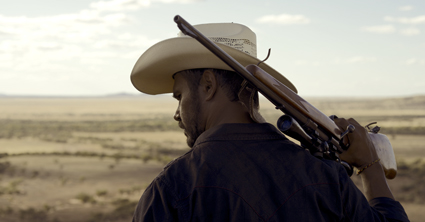
Aaron Pedersen, Mystery Road
photo Ivan Sen
Aaron Pedersen, Mystery Road
It begins when a long-haul truck driver discovers a body at night, in an ominous, visually arresting sequence that sets the tone for what will follow. There’s a dark, seemingly endless highway, street signs (“Mystery Road,” “Massacre Creek”) which hint at a locale with a troubled history, and the Australian outback at dusk: the driver’s torchlight a tiny accent in the darkness.
This is Ivan Sen’s third feature, following Beneath Clouds (2002), a road movie of sorts about the developing relationship between two Indigenous teenagers with markedly different desires, and Toomelah (2011), a window onto a young boy’s life in the former Aboriginal mission, with a cast almost exclusively composed of local non-actors.
While Mystery Road occupies similar social and geographic territory to these films, it differs from them firstly in its use of a predominantly seasoned cast, and secondly in being primarily a genre work which cleaves with great respect to the conventions of the murder mystery, with its narrative lynchpins of the obstructive community harbouring a secret; the detective-outsider; and the dogged, methodical pursuit of the truth. Like the best detective stories, however, it presents us not only with a mystery, but with an unfolding portrait of a particular community and place.
Aaron Pedersen plays the film’s central character Jay Swan, the only Indigenous police detective in his outback home town. Assigned to investigate the murder of the Aboriginal girl whose body is discovered at the film’s beginning, Jay embarks on what amounts to a one-man investigation, caught between an Indigenous population which has rejected him and colleagues he distrusts. Almost every scene in the film is a one-on-one interaction between Jay and an alternating cast of possible witnesses, suspects, family members and fellow cops (the boundaries, as one would expect, are blurred).
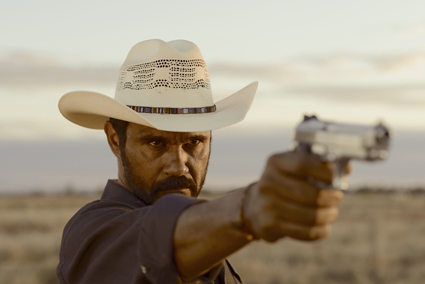
Aaron Pedersen, Mystery Road
photo Ivan Sen
Aaron Pedersen, Mystery Road
Sen emphasises the significance of these encounters by subduing background noise to near silence, with the result that faces and voices take on an almost unnatural clarity. Every exchange is a piece of the puzzle, and the viewer is encouraged to watch vigilantly. This wouldn’t work without the committed performances of Mystery Road’s cast, an impressive concentration of Australian character actors which includes Tony Barry, Hugo Weaving, Jack Charles, Tasma Walton and Jack Thompson. Pedersen leads them in a strong, understated performance as the conflicted Jay, a contained man whose gaze is constantly wary, but who also projects sincerity and dependability.
With its small-town setting, cowboy cops and a good guy in pursuit of justice, Mystery Road has more than a hint of the Western as well as the whodunnit. Visually, it’s as clearly delineated as a graphic novel, displaying a predilection for close-ups and figures silhouetted against sunset landscapes. A recurring aerial sequence shows the geometric streets of the town as Jay drives to houses of potential witnesses. Sen’s skill as an all-rounder (he was DOP as well as writer and director of the film) is clearly apparent. Where Mystery Road falls down slightly is in its function as a detective story. Every scene might be a piece of the puzzle, but not all of these pieces are put together at film’s end, particularly the portentous references to wild dogs which recur throughout but are never satisfactorily explained.
Overall, however, Sen has employed the framework of the whodunnit to create a striking piece of cinema whose stylisation enhances rather than overshadows this story about a misfit cop probing a town with a rotten, racist core.
–
Mystery Road, writer-director Ivan Sen; director of photography, editor, composer Ivan Sen; producer David Jowsey; Arclight Films; released 17 October
RealTime issue #116 Aug-Sept 2013 pg. 18
© Katerina Sakkas; for permission to reproduce apply to realtime@realtimearts.net
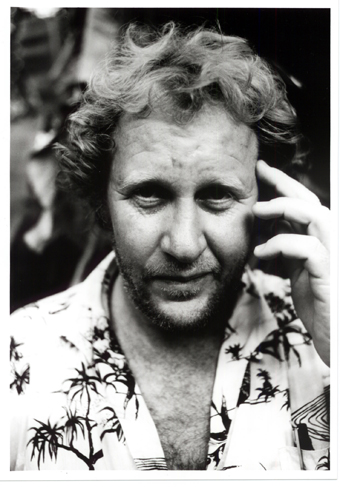
Dennis O’Rourke (1988), during the making of Cannibal Tours, released as free content with permission of Dennis O’Rourke, photo Chris Owen & Camerawork Pty Ltd
I only ever saw him once in the flesh, but I’ll always remember Dennis O’Rourke sitting in the audience at an Australian International Documentary Conference (AIDC), dominating the room with his sheer presence. He wasn’t part of the panel that day, but when he put his hand up to speak, the entire crowd turned to listen. Provocative, emotional and fiercely intelligent, O’Rourke was always worth listening to—and always worth watching. With his death on June 15, Australia lost one of its most incisive and imaginative documentarians.
O’Rourke began his career at the ABC in the early 1970s, making his first documentaries in Papua New Guinea and tracing the initial years of independence for our northern neighbour. Several of these works, like Yumi Yet (1976), brought O’Rourke international acclaim.
Throughout the 1980s he explored the domination and exploitation of Indigenous peoples across the Pacific in extraordinary films such as The Shark Callers of Kontu (1982), Half Life: A Parable for the Nuclear Age (1985) and Cannibal Tours (1988). Half Life is the most horrifying of these, with its images of children deformed by US nuclear testing in the Marshall Islands. But where contemporaries like Bob Connelly and Robin Anderson adopted a more detached, observational perspective in framing the legacy of colonialism, O’Rourke’s work was always distinguished by his reflexive interest in the act of representation itself.
Half Life, for example, sets its disturbing images of the effects of nuclear testing against US-made documentaries about the Marshall Islands from the 1950s. These films blithely described the islanders as “savages,” too simple to comprehend what was being done to their homes by the US military, and grateful for the medical testing to which they were subjected by a magnanimous US government. The jaw-dropping racism of these old documentaries makes clear that the exposure of the islanders to nuclear fallout was not an accident, as was claimed at the time, or even an aberrant lapse of respect for human life on the part of the US authorities. Rather, it was the logical outcome of an entire world view and attendant system of representation that defined white American ‘civilisation’ as human and Indigenous cultures as primitive, disposable leftovers of an earlier age.
The question for O’Rourke in all this was the place of his own camera. Could he position himself as a critic of an imagistic order that has always privileged the white, Eurocentric gaze? Or was he, as a white, camera-wielding Australian, part of the problem?
These questions lurk around the edges of films like Half Life, The Shark Callers of Kontu and Cannibal Tours, but the ambivalence of O’Rourke’s relationship to the documentary form developed into a full-blown crisis in his most controversial and best known film, The Good Woman of Bangkok (1991). In the aftermath of the breakdown of his marriage, O’Rourke set out to form a relationship with a Thai prostitute, paying her to participate in his film. Together they created a “documentary fiction” that placed their relationship at the centre of the microcosm of global inequality that is Bangkok’s red light district, where cashed-up white tourists enjoy cheap sex with impoverished women from Thailand’s rural areas.
Good Woman still has the ability to divide audiences more than two decades on. At the time, many were incensed. O’Rourke was roundly condemned in print, and sometimes in person, by festival audiences convinced that he had exploited his subject. The storm inspired a whole book of essays on the film and the controversy it engendered (The Filmmaker and the Prostitute, Power Publications, 1997). As Linda Williams points out in one of that volume’s most perceptive pieces, many of the audience responses revealed far more about Western documentary viewers—and the unconscious assumptions informing our worldviews—than they did about the film itself.
Further controversy awaited O’Rourke with the release of Cunnamulla in 2000 (RT41, p14) a searing portrait of life in a small Queensland town. With its frank discussions of casual teenage sex, it made for another discomforting experience.
His last completed film, Landmines—A Love Story (2004), was more conventional in its approach, but continued O’Rourke’s fascination with the gap between the material reality of life in developing countries and the way we represent it on screen. The film focused on a couple in Kabul, both missing limbs due to landmines left over from Afghanistan’s many wars. Interspersed with O’Rourke’s observation of their daily lives are old military documentaries extolling the virtues of the landmine as a weapon of war.
No Australian filmmaker, and few abroad, have matched O’Rourke’s sensitive dissection of the relationship between rich Western countries and the world’s poorer nations. Uniquely among Australian directors, he also interrogated the long history of documentary images helping to maintain these global relations of power by fixing and dehumanising the racial ‘other.’ At a time when images are once again playing an integral role in demonising those from faraway places, and helping to justify spectacular cruelty in the name of “border protection,” we need critical filmmakers like Dennis O’Rourke more than ever. Alas, O’Rourke himself can no longer help us.
RealTime issue #116 Aug-Sept 2013 pg. 19
© Dan Edwards; for permission to reproduce apply to realtime@realtimearts.net
The best historical documentaries blast history out of the past and make us re-experience it as a living present, pregnant with possibility, rife with contradictions. Less critical documentaries simply reduce history to a smug justification for the way things are today. Paul Clarke’s two-part Whitlam: the Power and Passion, recently screened on the ABC, falls squarely in the latter category, telling us more about our impoverished contemporary political sphere than it does about the 1970s.
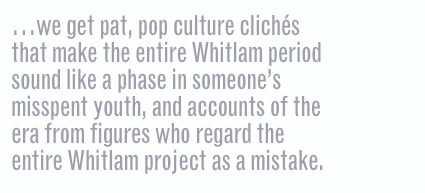
Take the depiction of the period from which Whitlam emerged. One of the distinctive features of the Australian Labor Party under Whitlam was the broad church of ideas the party encapsulated, but you wouldn’t know this from viewing Clarke’s film. The senior leadership of the late 1960s and early 70s included everyone from deeply religious, conservative figures like Kim Beazley Senior to stalwarts of the New Left like Dr Jim Cairns. The fact that Labor encompassed such wide-ranging ideas made it a powerful force for social change. Whitlam’s ability to hold such a grouping together was certainly indicative of the charismatic sway he held over the party and his inclusive approach, but there’s a lot more to the story. In Clarke’s hands, the rich cultural, social and intellectual context of the period was reduced to a colourful backdrop for Whitlam’s personal journey, summed up with a few pop culture clichés such as images of the Beatles and whispered tales of sexual debauchery in the outer suburbs. Ironically, for a film about a politician, there was very little about politics—unless you define politics as a personality contest rather than an arena of ideas.
Although Clarke managed to sidestep any serious consideration of the broader context within which Whitlam worked, even his ‘great man’ approach to history was grossly undermined by unnecessary re-enactments scattered throughout the film. While adding nothing to our understanding of events, these interludes made Whitlam look like precisely the kind of boring, grey politician he wasn’t. Of his learning, elegance and wit there wasn’t the slightest trace.
Whitlam’s attributes were more in evidence in the archival clips of the man himself, speaking at rallies and on television. Watching these brief glimpses of Whitlam in action, it was striking just how far our political discourse has fallen. While present-day leaders treat the electorate like distracted five year olds incapable of digesting anything more than repetitive soundbites, Whitlam actually listened to questions from journalists and attempted to provide considered, intelligent answers. Many did not agree with what he said, but he undeniably said something. Clarke’s rapid-fire approach left little room to explore this startling—from a contemporary perspective—aspect of the Whitlam era. Each time we saw archival footage of Whitlam addressing a question, Clarke cut away within a few seconds, exhibiting the same lack of faith in his audience’s ability to concentrate as our current generation of politicians.
The unrelenting focus on Whitlam also reduced other key figures of the period to bit players, often sketched with little more than condescending platitudes. This was most striking in the portrayal of Jim Cairns, a man who came within one vote of leading the ALP in 1968. There is no doubt Cairns was a complicated, flawed man who ultimately disappointed even many of his closest followers. At the time, however, he was a major figure in Australian public life, who opposed the Vietnam War from its earliest days and who argued his case painstakingly in various books and pamphlets. He was a central figure in the Moratorium Movement, a role completely effaced in Clarke’s documentary. Most importantly, Cairns exhibited a level of compassion in all he did that puts current politicians to shame. In Clarke’s film, Cairns was reduced to the inconsequential, libertarian buffoon he’s been characterised as ever since his fall from grace, neatly forestalling any consideration of his actual ideas or popularity at the time.
The marginalisation of Cairns is indicative of Clarke’s treatment of the entire ALP left, most obvious in his choice of interviewees. The politicians we heard from were nearly all right wingers who have been instrumental in dismantling Whitlam’s legacy. Bob Hawke, the leader who transformed the ALP into a centrist party with neo-liberal economics as its guiding philosophy, was one of the key Labor voices, yet he wasn’t even a part of the Whitlam Government. Liberals like arch-conservative John Howard, who had very little to do with the events of the Whitlam era, were given free rein to rehash the standard narrative of Whitlam’s “disastrous” government. Other interviewees, such as Andrew Denton, were simply irrelevant. In contrast, one of Whitlam’s most able and prominent ministers, Tom Uren, made one passing appearance and was never heard from again. Is it a coincidence that Uren was also of the ALP left, whose defence of the Whitlam project would no doubt be anathema to those who now control both major parties?
The interviewees may have been the result of Paul Clarke’s choices, but it’s hard not to see the perspectives offered in the film as reflecting the ABC’s nervousness regarding political ‘bias.’ After all, the prevailing orthodoxy is that Whitlam’s government was a disaster and the man’s views out-dated, so why give airtime to anyone offering an alternative perspective? The result was a documentary that reassures us all that Whitlam may have been a flamboyant, fascinating figure, but his government was a crazy experiment that we thankfully laid to rest—albeit using slightly unorthodox means. Now we can all look back with the same nostalgic amusement with which we regard pictures of our parents wearing flared jeans.
To truly understand the past, we need to examine the unrealised hopes and ideals of a period, as well as question what actually transpired. Nowhere did Clarke’s film ask why, if the Whitlam period was the unmitigated disaster his detractors paint it as, have so many of his key policies—like universal medical care, higher education for those outside the moneyed elite and reconciliation with Indigenous Australians—enjoyed such longevity? More difficult questions were not even hinted at. Why was Jim Cairns’ affair with Junie Morosi built into such a scandal, while Bob Hawke’s philandering has always been regarded as evidence of his salt-of-the earth blokeyness? Why has no Australian government since Whitlam’s ever questioned the assumption that Australian foreign policy must always be aligned with the interests of the United States—and did Whitlam’s challenge to this assumption contribute to his downfall? It seems unlikely we’ll ever see questions like these seriously considered on the ABC, let alone any other mainstream Australian media outlet.
Instead, we got pat, pop culture clichés that make the entire Whitlam period sound like a phase in someone’s misspent youth, and accounts of the era from figures who regard the entire Whitlam project as a mistake. By implication, Clarke’s documentary asserted that our contemporary politics —with its neo-liberal orthodoxies and spin-doctored bites—is just the way it has to be. In taking this approach, Clarke may have shown us little of the passion, but he certainly showed us where the power now lies—and has done since November 1975.
Whitlam: the Power and the Passion, writer-director Paul Clarke, producers Mark Hamlyn and Penny Robins, ABC Television, 2013.
RealTime issue #116 Aug-Sept 2013 pg. 20
© Dan Edwards; for permission to reproduce apply to realtime@realtimearts.net
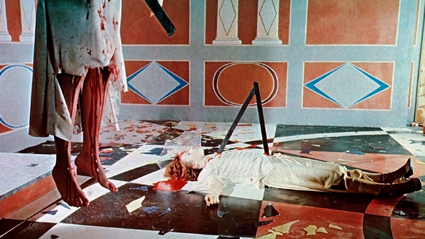
Suspiria
Hovering tensely and amusingly between kitsch and high art, Dario Argento’s Suspiria (Italy, 1977) was the highlight of my several days at Perth’s Revelation International Film Festival, an aesthetically challenging and pleasingly intimate event hosted by program director Jack Sargeant and Revelation Chair Richard Sowada.
Suspiria
Fixated on the tropes of horror and suspense thriller films, Argento elaborates on and lingers over them with calculated artificiality—his world is spatially exaggerated, surreally dreamlike and richly lit with unlikely colours, his characters hyper-types with severely limited vocabularies.
At times Argento’s generation of suspense and shock is masterful (hands plunging though a window and pulling the face of the person inside flat to the breaking glass), at others he over-relishes the moment draining the image of affect—as in the scene with the blind pianist lost with his Doberman amid neo-classical buildings on an empty black space. The ‘consolation’ is that the dog turns on his master, with close-ups of the animal tearing at real meat (but not in the graphic manner of the contemporary horror film where we’d doubtless see the face and throat of the victim). Elsewhere the blood is patently fake, artfully applied, as is a large shard of glass neatly sculpted into a face. Characteristically, Argento’s play with depth of field and the use of doorways (leading into ambiguous spaces or sheer nothingness) yields both existential eeriness and visual delight. These are crafted excesses.
Of apparent secondary concern in Suspiria, narrative provides sufficient foundation for the largely visual realisation of a murder mystery with a witchcraft theme. Music is another matter. Tautly thematic and un-clichéd, its percussion shimmers, bass lines sink into otherworldliness and the musicians’ voices form an enveloping ghost chorus. Performed at REV live by Goblin, the creators of the original soundtrack, to a vivid print and clear dialogue, the tightly cued music gave the film even greater cogency, making for a wonderful audio-visual experience—a heightened viewing of a classic rarely encountered on the big screen.
White Reindeer
White Reindeer (USA,2013) a largely crowd-funded American film by Revelation guest the writer-director Zack Clark, was a cut above standard Indie fare. If conventionally filmed, the creation and evolution of its central character, Suzanne (Anna Margaret Hollyman), a real estate agent whose TV weatherman husband is murdered very early in the film a few days before Xmas, is adroitly realised. Deeply depressed and increasingly manic but largely calm on the exterior, she finds herself sucked into unusual situations (a very funny orgy, drug-taking, a friendship with a black woman—her husband’s sometime mistress—and shoplifting) that take her well beyond her comfort zone and the narrow world of her timid parents (who suddenly divorce) and us with her on a largely unpredictable journey, some of it into deep abjection. What is special is the uncluttered ease and absence of rationalised motivation with which Clark allows his protagonist to go on this journey into excess and potential healing. Also effective is the way the director satirically frames Suzanne’s fall and rise, heightening the sense of an un-nuanced world in which people privately indulge in extremes. White Reindeer is at once funny and sad, and feel-good without being a turn-off: the road of excess into grief by way of abjection leads to a palace of wisdom, if a humble one.
Upstream Colour
Upstream Colour (writer, director, cinematographer, composer, actor Shane Carruth, USA, 2013) was an altogether more demanding experience with little of the Indie inclination to straightforward novel-ish narratives. Its calculated lack of narrative certainty, its distant characters and unusual shooting were too much for some of the audience, while others found it exhilarating. Naturally there was debate, but little in the way of middle ground agreement. The film’s various disorientations make for an engrossing experience as an animator, Kris (Amy Seimetz), who appears slightly off kilter at work, falls prey to a man who drugs her into signing over her property and leaves her lost, amnesiac and deeply wounded. Such is the filming that we share her delirium. Unlike Suzanne in White Reindeer, Kris’ full recovery looks unlikely as she rejects a sensitive if similarly withdrawn male’s approaches, his character tainted for us by obsessive paper folding. Heavy with deeply ironic references to Thoreau’s On Walden Pond, with images of rotting and infection (maggots pushing up veins in her leg, to which Kris takes a knife) and of farm pigs (whose care might signal salvation), Upstream Colour (the title is a clue to solving one of the film’s mysteries) is abundant with excess. But its juxtaposition with the spare characterisations created a dynamic I enjoyed in these pedestrian times, if having to accept the film’s metaphysical pretensions à la Terence Malick.
Sam’s Gold
Sam’s Gold, a short drama by Australian filmmaker Julietta Boscolo and writer Rebecca Clarke, cleverly frames a young boy’s struggle to maintain a sense of self with the tale of a young wizard written for Sam by his gaoled father. The father, reading aloud in prison, is the first person we see before we follow Sam on his way to school listening to the story on an iPod, a gift from his father. Local bullies steal it from him, burning his hand with a cigarette lighter, but he assertively regains the player. The film deftly delineates the boy’s needs (his father absent, his mother delinquent), his courage and ethical good sense.
Interior, Leather Bar
Producer James Franco and director Travis Matthew’s docu-fiction Interior, Leather Bar was inspired by the mystery of the 40 missing minutes (cut presumably in the face of censorship) of William Friedkin’s Cruising, an infamous 1980 film about a detective (Al Pacino) going underground and gay in order to catch a serial killer. There’s much talk about the casting of the Pacino role with Van Lauren, a very straight actor whose objections are met with bland, mumbled assertions from Franco that he wanted to show the warmth of gay male sexuality. After watching the cock fondling and sucking from the edge of the action, sharing meaningful looks with one of the cohorts and joining the subsequent dancing, our new Pacino (“I’m not the same man I was when I came into this”) goes home happy to his wife. Or does he (“touched by the intimacy of the couple”) see something that he likes? There is nothing to indicate
the nature or the depth of the change. The sex scenes are conventional soft core, tarted up with video clip editing and overwrought ambience.
Surkhaab
One of the stranger films in the program was Sanjay Talreja’s Surkhaab (India, Canada, USA, 2012). The leading actor, Barka Madan, a Buddhist nun who has forsaken the martial arts she demonstrates in the film, addressed us in robes and shaved head. Surkhaab is about people smuggling (the relatively good father smuggler and his bad smuggler son) and their clients, in this case an educated, elegant young woman, Jeet (Madan), who has become the victim of aggressive sexism in her hometown in India. In a post-film talk, Madan explained that the director decided that the film was too linearly predictable and asked the editor to re-order it. The result is two intertwined narratives, one following the woman to Canada, the other cutting back to India to gradually reveal the increasing seriousness of the plight that finally drives Jeet to become a refugee. Madan aside, there are naïve performances, some clunky scripting, improbable plotting and a limp feel-good ending. But the film makes it evident that you don’t have to be poor, the victim of political terror or war to be driven to become an ‘illegal’ immigrant. But even if she has found a new home (still as an ‘illegal’) Jeet learns that in Canada “I am just another immigrant; just another story.” More positively, she is a woman at the centre of a serious film, a trend Madan said was developing in Indian filmmaking.
Experimental Showcase
Jason Wen’s Let Everyone Create Their Own Title (UK, 8mins) is a fascinating impressionistic ‘biography’ that conveys some sense of what it might mean to suffer Parkinson’s Disease. Wen limits our vision of the sufferer’s world to a narrow vertical strip of screen in which we view him, his home and nature—each seen as blurred or quaking, utterly still or pondered close-up in intense detail.
In Long Life (1) (Australia), Merilyn Fairskye magically works the horizontal plane, playing simultaneously with our perception of horizon, depth of field and our sense of up and down. Sky and reflective water overlap near what we’d expect to be the horizon, but it takes quite a while to grasp an eerie otherness in which drifting weeds below appear above like a bird flock, ducks float seemingly out of scale with the waterscape above the horizon while what we take for islands drift by. This seven-minute, characteristically contemplative Fairskye work was one of the several works that justified the experimental label.
With a very different perceptual challenge (keeping up with the speed of image turnover), Dan Browne’s multi-award winning Memento Mori (Canada, 28mins; https://vimeo.com/54265266) offers a long, fast ride through a constantly morphing, heavily layered image-scape, which the maker describes as “a meditation on (im)mortality, mediated by a lifetime of images.” The 100,000 photographs and film images (some of them classically ‘experimental’) that constitute the work’s content from the filmmaker’s archive fly by—richly coloured, merging into one another, creating abstract patterns and spectres, their flow occasionally ‘slowed’ by the persistence of a specific image (a police car, a receding railway track). The multi-layered soundtrack comprising radio snatches, toy piano, a man talking at length about death (the film speeds on while the aural plane at one level slows), religious chants, birds and rain is deeply absorbing in itself as well as matching and counterpointing the pulse of the film. The moon, a boy’s hand resting against grass, a tale of a Buddhist monk’s philosophical conviction (“I could have your sword run though my belly without a blink of my eye”) and a chiming church bell in the film’s final moments, complete with a glimpse of the filmmaker’s face, underline a sense of mortality, our spirit buoyed by the richness of what has passed.
Revelation Perth International Film Festival, 4-14 July
Keith Gallasch was a guest of the Revelation Perth International Film Festival.
RealTime issue #116 Aug-Sept 2013 pg. 21
© Keith Gallasch; for permission to reproduce apply to realtime@realtimearts.net
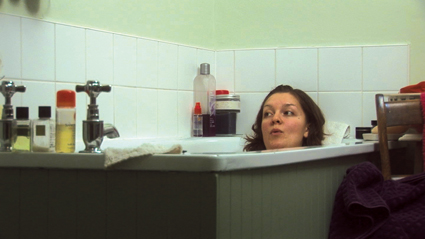
Marcus Coates, Dawn Chorus (2007), video still, installation commissioned and produced by Picture This, Bristol, funded by Wellcome Trust, courtesy of Kate MacGarry Gallery, London
Vocal Folds (curated by Jacqueline Dougherty and installed at Gertrude Contemporary, Melbourne) presents a careful selection of three video works which individually and collectively address the human voice in varied ways.
The installation—like a notable number of Gertrude Contemporary group exhibitions over the past five years—wonderfully grants the visitor access to the material and phenomenal aspects of each work. The ‘white cube’ hasn’t been ignored or destroyed: it has simply become invisible in the face of the installed works, which means that the audiovisual content is comfortably and impressively conveyed without interference by inappropriate architectural edifices, inadequate acoustical accommodation, or improper curatorial assumptions of the audiovisual experience.
Vocal Folds has been refreshingly conceived as a material occurrence, in accordance with its intention to investigate the material effects of the human voice as a generator of palpable linguistics and discursive abstraction.
Valie Export
Valie Export’s film I turn over the pictures of my voice in my head (2008) serves as a critical introduction to these notions. Export’s work is a curious amalgam of linguistic didacticism and visceral scopic spectacle—which for me grants it a somewhat obvious audio-visuality. While this is to a degree typical of Viennese Aktionism and its after-effects, Export’s lugubrious intonation of a convolving Wittgensteinian text seems divorced from the conceit of using a laryngoscope to spectacularise the means of production of her language. For some, this audiovisual merger will intensify the experience (the thrill of inserting scopic and auditory devices into the human body is a longstanding trope of radicalised body art) but I found the work surprisingly monotonal and literal. Regardless, Export’s work posits one recourse to visualising the mechanics of language through the materiality of the vocal apparatus.
Marcus Coates
Marcus Coates’ multi-screen video installation Dawn Chorus (2007) creates a dense field of communicative noise by employing British morning bird chatter. The mass twittering of birds is the first thing you hear when you enter Vocal Folds. It’s a frenetic, exhausting veil of warbling frequencies and piercing harmonic tones, yet it hangs throughout the three galleries in a non-obtrusive way. Fourteen video screens are positioned throughout the space at varying heights and angles, inviting you to wander through their arrangement. At any one time, you can hear at most three or even four birds whistling, but due to the high frequencies of bird sound, it’s quite difficult to locate their position—especially within an enclosed space. After some time, it became apparent that at select moments, one of the onscreen portraits (each of a singular person alone and comfortable in a plain domestic setting) would break into birdsong. But at this precise moment, the video went into hyper mode, indicating that the ‘birdsong’ I was hearing was in fact humans mimicking birdsong at a slowed-down speed, which was then played back at high-speed to replicate the frequency range of birdsong. Of course, to a bird, it would have sounded more alien than avian—like us listening to a computerised simulation of an off-shore call-centre worker reading James Joyce through a fuzz-box and presuming it to be ‘vocalised language.’
Dawn Chorus—possibly unknowingly—recalls a longstanding tradition of composers attracted to the impenetrable vociferousness of birdsong and the complexity of its multifarious modes, dialects and individualised applications. Beethoven—gifted in hearing music both within his head and in the outside world—allowed birdsong to activate lyrical motifs in his pastoral suites, evoking the sensation of being immersed in the musical crossfire of the outside world. Similarly, Olivier Messiaen—skilled organist and ornithologist—spent innumerable hours meticulously transcribing birdsong patterns from which he elaborated complex rhythmic shapes and dense harmonies to simulate birds’ melodic phraseology. Oskar Sala—developer, with Friedrich Trautwein, of the trautonium and early explorer of the intersection of physics and acoustics—processed and transfigured birdsong tape recordings to render them ‘post-avian’ and hence monstrous for Alfred Hitchcock’s The Birds (1963).
Manon de Boer
While Dawn Chorus is largely determined by an extant attraction humans have toward avian linguistic code, Manon de Boer’s two-screen installation one, two, many (2011) treats humans in a similar fashion. Shifting and alternating between two screens facing each other, a suite of three videos is projected, one at a time, and each time on a different screen. One video is a performance by a vocal ensemble in the large reception area of an old building, watched by a handful of visitors; the next is a performance by a solo flautist alone in a small domestic room; the third has the camera focused on a wall while a woman’s voice talks about listening to a tape recording of a lecture by Roland Barthes.
In one sense, there’s something very modish about one, two, many. Contemporary art for nearly a decade now has been progressively aligned not only with performance and performance art history (canonised by and through Marina Abramovic’s Seven Easy Pieces), but also by the performative modes, techniques and practices of a wide spray of arts predicated on both traditional and experimental legacies of performing. Music has notably come into the spotlight here, with many a video-art videographer treating composers, musicians and their audiences like anthropologists fascinated with such brethren. Often it’s like David Attenborough studying a Fluxus performance: the artist seems to be pondering “what are they thinking when they’re performing/playing/listening/etc.?” De Boer’s one, two, many falls into this category. As much as I would like to celebrate the rigour of its cinematised ‘deep listening,’ I hasten to historically and culturally locate its anthropological tendencies. The roving camera, streaming its one-take flow, ably conveys the sense of entrancement endemic to the act of listening—but such camera technique was well established by tracking shots in Busby Berkeley musicals in the 1930s, where space was dematerialised to evidence the temporality of listening. Manon de Boer’s camerawork resembles more the base humanist impulse of anthropological documentation: to evidence the human being in front of the lens, hence the palpable presence of their hair, skin, clothing, posture. Through such a procedure, the human becomes eroticised—yet for no direct purpose. (Not surprisingly, this is precisely what impels most ‘experimental/exploratory/extended’ forms of musical improvisation: humanism.)
To listen, not document
When the Dardenne brothers stayed within the audible breathing space of Rosetta in their 1999 film of the same name, they treated her as if they were filming a combatant in a war zone. This intensifies the psychological claustrophobia which terrorises Rosetta throughout this gruelling film. When in Crazy (2002), Heddy Honigmann places her camera literally in the faces of Dutch UN peace-keepers as they endure the playback of songs they used to assuage their near-insane anxieties while working in debilitating warzones, she captures how the sound of music now ruptures their present space with overwhelming memories of the past. From the gasping breath of a frantic teenager in the former to the silent tears held back by aging men in the latter, the camera is used not to document but to listen. One, two, many doesn’t achieve this, yet—like the Valie Export piece—it affords the opportunity to make these links and consider the wider options of its audiovisual practice.
Yet I’m frankly not confident that visual art professionals are entirely attuned to what I’m saying here. All three videos exhibited in Vocal Folds contain enough visual beauty—from the abject to the transcendental—to satiate the intelligentsia. And I’m equally sceptical that sound/music professionals are interested in the intellectual ramifications of their experimental practices. These videos contain soundtracks and sound designs implicitly opposed to conventional audiovisual cinema practices, thus emboldening those who think audiovision is best discussed as a radical or progressive intermedial venture. Vocal Folds bravely intimates that language can collapse or evolve into a supra-form through the materiality of the voice (something one can imagine Cathy Berberian or Joan La Barbara espousing) but I feel most people will stop just there. The Vocal Folds exhibition for me opened up possibilities from that point, to welcome how the depiction of humans engaged in making or listening to sound or music can illustrate an escape from humanist inscription.
–
Gertrude Contemporary, Vocal Folds, curator Jacqueline Dougherty, Melbourne, 21 June-20 July
RealTime issue #116 Aug-Sept 2013 pg. 22
© Philip Brophy; for permission to reproduce apply to realtime@realtimearts.net
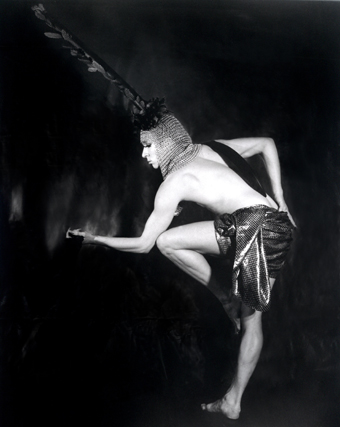
Francois Chaignauld
photo Odile Bernard Schröder
Francois Chaignauld
Despite some claims for a ‘palimpsest’ approach through a focus on dance history, I couldn’t really think of this year’s Montpellier Danse festival as a whole, but rather as a series of discrete works. That said, director Jean-Paul Montanari is a well-informed guide for his survey of a history that is honoured in Europe and the USA in a way that genealogies of Australian dance certainly are not. The staging of Maguy Marin’s classic, May B (1981) and a chronological trilogy from Trisha Brown spanning the years 1989-2011 showcased the ability of this festival to draw from the archive with panache.
Maguy Marin
May B is an important work linking French contemporary dance to the country’s mime tradition. Using clown-like facial and body prosthetics and with clay covering their skin and clothes, the characters in the piece are dusty remnants of a forgotten village. They move in rhythmic unison and follow one another’s behaviour, whether marching, dancing or barking garbled noises. This pattern is broken when two female characters spar, a birthday cake is shared and the group travel, leaving the stage from the front, climbing awkwardly down into the stalls and reappearing upstage. Selfishness is a key theme but also care and loneliness —a study in universals played by a very committed cast and with a compelling use of regimented chorus work.
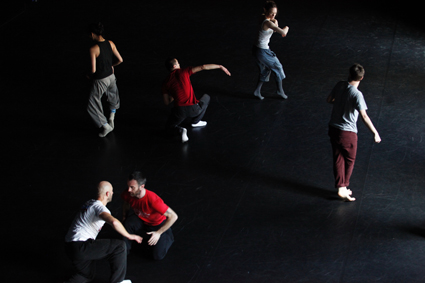
Corner Etudes, Emanuel Gat
Emanuel Gat
Emmanuel Gat, the choreographer-in-residence at this festival, provided the public with access to his choreographic process across a week as he devised the last part of a quartet of ‘etudes,’ Part 4: The Surprising Complexity of Simple Pleasures. This strategy follows his very Cagean interest in opening up composition to the contingencies of real life. (Gat has been writing about his choreographic approach on his website.) We joined him at the last rehearsal, but some members of the public had followed the whole week and the exercise appeared to be very successful in building a relationship with his audience.
The final work, Corner Etudes, builds on Brilliant Corners which I saw in 2011, continuing Gat’s interest in music as a compositional point of departure. The audience was invited onto the stage of the cavernous Theatre Berlioz in Montpellier’s Corum for the first three sections: a group, duet and quartet. Sitting around a square of light, the perspective and ambience was dazzling. The duet between Michael Löhr and Francois Przybylski included an original song performed by Przybylski and the quartet was a delicate study in collapsing spaces between bodies. For The Surprising Complexity… the upstage back wall was flown up in a grand gesture and a seating bank appeared facing out into the absent audience. In rehearsal we witnessed the atmosphere of egalitarianism as Gat does, as he states, ‘let the work happen.’
Mature artists (including Australian Genevieve Osborne) with diverse technical backgrounds, amazing facility and creative investment had each developed movements to a song of their choosing. In composing these voices into a single work, Gat shifts each of them between dancing and singing and layers material by bringing one song to the front and having the dancers adapt to this ‘score.’ He then adds a second song that gives them a choice of temporal structures to follow. He subsequently adds and subtracts dancers (where in other sections these choices seem to be ‘called’ by the dancers as they name someone and cluster to them), ending this section with Przybylski and Milena Twiehaus collapsing the space between two solos so that they are dancing on top of each other, with arms stretching through armpits and scraping slowly across necks. This final solo of the piece was quiet and mesmerising. The movement choices of the dancers are often intriguing and while the final composition has something in common with William Forsythe’s clustering of energy within groups and across space in an ebb and flow or breath-shaped pattern, this movement is of a more terrestrial order with everyday gestures included and bodies more firmly connected to gravity. The inter-relationships are also more intimate and gently confronting.
Trisha Brown
A single performance from the Trisha Brown Dance Company delivered a survey of works from across her mid- to late career when she began to choreograph with music: Astral Convertible (1989), If you couldn’t see me (1994), and I’m going to toss my arms—if you catch them they’re yours (2011). The remarkable thing about the 1989 piece is that it looks so like Cunningham with its Robert Rauschenberg set and John Cage score, its silver unitards with bizarre ‘fanny skirts’ on the girls differentiating the sexes, and some very shape-based movements. This reasserted a continuity in American modern dance for me that has been smoothed over by the intensely detailed analysis of that nation’s dance history which emphasises the important differences in what is fundamentally very similar.
The dancers were surprisingly young and had an attitude of calm non-fussiness, delivering movement material with minimum effort and an ample softness. The trademark little skips, lightning changes of direction, oddly awkward partnerings and leaps, and deceptively simple compositions of the group in space were all operating across the three works. Arms were kept to a minimum with an emphasis on the trunk of the body initiating movement and the limbs following on. Brown’s interest in the basic mechanics of the body and real effects of gravity and weight were in evidence as the simplest moves were performed with clarity and delicacy. It was a thrill to see Brown’s work live, especially as she is retiring from the head of the company due to failing health.
Cridacompany
This French company’s piece, Manana es Manana, begins with three men bent over a pile of potatoes, tossing them into the centre of the mound over and over with an amplified soundscape of the puttering noise produced. These simple means set the tone for a performance that shows what a body can do in simple, funny and awkwardly moving sequences. The only woman of the quartet is a thin, lanky, beautiful but morose character who attempts to do her hair and put on her shoes while the men shake her arms and legs to tragi-humorous effect. The three men then toss her around like a plank of wood in inventive and risky ways—dropping her and clapping before catching her, balancing her on their shoulders and turning themselves around while she stays where she is. A homemade video shows them in the Alps and one of them free-jumping off a mountain from a dizzying and alarming camera viewpoint. It’s hard to describe some sequences to give due credit. One performer juggles with hacky sacks while changing clothes, accompanied by a voice-over pronouncing how good he is. The humble somersault is worked into intricate weaving patterns and simple lugging becomes a hefty ‘ballet’ as the men move each other like sides of meat. It’s simple circus delivered with compositional simplicity and a lot of personality.
Francois Chaignaud
Dumy Moi was my last show in Montpellier and a cracker. I had heard about Chaignaud’s partnerships with Cecilia Bengolea including an expressionist dance modelled on early 20th century work and a duet performed with glass dildos in their bottoms. But nothing could have prepared me for this work. Chaignaud emerges from the dark as a massive shape: he is wearing what looks like a traditional Asian dancing outfit with a hoop of feathers attached at his waist and bare bottom showing, wings and chest plate of gauche sparkly decorations in plastic, a headpiece of feathers and shiny arm and leg plates. Made up like a Chinese opera performer and singing deeply like a Japanese Noh actor, he performs simple turns and promenades. This section ends with spinning and I wonder where he can go from here wearing that outfit. But the next section sees him extricate himself from it with style, singing in-between in a falsetto voice—this in itself is astounding. Combined with the series of outfits and immaculate dance moves his performance, experienced in the round and at close proximity, is a tour-de-force.
The next outfit comprises a hat of full-sized birds with a long plume of feathers curling around Chaignaud. A feathery jacket completes the transformation and he jumps delicately and high. This is the beginning of his most choreographic section with impressive held arabesques and deep second pliés, delicate running sequences and slow walks balancing on demi-pointe. Chaignaud adds to this outfit a five-foot wooden headress and continues with his dancing and singing in the most awkward postures. It felt like a salon performance for the rich and spoilt (he calls it a ‘recital’): a baroque treat and a must for the next Sydney Mardi Gras Festival.
Montpellier Danse 2013, Montpellier, France, 22 June-6 July
RealTime issue #116 Aug-Sept 2013 pg. 28
© Erin Brannigan; for permission to reproduce apply to realtime@realtimearts.net
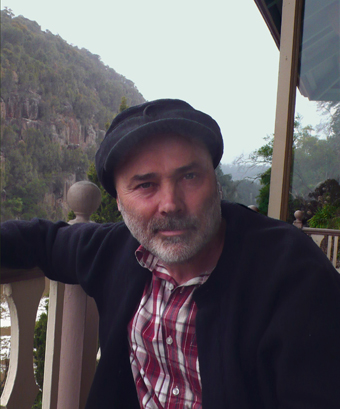
Bill Burns
photo Krys Verrall
Bill Burns
Seriously idiosyncratic Canadian artist Bill Burns is a featured guest of Launceston’s 2013 Junction Festival. His art has humour, bite and an intriguing diversity of means that focus on our relationships with nature, politics and the art market. His work has been shown at London’s ICA and New York’s MoMA and his nine books include Dogs and Boats and Airplanes told in the form of Ivan the Terrible (a photo-montage version of Eisenstein’s film featuring only dogs, boats and aeroplanes).
Although famed for being, as one writer put it, “a fabricator of small worlds that contain big ideas,” like his Safety Gear for Small Animals (1993-…) which comprises small hard hats, safety vests and respirators for all manner of beasts, Burns is creating a very large, live work for Junction.
Dogs and Boats and Airplanes Children’s Choir is a collaborative artwork performed by a 100-strong children’s choir sourced from four Launceston schools. The children, aged 8-12 years, will chorally mimic the sound of dogs, boats and aeroplanes in a libretto of their own making. Fifty other children will create the set, props and lighting for the live theatre performance which includes the making of pageant floats. I spoke with Bill Burns by phone not long after he’d visited his first school in Launceston.
You’ve produced this work before but the scale of it this time looks amazing. You’ll be marshalling many forces—a corralling of cats.
That’s true. In a lot of ways it’s a premiere because I’ve never done a live version. We’ve done some recorded versions with children in a studio but never with 100 children and never live.
Are you working on your own or do you have a team?
There’s quite a big team. First of all, it wouldn’t be possible without the support and expertise of the Junction Festival team. Then there’s a choral director, Amanda Hodder, from Tasmania—quite a well-known musician and choral director in this area. The artist Krys Verrall is travelling with me to work on the pageantry for the project, which takes place in between the choral movements. All of it is a very collaborative process with the children basically writing the libretto and developing the pageant.
I was working yesterday for the first time at one of the schools and it was pretty exciting. The kids are pretty pumped-up about it. The only thing to do now is to wrangle them into shape.
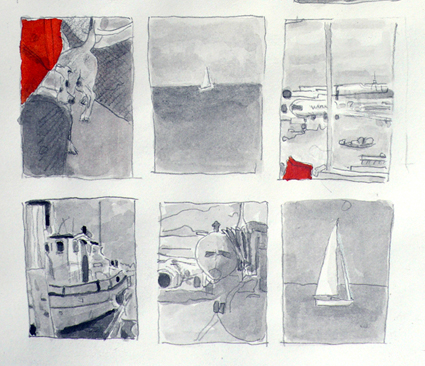
Dogs and Boats and Airplanes, Bill Burns
You’ve done works with children talking about birds and using mechanical bird sound devices (Bird Songs for Toronto, 2008), but why children making non-verbal simulations of the world around them?
I think that all of us can be artists, so I wanted to find a way that kids could be artists without having to go through all the hoops of acquiring certain kinds of technical expertise. And my work has a lot to do with expanding who can be creative in society. So for instance, I think all of us can be artists and that’s the way I would like my society to be—a place where everyone is an artist. But we have that drilled out of us.
Why specifically dogs, boats and aeroplanes?
I’m very interested in dogs and I feel like the connection between humans and dogs is really important to cultural history as well as natural history. So it’s this kind of relationship that borders quite nicely between nature and culture. And then, a lot of my works in the past have been about the tension between nature and advanced industrialism. So the idea of using the sounds of dogs and the sounds of boats and aeroplanes seemed like a way to bridge those tensions and look at them. And also being artists in the 21st century, we tend to travel a lot and I see a lot of boats and airplanes, but I also see a lot of dogs in different cities. So I’ve come to know dogs in Asia and South-America and the Caribbean and throughout Europe and the Americas. And I know that a dog in Paris and a dog in Seoul have different characteristics and they socialise differently. So you have this curious relationship between us and the dogs. And, of course, the dogs have this long history of working with humans as our worker dogs and protecting our sheep and so on. And those are very connected to human history. You know, dogs came out of Central Africa as well. So they come from the same place we do and we have a very long history with them.
I guess there’s a certain kind of sonic appeal for children in making a sound work.
Sometimes you forget the most obvious things and that’s one of them. It certainly appeals to the children. The boys gravitate towards the F18s sometimes but everyone is a pretty good howler and barker. Curiously, the boats tend to be more difficult. I think maybe they’re a little bit less known in our sonic culture.
There’s diversity in your art making, from watercolours to survival suits for small animals and your Guantanamo kit (Boiler Suits for Primates, 2009, a 1:5 scale model of everything that prisoners received when they arrived at Camp X-Ray in Guantanamo Bay, Cuba). How do you see them all fitting together?
Partly in that relationship between nature and the way things are going with advanced industrialism. A lot of my work has to do with that tension. One part of my work I’m looking at now is the relationship that artists have with the sort of industry of art. I think the Wall Street Journal recently was quoted as saying that art is becoming the fastest growing industry in the world. If you look at the auction results of the last four or five years it’s true; there’s nothing out there that has this kind of exponential growth. But, of course, the relationships are kind of strange and somewhat corrupted. I’m not to say they that anyone in particular is corrupt but there’s a kind of perverse relationship inherent in the fact that a contemporary artist like Peter Doig or Gerhardt Richter sells paintings at a higher price than Rembrandt—things like that. Not to say they’re not really interesting artists themselves, of course. But if you look at the stock market it’s not surprising that there would be a kind of a rush to this kind of possibility of inflated values for certain kinds of objects.
So a lot of my current body of work is looking at this kind of conspicuous consumption concept and the idea of what they call Veblen goods. Veblen was a Scandinavian economist at the turn of the 20th century who actually coined the term “conspicuous consumption.” The idea is that certain kinds of objects accrue value by virtue of their price tag. [It’s] a kind of reversal of Jeffersonian economics, the law of supply and demand. This is a case where the bigger the price tag the bigger the demand. You see that with fine wines, jewels, with watches, whiskey and with art. Those are the kind of curiosities I’m looking at. For me it’s a way of looking at the way we live in our society
You’re providing a counterpoint to excess by re-directing our attention as you’re doing in Dogs and Boats and Airplanes Children’s Choir?
Yes. At the same time I like to encourage younger artists because a lot of people are wont to say that art is a difficult field and there’s no money in it. And that’s far from true. While it is a difficult field, there’s a lot of money in it. It’s just that like everywhere else it’s concentrated.
Junction Arts Festival 2013, Bill Burns and Big Pond Small Fish, Dogs and Boats and Airplanes Children’s Choir, The Princess Theatre, Launceston, 6 September; http://junctionartsfestival.com.au; http://billburnsprojects.com/
RealTime issue #116 Aug-Sept 2013 pg. 29
© Keith Gallasch; for permission to reproduce apply to realtime@realtimearts.net
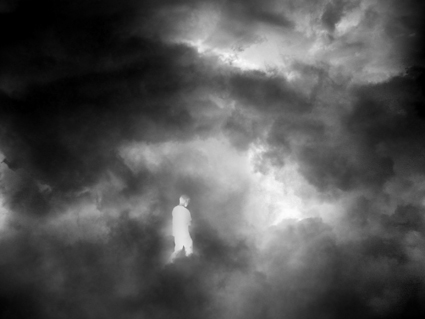
Kurt Hentschlager ZEE Beam In Thine Own Eye – Dark Mofo 2013, MONA
image courtesy the artist
Kurt Hentschlager ZEE Beam In Thine Own Eye – Dark Mofo 2013, MONA
Within a minute of entering Zee, I feel panic rising in me like a wave of nausea and, review or no review, I am out. It is unsurprising given the warnings at the entry, the attendant’s verbal description and the waiver I signed, but still, this artwork has triggered something in me I didn’t know existed.
The work—where the participant is immersed in a theatre-fog-filled environment dominated by strobe light—is by Kurt Hentschlager and is part of Beam in Thine Own Eye (BITOE), a curated exhibition for the Dark Mofo festival. Here, installations by 15 artists are selected to affect rather than for effect.
Originally biblical (Matthew 7:3), the show’s title is reinterpreted by David Walsh and his curators to evoke the real and flawed self, shining from within—the mind’s eye. My newfound fear—garden-variety claustrophobia or not—seems to be a resident within this internal reality.
Ivana Frank’s We Close Our Eyes and See a Flock of Birds draws me back to lengthy childhood hours exploring the space behind my eyes. Here, up to five people are admitted to a small cylindrical space. We sit facing the curved inner wall, its surface studded with LEDs. With eyes closed, the combinations of flashes across this wrapping grid offer up a continuous light show behind our lids. Colours change, patterns emerge and condense, clear imagery is elusive. I do not see birds, but others note glimpses. Each observation is slightly different.
Introducing this effect more gently, Anish Kapoor’s Imagined Monochrome is a calm treat. I book days ahead for my 20-minute massage ‘by’ this celebrity artist. Under his written instruction, a trained masseuse works my arms, neck and head while I lie with eyes closed in a white room under a bright light. Some minutes in, it is as though I shift into another visual space where bright colours flash, coloured orbs pulse. I am once again that childhood explorer, but unlike in Frank’s piece, here I have time to ponder what Kapoor describes as “the prisoner’s cinema.” At the end, eyes covered by the masseuse, I ‘see’ a field of blue and experience a sense of resolution as though this entire performative work were structured in order to allow me to access this unambiguous ‘other’ space.
Across Sullivan Cove, Sound to Light is a collection of collaborative outcomes installed and performed within the upper floors of the Salamanca Arts Centre. It has a decidedly underground feel when compared to its big cousin BITOE. The opening night is a crowded, slightly chaotic experience where it is easy to miss key performative moments while lost in the maze of exhibition rooms, but several works remained installed afterward. Composer Dylan Sheridan and artist Laura Hindmarsh’s Between Attraction and Monstration is a quiet, delicate piece best experienced alone. As I stand within a semicircle of tall, narrow, paper screens, light and film projection shift between moments of collaged film imagery and my own flickering shadow. I feel like a fragment of early, experimental film.
Equally enjoyed alone, The Geometry of Innocent Flesh on the Bone is a collaboration between artist Oscar Ferreiro and composer Heath Brown where robotic devices are strapped to sections of bone, mounted to the back of a plywood ‘animal.’ Surface mikes on the robotics feed sound back into the work composed by Brown. Deep, regular pulses within the composition, layered against the irregular, robotic squeaks of the devices, create the illusion that I share a lair with sleeping beasts.
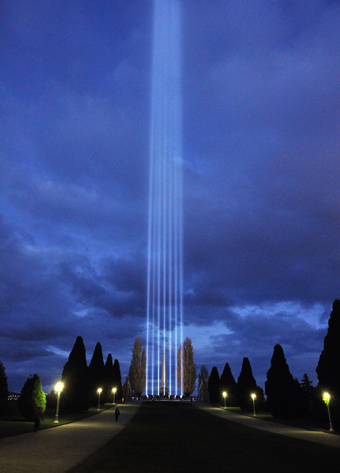
Ryoji Ikeda, spectra tasmania, photo Rémi Chauvin
image Courtesy MONA
Ryoji Ikeda, spectra tasmania, photo Rémi Chauvin
Breaking apart the closed space of other Dark Mofo works, Ryoji Ikeda’s spectra affects the entire Greater Hobart population. Located at the Cenotaph, the public artwork is formed from a grid of 49 powerful xenon searchlights directed to the heavens. From sunset the work builds in strength to the point where lights beam 15kms into the night sky and the distinctive ‘ping’ within the accompanying digital soundscape seeps into homes across the city. This is an undeniably sublime artwork from a distance, but best experienced up close. Rugged up against the wind and rain, hundreds of people stand in and around the work gazing skywards. I visit on the opening and subsequent nights and the shared reaction is one of quiet delight, as people explore this ephemeral cathedral. It is at its most magnificent in driving rain, when the texture of each raindrop is illuminated and night rainbows form along the column of light. Social media feeds repeat the plaintive “I will miss you spectra” in the days after its closing.
With plentiful night hours, winter is the perfect time for works like these. It is almost as though the dark cavern that is MONA has elastically stretched to encapsulate all of Hobart, such that we encounter art at every turn and works with light create shifts in our internal and external realities. While many works are affecting, I am certain the apocalyptic beam of spectra will be the visual and spatial memory that stays with us all as a collective index for this first Dark Mofo festival.
MONA, Events Tasmania, Hobart City Council: Dark Mofo, Hobart, 13-23 June
RealTime issue #116 Aug-Sept 2013 pg. 26
© Judith Abell; for permission to reproduce apply to realtime@realtimearts.net
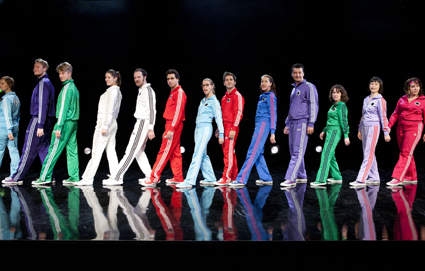
Nature Theater of Oklahoma, Life and Times 1-4
photo Anna Stocher/Burgtheater Wien
Nature Theater of Oklahoma, Life and Times 1-4
I spoke with Pavol Liska and Kelly Copper, the Artistic Directors of Nature Theater of Oklahoma, ahead of their Melbourne International Arts Festival season of Life and Times: Episodes 1-4. An epic 10-hour performance that narrates the life story of Kristin Worrall, one of the company members, Life and Times will eventually have 10 episodes with a combined running time of 24 hours.
The company’s earlier work No Dice, presented at the Sydney Festival in 2009, was an astonishingly inventive four-hour musing on storytelling constructed from recorded phone conversations.
Why try and cover the entire life of a person?
PL Remembering No Dice (see RT89), the question is ‘can you tell me a story?’ You know, any story. So that show became about the failure to tell a story, and then in the process of failing to tell a story, we told many different stories. And we wanted to do a story that is a life story: somebody’s—a person’s story. So I called Kristin and I didn’t expect that she would talk, ah, for so long. I expected that she would tell me her life story in maybe a couple of hours, but at the end of the first phone call she was at age eight, so I had to call again. At the end of the second phone call she was at age 14, etcetera etcetera until she was at age 34, I believe. And so, the attention that she took, and the gift that she gave us, we thought that it deserved an epic treatment. It felt like a goldmine, and it felt like—why keep looking further? Why keep trying to find another text for another show when we have this and we can just dig down in it and stay inside it. For a long time.
Do you treat each episode differently in terms of performance style?
PL Well, Episode 1 is an opera/musical, depending on where you are and what you feel, like, is more, more glorified. Episode 2, it’s an exploration of dance to me. And Episodes 3 and 4 are done in the shape of a murder mystery.
Why a murder mystery?
PL We go into rehearsal with a problem—how do we turn this material into theatre? What does this material really want? And we throw many different ideas at it, until one of them really sticks. Like, the genre of murder mystery felt the most appropriate to this age and the ideas that it expressed. There is lot of confessional, you know; you start to experience religious inklings, the world gets out of joint. And the genre of murder mystery is always about a world that’s out of joint, that it tries to put back together somehow. Our sincere hope is that people see beyond the genre, beyond the parody. We really work hard to get past it, even though we really also work hard to put the genre in the foreground. To orient the audience. You always have to turn the material and open it up. We do a barbeque between Episodes 1 and 2.
KC The actors cook.
PL And we serve dessert between Episodes 2 and 3. So it’s continuous, you know, we have not been slack. The actors get out of Episode 1 and then go straight to the grills and start grilling, and then everybody goes around the building and gets their hamburgers.
KC We do like to keep the audience close to it.
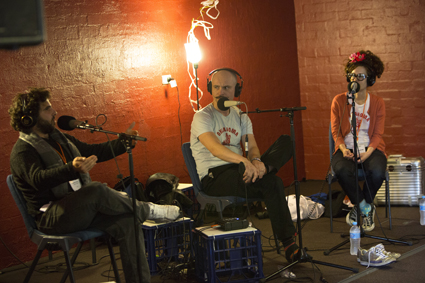
Nature Theatre of Oklahoma at the Australian Theatre Forum
photo Penny Bradfield
Nature Theatre of Oklahoma at the Australian Theatre Forum
PL I want to create more time with people. It’s a necessity. When people ask me “why is the show so long?,” I say, “It’s too short.” What is it, 10 hours with a human being? It’s not that long. And I want to keep extending it so that we get something out of it, we get to know each other, and we have some kind of, you know, revelation. Something unexpected happens. And it’s hard to make something unexpected happen when you just do a show, when I’m performing, when I’m being a dancing monkey for you. What generally happens is that after five or six hours of being together you stop seeing me as your dancing monkey. You have to take your own responsibility. Do you have endurance? Do you have it in you? Have you prepared for this? In my experience the audience prepares, and they know that it is going to be long and there’s nobody really saying, “Oh I’ll just check it out for the first hour and see what happens.”
Nature Theater of Oklahoma, Life and Times: Episodes 1-4, Arts Centre, Melbourne International Arts Festival, 23-26 October
See also Jane McKernan’s review of Rambo Solo (2010); and Keith Gallasch’s account of No Dice (2009)
RealTime issue #116 Aug-Sept 2013 pg. 27
© David Williams; for permission to reproduce apply to realtime@realtimearts.net
TippingPoint brings artists, scientists, curators and environmentalists together to encourage creative collaborations exploring climate change and culture. At TippingPoint Sydney 2010 there was a sense of urgency about the effects of dangerous climate change, but there was also a sense of optimism. At TippingPoint Canberra 2013 there was still that urgency, accompanied by a more pessimistic view of the future.
The day began with a welcome to country from Aunty Agnes of the Ngunnawal people. Significantly she ended with the words, “You are welcome to leave your footprint on our land.” Next was a conversation between futurist Kristin Alford and anthropologist Lenore Manderson. In her research Manderson had encountered displaced people in the Solomon Islands who say, “Now I live here,” because their traditional atoll home is under water. She posed the question, “How do we make the future as real and as tangible as now?” Alford pointed out that Canadian astronaut Chris Hadfield, who recently sent many photos of Earth back from space, had had a powerful effect on peoples’ perception of the planet. She asked us, “What is a radical change that you can make?”
Former CSIRO scientist Graeme Pearman outlined in graphic detail the bad news for humans and other species, illustrating his talk with climate graphs and images of endangered animals. Some scientists argue we have entered a new geological era called the Anthropocene: an informal geologic chronological term that marks a point in time when human activities are having a significant impact on the Earth’s ecosystems. In regard to climate sceptics, Pearman ended his presentation with a quotation from John F Kennedy: “The great enemy of the truth is very often not the lie; deliberate, contrived and dishonest, but the myth: persistent, persuasive, and unrealistic. Belief in myths allows the comfort of opinion without the discomfort of thought.”
Christine Milne, leader of the Greens, delivered a very passionate speech inviting artists to make the emotive artworks that will create a paradigm shift in the minds of the public. She said that the Greens had run their climate campaign on rational argument and scientific facts and they had failed. Therefore it is time to engage with emotions, re-empower people and rethink the way we live on our home, planet Earth. Wow! If only she was this animated when appearing on TV! Imagination is the key resource of this century, she said.
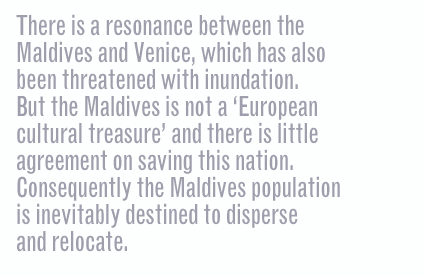 Eight artists presented their imaginary projects for the not too distant future; 2033. Performance director Nigel Jamieson, whose As the World Tipped—an impressive aerial show in Hyde Park for the 2012 Sydney Festival—was created in reaction to the Copenhagen Climate Change conference, presented an image in which future monsoons and floods in Asia result in hundreds of millions of boat people coming to Australia. Playwright Hannie Rayson took this idea further, talking about naval-like flotillas of people heading for Australia in 2033, resulting in our fighting a war to defend ourselves and ultimately losing. Australia, now Java Granda, is divided between African, Indian, Chinese and Indonesian territories, with the Republic of Australia holding on to Tasmania and a section of Victoria. Rayson proposed to create an exhibition, Birds of Passage, in the Melbourne Exhibition Centre, exploring bird and human migration [with 129 exhibits showing bird flights between the 129 nations of the Earth as trajectories for better cultural communication. Eds].
Eight artists presented their imaginary projects for the not too distant future; 2033. Performance director Nigel Jamieson, whose As the World Tipped—an impressive aerial show in Hyde Park for the 2012 Sydney Festival—was created in reaction to the Copenhagen Climate Change conference, presented an image in which future monsoons and floods in Asia result in hundreds of millions of boat people coming to Australia. Playwright Hannie Rayson took this idea further, talking about naval-like flotillas of people heading for Australia in 2033, resulting in our fighting a war to defend ourselves and ultimately losing. Australia, now Java Granda, is divided between African, Indian, Chinese and Indonesian territories, with the Republic of Australia holding on to Tasmania and a section of Victoria. Rayson proposed to create an exhibition, Birds of Passage, in the Melbourne Exhibition Centre, exploring bird and human migration [with 129 exhibits showing bird flights between the 129 nations of the Earth as trajectories for better cultural communication. Eds].
Not all of the artists outlined dystopian futures. Ross Ganf predicted that we will all join the Scouts and save the planet. An artist with a positive outlook was opera singer and producer Deborah Cheetham, a Yorta Yorta woman who believes that the visual and performing arts are the most powerful way by which we may know the world and give meaning to everything in it. She said that we should look at the situation through an Indigenous lens to create and dream and save the planet. This statement sparked some interesting conversations later about what it really means to see the world through an Indigenous lens.
The next part of the event was run as Open Space: a self-organising conference where participants write their own topics for group discussion. Open Space is guided by the “law of two feet.” People can choose to be bees (pollinators of ideas), giraffes (looking over shoulders of groups) or butterflies (looking beautiful and hanging out at the tea urn). Some sessions proposed by participants were: How do we deal with green wash? Why is dystopia sexier that utopia? How can artists work to reimagine the future? Should natural ecosystems have legal rights? How can we bring down the coal industry?
There were only three of us at the latter discussion, but by this time of the day it was exactly what I felt like talking about. Scientists have been quite clear in communicating the dangers of burning the huge coal reserves in places like the Galilee Basin in Queensland. Even if Australia does embrace sustainable energy practices for our own needs, if we continue to send vast amounts of coal to Asia we are dooming ourselves to a dangerously warming world.
Perhaps the fundamental question for TippingPoint was, can the visual and performing arts communicate the urgency of the situation to change people’s behaviour? As a visual artist I feel the medium is extremely powerful, and there are endless examples of effective political work. However the mainstream visual art world is mostly conservative and market driven. Exhibitions that explore climate change are either given bad reviews or ignored completely. The performing arts are often more radical. Recently I saw the performance Birds with Skymirrors by MAU dance company from New Zealand at Carriageworks, exploring the damage to island nations of the Pacific, especially Kiribati (RT115). It is an enigmatic work delving into dark ecologies.
This year the art collective Chamber of Public Secrets, co-curators of Manifesta 8, is curating the Maldives Pavilion in the Venice Biennale with an ecological focus. The title of the Pavilion is Portable Nation: Disappearance as work in progress—approaches to Ecological Romanticism. There is a resonance between the Maldives and Venice, which has also been threatened with inundation. But the Maldives is not a ‘European cultural treasure’ and there is little agreement on saving this nation. Consequently the Maldives population is inevitably destined to disperse and relocate.
Of course, it is desperate times already for those island nations. Do we wait for desperate times to directly affect our lives before we do something? And do we continue to kowtow to the prevailing postmodernist status quo that visual art shouldn’t take an activist stance?
The 2013 TippingPoint Forum, producer, facilitator and TippingPoint Australia Director Angharad Wynne-Jones; co-presented by TippingPoint Australia, Australian Performing Arts Centres Association and Theatre Network Victoria; supported by the Dara Foundation, The Canberra Theatre Centre and the Centenary of Canberra; Canberra Theatre Centre, 29 May
RealTime issue #116 Aug-Sept 2013 pg. 30
© Josephine Starrs; for permission to reproduce apply to realtime@realtimearts.net
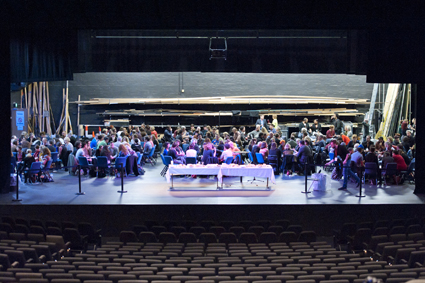
Australian Theatre Forum 2013
photo Angie To
Australian Theatre Forum 2013
The third Australian Theatre Forum was held in Canberra in May. Over 300 of us gathered on the cavernous stage of the Canberra Theatre Centre to be sung into the mood for discussion and exchange by Robyn Archer, who reminded us, via Brecht, that for this bleak existence mankind is never undemanding enough. A sobering prelude to curator Alicia Talbot’s forum question: what is not possible?
Unlike the previous two forums, this one eschewed the open space approach, by which we the people create the event’s agenda, and instead opted for the more conventional conference mix of keynotes, panels and break-outs. This provided both the advantages and disadvantages of the package tour. On the one hand, it guided me towards sessions that I might otherwise have skipped as being marginal to my interests. I would not have normally chosen to listen to an account of setting up a chain of Vietnamese restaurants, but Nahji Chu’s session brought home to me how little we theatre professionals have innovated when it comes to thinking about our business models. On the other hand, I found myself trapped in other unproductive sessions where I longed for the permission to get up and move to another. For example, the keynote by the Nature Theater of Oklahoma began promisingly but its invitation for us to consider the value of theatre soon descended into an ugly display of name-calling among the audience and in the context, to leave was to ‘walk out.’
The session on rehearsing the future by Lenore Manderson and Kristin Alford reminded us that there is little point in trying to predict the future—better to accept that it will probably come at us from the angle we least expect, and to develop our resilience to respond to the unimagined.
As an example of this randomness in our destinies, David Milroy told us in his keynote that he first got into theatre when he was called in to replace an actor who had dropped out on winning the lottery. Milroy went on to invite us all to imagine an Australia where white people are the Others, their rights and choices determined by the research done on their culture by Aboriginal people, who would then benignly champion the whites’ cause and tell their stories for them. We Others got the point, and there was a unanimous vote at the end of the forum for the development of best practice standards in the creation of Indigenous theatre.
The forum program included a series of tours to various Canberra institutions engaged in collaborations with artists, and I chose the trip to the CSIRO, that one-time exemplar of nation building through research and development. What artist doesn’t have a lurking envy of the quantifiabilities of science, its brick-on-brick accumulation of verified knowledge? On the gum-treed slopes of Black Mountain, we peered at insect collections, smelt the formaldehyde and even pressed our noses to the window of a workroom housing a genuine, lab-coated scientist.
A later break-out session asked what contribution regional theatre made to the development of contemporary practice. A special connection with local communities was cited, but, as Suellen Maunder pointed out, why are regional theatres expected to identify their communities yet metropolitan theatres aren’t? Maybe because the city folk can see only markets.
There were two sessions where we got to hear from Majors: first the major theatre companies, then the major festivals. We Minors sat and listened and then were allowed to ask a few questions. But as Wesley Enoch said, the truth is the major companies are not the ecology—they are places in the ecology with a particular role, which, for him, was making works of scale. A good point: that’s what they do well and should stick to. It’s been a positive development that the larger companies have stopped setting up their own ‘cutting edge’ playgrounds, and are now supporting the existing smaller companies who do developmental work so much better (see John Bailey’s report on MTC’s NEON).
The festivals session was illuminating. Some of the artistic directors couldn’t articulate their role beyond being taste-masters who distinguish good from bad art. They should fear for their jobs—Google’s working on an algorithm to do that. Others (mostly female, mostly local) talked about the multiple things that festivals can be for both artists and communities. Robyn Archer saw single focus festivals being the future, while Edwina Lunn spoke of how festivals need to show work that is important now, in this particular time and place, even if it is still quite raw. Jo Duffy stressed the need to ‘wring the juice’ out of visiting artists by plunging them into contact with local artists. The commitment of the smaller festivals to their communities was salutary, and puts in relief the tired thinking that makes larger festivals indistinguishable from each other.
Tony Grybowski, the new Australia Council CEO, looking as nervous as a nice boy on his first date, talked to us about where the Council was heading and what it would do with its new money in the first year. He said there would be no surprises, which, given the many changes, was a surprise.
Ria Sulistyani from Papermoon Puppet Theatre in Yogyakarta told us how she developed her idiosyncratic contemporary style through Google—looking at what others had done and adapting it to her needs. And she gave us a taste of the tensions she experienced when creating a work based on the events of 1965, that dark period in Indonesia’s past when thousands were killed.
The forum ended with a series of post cards, provocations and small group discussions. The event shared a day with the TippingPoint Australia gathering, and its convenor Angharad Wynne-Jones challenged us to come up with things we would do differently to cope with climate change. While her call was to us personally as citizens, it reminded me that the theatre artist’s social duty had been a recurring theme throughout the three days. David Milroy had said that his burning passion was not for theatre but for what theatre could do. How much can theatre do? Robyn Archer evoked Brecht at the opening, yet The Threepenny Opera didn’t stop Weimar Germany going into the abyss. This doesn’t make the work a failure—it is still doing its satirical work long after its original targets are gone. One answer to Alicia Talbot’s challenging question might therefore be: it is not possible to know if our work will make a difference, but we make it anyway.
Australian Theatre Forum 2013, curator Alicia Talbot, Canberra Theatre Centre, 29-31 May
RealTime issue #116 Aug-Sept 2013 pg. 31
© John Baylis; for permission to reproduce apply to realtime@realtimearts.net
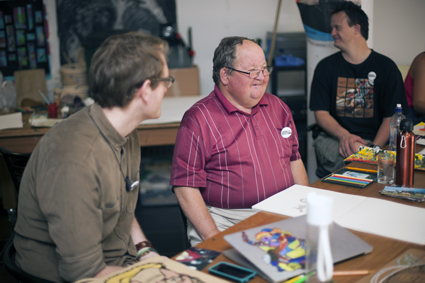
Jeff McCann, Wayne Emerson, Scott Lea, 8 Artists, Eastern Riverina Arts
photo Christopher Orchard
Jeff McCann, Wayne Emerson, Scott Lea, 8 Artists, Eastern Riverina Arts
Continuing our series on innovative arts ventures in Wagga Wagga and surrounding regions, here we look into the activities of the peak advocacy and support body in the area, Eastern Riverina Arts (ERA). I spoke with Scott Howie, Regional Arts Development Officer and practising artist.
Previously an English, Drama and Media teacher in Canberra, Howie moved to Wagga in 1999 to study Film and Television at Charles Sturt University. Dissatisfied with the technological barriers placed between him and actors/audiences in the broadcast medium, he created performance works exploring modes of interactivity, forming his own company Jibshot.
Of the opportunities at the time Howie says, “Things were cheap, people were encouraging. There was a professional theatre company that was interested in working with me as someone doing young and emerging work beyond what they were programming…It was kind of low risk financially. You could afford to experiment. If it didn’t work you weren’t going to lose a huge artistic reputation. We’re talking maybe 12 years ago—regional activity was quite low and it was easy to stand up and say, ‘Hey, I’m somebody who’s practising regionally.’ And it was quite easy to get some funding. It’s much more competitive now that the level of regional activity has just exploded.”
Generating projects, connecting people
Howie suggests this explosion of activity results in part from artists moving to or remaining in the area in order to feel “more connected to the landscape, more connected to community. And certainly for me it’s about that. It’s about having time and space for contemplation.” It’s also due to people like Howie and the activities of organisations like Eastern Riverina Arts. There are in fact 14 Regional Arts Development Organisations (RADOs) in NSW that are triennially funded by Arts NSW and from local council contributions.
Howie describes the role of Eastern Riverina Arts: “We’re about arts and cultural development so we generate projects across the region, promote what’s going on and run training workshops. The whole notion for me is about how we connect people. We’re brokering relationships, whether that’s assisting the local conservatorium of music to tour its work throughout our region to the smaller towns; or bringing in a company like Monkey Baa to tour our smaller volunteer presenter networks; or a big project we’ve just finished—an arts and disability exhibition at the art gallery…And always trying to find opportunities to employ artists at a professional level in a professional manner.”
In the gallery, on the road
The last project to which Howie refers was titled 8 artists and involved extended studio collaboration between four pairings—artists with and without disabilities—culminating in an exhibition at the Wagga Wagga Regional Gallery. The works by Wayne Emerson with Jeff McCann, Angela Coombs Matthews with Kellie Hulm, Vic McEwan with Scott Lea and Jacqui Meyers with Julia Davies included mixed media, painting, mosaic and video installation. (The beautifully produced catalogue is available for download at http://8artists.net/.)
A playful, smaller scale project, Car Boot Gallery, saw Howie touring to 10 local council areas exhibiting works commissioned from artists, one from each area, out of the back of his car. Howie says, “It provided a survey of the range of artistic practice in the area from [artists] with professional exhibition experience to young emerging artists. It’s great for us to get out there and meet the artists so that they know what we’re doing.”
On the performance front, Eastern Riverina Arts is co-ordinating the Short & Sweet Play Festival which has received funding to roll out in regional areas. Local playwrights and actors will be working out of the Cootamundra Arts Centre, an old carriageworks donated by the council to a local volunteer group who have converted it into a 120-seat theatre and exhibition space. ERA is also running a two-year hip-hop dance program with young people across six towns resulting in a series of dance films that will tour the region. The organisation has also just assisted the artists Greg Pritchard and collaborative husband and wife duo The Ronalds in a streaming broadcast project that was part of Underbelly on Cockatoo Island in Sydney.
Speaking up for art
As well as administering a small funding program on behalf of Regional Arts NSW, Eastern Riverina Arts also plays a vital advocacy role in the region. Scott Howie cites a recent example where the Wagga Wagga City Council developed an ambitious public art program including two $60,000 commissions for works sited at the airport. Howie says, “Of course in tight financial situations a lot of people would question the value of that. So we jump into that debate and talk about what it actually costs and what artists actually do.” ERA will shortly be running a one-day conference on public art and art trails, bringing leading Indigenous artist Fiona Foley, who has created a number of significant public art works, from Queensland as guest speaker.
Challenges & resonances
Activity in the region has increased dramatically over the time that Howie has lived in the area. There are now a number of organisations and groups producing contemporary work attracting national attention, such as The Cad Factory (Vic and Sarah McEwan, see RT115), Wired Lab (Sarah Last and David Burraston), White Box Theatre (Kim Hardwick and Martin Kinnane) and The Ronalds (Patrick and Shannon Ronald). However funding is still somewhat limited. Howie ponders, “How many more artists and arts organisations can we sustain at this level? When you carve up the pie who else are we going to be able to support? How’s anyone else going to be able to bubble up?”
Howie also fears that the techno-utopia promised by the National Broadband Network may not fully eventuate. “I do think we’re still going to have a two-speed digital economy. We are going to have lower upload speeds than metro cities…The challenge for us regionally is how we put things in place that allow us to send stuff out. Do we need to have some digital streaming studios that are portable? A lot of the work that happens that’s interesting in our region is site-specific. How do we ensure that we’ve got technology available [for that]?”
The other challenge Howie sees is the lack of critique. “It’s tricky to get people out here to look at the work. Unless you really want to focus on promoting what you’re doing to the metros it’s really hard to even be noticed. So we need to raise that culture of not being afraid to critique the work that’s going on here—and to seek that.” Which is where RealTime comes in. As part of our regional focus, RealTime managing editors Keith Gallasch and Virginia Baxter will be conducting a series of writing workshops in the region to assist in the development of a robust culture of commentary and critique.
Scott Howie is very positive about developments in the region and particularly in audiences. In a follow-up email he writes, “I think audiences are becoming increasingly open to new experiences, things that re-imagine or reconfigure spaces, that have strong local connections either through space, people or content…Knowledge of the genre/artform/discipline is less important as long as the work resonates within communities.” We look forward to exploring these resonances in our upcoming coverage of Cad Factory’s Sunrice Project and the Wired Lab’s Open Day in coming print and online editions of RealTime.
Eastern Riverina Arts, http://easternriverinaarts.org.au/
RealTime issue #116 Aug-Sept 2013 pg. 32
© Gail Priest; for permission to reproduce apply to realtime@realtimearts.net
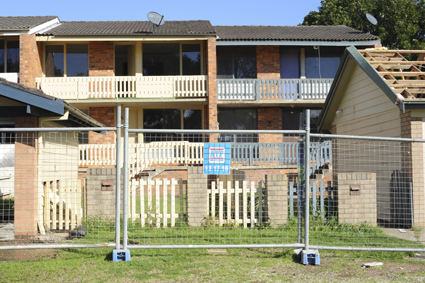
Heathfield Place, Temporary Democracies
photo Heidrun Löhr 2007
Heathfield Place, Temporary Democracies
When Michael Dagostino, director of the indefatigably innovative Campbelltown Arts Centre, approached live art practitioner and curator Paul Gazzola with an idea for a project that would engage with the suburb of Airds in a NSW public housing area that is subject to demolition and re-settlement, Gazzola came up with the title Temporary Democracies.
“People often live in these houses for a short period of time in which they have a democratic right to make them their own. Some have been there for 30 years plus and others for two or three years.” Dagostino explains, “Airds will be transformed—70% of it is going to be knocked down and re-built over the next 10-15 years and a large percentage of the population relocated elsewhere.” Gazzola recalls “looking at these empty houses as offering a great opportunity for artists to be able to work with as sites for setting up installations or for drawing materials from or just as reference points. So, Brian Fuata is working on the foundations of a site that’s already been demolished. Two other artists are working inside the houses, setting up events and installations. Indigenous artist Nicole Foreshew is filming the demolition of a house. When suddenly a house disappears you see more of what used to be there before, she says. We’re temporarily extending the lives of these houses.”
Dagostino says that the project has the support of the NSW Land and Housing Association in order to “to engage the community in a positive way about the changes to Airds, allowing artists to tell the stories of the residents and work directly with them to build up a rapport.” Gazzola points out that there is a relocation team acting as middleman between the government department and the community, softening the impact of the relocation: “they’re involving local people in re-generation of old ideas of renewal. They hold the Airds Out Loud event four times a year for the community to discuss the design program. ‘What would you like? Where should roads and infrastructure change?’ The team seem to have tried their best to connect with the people rather than delivering a potentially top-down strategy.”
At the end of last year at one of the Airds Out Loud events. Gazzola, artsworker and writer Rebecca Conroy and artist Robert Guth mingled with locals they’d met previously when discussing the Airds project with artists and the community. “It’s like constantly announcing yourself, about being there.” Dagostino concurs, “This project is one of a number in which we have a long-term relationship with the community. It’s not a fly-in-fly-out kind of attitude. And that’s important for all the projects that we do. The first time we go in we are these strange aliens but the next time we go in things become more familiar, the community knows who we are; the next time we become part of the community. That’s critical.”
“It’s always been proposed as a two-year project,” says Gazzola, “This is really the starting phase about how to work in these houses, how to make it all operate, get the people on side.” Campbelltown Arts Centre’s success with community related projects has been evident in projects directed by Rosie Dennis—Driven to New Pastures (2010), Life As We Know It (2011), where senior citizens from the area appeared onstage, and especially Minto:SiteLab and Minto:Live 2011 which featured artists-in-residence in the local shopping centre and library.
For Temporary Democracies, Gazzola selected 12 artists in 2012 to visit the site. “I introduced them to the people running the relocations team and community groups. We discussed the Radburn Principle—the US architectural plan taken up in Australia where the houses were built with their backyards facing the roads; the cul-de-sacs and the front of the houses had big open spaces where people could communicate across these green corridors. But locals and the Housing Association saw it as a failed architectural plan that produced easy disappearance routes for thievery and drug dealing. You look at the houses, you really do enter through kitchens as front door entrances.”
New Zealand artist David Cross, says Gazzola, “has picked up on the idea of the house itself as an object and the Radburn flipping of entrance and exit. After Radburn, the Housing Department tried to ‘turn the houses around,’ putting more windows on the street side and putting the backdoor as the front door. David’s proposed that you walk up the stairs and then slide down a chute out of the back door! This follows on from the games he plays with inflatables that are very much short, immediate engagements with a re-shifting of your perspective.
“Elizabeth Woods is working on a table tennis project, it’s got its big ideas but people playing games together is an easy way in. Tanya Schultz from WA who works with Pip and Pop [partner Nicole Andrijevic] makes beautiful installations from [brightly dyed] sugar, a bit like the mandalas. I thought of having something that was really beautiful in an area with a lot of destruction but beauty all around it. It’s insanely beautiful. You drive in through an incredible green corridor and it’s treed and right on the edge of the river. Tanya’s talking to communities, asking them to build little objects, photographing them and making wallpaper to be installed in one of the houses.”
Canberra-based artist Robert Guth’s works are about cooking food as a social act. He’s bought a pop-top caravan which he’s re-building with the Airds/Bradbury Men’s Shed group, converting it into a community cooking trailer for ongoing use. That’ll be on the project site. We’re putting something back into the community that’s functional—art doesn’t have to be about an aesthetic relationship.”
Paul Gazzola says that he constantly wonders, “what’s the most relevant approach. What makes sense? It can’t be layering some high-end art speak over the top. That’s just going to disappear into the ether and be irrelevant for the community.” He adds, “The project might be titled Temporary Democracies, but the legacy won’t be temporary.”
To provide continuity and perspective, Gazzola approached Rebecca Conroy “to come on board to develop a website to contextualise the project from a more global perspective.” You can read Conroy’s first essay and other material on the project website. Gazzola is emphatic, “We’re not just pointing at Airds as a little local entity that doesn’t really have any relationship to anywhere else.”
Paul Gazzola promises an intriguing experience if you visit Temporary Democracies on the 16th and especially the 17th of August when all the works will be operational against a background of cranes and earthmovers as Airds transforms from one temporary democracy into another.
–
Campbelltown Arts Centre, Contemporary Democracies, curator Paul Gazzola, artists Lachlan Anthony (VIC), Darren Bell (NSW), Rebecca Conroy (NSW), David Cross (NZ), Benjamin Forster (WA), Nicole Foreshew (NSW), Brian Fuata (NSW), Robert Guth (ACT), Nakkiah Lui (NSW), Bennet Miller (WA), Kate Mitchell (NSW), Tanya Schultz (WA), Elizabeth Woods (QLD); 13-17 Aug; Heathfield Place, Airds, NSW, www.temporarydemocracies.com, www.campbelltown.nsw.gov.au/LiveA
RealTime issue #116 Aug-Sept 2013 pg. 32
© Keith Gallasch; for permission to reproduce apply to realtime@realtimearts.net
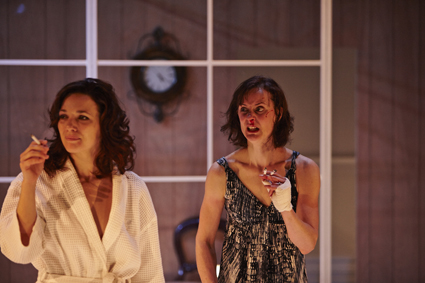
Meredith Penman, Karen Sibbing, Persona, Fraught Outfit & Belvoir
photo Ellis Parrinder
Meredith Penman, Karen Sibbing, Persona, Fraught Outfit & Belvoir
There are nights when it is impossible to mingle in the foyer after seeing a play, chatting about the experience or avoiding it altogether, casually reconnecting with the everyday as if nothing had happened. With Angels in America, The Maids and Persona, something had happened—to me.
The cleansing of fear and pity that is supposed to be ‘Catharsis’ doesn’t quite explain the traumatic impact of some performances. There’s a kind of numbness, an inner silence (not as radical as the one that besets Elisabeth in Persona, but related to it) making it difficult to offer coherent observations. Best go home to a glass of dark red wine, stillness…and silence.
In these three productions, actors and directors conspire to realise performances that take us to emotional limits and beyond to a kind of exhaustion, so much having been demanded that I sense the endurance suffered equally by the actors and their characters.
In Persona the fragile identities of two women (one would love to be the other’s sibling) dangerously overlap. In The Maids two sisters are fatally trapped in a class-imposed identity and a fantasy of revolt; and in Angels in America two men are enveloped by a disease and the politics that attempts to deny and define it; though they never meet they are protagonist and antagonist.
Belvoir and Fraught Outfit, Persona
From the beginning, Persona is sparely paced, words carefully articulated, images pronounced and few: a quietly realistic world in which a nurse, Alma (Karen Sibbing) cares for an actress, Elisabeth Vogler (Meredith Penman) who, having momentarily fallen silent in a performance of Elektra, is now completely speechless, if showing few other signs of illness. Save for a moment when the nurse, panicky about the assertiveness of her patient, rather brutally sedates her, the relationship seems initially simple.
Later in a summer cottage, having volubly and frankly revealed herself in the face of her patient’s silence and beginning to feel that she loves Elisabeth, the nurse finds her confidences betrayed and that she is merely regarded as “useful.” Alma becomes successively angry and violent. The quivering and quaking extremity of the descent Sibbing so powerfully embodies is counterpointed by Penman’s physical restraint. Alma doesn’t see the small signs of her patient’s watchfulness and disapproval.
The power of Persona first resides in its scenario: one person’s illness opens up one in another, a kind of transference in which the nurse, like her patient before her, loses her social mask. However, if we’re uncertain that Elisabeth is actually mentally ill, we come to co-inhabit Alma’s hallucinatory illness when the curtains part, in a Bergman-esque moment, to reveal the cottage surreally stripped back—furnished only with a large Victorian wall clock and a heavy Victorian chair. In a remarkable night-time scene Alma has sex with Elisabeth’s husband (who thinks she is Elisabeth) as the wife, naked, looks on. What’s striking about this scene is not just the abject trousers-around-the ankles grittiness, but the moment when we see Alma decide that she will, vengefully ‘adopt the mask’ and play the wife. Sibbing reveals an astonishing range of behaviour and states of being, from shy nervousness to raging anger, ‘nuttiness’ (in a ragged ensemble of clothing), fearful delirium and temporary calm—listing Elisabeth’s failings before descending into her own silence.
Although a very different, much more earthed performance than Bibi Andersson’s as Alma in the film, Sibbing gets the story about an earlier sexual encounter—with two teenage boys and another woman on an otherwise empty beach and in which she orgasms, feeling real for the very first time—just right. There’s an innocence, shyness and honesty about the telling with just of touch of pleasure—a reminder of Bergman’s account of being astonished at the sense of “shameful lust” with which Andersson realised the lines.
Far superior to Simon Stone and Andrew Upton’s cumbersome version of Bergman’s Face to Face (RT110, 44), Persona’s spareness and its careful re-ordering of material (we learn very early on of the likely causes of Elisabeth’s illness) make for a lucid account. And, unlike Bergman, Adena Jacobs has not cast look-alike actors, instead amplifying the sense of discrete personalities ill-fittingly bonded.
But this Persona is not the far more complex work from which it has evolved. It reverses the ending (if offering one that has its own frightening logic) and, problematically, it empties Bergman’s screenplay of its larger psychological context, reducing it to an existential drama otherwise disconnected from the world, in the same way that Simon Stone ‘denatured’ Ibsen’s The Wild Duck of class, property and environmental concerns. In the film Elisabeth has not only lost her sense of herself as actor and mother, but also of the meaning of a world in which a Buddhist monk in Vietnam immolates himself in an act of protest against war (the image flashes before us when Elisabeth suffers a panic attack). She later gazes at a famous photograph of Nazis rounding up people in the Warsaw ghetto—at the centre of which is a boy (underlining Elisabeth’s guilt about not loving her son). I recall when I first saw Persona in the late 1960s, being shocked by the first image, such was its immediacy in the midst of the Vietnam War. There is no such moment in this stage Persona.
This Persona mimics the film’s famous opening but only to the extent of having a boy, around 10 years old, enter the stage, sit and read a book, regard the audience and move his hand in a slow wave ‘across’ us before exiting. In the film there’s the glare of a projector lamp, the flicker of the celluloid gripping, rapid images of a lamb being slaughtered, a penis, a spider, a barely pre-adolescent boy in a hospital bed reading Lermontov’s A Hero of Our Time, then seen in intense close-up and conjuring with a wave of his hand the faces of Elisabeth and Alma, merging them. Presumably Jacobs’ prelude is simply aimed at establishing the existence of the son whom Elisabeth has rejected, while providing a knowing reference to the film. The film is punctured by another such moment when the celluloid appears to burn (some alarmed projectionists in the 60s stopped their projectors, until the spools came labelled with a warning) and the film ‘starts up’ again, this time with Alma’s deranged view of the world. In the play, in her final confrontation with Elisabeth, Alma wheels in a stage light on a stand (presumably imagining that she’s forcing Elisabeth back on stage) to provide a similar disjunction to the film’s.
The stage production otherwise borrows a little from the film, creating instead its own world and motifs in which the line between reality and its other is sparely and clinically signalled by the ebb and flow of large white curtains (also in the film), accompanied by the low rumble of breaking waves and the murmur of wind. It’s a slightly clunky design (looking more convincing in photographs of its end-on Melbourne realisation).
I was moved and disturbed by Jacobs’ Persona, shocked at its ending, not just because it is Jacobs’ not Bergman’s but by the extremity of its realisation of Alma’s decline in Sibbing’s performance—its eruption out of constraint, underlined by Penman’s nuanced restraint as Elisabeth.
Persona haunted me for days after seeing it, but having unleashed memories of the film it left me asking why, in the end, Jacobs and her fellow creators opt to so reduce the scale of Bergman’s vision? As any number of writers about the film have argued, it questions our capacity to face catastrophes (such as we do now, the largest since the 60s) as well as personal crises: do we hide behind our masks or sink into catatonia? The film will continue to haunt me in a way this play may not, but that’s not to say it won’t leave its own haunting traces in the psyche. [I discuss the production’s film references in a long version of this review online.]
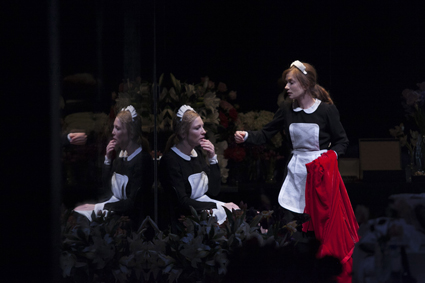
Cate Blanchett, Isabelle Huppert, The Maids, Sydney Theatre Company
photo Lisa Tomasetti
Cate Blanchett, Isabelle Huppert, The Maids, Sydney Theatre Company
STC, The Maids
I felt for Cate Blanchett and Isabelle Huppert at the end of The Maids as I did for Sibbing in particular at the curtain call for Persona—I thought I could see the demands of the performance indelibly written on their bodies.
As with the casting of Jacobs’ Persona, the two women here do not look or sound alike (the sisters they were based on by Genet very much did), but blood, fate and class and a desperate fantasy of vengeance and escape has bound them together. They operate in counterpoint—Claire (Blanchett) tall and elegant when needs be, not at all dissimilar from Mistress (Elisabeth Debicki), their employer, the other, Solange (Huppert) short, energetic, measured. When hyperactively committed to their project to destroy their Mistress, Blanchett’s Claire is a demanding fantasist. Desperately manic when she loses the thread of her performance as the Mistress or her murderous sense of purpose she collapses emotionally and physically, dashing to vomit in the bathroom. When Solange declares, “This is killing us, Claire,” you believe it, and the possibility that Solange will really try to save her sister.
In the hands of the Mistress at the makeup table, praised and patronised, Claire is flutteringly and abjectly fragile (her back is to us but her face caught close-up on the screen). It’s an astonishingly nuanced performance which Blanchett and Benedict Andrews realise as the tragedy of an ordinary life made perverse by servitude.
Huppert’s Solange is the more emotionally consistent of the sisters, more certain of their joint task and finally her own, achieving a kind of victory in which she saves her sister from endless servitude and possibly madness—such is the extremity of Blanchett’s performance and Claire’s final collapse—by killing her. However, her motivation, revealed superbly in the great monologue in which Solange fantasises the public revelation of her deed, is fantasy in the face of actual defeat. Mistress is alive, her gangster husband out of the gaol where Claire’s letter to the police has landed him. Solange’s hubris offers us a sense of tragedy too, if a humble one—she has after all saved her sister at the expense of her own life—in a performance by Huppert that counterpoints Blanchett’s with a calmer energy, comically breaking into ungainly physical exercises, largely controlling the play acting, only momentarily beset with moments of doubt and panic and luxuriating in periods of languor and delight, small details of the great screen actor’s characterisation of Solange caught in innumerable close-ups.
Andrews’ staging of The Maids is not the claustrophobic chamber theatre of many previous productions of the play—this world is agoraphobic, a contemporary wide-open glass-walled penthouse amplifying not only the sisters’ vulnerability and paranoia but also the suspenseful recklessness of their games. In moments of doubt the sisters wonder if they are being watched; is it God? Elsewhere they defiantly flaunt themselves. They are under surveillance, by us the audience. We glimpse cameramen behind the windows; small cameras are installed in the bathroom and on the Mistress’ table. But the sense of intrusiveness is not as effectively or as powerfully realised as it was in Andrews’ The Season at Sarsaparilla and Measure for Measure. The use of verité-style shooting might yield a reality TV ambience but, seeming largely un-choreographed, it creates competition between the stage and very large screen images hovering over it. I’m well used to and like this idiom, but here had to make an early decision to go with the actors (not too hard, I was fairly close to the stage). Nonetheless, the surveillance motif played its emphatic role in underlining the fractured reality of the maids’ lives: Claire becoming Mistress, Solange playing Claire to ‘Mistress,’ reflections multiplying in windows and mirrors and on the screen. Benedict Andrews once again proves that he is Australia’s best stage director, unleashing superb performances in a provocative response to a classic text without spurious infidelities.
The sisters who murdered their mistress in France in the 1930s gouged out the eyes of their mistress and her daughter, as if refusing to ever again ‘be looked down on’ or to be caught by a diminishing gaze. Similarly in Persona, Alma’s hostility to Elisabeth derives from finding that the woman she loves and whose sister she would like to be regards her as merely plain and “useful.” In The Maids the desire to kill the Mistress is ironically counterpointed with a desire to be like her, the double bind evident in the sisters’ abjection, in the face of her condescension, which Debicki plays masterfully. With frightening perspicacity and febrile energy, Blanchett and Huppert render this trap utterly palpable, giving enduring life to Genet’s still haunting vision of the sorry complexity of lives destroyed by power, resonating with our own humiliations and resentments in the problematic order of things.
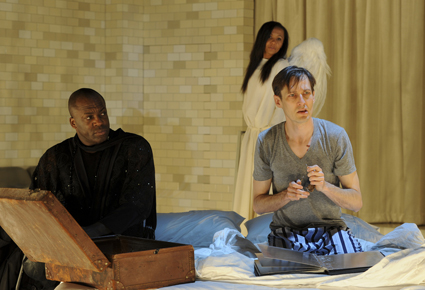
Angels in America, Belvoir
Belvoir, Angels in America
Protagonist and antagonist never appear together in Tony Kushner’s Angels in America. They are the emotionally and politically diametrically opposed Prior Walter (Luke Mullins) and Roy M Cohn (Marcus Graham). We experience their differences as the dynamic that drives this epic “Gay Fantasia on National Themes.” Mullins’ and Graham’s performances are psychologically and physically rich in detail and drive, the best work I’ve seen from each.
This “fantasia” with its nightmares and its angel (a mundanely realised one with small wings standing on a chair but all the more chilling for the painful ambiguity of its message) finally yields a ‘happy’ ending, a sense of hope if with many provisos and lives and love lost. Graham’s Cohn starts out fast and loud, calculatedly unmodulated, crudely logical, the ultimate self-denier, until reality finally takes a grip on him, the fault lines in his psyche cruelly revealed if not fully faced—his fears embodied in projection (the ghost of the alleged spy Ethel Rosenberg he had executed) rather than confession, which is beyond him. Graham invests his Cohn with a pulsing, defiant energy that never quite leaves him, even when succumbing to AIDS-related illnesses and night terrors.
Both men are isolated: the furtively gay Cohn by his own choosing, Prior deserted by a lover (Mitchell Butel) terrified by the symptoms of illness. Both are funny: Cohn coarsely if revealingly so while Prior is a true wit. Cohn’s demonic vulgarity barely dissipates, even in the face of those he has destroyed, but Prior’s humour evaporates with a profound darkening of his spirit in the absence of unconditional love. Together these men represent the tragedy of AIDS and of a nation, embodying hubris, suffering, insight and radical aloneness; it’s an America we know all too well, even more divided now by cruel absolutes.
The dynamic between Prior and Cohn plays out on other levels, in the relationship between Prior and Louis, Cohn’s aide Pitt (Ashley Zukerman) and his wife Harper (Amber McMahon), between Cohn and Pitt and, bridging the two worlds, the dauntingly wise black man Belize (Deobia Oparei—appearing also as the chilling Mr Lies). Fleshing out this world culturally and historically is Robyn Nevin as a Rabbi, a tramp, an ageing Bolshevik and the ghost of Ethel Rosenberg (shades of Thelma Ritter). Alan John’s choice of American iconic music alongside his own also evokes a larger and more present cultural picture. The sense of ensemble playing is tautly consistent as the performers work a largely empty, flexible space bound by huge tiled walls that suggest bathroom, public urinal and hospital in an un-well world. Despite some oddly determined interval breaks that test engagement, Eamon Flack’s lucid production provides relentless momentum and highly articulated characterisations.
The existential crises that dog the characters in Angels in America are induced personally and politically, circumstantially and wilfully, Kushner never letting us forget the big picture, one philosophical and cosmological. It’s a lot to take home, to let settle in the psyche beside Persona and The Maids, to ponder when I eventually rise out of the numbness, that emotional exhaustion and its consonant empathy with the performers of these challenging visions.
A French play, an American play and a variation on a Swedish film: we make these classics ours while we await our own.
Belvoir, Fraught Outfit, Persona, creators Adena Jacobs, Dayna Morrissey, Danny Pettingill, Belvoir Theatre, 26 July-18 Aug; Sydney Theatre Company, The Maids, writer Jean Genet, translation Benedict Andrews, Andrew Upton, Sydney Theatre, 8 June-20 July; Belvoir, Angels in America, writer Tony Kushner, director Eamon Flack, Belvoir Theatre, Sydney, 1 June-27 July
RealTime issue #116 Aug-Sept 2013 pg. 34-35
© Keith Gallasch; for permission to reproduce apply to realtime@realtimearts.net
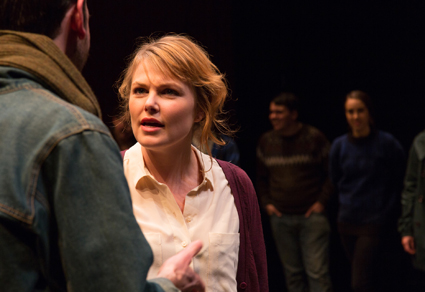
Benedict Hardie, Anne-Louise Sarks, By Their Own Hands, Hayloft
photo Pia Johnson
Benedict Hardie, Anne-Louise Sarks, By Their Own Hands, Hayloft
This year the Melbourne Theatre Company hosted five seasons of work by independent theatre artists and companies under the umbrella title Neon. Three of the women represented were Anne-Louise Sarks, newly appointed Resident Director at Belvoir, and Emma Valente and Kate Davis who are The Rabble.
I am interested in the different trajectories within the industry taken by these women (I talk with Valente and Davis in RT117) and how their feminism is informed by this. Anne-Louise Sarks has, by her own account, ridden the current wave of affirmative action in the theatre industry—not that she hasn’t worked to earn her place. “It did help that management was looking to give women opportunities and I was conscious of what was on offer because of the media attention.” We spoke about how we struggle in society at present to have intelligent and complex conversations about women in leadership positions; the public discourse around Julia Gillard showed this up.
Sarks was introduced to feminism and contemporary performance at Sydney University where she completed Honours in Performance Studies. She was also President of the Sydney University Dramatic Society and ran workshops for women. Her first directing gig was Eve Ensler’sThe Vagina Monologues, a play in which she saw the potential to shift something for an audience. Her motivation to do this work reflected not so much a personal sense of grievance as a feeling for the potential of theatre to change an audience’s perspective on women.
Considering she needed more theatre craft to realise her ideas she decided the VCA offered the most open training for someone like herself interested in making work. A year after graduating she found her way into The Hayloft Project and back into making work. She describes watching director Simon Stone boldly do what he wanted. She learned to be brave from watching his bravura. She describes the Hayloft gang as having been her home base and how forging a path as a solo director has taken her away from this community. In 2011, Sarks held the positions of Associate Artist for Belvoir and Director in Residence at the Malthouse Theatre Company. She made her mainstage debut in 2012, directing Kate Mulvany’s The Seed for Melbourne Theatre Company. She also co-wrote with Kate Mulvany and directed a new production of Medea after Euripides for Belvoir presented in association with ATYP [Australian Theatre for Young People, Sydney] in 2012.
“I have a mission which is not always overt. When I work with existing stories I am updating the work to now. I am interested in how the work speaks to now and very much with how the work speaks to me and to the people I know. That’s where my mission and I collide. Because I am a woman in the world I ask particular questions of the piece, especially of the female characters. That’s how we ended up with By Their Own Hands. It was Jocasta’s story. Medea was the same. I wanted to challenge how people saw those women—or in Jocasta’s case, whether people saw her at all. So my work is feminist but I don’t necessarily sell it in that way. I find that tension really difficult because I am really passionate about being a woman and I want to make work that is feminist. But I don’t want to be separated from the rest of the theatre community by being described as a woman director or as a feminist.
“I believe theatre is unique in the arts. Like all art it’s an exploration of what it is to be human but, unlike most other artforms, that exploration is being undertaken live by everyone in the room at the same time, viewers and performers. When you see a piece of theatre you can’t help but be aware of being in a crowd with other human beings watching other human beings performing stories that are in some sense yours. For me, that means theatre has the potential to shift you. I want to keep pushing back from the stage to the audience. By Their Own Hands (see review) was a large push: ‘What if you stand there and I point at you to make you realise that this story is about you, about us?’ That is celebrating the uniqueness of theatre.”
In this work, the audience is invited onstage by Sarks and Benedict Hardie, her long-time collaborator. Hardie attended Sydney University and then the VCA with Sarks. They both then joined the Hayloft Project and have worked together many times in different roles. (They directed and performed By Their Own Hands; wrote and directed The Nest; and co-devised Yuri Wells which was written and performed by Hardie and directed by Sarks.) They then tell the story of Oedipus, selecting audience members to stand in for the various characters being described. Some take on the roles and some remain as audience while other audience members look on. We then return to our seats and watch the performers set up a series of images that centre on Jocasta’s experience. Finally the pair grab microphones and have a series of poignant and funny conversations as Jocasta (Sarks) and Oedipus (Hardie), delivered stand-up style directly to us.
“Part of my approach stems from the fact that I realised about six years ago that my favourite novelists were men. I then made a conscious effort to read novels by women. The experience really woke me up. I was intrigued by how committed I had been to male novelists, unconsciously devouring these works. And then suddenly, instead of looking in, I was part of those stories. I understand first-hand why this is still so tricky in theatre. Every time a play is produced by women, focusing on women, people ask, “But will this speak to men?” But nobody ever questions whether plays by and about men speak to women—they just assume they’re ‘universal.’ Theatre practitioners can still often discuss work by women as being for a female audience. I realise that to undo this gender bias takes work and deliberate decisions.
“Of course, I also had dealt with the canon in my training at VCA. But I hate ‘history pieces’—doing works as we think they might have been. I fear the audience won’t make the leap. I am a very literal person, not metaphorical. I don’t want the audience to be able to think that’s not about us. This might make people ask, then why work with classics at all? The answer is I like having a beginning point with an audience, to start in the middle of a conversation. It feels that more is then possible.”
RealTime issue #116 Aug-Sept 2013 pg. 36
© Anne Thompson; for permission to reproduce apply to realtime@realtimearts.net
“Q. How many feminists does it take to change a lightbulb? A. That’s not funny!” With this joke, curator Laura Castagnini presents the stereotype she wants to challenge in the exhibition BACKFLIP: Feminism and Humour in Contemporary Art. The four short performance pieces reviewed here were presented at the Margaret Lawrence Gallery on the closing night of the exhibition: a theatrical dialogue, a dance work, a performance lecture and a drag performance.
Castagnini may have done too good a job, because the broadness of BACKFLIP reveals the absurdity of the cliché. It is not that humorous feminist art is a rare beast, quite the contrary: both feminist and humorous contemporary art are huge, overlapping categories, and BACKFLIP amasses a great deal of art without ever quite answering the implicit question: as opposed to what? Without a clear distinction between art about women or gender and feminist art, or specifying the brand of humour on display, the performance pieces had therefore a sort of cataloguing purpose. I did not recognise a unifying theme in the evening, but a lot of ground was covered, resulting in a broad compilation of themes and styles.
The four performance pieces were diverse. What united them the most was possibly unintentional: a certain existential anxiety, an underlying forcefulness, as if coming from a struggle to be seen and heard. The works seemed largely stuck halfway between articulating a statement and merely articulating an existential claim: we are, we exist, hear this.
Mish Grigor’s performance lecture is a good illustration of this halfway-thereness despite, or even contrary to, the material of the work. Grigor, in shirt and trousers, with a fake beard, calmly delivers verbatim a rant by notorious right-wing American shock-jock Rush Limbaugh. The rant covers the damage that ‘feminazis’ wreak on American civilisation by demanding access to contraception, and ends with the highlight of a promise to pay for the feminazis to have safe sex if they promise to post the videos online. It is a singularly horrific thing to hear, not least in May 2013, when Julia Gillard is being barraged with the vilest misogynist abuse of her career, and many Australian women are spending their days in a state of ongoing shock. But Grigor subjects her material to so little critical or artistic force, it is so profoundly unclear what she wants to communicate, that the clearest and most energetic component of the performance remains Limbaugh’s misogynist statement. The atmosphere in the room remains anxiously charged, unresolved to the core. How this experience differs from exposing oneself to the daily attacks on Gillard in the media remains unanswered.
Atlanta Eke presented snippets of her dance performance Monster Body. A sequence of ordinary movement synchronised to otherworldly growls and shrieks—unfortunately, this time merely in a nude bodysuit—lost a lot of its primal weirdness under the bright lights of the gallery. Better located was her urinating vamp performance at the entrance to the gallery, on a little podium. Dancing, urinating and pouring sparkling wine over a pyramid of champagne glasses, surrounded with an audience already plied with the same sparkling drink, in the same glasses, Eke was the predatory, oversexed woman of music videos and television, selling us decadence and champagne and youth and a female body all in one disturbing, grotesque package. Eke, who has performed in conducive international environments, creates work with immense clarity and strength, despite working in an often inaccessible tradition of ‘hard’ performance. Where the other works—both performative and visual—frequently used ambiguity as a screen for their muddled thoughts, Eke demonstrated how to make a point elegantly and without too many rhetorical interjections.
I found the inclusion of Agent Cleave’s piece troubling, although the work itself was excellent. It is a perfect drag performance, lip-synched to “Where The Wild Roses Grow,” with Agent Cleave, an extraordinary gender-scrambling performer, inhabiting with equal ease the femininity of Kylie Minogue and the masculinity of Nick Cave. Through the song, Agent Cleave strips, revealing, under the mourning dress of a southern belle, a masculine body covered in bruises.
This was a performance full of pathos and beauty, but it was firmly situated at the alternative end of drag performance. I am not sure it belonged in the program, not because it was not feminist (all drag performance, ultimately, is) but because drag performance has its own commercial mainstream, its own complex subversive aesthetics, and is relatively under-represented in the official histories of Australian performance art (eg, Anne Marsh’s seminal overview of Australian performance art, Body and Self, does not mention it at all). Agent Cleave’s work, which sits rather close to the queer performance mainstream (Cleave has performed with Amanda Palmer and Peaches, and is a successful pole dancer) first needs to be appreciated as skilled, well executed drag—a performance genre much bigger than performance art—before it can be placed in a gallery. Presenting it in the context of ‘feminist humour’ is particularly problematic, because of the sincere pursuit of gender-scrambled beauty that is, perhaps, at the very core of the political project of queer performance, and very much of Agent Cleave.
A short dialogue between Zoe Dawson and Anna McCarthy, of feminist performance collective I’m Trying To Kiss You, most successfully resolved the tension between being something and meaning something. It is an excerpt of a longer work of theirs, a conversation between two ‘frenemies,’ in which two women sweetly duel, establishing which one is more successful on the planes of lifestyle and achievement—career, sex, relationships, looks—and papering over their fiercely aggressive competition with the evasive, syrupy language of chatter. The competition breaks into fits of abuse and graphic descriptions of erotic longing, exposing the seedy underbelly of communication anchored to the imperative of perpetual niceness. That it is explicitly set in the gallery event is a stroke of genius, exploding the whole event from the inside, like a suicide bombing. What remains is delicate, although descriptive: the ambiguities of female friendship, the psychological darkness of mandatory politeness.
Ultimately, I never felt I got the answer to my question: what is feminist performance? All performance made by women? About women? About gender? In drag? Is it humorous simply by virtue of not being angry? Now that it seems we finally have so much performance by women that it looks less like ‘women’s performance’ and more like just ‘performance,’ I am ready to start classifying it by subject matter rather than the sex of the author.
BACKFLIP: Humour and Feminism in Contemporary Art, performance evening and closing night, Margaret Lawrence Gallery, Melbourne, 23 May
RealTime issue #116 Aug-Sept 2013 pg. 37
© Jana Perkovic; for permission to reproduce apply to realtime@realtimearts.net
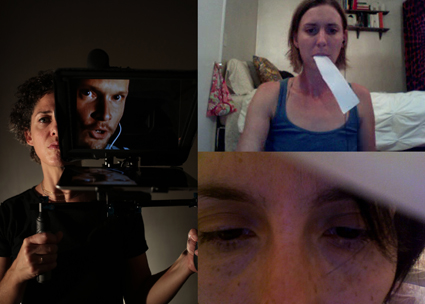
Hydra Poesis, PROMPTER, Jule Japhet Chiari, Brendan Ewing (on computer monitor), Allison Wyper (USA), Marcela Fuentes (Argentina), courtesy the artists
Keeping abreast of the vanguard of performing arts must be akin to trying to catch some mythical beast that keeps changing form. Arts House in North Melbourne might primarily be a live performance venue but in recent years alone that brief has swollen to include film and new media, interactive sculpture, sound art and installation. “The classifications are only as useful as you want to make them, and they should always be imploding and exploding,” says Arts House creative producer Angharad Wynne-Jones.
“Rather than be definitive about the form I think it’s really about the experience that we’re looking to create, an opportunity for the audience member to engage extremely strongly with a performative experience. That sense of event and adventure is what we’re looking for, really.”
In recent years this quest has seen Arts House help launch the hugely rewarding biennial festival of contemporary dance, Dance Massive, and plans are underway to create a similar festival of live art in 2014 (if successful, the two festivals will alternate yearly). The very notion of a live art festival would have been unthinkable only a few years ago, but its possibility is testament to the kind of work that Arts House has consistently introduced to audiences, and the willingness of those audiences to come back for more.
Arts House’s second season for 2013 is as diverse as expected. This year Wynne-Jones has been looking “up and around” and many of the entries arrive from outside Victoria. Several have enjoyed seasons interstate: Belvoir and Roslyn Oades’ I’m Your Man and Branch Nebula, Matt Prest and Clare Britton’s Whelping Box, for instance (both NSW), while Hydrapoesis’ PROMPTER hails from Perth.
Others have played elsewhere but have further evolved since premiering. The Hanging of Jean Lee, Andrée Greenwell, Jordie Albiston and Abe Pogos’ song cycle based on the last woman to be subjected to capital punishment in Melbourne, has been presented in concert form in Sydney, while ILBIJERRI, Belvoir and version 1.0’s Beautiful One Day has grown from its original incarnation up north. “So much work in Australia gets its one go,” says Wynne-Jones, but this doesn’t allow for the fact that the most urgent contemporary work can change as rapidly as the climate to which it responds.
The new season also features a number of world premieres. Stephanie Lake and Robin Fox will be presenting A Small Prometheus as part of the Melbourne Festival, the work combining contemporary dance with flame and sound experiments. “(Fox) is making kinetic sculptures that are moved by flame,” says Wynne-Jones, “(employing the) principle of heat moving a kinetic sculpture and then, at the same time, the soundwaves extinguishing some of that flame. So Fox’s is an extremely conceptual investigation into those kinds of physical laws. And then Stephanie will be interpreting and colliding with some of that information with her five amazing dancers.”
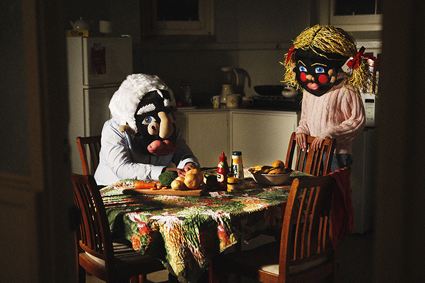
Side Pony, The Confidence Man
courtesy the artists
Side Pony, The Confidence Man
Side Pony’s The Confidence Man is harder to describe. Writer-director Zoe Pepper calls it an “interactive audio work” in which a drama is played out by audience members equipped with headsets and dressed in gigantic hand-crafted masks. It’s an attempt to create an interactive work that still doesn’t dispense with the complexities of storytelling in favour of gadgetry.
“It feels like it’s very much on-trend to create interdisciplinary, interactive work,” says Pepper. “I’d seen a lot of work that was more about the technology than it was about the story, so I wanted to make a work in that style but to focus on the elements that are key to my other work, which is still driven by plot. And to create a style of audience interaction that gave the audience member an anonymity and permission to play, without any humiliation.”
“Zoe Pepper’s a really great director and writer,” says Wynne-Jones, “and she’ll be crafting something fairly extraordinary. There’s more and more interest in that notion of co-authoring a work with an audience, and certainly Confidence Man takes that to the nth degree.”
Every experience of The Confidence Man will differ. The audience members playing out the tale will each hear different audio, while a separate audience sitting outside of the playing space will be able to toggle between channels as they choose which of the scenes being presented simultaneously most piques their interest: “They effectively create their own story by choosing what they want to watch and what to omit,” says Pepper.
If replacing actors with audience members seems a risky proposition, Hydrapoesis’ PROMPTER will negotiate the equally dangerous territory of technology—as a crisis plays out on stage, artists from around the world will be streaming their own responses live as a kind of online chorus.
This work revolves around the ubiquitous teleprompter as a symbol of our age. A journalist accidentally finding himself in the middle of a fictional island as a disaster takes place must cover the event as it unfolds behind him by reading the words his producers back home provide. “So rather than reporting with his own eyes he literally has his back to the event the whole time,” says director Sam Fox, “and it’s that instantaneous reporting phenomenon where no one actually knows what’s happening and the producers are on the phones and the internet trying to find out what’s going down, and feeding him this stream of data.”
The work explores the double bind of empathy in a connected age: “Projecting yourself onto events and indulging in events far away,” says Fox. “In the central narrative we’re looking at the nature of stories and journalism and not having time, where we’ve accelerated to the point where we really can’t get faster than we are now, unless you’re getting predictive. But in the broader narrative we’re looking at what it means to be an international citizen, how we should be responding to international events, from an empathetic and political standpoint. And then I suppose there’s this implied question of acting on your local politics rather than the international, and whether they’re in conflict or not.”
Wynne-Jones is excited by the riskiness of both works. Of PROMPTER, she says “you can be scared of it or not, can’t you? [Sam Fox has] a number of strategies that will be integrating the fuck-ups as well, so it’s not designed to be seamless, but in the way that our experience of media is sometimes glitchy and [we get] only half the story.”
Full details on Arts House’s 2013 Season 2 are at artshouse.com.au.
RealTime issue #116 Aug-Sept 2013 pg. 38
© John Bailey; for permission to reproduce apply to realtime@realtimearts.net
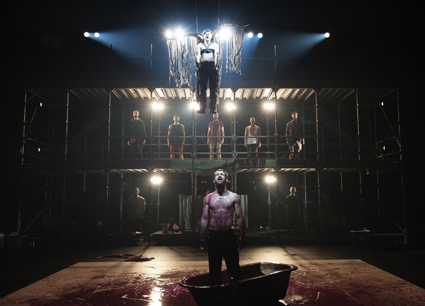
Sons of Sin, Danger Ensemble,
photo Morgan Roberts
Sons of Sin, Danger Ensemble,
Compare your last night of theatre with your first. Like internet dating, the consummation is the same, but the rules of engagement have changed. A decade of ‘independent seasons’ nested within our mainstages has littered the moat-like foyers of our state-funded theatres with couches, reshaped their intractable prosceniums into new configurations and collapsed many of the traditional artform hierarchies.
La Boite Indie Season
The La Boite Indie Season 2013 (parts 1 & 2) is illustrative: three mini-festivals across the year, each with multiple small shows, often playing simultaneously to tiny audiences, snaking through the La Boite complex into rehearsal rooms and out into the surrounding precinct.
Part 1 kicked off with The Séance by Melbourne-based company NO SHOW, one of those breathtakingly simple ideas that ought to have been done before. A dozen spectators cluster around a Ouija board with diva Sophie Webb. Tantalisingly, she is both our medium and the dead celebrity we are trying to reach. Spooky things, including some awkward audience participation, ensue and the show climaxes with Webb belting out Whitney Houston’s evergreen 90s pop standard “I will always love you” in her gorgeous contralto as she exits, lit by a bank of white lights. The natural performativity of the premise never quite lifts into genuine eeriness, I suspect because we are not seated around a table, eliminating many of the possible stage ‘tricks’ of a psychic. Instead, the piece is an exploration of fame and ambition, with a fairly traditional ‘stand and deliver’ performance mode, despite the potential of its intimate scale.
In contrast, This is Capital City strains at the edges of its own form to deliver a spectatorship that is driven by interiority. After instruction about your iPhone/headphone, you are led into the silky night of a Brisbane that has transformed itself into Capital City, a vista that is yours alone, marked by the techno-lullaby of the soundscape. You walk through bars and parks, following markers in the landscape and instructions from your virtual narrator, who becomes increasingly agitated and paranoid, as he cannot remember if he has committed a murder. At various points performers emerge. This is one of the most intriguing aspects of the show as the dialogue runs straight into your ears through the headsets while the performers engage in a looping dumb-show, precise and difficult as they cue their performance through your reactions. This reinforces the sense of control and destiny in the spectatorship as you investigate and re-image the familiar landscape through the noir and dystopian tropes of the plot.
Also deeply mediated by technology is Blindscape by Skye Gellmann and Kieran Law, an interactive circus work performed in the dark, with the audience using smartphones and a guided soundscape piped through headphones to navigate the wine-dark world. Again, a blinder of an idea, pardon the pun, but the compelling promise of all three works was never quite reached. Part 1 felt more like a creative development festival than a season, with each work just an iteration or two away from spectacular.
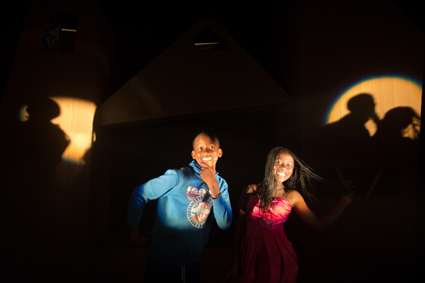
Joy Fear & Poetry, La Boite Indie 2013
photo Jason Boshler
Joy Fear & Poetry, La Boite Indie 2013
Part 2 was much more traditional, starting with Natasha Budd’s Joy Fear and Poetry where the 7-12-year old cast declare, “We are going to be the artists and you can be the kids.” Despite this rallying call, the work relies on tried and true montage drama favourites, with a mix of movement sequences, short scenes and personal stories, interspersed with drawings and reflections projected onto the gorgeous set, an architectural cardboard house with rhomboid dormer windows and matching screens on either side.
Part 2 finished with Tim Spencer’s Show me yours, I’ll show you mine, a clever and original exploration of contemporary Australian sex work. Literally just two performers, two chairs and a projector, the piece is structured around the six interviews that occurred (perhaps?) between an anonymous male sex worker ‘Not-Nick’ and the playwright/performer. The performance from Charles Purcell as ‘Not-Nick’ is disciplined and elegant; his controlled intensity gives Spencer’s witty and reflexive script its plausibility and tension.
Part 3 is yet to be announced, but one of the joys of the Indie this year has been the sense of risk-taking and experimentation, so I am expecting the unexpected.
Judith Wright Centre, Fresh Ground
Like La Boite Indie, the Fresh Ground Program at the Judith Wright Centre has been deconstructing its own institutional bulwarks with edgy programming, and it was also one of the first local spaces to fully embrace cabaret seating, with patrons free to move in and out of the space to buy drinks. Walking into the Danger Ensemble’s new work, Sons of Sin, I was struck by the warehouse formation, with five-storey scaffolding on one side of the empty theatre and, on the other, a beautifully framed white box, whose front side slides up to reveal a stage.
The Danger Ensemble’s visual and performatively charged works never fail to provoke and disturb and this show is no exception. With a cast of nine young alpha males (think the Brisbane equivalent of the cattle calls of Coppola for his movie The Outsiders) baring their souls, their cocks and their white-boy dance moves, it is a tour-de-force of masculine crisis. For women in the audience like myself, safely coupled in middle-aged suburbia, my response to the explicit content was maternal concern rather than horror, but I could see the sense of disquiet and genuine shock in many of the younger women.
The truth or dare format, where the show is structured by a set of over-sized cards laid out in a circle on the floor to trigger certain sequences (short scenes, monologues, improvisations and audience requests), gives the show an air of barely contained chaos that supports the thematic of the young men’s disintegration into alcohol-fuelled despair. However, it has been put together with a great deal of care. The set pieces, riffing off classical representations of masculinity that are presented on the ice white stage, anchor the free forming, roaming sequences on the floor. The scaffolding provides a frame for both the satirical pop culture montages and the final moments of the performance, where a tortured man-angel descends, Tony Kushner via Anne Bogart, our own little piece of New York City in downtown Brisbane.
La Boite Indie Part 1, This is Capital City created by Sandra Carluccio; NO SHOW (Mark Pritchard & Bridget Balodis), The Seance; Blindscape, by Skye Gellmann, Kieran Law, Thom Browning, Gareth Hart & Dylan Sale; 8-25 May; Indie Part 2: Joy, Fear and Poetry, Natasha Budd, 10-20 July; Tim Spencer, Show me yours, I’ll show you mine; La Boite, 10-27 July; Judith Wright Centre, Fresh Ground: The Danger Ensemble, Sons of Sin, director Steven Mitchell Wright, Performance Space, Judith Wright Centre, 7-25 May
RealTime issue #116 Aug-Sept 2013 pg. 39
© Kathryn Kelly; for permission to reproduce apply to realtime@realtimearts.net
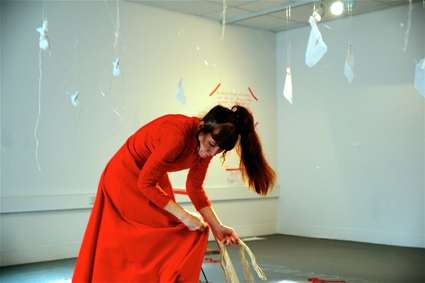
Julie Vulcan, Redress #6 Hinc Illae Lacrimae, or Hence Those Tears
photo Alan Warren
Julie Vulcan, Redress #6 Hinc Illae Lacrimae, or Hence Those Tears
Existence equals one white room, one mesmerised spectator and one flame-haired woman in a blood-red dress. Julie Vulcan’s Redress #6 was one of the exquisite durational live artworks showcased at exist-ence 5, a festival organised by the exist collective “to cultivate an open and visible platform for live art, action and performance arts through altruistic curation.”
This exist-ence is their fifth international festival in six years (2008-2013), the impressive program including a two-day Symposium in Brisbane and a program of performance events in Brisbane, Sydney and Melbourne. As Keith Gallasch noted in his preview in RT115, the exist-ence festival is “unique in terms of ambition, continuity and growing national and international scope.”
Live art demands body and flesh be witnessed and sometimes can be a mixed bag for spectators, but I had an absolute ball at the three-day Performance Festival because there was such a spirit of shambolic risk-taking and experimentation.
Live artists are not the contained and elegant greyhounds you see at so many art-show openings. As a tribe they remind me strongly of my own theatre muckers, ramshackle gypsies and shamanic chameleons, luminous with child-like curiosity. On the first night we all snuck into the printmakers’ opening night around the corridor at QCA where we quaffed free wine and ate expensive cheese before scarpering back for a tired but still crackerjack Labana Babylon, gyrating and prophesying via webcam from her bordello-like New York apartment.
That night ended on the moonlit quadrangle, where, between abutting concrete towers, Swedish artist Henrik Hedinge lay down on the grass in his green top and gold shorts (a nice touch I thought). With a motley crew of helpers he arranged large bamboo poles, which functioned as extensions of his prone body, making pleasing, slightly skewed, geometric patterns. This was an architectural body, but one augmented by wood rather than by techno-industrial material and therefore somehow more vulnerable in its irregularity.
Unlike other images in this series, Hedinge was not strapped into the bamboo extensions and there was an un-easiness watching the poles being moved, over there, here you go, no that isn’t right, try again. While this may have been a conscious strategy, the work lacked the sensitivity and layered detail of other documented images in this lying down series (see RT115, p23). However, images of the work taken on the night from the top of the large concrete towers showed that it was also a matter of scale and perspective. To fully appreciate the delicacy of the body in the flow of the wood extensions you needed to view, like Hedinge’s other documented images, from above and from a distance.
Grappling with body plasticity and mutation was also a theme of many of the local works including James Cunningham’s Antennae. Cunningham, bent double, had strapped to his back and arms bundles of black arcing plastic rods which made a quivering carapace over his body, dislodging ceiling tiles and scaling the floors. The act of standing up took Cunningham a gripping 20 minutes as he manipulated body and carapace, delicately choosing particular angles that would allow freedom of movement for both. In contrast, Karike Ashworth and Anja Homburg chose domestic materials, ribbons and strings, and offered their bodies for us to decorate. While the scissors and other implements looked the most dangerous, the fiercest provocation came from august live artist AñA Wojak who took one of the young women’s hair and plaited it, in full tension, to the back of spectator Henrik Hedinge’s fashionably asymmetrical quiff, a Rapunzel knot, its tension electrifying the sense of time and feminist discourse in the piece.
But I must confess that I was captured, like a rabbit in headlights by Redress #6 Hinc Illae Lacrimae, or Hence Those Tears. Julie Vulcan has a long career as both a solo artist and as part of the Unreasonable Adults and the Frumpus collectives.
This work explored the politics of standing, as protest and as subjugation, perhaps to domesticity, or obsession or even to the act of creation. The standing was interspersed with intense routine, marked by Vulcan’s iPhone timer: task, alarm, re-set, standing, alarm, re-set, task. There were occasional breaks to this extraordinary rhythm, like a long, slow walk through the rocky garden outside the window of the small white room. But the work built its intensity from the dignity given to this slowing and structuring of time through task. A long muslin sheet was kissed and cut and each piece laid on the floor in precise rows. Salt was poured in a long stream, pooling next to each of the muslin pieces and then kissed by Vulcan. Each sheet was wrapped in ice and hung, crying into the salt faces in the floor that echoed the broad and generous curves of the performer’s lips and nose. Hence those tears. The strain was evident, but Vulcan’s absolute commitment made the room like a church, alive with contemplation and shared grace.
My journey at exist-ence ended rather fortuitously with an engaging young animateur, Jamie Lewis, whose piece, untitled, involved a bbq chat filmed while she made us sambal and egg sandwiches on glowing white bread, a sneaky Singaporean comfort food that brokered conversations about place, identity and chili. I wondered about the recording though, sensing a further stage to the work yet to be revealed.
Commendation must go to the tireless and graceful co-curators Rebecca Clunn-Cunningham and Nicola Morton who were there seemingly all day and night, soothing young artists and endlessly resetting the small rooms or outdoor spaces for the next performance. Scuttlebutt around town was that Julie Vulcan had been censored with posters being put up on the glass walls to prevent her breasts being seen by the public when she took her dress off to write on her back with red pen. I’m not sure if this is in any way true, but to my mind, the whiff of indignation it implies is the ultimate accolade for this subversive artform and a tribute to this gathering of true believers.
exist-ence 5, festival of live art, performance art and action art, QCA Project Gallery, Brisbane, 17-30 June
See also Keith Gallasch’s account performances in the Sydney leg of exist ence 5 at PACT.
RealTime issue #116 Aug-Sept 2013 pg. 40
© Kathryn Kelly; for permission to reproduce apply to realtime@realtimearts.net
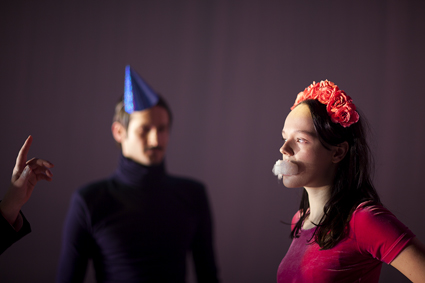
Emily Milledge, Pier Carthew, Story of O, The Rabble, Neon
photo Guy Little
Emily Milledge, Pier Carthew, Story of O, The Rabble, Neon
Critics lamenting the conservatism of Australia’s mainstages will often end their complaint with a shrug and a dark comment about how their audiences will all be dead soon, anyhow. Ageing subscriber bases can only be played to for so long, goes the logic, and sooner or later a more progressive—read younger—audience will have to be found. It’s a Pollyanna-ish suggestion, I think. It equates youth with experiment, risk, innovation, when of course a young audience can be just as reactionary as any other. But more importantly, it ignores the structural conservatism of large companies that need to appeal to a broad base, that rely on familiarity as a marketing tool and that by necessity must at least in part consider a play as a product.
This is one of the reasons why Melbourne Theatre Company’s recent NEON season of independent theatre was met with such welcome. It’s not just that the works produced were radically unlike anything the MTC typically programs (though they were). It’s that these works really were afforded an astonishing degree of independence within the structures of the institution—they weren’t teased and cajoled from above into something they weren’t, or subjected to review and reform by outside eyes. Each of the five companies given a spot in the season was trusted to produce something that wouldn’t bring down the MTC’s walls, and the outcome taken as a whole was one of the most exciting developments in Melbourne’s theatre scene in living memory.
The Rabble, Story of O
It’s odd to remember that all of the works in NEON were inspired by somewhat canonical texts or writings by playwrights who wouldn’t be out of place on a mainstage—Tennessee Williams, Frank Wedekind—given that what we saw in every case was so far from a ‘play.’ The most striking response to a written classic was The Rabble’s Story of O. The company has in the past had much success turning novels into live works, but to use the word ‘adaptation’ in these instances would be a mistake. If theatre, as it’s often said, is a living thing, then The Rabble treats any narrative in the same manner, and their work is a violent wrestling match with the seething, squirming being that is a story.
To faithfully adapt Anne Desclos’ pseudonymously published erotic novel would be a fool’s mission, in any case. The story follows a woman willingly entering into a state of sexual slavery at the behest of her lover, who introduces her to a mysterious world of submission, violence and humiliation. The short work was written as a kind of love letter to Desclos’ partner, himself fascinated by the writings of the Marquis de Sade, and Desclos made clear that the events it describes exist as pure fantasy, with no base in the waking world. It is this, as much as the abjection of the acts it depicts, that makes a stage adaptation seem close to impossible—The Story of O’s power comes in the electric arc that is sparked when words are divorced from their referents.
The Rabble’s Story of O handles this problem with brio. From the outset we’re reminded that words are themselves a weapon. Jane Montgomery Griffiths as the sadistic Sir Stephen lectures the audience on the Lacanian notion of language as phallic tool, with a nod to Susan Sontag’s essay on Story of O which applies the same reading, and from here on the disjunct between the symbolic world of words and the materiality of the body becomes deeply problematised. O desires to become nothing, pure object, no ego, but when this is played out by live actors the pure fantasy of self-annihilation loses the sense of transcendence the original novel gives it and proves a far messier fact.
Mary Helen Sassman is a fascinating O. Almost silent throughout—apart from a genuinely shocking moment of spoken refusal—she somehow becomes more real, more situated as the rituals through which her character suffers become more outlandish. The figures who surround her are just as jarring: Dana Miltins plays Jacqueline, the model O in turn inducts into the cycle of submission, but is herself seven months pregnant, bringing to the role a surfeit of life in a climate of suspended death; Griffiths’ Sir Stephen is both the architect of O’s dissolution and a curious absence of character in her own right.
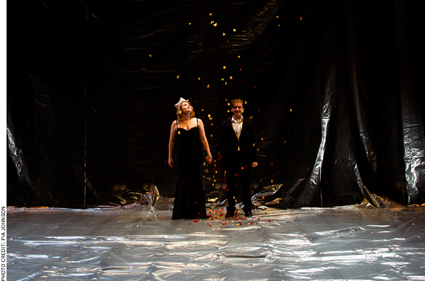
The Hayloft Project, By Their Own Hands, Neon
photo Pia Johnson
The Hayloft Project, By Their Own Hands, Neon
Hayloft Project, By Their Own Hands
The Hayloft Project’s By Their Own Hands is just as much concerned with absence and presence—here, it is the story of Oedipus and Jocasta that is subject to a kind of inversion. That which could never be shown onstage in the Greek tragedies is laid bare, while the lofty power of the spoken utterance is gradually eroded from within.
The work is divided into three parts, each employing a different theatrical language. The first is a genial piece of storytelling in which the events of Oedipus Rex are related to the audience by the two performers, Benedict Hardie and Anne-Louise Sarks (featured in Women + Performance 2). There’s no acting, per se, and setting and character are summoned by the viewer’s imagination. It’s an amiable (if extended) sequence that’s a contrast to the terrible tale it describes.
The second sequence traces the same story through a series of stark, almost silent images, returning to the stage the terrible visions of sex and death that underscore the drama. This is the stuff that words alone cannot conjure, but in their sheer materiality neither can they be integrated into narrative, which after all works to order, to make sense of such things.
The final sequence is something other—a series of short, intimate conversations between Oedipus and Jocasta that eschew both the sense-making narration of the first third and the world-destroying spectacle of the second. It’s a clever kind of theatrical dialecticism, and one that doesn’t entirely satisfy since it seeks to open up cracks in that most familiar of stories rather than seal them up.
These are only two of NEON’s first series of excursions, but they’re a ways from anything an audience expects of the MTC. If there’s a more potent argument for the continued programming of such a bold experiment, I’d like to see it.
See Jana Perkovic’s review of Daniel Schlusser Ensemble’s Menagerie, also in the NEON season, in RealTime 115.
Melbourne Theatre Company, NEON: The Rabble, Story of O, after Pauline Reage, creators Emma Valente, Kate Davis,director Emma Valente, designer Kate Davis, 27 June-7 July; The Hayloft Project, By Their Own Hands, directors, performers Benedict Hardie, Anne-Louise Sarks, design Marg Horwell, lighting Matt Scott, composition Kelly Ryall, dramaturgy Carl Nilsson-Polias,13-23 June; The Lawler, Southbank Theatre
RealTime issue #116 Aug-Sept 2013 pg. 41
© John Bailey; for permission to reproduce apply to realtime@realtimearts.net
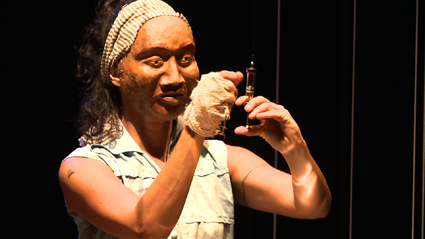
Contagion’s Kiss, Business Unusual
photo Tim Wood
Contagion’s Kiss, Business Unusual
Delicately combining some of the darkest elements of the nation’s history, Contagion’s Kiss is a haunting and poignant piece of theatre that transports you to a world of isolation and hardship, yet also of love and hope. The first all-mask collaboration of Nicola Fearn and Sarah Cathcart of Business Unusual, Contagion’s Kiss pulls you into the silent world of the voiceless.
The performance is set in the 1940s on Channel Island, a leprosarium off the coast of Darwin, its inhabitants (95% Indigenous) forcibly removed from the mainland and made to live in quarantine. It follows the interwoven journeys of three distinct characters: a privileged, teenage white girl, about to embark on a musical scholarship in Sydney, before being diagnosed with leprosy; a young Indigenous female leper who assists the doctor in administering treatment; and an old, well-educated white man who writes reams of cranky yet humorous letters to newspapers in the hope of improving conditions on the island and alerting people to the inmates’ plight: “Please send a large teapot, preferably blue, to complement our mood.”
Set in a time when white ‘protectors’ determined Aboriginal people’s fates and their mixed blood children were forcibly removed, Contagion’s Kiss is a work of fiction based on true events and characters.
By using the effortlessly symbolic historical setting of the Channel Island Leprosarium, Fearn and Cathcart are able to depict the darkest afflictions of society at the time. Away from family, young girls’ fingers fester, white doctors try to ‘breed out the black.’
Sarah Cathcart’s direction assures that all the components of Contagions Kiss run together effortlessly, expertly balancing the humour, pathos and tragedy of the characters’ lives. Performers Fearn, Samantha Chalmers and Conor Fox convincingly convey their characters through adroit physicality and gesture, quickly discarding any audience preconceptions that mask might hinder expressiveness. Chalmers’ depiction of Pearl is so communicative that it is almost shocking when she finally does remove her mask for the curtain call.
The set, designed by Marg Howell, is a piece of art. Literally. Over a hundred rocks hang suspended from the ceiling on fine string, hovering a metre off the ground and almost filling the entire stage. A well-executed exercise in negative space, the set provides both a symbolic obstruction and a palpable emptiness. Each rock hangs alone and lonely, a symbol of suspended lives, a visceral response to isolation, barrenness and barriers—of communication, disease and race.
The characters constantly try to navigate around and through these barriers, and it is not until the sudden appearance of a threat to all of society that they collide—the rocks swing and crash together as the sound of a foreign air attack rings out over the harbour.
Conor Fox’s beautifully rendered puppets and puppetry allow us to witness painful scenes through a dreamlike and distant lens. Strings of Aboriginal people are rounded up in chains and led to the Island, a dying inmate unravels to fly skywards and illuminated huts dot the lonely landscape. Rebecca Adams’ moody and evocative lighting design brings these sequences to life.
Mask and puppetry are complemented by Elka Kerkhofs’ animations that creep through the strings of the suspended rocks to flicker on a screen over a line of crosses at the back of the stage.
Kerkhofs’ visuals and animations are clever and affecting: medieval depictions of plague doctors and anatomy charts, night skies, falling rain and text directly drawn from actual letters or newspaper articles of the day.
Composer and musician Biddy Connor accompanies the piece throughout on piano, violin and, uniquely, the saw. Her score is exemplary and adds an emotional and mesmerising depth to the performance.
Contagion’s Kiss is a clever, unusual and beautiful piece of theatre whose dark historical truths still have resonance today.
Business Unusual & Brown’s Mart Theatre: Contagion’s Kiss, co-writer, creative producer, performer Nicola Fearn, director, co-writer Sarah Cathcart, Brown’s Mart Theatre, Darwin 4-16 June
RealTime issue #116 Aug-Sept 2013 pg. 42
© Gail Evans; for permission to reproduce apply to realtime@realtimearts.net
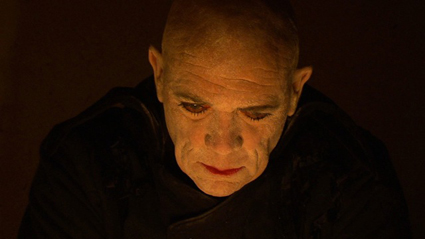
OzFrank Theatre Film, The Castle of Macbeth’s Head
Since 1992 Jacqui Carroll and John Nobbs’ OzFrank Theatre has created performances “which combine Australian form and content with Asian sensibilities and integrity of purpose to produce a Japan/Australian fusion theatre” (website). Drawing on their dance backgrounds, Carroll’s choreographic and directing skills and Nobbs’ design and performance expertise they have created visceral performances seen around the world—from Queensland to Japan and Turkey.
Carroll and Nobbs have now turned their attention from live performance to making films but, drawing on their considerable repertoire, steadfastly maintain their performative principles. Their first is a feature length film based on Macbeth titled The Castle of Macbeth’s Head—more than a hint that the approach will be emphatically psychological, but doubtless with OzFrank’s inherent physicality.
Nobbs tells us that their Macbeth has been in the OzFrank repertoire since 1995: “We’ve travelled all over the world with it—to Nepal, Mongolia, Croatia, all sorts of places. All our other productions have been filmed but we’ve never had much footage of Macbeth so we decided to film it and then to go a bit further and make a feature film out of it. It was originally about 65 minutes but obviously in film you have to introduce things you don’t need to do onstage, so we added another 20 minutes of intermediary scenes.” When Carroll first directed it she stripped it back, focusing on the key psychological moments: “Macbeth has 11 or 12 of probably the best speeches Shakespeare ever wrote.”
Carroll wanted to film in the corridors of a castle, “So we made the set out of a series of moveable panels—basically plastic sprayed with paint and cement to represent a castle’s inner walls. There are no set battle scenes or anything like that. Jacqui just wanted to concentrate what is actually happening inside Macbeth’s head.” Intensifying this is the transformation of the witches into the murderers, Lady Macbeth’s nurse and the doctor, suggesting that they’re projections from Macbeth’s troubled psyche. “It’s the ambiguity,” says Nobbs, “about what’s stimulated by Macbeth’s mind and by, shall we say, outside or supernatural forces. This approach enabled us to shoot relatively cheaply. David Granato (Polygranate Films) has filmed a lot of our work in the past. This is his film really: he’s the director, Jacqui is the producer. It’s a combination of Jacqui’s vision and David’s technical ability to film our vision of the play.”
In the transition from stage to film Nobbs says, “we’ve realised that rather than competing with cinema we’re actually creating very powerful, almost fantasy-like designs and filming them. To say it’s theatre film is probably better than to say it’s film.” It’s also brought a focus on powerful stillness, already evident in the stage performances: “it enables a lot of close-ups. You can sit on the eyes in much the same way as, say, Sergio Leone did in Once Upon A Time In The West. There’s also the distillation of the voice into something that’s much quieter than on stage. And the film shows the impact of the training itself; it demonstrates its universality. While Suzuki is often seen as having some Samurai/Kung Fu aesthetic, that’s a misinterpretation as far as we’re concerned. The film will be very quiet; not at all histrionic.”
Nobbs and Carroll are enjoying the move into film and are “already embarking on a version of Oedipus after finishing The Loves of Don Perlimplin, a lesser-known chamber piece by Lorca. I play Perlimplin but you never see me. I’ve got the camera on my chest. It’s a home-made steadicam (‘chestycam’ I call it) exploring what point of view means and the ways you can cut and edit.”
With documentation of 21 of their works on film and on video, mostly sold internationally through Artfilms, Carroll and Nobbs are now creating a new niche for the expression of their vision and its aesthetic, a fascinating hybrid—theatre-film—which will further their legacy and generate works to come. The film’s launch will be mc’d by Queensland Theatre Company Artistic Director Wesley Enoch. RT
OzFrank Theatre Film and Polygranate Films, The Castle of Macbeth’s Head, Gala Preview, QTC, Brisbane, 27 August; www.ozfrank.com
RealTime issue #116 Aug-Sept 2013 pg. 42
© RealTime ; for permission to reproduce apply to realtime@realtimearts.net
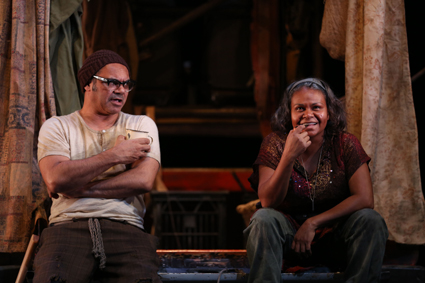
David Page, Ursula Yovich, Mother Courage and Her Children, QTC
photo Rob MacColl
David Page, Ursula Yovich, Mother Courage and Her Children, QTC
During a month in which The Australian’s Rosemary Neill instigated a media skirmish centring on the proliferation of adaptations of canonical European texts on the nation’s mainstages, Queensland Theatre Company premiered an all-Indigenous production of Bertolt Brecht’s Mother Courage and Her Children. Avoiding the brouhaha surrounding the work of ‘auteur directors’ in Neill’s articles, where the original writer’s name disappears from the playbill altogether, Queensland Theatre Company was very careful to name this as Brecht’s play, and Paula Nazarski and Wesley Enoch its translators.
As a translation (into contemporary Aboriginal English, utilising south-east Queensland slang and lingo), the script gleams. It is a crisp and aggressive kriol metamorphosis of Brecht’s text in which language goes a long way to establishing mise en scène; it is also wickedly humorous and had the substantial number of Indigenous opening night audience members responding with emphatic approval. Mother Courage hauls her wagon—a converted (was it a Holden?) ute—around a sparse outback stage, traversing mining camps and the occasional Centrelink office. Christina Smith’s set design is beautifully evocative of the Australian land (and office) scape. Ben Hughes’ compelling lighting designs give us the red dirt and the starry nights, while Smith’s corrugated iron draping gives us the outback, or the simple stunning line of lurid green plastic chairs the unemployment office.
Enoch, who also directed the play, explains its transposition to a slightly futuristic (Mad Max-esque) regional Australia: “[Brecht] uses the 30 years war that swept Europe in the 17th century to discuss the rise of National Socialism in pre-war Germany. In this production we use Brecht’s characters and situations to suggest the relationship between First Nations Peoples and mining…asking ourselves what is the ‘war’ for contemporary Aboriginal people, and we came upon the idea that the greatest issue of contention for us is—do we engage in mining or not?” (Director’s Note, program). The production is more than a translation, then—it’s an adaptation of Brecht’s text from one specific cultural and political context to another, and it is in this yoking of the text to the Aboriginal/Mining question that I’m not convinced the piece has quite landed yet.
Ursula Yovich leads a well-directed, capable and confident cast. Her astute, grounded performance is a wonderful achievement, commandeering as it does the difficult emotional arc of this big didactic play. During the final John Rodgers’ bluesy musical numbers (the Bossman reprieve) the play’s thesis is (I would argue belatedly) articulated:
There’s luck and there’s skills
When a war drags on you have nothing to rely on but your wits
This war could keep going on for 225 years more
And we mob would still not get anything more than we have now
They take what they want and you have to find a way to survive.
I say take their money and live a life that’s full.
Even if they steal your wages, and take away your kids and take away your Land
You gotta keep dreaming it’s gonna get better.
I have always read Courage as a mercenary who has, at the end of the day, sacrificed principle for the dollar. She is self-professedly pro-war. She is financially dependent upon it and there is not much honour in that reliance. Here Nazarski and Enoch seem to be moulding her into a hero who is emblematic of the First Nations People’s survival and endurance. They are having it both ways, in a sense, and this revelation of her as both pragmatist/mercenary and idealist/champion felt a bit too neat or ad hoc—at odds with her depiction elsewhere in the text. That dramaturgical criticism aside, this is an ambitious production that largely succeeds and will rightly be studied on secondary schools’ drama curricula for years to come.
QTC, Mother Courage and Her Children, writer Bertolt Brecht, translation Wesley Enoch and Paula Nazarski, director Wesley Enoch. QTC, QPAC 25 May-16 June 2013
RealTime issue #116 Aug-Sept 2013 pg. 44
© Stephen Carleton; for permission to reproduce apply to realtime@realtimearts.net
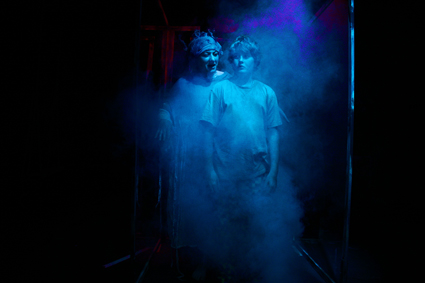
Lieder Theatre, Comin’ Home Soon
At Goulburn’s Lieder Theatre in regional New South Wales on a cold May night I see a verbatim theatre work, Comin’ Home Soon, created from workshops and interviews with prisoners and their families.
Operating continuously in Goulburn since 1891, this regional community theatre is almost as old as the gaol, if not its penal history. In 1884, a massive hand-carved sandstone prison gate and façade designed by colonial architect James Barnet was completed. Such impressive architecture replaced Goulburn’s earliest buildings, a lock-up (1829) and a gibbet (1832), and today it is part of the architecture of surveillance and incarceration of Goulburn Correctional Centre, Australia’s highest security prison. Coming into Goulburn from the north, you can’t miss it—bleak and exposed.
The staging is harsh, defined by an oblique back wall, rough-painted grey, red-streaked, an endlessly receding infinity punctured by four window-sized squares and graffitied with hundreds of counted-off days. High on the proscenium, clocks are painted, dotted—doin’ time Indigenous way?
White light evoking searchlights creates a powerful chiaroscuro of four kids playing cops and robbers. As they squabble about what their dads did and why they were caught, five teenagers walk slowly across the stage behind them. The game gets too hard, the kids give up and exit to their Playstations. More performers enter, adopting curious flower poses for a poetic chorus that contrasts floral images with the harsh life and regime of the prison. Four men enter and address us, recounting experiences of making phone calls from inside. Momentarily there are 17 people on stage.
A series of intersecting games and interactions unfolds between prisoners, their children and the people who work with them. Children contend with each other, absent parents, anger, shame, social workers, prison transport workers and guards. Prisoners describe darker games of secrecy in negotiating incarceration; a father can only speak to his reluctant child through Grizz, a soft toy. We hear promises, lost promises, the elusive promise of the title. Some games loosen up and flow but just as often paralysis takes hold of characters struggling to communicate, as prison life imposes an implacable social straitjacket. How does a long-term inmate relate to his daughter’s account of going to see Lady Gaga?
Alana Valentine’s script structures dense layers of verbatim material by constantly intercutting five defined ‘states.’ The sometimes earnest and awkward delivery by these community actors heightens the sense of authenticity in their performances. Darkly costumed in a monochrome world of grey and black, they criss-cross diagonally between ‘states’ and narrative strands. As ‘states’ shift, the work drives forward. The chords, discordant sound and sustained notes of the score hold the tension throughout, driving the oblique and unsentimental emotional tenor of the work.
The four windows puncturing the back wall open in sequence as prisoners address the audience directly. A slippery dip and swing are play sites, entry and exit points. Mobile frames become X-Ray machine gates. In the only scenes to use colour Nervous Nathan’s fears are physicalised in a fantastical and surreal series of interludes with Gymea lilies called Lillianspooks, a frill-necked lizard and blue-and-white mist.
In a short ‘state’ with didjeridu—a reference to the over-representation of Indigenous people in Australian prisons—the four inmates talk of encountering their Aboriginal culture while in prison and of hunger for ceremony, initiation, language, lore. They speak of regrets for ignoring culture and old people in their youth as they tried to live ‘white-fella way.’ A woman speaks to children about reading Aboriginal painting. So much hangs unsaid. The final scene, a game like Statues, draws all 17 performers into trying their luck at winning—at Comin’ Home Soon.
The play is raw, a first draft followed by one reading and a rewrite. It is intelligent, well-crafted work, emphatic in its clarity, integrity and passionate sense of necessity. The direction, design and sound are sophisticated and the commitment and performances of the ensemble impress. Seven cast members identify as Bundjalung, Wiradjuri, Darug or Bidgigal; five are performing with Lieder for the first time; all are volunteers and locals, visibly determined that their story be heard and seen locally, making the invisible visible. This is the legacy of this community, Lieder Theatre and artistic director Chrisjohn Hancock.
Goulburn jail is harsh, surveillance is constant and punitive but Comin’ Home Soon and the extraordinary local participation undercut that sense of it by reminding us of the humanity of the people incarcerated within its walls.
Lieder Theatre, Comin’ Home Soon, writer Alana Valentine, director, designer, lighting Chrisjohn Hancock, commissioned by Goulburn Regional Art Gallery; Lieder Theatre, Goulburn, NSW, 26 April-11 May
RealTime issue #116 Aug-Sept 2013 pg. 44
© Annemaree Dalziel; for permission to reproduce apply to realtime@realtimearts.net
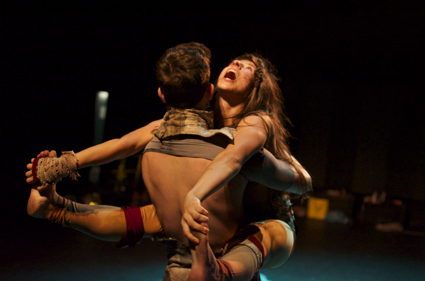
Alexander Baden-Bryce, Lucy Ingham, Phluxus2 Dance Collective
courtesy the artists
Alexander Baden-Bryce, Lucy Ingham, Phluxus2 Dance Collective
With recent global weather events and CO2 in the climate over the 400 parts per million threshold, it’s easy to understand why the paradise-lost motif has inspired choreographer Nerida Matthaei’s de-generator. As she states, it’s a response to the global obsession with the end of the world, and her firm belief that it is the destructive nature of humanity that holds the highest probability of ending our existence.
A dimly lit theatre, chairs retracted. In one half of the space, three large-scale tree-like installations comprising strong lines of black duct tape; in the other a series of illuminated collections, small heaps of outmoded technologies, plastic water bottles, torches, gas masks and such, some mounted and slung on rustic bamboo racks; the space divided by an obtrusive, jagged diagonal line, like a great primordial crack in the earth.
The de-generator narrative finds a man and woman (Alexander Baden Bryce and Lucy Ingham) discordant, infested and alone in their existence. Two solos, one after the other, enlist a language of angular, shaking, primal movement in an intersection with refined balletic control. Groping the darkness, themselves and the audience, who are free-standing in the space, the duo come to terms with their ominous world. An unfamiliar meeting of intricate and dynamic composition sees the male outsmarted and lying on the floor. Bathing him from feet to head, the woman revives the man, and the pair lyrically reconcile. Together they travel through the landscape, where she reveals her collections to him. The journey ends in a particularly lovely moment where, cradled, her hair extends like an extra limb. The work’s last moments are danced in unison, followed by a barrage of topical media sound bites describing catastrophic natural disasters and nuclear war as the silhouetted couple stand hand-in-hand in prophetic revelation.
I sense that de-generator’s intention is to startle. The inevitable examination of mortality is an attempt to portray the gravity of our current situation, and the work’s foregone tone of desolation embellishes this subtext, reinforcing it through the choreographic form. Giddying twists, spirals and extensions, sweaty limbs entwining and snapshot partnered lifts revealed a flexibility in which the intent, if physically possible, would have been to turn the body inside out.
Bleak, stark, abrasive lighting, high-key sound and post-punk-feral aesthetic couture augment the imagined catastrophe and nihilism. Was it misanthropic or merely reflecting on the helplessness of humans in a circumstance that eclipses them? Rendering it as a non-proscenium work meant that it lent itself to either interpretation, as the audience, like marsupials caught in high-beam headlights, were sent scurrying from the dancers. Some stood their ground, but as the work progressed and the dancers became space eaters, a psychology of survival seemed evident, the dancers taking over the centre space and observers gravitating to the sides of the room.
De-generator seeks out our innermost fears in an attempt to observe anxiety over events in which we have little control. Despite this, in the act of sharing her anxiety and having the dancers complete the work hand-in-hand, Nerida Matthaei aims perhaps to bring us all together.
Phluxus2 Dance Collective: de-generator, choreographer Nerida Matthaei, dancers, set and costumes Lisa Fa’alafi, sound Andrew Mills, lighting Keith Clark; Cairns Centre of Contemporary Arts, 22-25 May
RealTime issue #116 Aug-Sept 2013 pg. 46
© Rebecca Youdell; for permission to reproduce apply to realtime@realtimearts.net
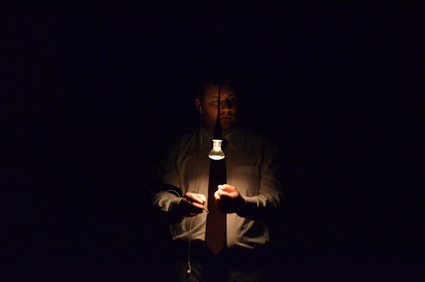
David Williams, Open Your Mouth and Let Words Fall Out
Jennifer Greer Holmes and Heath Britton
David Williams, Open Your Mouth and Let Words Fall Out
Now in its fourth year, the nationally situated ‘hothouse’ Adhocracy continues to bring together South Australian and interstate interdisciplinary artists to explore untested ideas through workshops, talks and work-in-progress showings. The proceedings take place over the three-day Queen’s Birthday weekend at Port Adelaide’s Waterside Workers Hall, the hub of innovative production and performance company Vitalstatistix.
Artists set up and perform in every part of the heritage-listed building from the cavernous main hall to the claustrophobic supper room, their disparate performative entities embryonically grappling with the hopes and anxieties of now: democracy, human rights, corruption, post-industrialisation. Almost all of the works propose questions about the nature of truth in an increasingly illusory world.
In Open Your Mouth and Let Words Fall Out, version 1.0 co-founder David Williams appropriates the bizarre real life testimony of con artist Gerald Carroll to create a nonsensical verbatim monologue. An earpiece feeds him questions from the Commissioner of the anti-corruption operation Atlas. We cannot hear the questions, but we can both hear and witness Carroll’s literally flailing responses. Hounded from above by an elaborate pulley system from which hang half a dozen or so light globes, Williams ducks, weaves and shadowboxes in a breathless physicalisation of the arts of equivocation and deception.
The telling, and not telling, of politically pertinent truths is also central to Love and Boats, an exploration of refugee rights and asylum seeking. Still in its infancy, Love and Boats sees two artists (Karen Therese and Boris Morris Bagattini) and one Human Rights lawyer (Joe Tan) begin an unconstrained conversation about the intersections which characterise the immigrant experience: love and law, freedom and oppression, integration and isolationism. It is unclear what shape or form any finished work may take, but the trio’s use of Skype points towards a mediatised and internationalised response. The showing is framed by impeccable legalese and performance theory, but Love and Boats’ messiness and unfocused passion seem to get closer to the essential, obscured truths at its heart.
Taking its name from a notoriously desperate stunt to reinvigorate flagging sitcom Happy Days, Malcolm Whittaker’s Jumping the Shark Fantastic is an irony-rich attempt to give audiences what they want. It is a ‘residency model’ in which Whittaker presents the results of two days of research within the Port Adelaide community into what both theatre makers and theatre goers want their ideal show to look like, sound like, feel like. The results, which Whittaker presents as a sort of stream-of-consciousness lecture while dressed in a bear costume, are predictably absurd, underscoring the illusion which lies at the heart of our democratic processes: that everyone can get what they want all of the time.
Taking place behind the curtain of the Waterside Stage is Bron Batten’s Use Your Illusion, an investigation into hypnotism and performance drawing on the performer’s collaboration with a clinical hypnotist. Influenced by a recent residency with Chicago Theatre Company The Neo Futurists, it is Batten’s contention that acting is innately fraudulent, and hypnotism one possible pathway to ‘truthful’ performance. There is a tension present in the showing between the application of hypnosis as a clinical tool, and its chintzy appropriation as spectacle by the show business industry. Batten investigates both applications, at one point requesting the assistance of an audience member in seemingly moving a chain with mind power alone, at another playing with the idea that hypnosis can compel her to provide truthful answers to sometimes intensely personal questions provided by the audience. Nothing like a conclusion is ever reached—indeed, the concept of hypnotism is often subsumed by sheer spectacle and Batten’s engagingly self-deprecating personality—but the fact that audience members are ultimately unable to discern the reality of all they have seen is evidence enough of the performer’s useful problematisation of truth in performance.
In Reclamation, Adelaide-based sound artist Tristan Louth-Robins presents an enigmatic soundscape crafted from site-specific field recordings taken in Port Adelaide during the course of Adhocracy. What emerges is a sort of living record of the region’s historical and continuing conflict between the natural and industrial worlds, Louth-Robins’ hydrophones collating a complex and contradictory array of sounds: circular saws, jet-skis, the trilling of dolphins and the clattering bows of harboured boats. Or maybe—and Louth Robins embraces this possibility—it is none of these things and, like so much else we have seen and heard over the course of the weekend, imagination, prejudice and deceit fill the spaces a reality denied to us creates.
Vitalstatistix, Adhocracy, curators Paul Gazzola, Jason Sweeney, Emma Webb, Waterside Workers Hall, Port Adelaide, 8-10 June
RealTime issue #116 Aug-Sept 2013 pg. 46
© Ben Brooker; for permission to reproduce apply to realtime@realtimearts.net
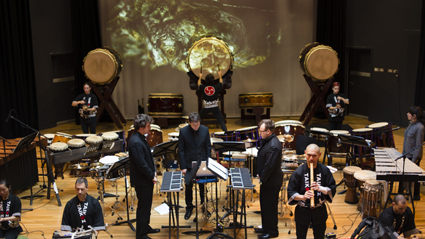
Pulse:Heart:Beat
photo Michael K Chin
Pulse:Heart:Beat
Sister ensembles TaikOz and Synergy Percussion combined for two nights at Angel Place City Recital Hall in celebration of kaleidoscopic city love in Pulse:Heart:Beat, a concert series that has run for longer than a decade. With more than 20 artists, four premieres, three films and the promise of “gorilla cinematography and animation” (program notes) I was thrilled to witness this collaborative hotpot if disappointed by the marked absence of anthropoid apes.
The concert was a celebration of rhythmic colour with references to Austrian waltzes, Japanese Hachijo-style drumming, French-Senegalese artillery, Sydney’s urban beauties, Punjabi bhangara and dirty universal dance beats. Knowing that this sort of musical smorgasbord could divide an audience, the groups were careful to frame their smashing of cultural and geographic barriers with the question, how on earth do we find intimacy in the maelstrom of modern life?
The concert was intimate despite the size of the venue and cultural turf traversed. At times, with Mike Chin aka Tokyo Love-In slinking his way around the stage, camera in hand, live images of the musicians shot from behind revealed to us new aspects of their experience.
Images by Chris Wilson, originally created for a collaborative work with Legs on the Wall in 2011 titled Beautiful Noise, accompanied Synergy Artistic Director Timothy Constable’s reworked composition Cannons of Navaro. Both the sounds and visuals were borrowed, revised, re-presented in the pursuit of new tradition. During Resounding Bell, a frequently recurring piece in TaikOz’s recent repertoire, there were stunning visuals from filmmaker Brad Kremer. An organic mass, ambiguously animal and vegetable, morphed in relationships with water and air as the meditative modal harmonies of two metalophones interwove under a shakuhachi melody.
Composed by Kevin Man and Kerryn Joyce aka Karak Percussion around 2003, Resounding Bell has been expanded to include an improvised shakuhachi solo by grandmaster Riley Lee and, later, a marimba solo, presumably added when Timothy Constable joined TaikOz on a regional tour in 2010. In Pulse:Heart:Beat composer Man played the shakuhachi solo in Lee’s absence, but rather than improvising a new one, he recreated Lee’s solo because it had come to form an integral part of the piece’s sound world. This highlights an important aspect of the way both TaikOz and Synergy approach innovation, consolidation and the time-frames in which these processes come to pass. They demonstrate with their practice that intimacy is achieved by continual application and adaptation to produce recognisable cultural objects in a lived tradition. In this sense, while experimental and challenging thematically, this program was homogeneous and representative of the ideals and nature of both groups.
In post-concert foyer chitchat, I overheard someone say, “TaikOz makes Synergy look like the poor cousin.” I couldn’t disagree more. Are athletes better than academics? Sure, TaikOz players flash their muscles and sweat true to the cultural signifiers that mark taiko, but they play with the same sensitivity and astounding precision as their relatively restrained, concert hall suited Synergy colleagues. If it is the visual aspect of TaikOz’s performance that trumps Synergy’s, then one could conjecture that those pieces featuring excellent quality films would have met the most positive response, but this did not seem the case.
While Synergy shone as a flexible percussion ensemble, this concert was a strange blend of TaikOz’s multiple musical personalities. A group specialising in traditional Japanese drumming that operates a bit more like a dance ensemble, TaikOz simultaneously inhabits the realms of the classical concert hall, pop festival stage, community drum workshop and corporate entertainment. In a brazenly honest offering, the groups presented their vulnerable and raw musical selves to the City Recital Hall audience.
Perhaps the bravest element of the program was the all-hands-on-deck realisation of young Anton Lock’s throbbing Rhythm River. This work featured Lock clutching a microphone in power stance out front while the full combined ensemble reproduced a dub-steppy pulse behind. Lock rapped, percussively spraying rhymes into a deliberately sparse aural backdrop. With all the enthusiasm of a high-school musical chorus, awkwardly aware of the powerful statement they found themselves making, the beat makers did not appear calm and cool enough to assure the Angel Place crowd that it was okay to participate in such a vulgar, contemporary form of music. Yet void of the verbal obscenity often associated with this form of performance, in fact making an offering of thanksgiving, Lock’s lyrics were uplifting. Nothing about his act was insincere. There was no empty bravado or rhetoric in place to hide a divide between philosophy and life lived. Lock stood, just as he is—rehearsed, dedicated, genuine—to deliver his vision for “freedom of expression.” To Lock, and as it seems for both Synergy and TaikOz, genre is but a site in which musical expression can emerge. This concept of incompletion, of fluidity, is what frees them to experiment with sometimes surprising collaborators, ideas and sounds.
For all its variety and experimentation, the program’s energy really took off only in the encores when the pressures of perfection and stamina had abated. The groups had memorised vast amounts of highly technical music, a cerebral feat not to be ignored or eclipsed by their fantastic displays of physicality. As tension lifted, so did the roof. The crowd, baffled though they were, could not help but be swept to their feet by the massive exchange of energy during rapturous encores. The charm snuck up on us…guerilla scintillation.
TaikOz and Synergy Percussion, Pulse:Heart:Beat, Synergy performers Timothy Constable, Bree van Reyk, Joshua Hill, young artist William Cedar Jackson, TaikOz performers Ian Cleworth, Graham Hilgendorf, Masae Ikegawa, Kevin Man, Kerryn Joyce, Anton Lock and associate player Sophia Ang, sound production Hugh Coffey, vision lead Tokyo Love-In, films Chris Wilson, Brad Kremar, Colin Rich, City Recital Hall, Angel Place, 28-29 June
RealTime issue #116 Aug-Sept 2013 pg. 50
© Felicity Clark; for permission to reproduce apply to realtime@realtimearts.net
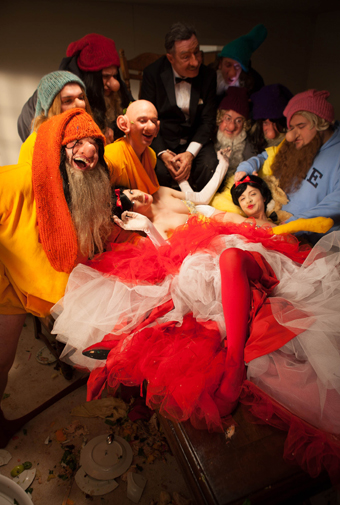
Paul McCarthy, WS, 2013, photo Joshua White
courtesy the artist and Hauser & Wirth
Paul McCarthy, WS, 2013, photo Joshua White
It was a Paul McCarthy fest in New York throughout July with three exhibitions including the massive work at Park Avenue Armory, WS, a psychosexual retelling of Snow White. No artist distills the excesses of American mass culture as McCarthy does. His infantile and excremental performances, full of repressed sexuality and latent violence, expose what really lies beneath the veneer of all those saccharine wholesome ‘family values.’
McCarthy has pushed against constructed notions of normality for the last 40 years. However nothing prepared me for the extremes of WS, which was elemental and primitive in its urgency, its sheer scale and excessiveness in direct proportion to the penetration of the Disney empire into the American psyche.
The Park Avenue Armory, set among exclusive apartments on the upper East Side, is a bizarre setting for the staging of a McCarthy exhibition: a clean and proper exterior for an out of control and messy interior. Entering the massive doors of the Armory, I am aware of the first of many of the skewed worlds that McCarthy offers. WS, or White Snow, is an inverted remix of Snow White, taking the form of a depraved, drunken house party, with McCarthy appearing in many of the video works as a Walt Disney figure or Walt Paul. The Snow White and the Seven Dwarves story, first remixed by Disney in 1937 from The Brothers Grimm original, is in McCarthy’s version, like The Grimms’, visceral and violent.
WS is an insanely ambitious work, including over seven hours of videos, all of which require multiple visits to get through, and a massive enchanted forest with over 50,000 artificial plants and towering trees that are entirely excremental in appearance. Set amid this forest is a recreation of McCarthy’s original, ranch style family home.
Taking over 85 trucks to transport it from McCarthy’s studio in Los Angeles, WS is on the scale of a Hollywood production, appearing like a soundstage, complete with visible camera crews, scaffolding and lighting rigs. McCarthy’s creation is another of his perverse versions of Hollywoodland. Recently the artist purchased over a 1000 acres of desert scrubland to recreate his own fucked-up western town—McCarthy’s Dodge City. I can’t think of any other artist who works on such an enormous theme park scale. His target is mass culture so the idea of more is more and bigger is better has a crazy logic to it. As Walt Paul exclaims in a fit of repeated frustration while in bed with White Snow, “Why does it have to be so big?” “Why does if have to be so big?”
One of the first elements one encounters in WS is sound, an overwhelming orgy of infantile groaning, occasional fits of laughter and screaming fill out the massive Drill Hall of the Park Armory, accompanying videos of Walt Paul, with chocolate sauce soiled underpants around his ankles, frantically screaming at his family of inbred cavorting dwarfs. Walt Paul appears at different times as father, lover, dictator and slave to White Snow. This is Disneyland on crack.
WS provides further weird viewpoints and inside-out spaces: massive billboard-sized video screens; secluded spaces with even darker video content; balcony views allowing one to survey McCarthy’s sprawling Disneyland from above; and views directly behind the massive video screens. These multiple vantage points are echoed in The Dwarf’s house. We peer in through the windows, viewing a crime scene: Walt’s demise, a broom handle shoved in his mouth and exiting his anus.
Such multiple viewpoints ensure the audience is made well aware of the artifice, the fakery of McCarthy’s sound stage. Ultimately he is making the point that mass culture is projected onto us, its reality a slippery construction. On leaving WS one could enter a deranged Disney gift shop, with all manner of Disney merchandise sprawled out over the room, crudely signed and editioned by Walt Paul.
McCarthy is the sublime king of perversion and WS a lasting testament that art doesn’t need to make you feel good about the world to be interesting. John Waters wanted to make films that made you feel dirty, McCarthy’s art makes you feel not just dirty but in need of a good hose down.
RealTime issue #116 Aug-Sept 2013 pg. 52-53
© Ian Haig; for permission to reproduce apply to realtime@realtimearts.net
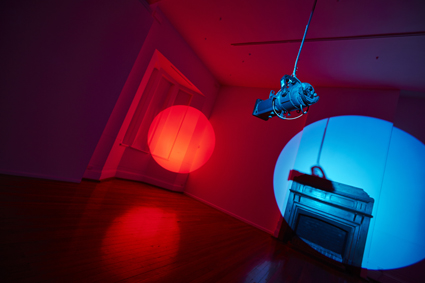
Michaela Gleave, A Day is Longer Than a Year
photo Jessica Wyld
Michaela Gleave, A Day is Longer Than a Year
Two theatre spotlights hang just above head height, throwing large red and blue circles onto the walls. The lights revolve incessantly, elongating into ovals as they move away from their sources, making unnatural eclipses as they pass through each other.
Michaela Gleave is an installation artist who has worked with artificial snow, balloons, fog, glitter and water. Her work forms part of the phenomenological turn in installation art that has for the last decade wanted to simulate nature inside the gallery. With only two lights, this installation is a more austere version of these immersive environments, its sharp poetics resembling the clean edges of 1960s minimalism. Yet nature is at play here too, as Gleave created this work out of a residency with the CSIRO’s Astronomy and Space Science Division.
Space research and minimalism have much in common. They share a fascination with the most elemental of forces and shapes. They share a coldness too, as these elements are indifferent to human fate. In Australia, space scientists work with the most distant of subjects, as they process data from the radio telescopes that dot the country. One of the most recent developments in deep space science is the detection of planets that are orbiting other stars.
The technique involves measuring a shift in the spectrum of starlight. A planet will wobble this spectrum and cause a star to become more red or blue. These are the colours that Gleave uses in her installation, their momentum shifting the shape of the spotlights moving on the walls.
It is as if we are at the centre of some deep space simulation, as Gleave conjures associations with the movement of planets and suns with the simplest of means. Yet the austere beauty of the work is also cursed by the kind of anthropocentrism that haunts space science. The attempt to find extra-solar planets, like the search for water on Mars, is deeply invested with the hope of finding another Earth in deep space. So too Gleave’s cosmic theatre returns us to ourselves, as we are trapped in the middle of the room, for fear of moving and throwing a shadow onto the orbit of lights. The installation turns into a kind of dark cinema that makes the space claustrophobic.
So it is that the cosmos, proving to be so indifferent to us, makes a troubling subject for art. It awes and repulses at the same time, fascinates and horrifies in its mathematical and glorious perfection.
This visitor wanted both something more and something less from this installation, for a sound to accompany the light, or a revolving chair to simulate an astronaut’s experience of the stars. Yet such comforts would move us beyond the subject of Gleave’s installation, which is the inherent austerity of space and time, and the beauty of light.
Michaela Gleave, A Day Is Longer Than A Year, Fremantle Arts Centre, Perth, 8 June–21 July
RealTime issue #116 Aug-Sept 2013 pg. 53
© Darren Jorgensen; for permission to reproduce apply to realtime@realtimearts.net
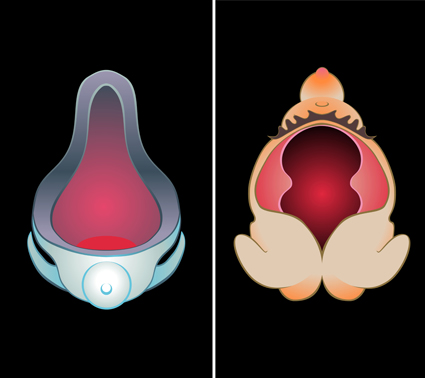
Colour Me Dead—Chapter 5: The Hungry Vagina (animation frame/s), 2013
courtesy the artist and Anna Schwartz Gallery
Colour Me Dead—Chapter 5: The Hungry Vagina (animation frame/s), 2013
The repressed violence inherent in the depiction of the female nude lies at the heart—or maybe the ‘vag’—of Philip Brophy’s substantial exhibition, Colour Me Dead. Traversing art history from the 18th century to the present, Colour Me Dead replays and recodes the naked female in digital animations, video and prints, creating a variegated and sometimes troubling field of reception.
The six works comprising Colour Me Dead parallel the first six chapters of a forthcoming book by Brophy, and indeed, can be ‘read’ as a logical, even educative, sequence. The first work, The Illuminated Nymph, introduces Brophy’s research, which has entailed forensic exploration of over 3,000 artworks. On the wall panel, 15 reference works are reproduced in small monochrome images—from Fuseli’s The Nightmare (1781) to Victor Brauner’s Nude and Spectral Still Life (1939). On a large circular screen, sketched sepia-toned renderings of the original paintings are the backdrop for cartoon versions of their bright-white female subjects, which morph into radiating spines of light, ultimately shattering. Brophy describes them as “flayed; the flesh is stretched and then pinned on a board.” Their transformation suggests both erasure and glorious ascension, too, as they transform into pure absence/pure light.
The Lady in the Lake again refers to a series of canonic artworks, this time revisiting the ‘woman-water equation.’ Four digital prints are bathed in refracting light like the surface of a pond. In each, a central nude stands in one swirling pool or another, flanked by accomplices or scenes of destruction. The first is Venus-like; the second, a siren; the third, a horrifying ghoul; the fourth, surrealist, truncated at the knees. It’s a path from allure to entrapment to the supernatural, with amputation as full stop.
In The Morbid Forest, the same premise applies to the moving image. The darkly sublime Romantic landscape is re-imagined in disconnected scenes, whose contents alarm by virtue of their juxtaposition. Two men dressed in black and camo-pattern stand in various bush locations; their passivity is menacing. Wraith-like females play ring-a-rosy, a child plays in fairy costume, a couple places a flower tribute at a deserted roadhouse. The sense of imminent threat is strong; and the connection between predatory, misogynist culture and the violence lurking in the artistic canon gains momentum.
In The Hungry Vagina, a triptych of deliciously lurid, animated abstractions—now focusing on the literal or symbolic vagina rather than the ‘whole’—open, close and mutate, accompanied by sticky, smacking, sucking sounds. It’s become a game of spot-the-reference (is that Duchamp’s urinal?). In The Sexualised Chimera, ‘pretty’ turns to ‘ugly’ as Brophy creates mock-up 60s-style ‘monster car’ designs: flaming, wheel-spinning mean machines possessed by cackling, claw-nippled or eyeball-popped Medusas and Judiths. In the catalogue Brophy points to “bong shops and heavy metal album covers,” where these hysterical “vulgar monsters” of Thanatos and Eros exist today. With these works I feel myself ‘buying in,’ embracing the aesthetic for better or worse. The threads seem to draw together, producing a bigger, blurrier whole.
I’m often troubled by the replication of sexist tropes in the name of illumination—all too easily it can seem like more of the same: same vagina-dentata, same conflation of woman/sex/death/nature, same monster-feminine. At times I experience this feeling, reluctantly, with Colour Me Dead. I embrace the work and the thesis with enthusiasm and yet find myself wondering, ‘Hang on, don’t we know this inside-out by now?’ I hunger (that ‘hungry vagina’ again, perhaps) for something more irreducible, disturbing, unsettling. It’s a deliberate strategy, Brophy says, to say it like it is (quoting, as it were): he invites the viewer, “to see…or not to see” the sexual violence that exists across the cultural gamut. Perhaps for the male viewer, this invitation might ‘prick’ a little more, hitting that disturbing pitch.
In The Prostrate Christ, Brophy’s narrative seems to reach that more subtle, complex space. A floor-projected video viewed from a platform features two artists’ models posing to replicate dead Christs, pietàs and prostrate figures, aided by two assistants. Echoing The Illuminated Nymph, the original paintings appear as backdrops, here projected behind the models. Brophy comments that the models were instructed to be ‘in control,’ even while being manipulated into position by the assistants. This results in a distinct uncanniness, as process, ‘nude’ and ‘person’ placed on the same plane, inextricable—‘de-composing’ in more ways than one. It’s a moment of relief: a discreet, plain wrapping that completes by allowing a more prosaic story—a space both within and without history, where the nude finally breathes.
Philip Brophy, Colour Me Dead; Ian Potter Museum of Art, University of Melbourne, 13 June- 8 September
RealTime issue #116 Aug-Sept 2013 pg. 54
© Urszula Dawkins; for permission to reproduce apply to realtime@realtimearts.net
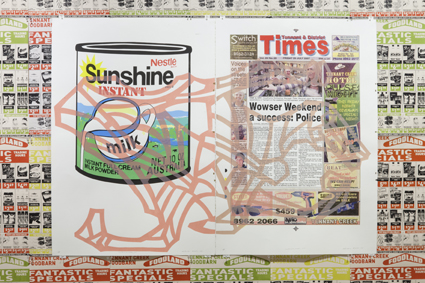
Janelle Low, Ghost Citizens
In recent years contemporary Indigenous art has focused on questions of identity, often personal identity, but with this exhibition, Ghost Citizens: Witnessing the Intervention, we see the return of broader political art about Indigenous Australia.
Along with a number of relevant extant works, the exhibition presents new artistic responses to the “intervention” into Aboriginal communities in 2007, currently named the Northern Territory Emergency Response (NTER), a legislative stripping away of the rights of a minority without regard for international Human Rights conventions along with suspension of Australia’s Racial Discrimination Act.
Ghost Citizens began as an intervention itself, shadowing the 2012 Sydney Biennale. By ‘supernatural decree’ the opening night party coincided with the passing of the legislation to extend the NTER—shockingly for the next decade, a young lifetime. Ghost Citizens, offering Indigenous artists from remote regions peer support, aimed to alert visiting international artists to the fact that not all Australian artists had equal rights. The Biennale curators and many artists attended talks by Eva Cox and Craig Longman from the Jumbunna Centre as well as Hetti Perkins’ launch of Artlink magazine’s “Indigenous Indignation” at Cross Art Project gallery. Income management and other controversial elements can now be applied to any part of the country—including places like Shepparton in Victoria—at the discretion of bureaucracies.
Speaking directly about the role of art in the current political climate, the exhibition draws on works by eight Aboriginal and five non-indigenous artists. Together they represent vast experience in the representation of contemporary Indigenous culture.
During a panel discussion accompanying the exhibition, curator Djon Mundine spoke of cycles in the process of recognition and engagement between white Australia and the Indigenous peoples with attempts at recognition beginning and building only to collapse as the possibility of recognition gets closer. This is followed by a period of retreat and non-recognition when the Indigenous become ghosts again—invisible, avoided and obscured from public gaze.
The bleak and barren Basic Card (2011), consisting of a blow-up banner and associated business cards from Brendan Penzer, displays the government’s new stamp of identity/non-identity. The bureaucratic imposition is emphasised in Penzer’s installation of a collection of sanitised literally white and “approved” supermarket food items and the print-out of the rules that welfare recipients have to live by. It’s a white bread and sugar diet.
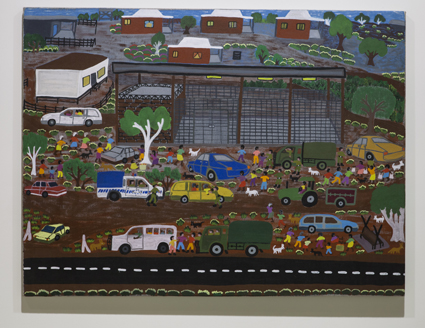
Kylie Kemarra, The Intervention at Ariparra Store, via Sandover Highway, Utopia Community, NT 2010, Ghost Citizens: Witnessing the Intervention
Counihan Gallery, Melbourne
Responses from Aboriginal artists living in remote locations include a painting by Kylie Kemarra titled The Intervention at Ariparra Store, via Sandover Highway, Utopia Community, NT 2010. Here Kemarra depicts troops and trucks herding people into a cage-like store area. Amy Napurulla and Sally MA Mulda paint ground level views of trucks bringing in the portable homes and offices for the new overseers.
The banal is made large in Alison Alder’s mural of grocery prices in newspaper ads from the Tennant Creek grocery, the only supermarket in the remote town. The ordinary looms large like a wall in the mechanics of daily living as the ads are overlaid with pages from the local newspaper that treat the Intervention as a non-event. Jason Wing’s self-portrait behind a government card labelled “Criminal” references the surveillance and digital monitoring [that form part of the intervention].
Therese Ritchie emphasises stigmatisation by stitching the Basic Cards into a gown modelled by Rachael McDinny in her large colour print All dressed up and nowhere to go (2012). Fiona McDonald’s text on landscape prints of Kurnell and of Captain Cook speak of inclusion and exclusion while Bindi Cole’s deeply ironic photographic portraits of people with blackened faces refer to a broader and often rejected Aboriginality.
The laconic left is represented by Chris Chips Mackinolty’s witty new road signs for the NT: And there will be no dancing (2007) and National Emergency Next 1,347,525 km (2007).
Video works include Fiona Foley’s Bliss (2006) featuring haunting images of poppies, referring to the opium supplied to Queensland Aboriginal communities [at the turn of the 20th century] creating addiction and [thereby] control. Other video works contain excerpts from dialogues between activists and artists at Sydney’s Cross Arts Projects.
Ghost Citizens is a collection that documents experiences of marginalisation, of people moved or pushed further to the fringes of Australian society by deliberate government bureaucratic experimentation. It also offers a view into what may be at the fringe of all our political worlds, a portent of wider political futures.
For Indigenous people living in remote areas with little political power, the intervention means discrimination and increasingly segregated and controlled modes of consumption; out of sight and out of mind—ghosts again.
Ghost Citizens: Witnessing the Intervention, curator Djon Mundine with Jo Holder, Counihan Gallery, Melbourne, 16 May-16 June; The Cross Art Projects, Sydney, 21 June-21 July
RealTime issue #116 Aug-Sept 2013 pg. 54
© Vincent Leveridge; for permission to reproduce apply to realtime@realtimearts.net
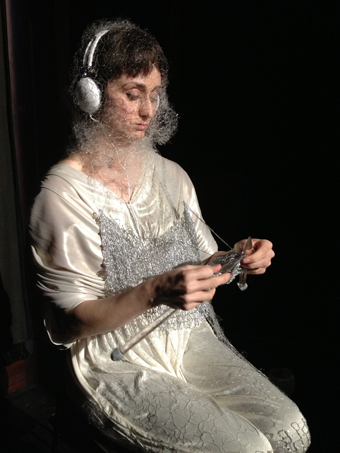
Naomi Oliver, exist-ence 5, Sydney
photo Tija Lodins
Naomi Oliver, exist-ence 5, Sydney
Kathyrn Kelly provides a detailed report on the festival performances in the Brisbane component of Exist-ence. Among a handful of performances in the Sydney iteration at PACT were two particularly memorable works that addressed time and effort in very different ways,
Across the evening, in Self Generating Tranquility Pod, Naomi Oliver sits in a bright pool of light just inside the entrance to the PACT performance space. Clothed in an encompassing white satin, headphones and boots that evoke, perhaps, someone preparing quite domestically for space travel—more inner space than outer—Oliver knits silver thread into a netted layer with which to further cover herself, like a caterpillar encasing itself prior to transformation. The performer’s stillness and concentration yield pleasant contemplation of the values of slow being, making and survival.
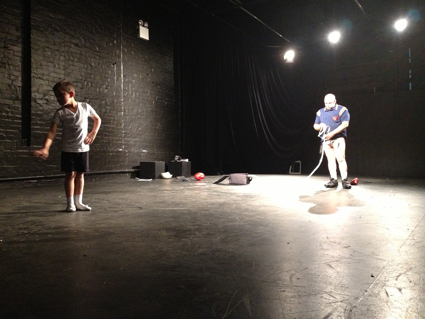
John G Boehme & Beauregard
photo Tija Lodins
John G Boehme & Beauregard
In Sport, performed in the rest of the space, the large-framed John G Boeme (Canada), garbed in a variety of sporting paraphernalia stamps around the stage in spiked shoes indifferently dumping sporting gear of all kinds on the floor while chewing seeds from which he perpetually spits kernels. His 10-year old son Beau ritually bounces a ball against a wall until his father/coach chalks up a target, wordlessly demanding accuracy. It’s the beginning of a series of tests before which the indolent master first demonstrates his own abilities, for example utterly smashing golf balls with violent drives. The boy can’t even connect with the ball.
Things turn more bizarre as the coach spouts platitudes from a self-improvement book (“Success is a marathon, not a sprint”) and, naked from the waist down save for a jock strap and protective cup, places two slabs of butter on his bald head and over them a porcelain helmet-like bowl while, gasping, he sucks oxygen from a tube. Initially the boy skips about (demonstrating balletic tendencies) until it’s indicated that he has to knock a ball off the top of his father’s head with a mini-baseball bat. But the odds against the ball remaining stable are enormous as butter and sweat run down the man’s face. Finally the bowl is abandoned and the ball whacked off his head. The end. Clearly Boeme has some issues with sport—about power relationships, parenting, ego and ludicrous goals. With expressionless ease father and son enact this memorable performance with a detachment that yields both suspense and the laughter of recognition.
Exist-ence 5, PACT Centre for Emerging Artists, Sydney, 19-20 July
RealTime issue #116 Aug-Sept 2013 pg. web
© Keith Gallasch; for permission to reproduce apply to realtime@realtimearts.net
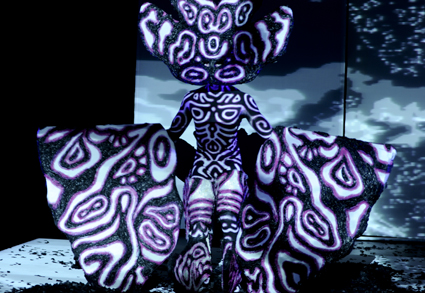
Justin Shoulder, The River Eats (2013)
photo by Heidrun Lohr, courtesy of Performance
Justin Shoulder, The River Eats (2013)
Performance Space’s Show Off season of performance featured a cluster of works including the already acclaimed and touring I’m Your Man (Rosalind Oades) and Opal Vapour (Jade Dewi Tyas Tunggal) alongside Team Mess’ Bingo Unit and Justin Shoulder and Collaborators’ The River Eats, both of which were well received in Next Wave 2012 in Melbourne. Each work confirms the increasing diversification of the means for making and the meanings of performance.
Justin Shoulder, The River Eats
Justin Shoulder is a beloved ‘underground’ talent from the Sydney club scene brought to light in Melbourne by Next Wave in 2012 and this year in Sydney by Performance Space. In The River Eats, aided principally by his masterfully designed masks and costumes (here synthesising gay excess with Kabuki clarity of line) this master of transformation mutates from a quivering bird-like creature to almost himself (largely naked, muscular, coated in brilliant pink), to an abject then defiant simian self and finally into something fishlike, a luminescent, striped exotic you might encounter in the Great Barrier Reef. This final creation in its patterned doublings of itself resonates with the fluid Rorschach imagery in the show’s recurrent screen projections. While the costumes are striking, the movement is only sometimes so, opening with a nimble Baroque bounce and concluding with the delicate wave-like settling and rising of a sea being; in between, and amid some performative longeurs, Shoulder’s steps made much less of his costumes and the work’s potential. Nevertheless he is magical, the very strangeness of his creations exhilarating, not least in their echoing of the design richness of evolution and the promise of its continuance in hybridity to come.
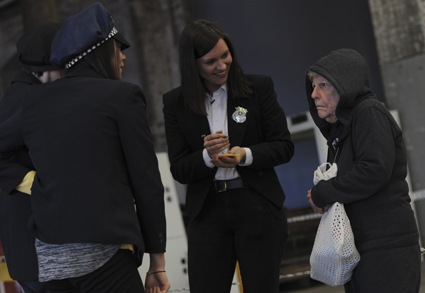
Team Mess, Bingo Unit (2013) The Discovery of the Body scene
photo Heidrun Löhr, courtesy of Performance
Team Mess, Bingo Unit (2013) The Discovery of the Body scene
Team Mess, Bingo Unit
Adroitly exploiting public familiarity with the TV crime detective genre, Bingo Unit is a fun entertainment powered by three engaging performers (Frank Mainoo, Malcolm Whittaker, Natalie Randall) who play key roles, wrangle the audience and, from time to time, improvise as audience members become interrogators, jurors or part of an identification line-up. Amusing pre-recorded improvisations include a series of pairs of non-performers playing policemen on stake-out, each couple inventively reacting to the sudden appearance of the same suspect exiting a house, wiping down and flourishing a heavy sword before tossing it in a bin (“He can’t recycle that!”). You witness these yourself by sitting in the stakeout vehicle on the stage floor, watching the improvisations on a monitor mounted on the car’s bonnet. Other taped improvisations feature detective briefing sessions, delivered by officers with blunt indifference to the horror of the crime.
Wandering about the performance space you can randomly attend a medical forensic session, kick a door in to apprehend a suspect, watch breaking non-news and an interview with the cagey woman (Wendy Blacklock) who found the body, inspect a bedroom with clues (or not) and attend an interrogation and a trial (in which the judge is Chris Haywood). Bingo Unit lacks the chill of the current wave of detective drama (The Killing, The Bridge and the Danish-influenced UK drama Broadchurch) and offers no particular insights into the genre (nor doubtless intends to) beyond our undying fascination with it. But its clever deployment of its participants, live and pre-taped, and its generation of live studio ambience surprises and engages. Doubtless the crime genre will manifest in the game-playing theatre Robert Reid described in RT115 (about which he will reveal an Australian dimension in RT117), with the audience playing an even greater role in solving the mysteries of life—or, as in Bingo Unit, revelling in the abundance of clichés we culture makers endlessly generate and perpetuate.
Performance Space, Show Off: Team Mess, Bingo Unit, creators Dara Gill, Frank Mainoo, Malcolm Whittaker, Natalie Randall, 10-13 July; Justin Shoulder and Collaborators, The River Eats, 3-13 July, Carriageworks, Sydney
RealTime issue #116 Aug-Sept 2013 pg. web
© Keith Gallasch; for permission to reproduce apply to realtime@realtimearts.net
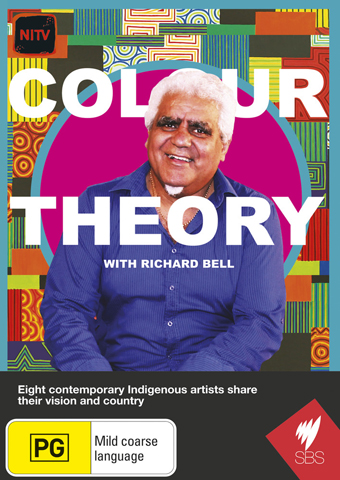
DVD: Colour Theory with Richard Bell
Leading Indigenous artist and provocateur Richard Bell is your amiable host for this excellent series from director James Marshall, producers Susan Moylan-Coombs and Jane Davidson and writer Hetti Perkins. The episodes are wonderfully unhurried, allowing artists to speak for themselves, for the viewer to absorb the art works and, critically, appreciate the country from which they evolved. The selection of innovative artists takes us into film and installation (Warwick Thornton, a wonderful episode, largely filmed in Alice Springs), street art (Reko Rennie), painting-photography (Nici Cumpston), stage design (Jacob Nash and the evolution of Bangarra’s Terrain), painting and sculpture (Tony Albert), sculpture and music (Archie Moore), weaving and sculpture (Vicky West) and exquisite glass sculpture (Yhonnie Scarce).
5 copies of Colour Theory courtesy of Madman Entertainment
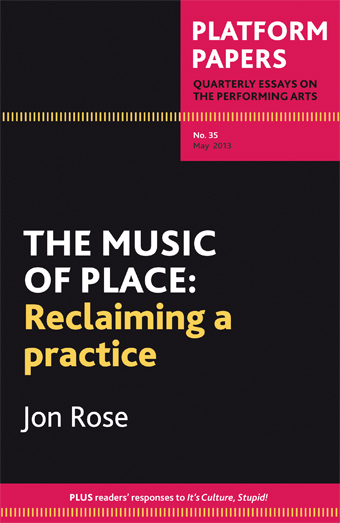
Platform Papers, No 35: Jon Rose, The Music of Place: Reclaiming a practice
This essay comprises a bracing alternative view of the history and nature of Australian music, underpinning an argument for the greater recognition and appreciation, aesthetically and in terms of financial reward, of Australian musicians. In his review of the essay, Julian Knowles writes, “Rose’s approach…closely resembles his prolific and influential musical output. His arguments demonstrate a lateral, creative form of thinking that challenges traditional understandings of history, culture and genre, resulting in a provocative collision of ideas out of which a powerful logic emerges” (see page 48).
3 copies courtesy of Currency House
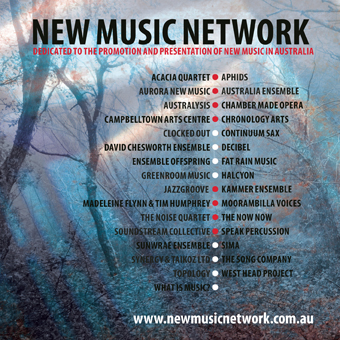
New Music Network: NMN 2013 CD Sampler
The 2013 NMN promotional 2CD set features vivid live and studio recordings of new and improvised works from 27 network members around Australia. You’re in for some surprises with radical gearshifts in tone and pace from track to track, bracing contrasts in instrumentation and works that range from fierce to reflective. The performers are some of the best exponents of Australian new music: austraLYSIS, Chamber Made Opera, Chronology Arts, Clocked Out, Continuum Sax, David Chesworth Ensemble, Decibel, Lawrence English with Aphids, Ensemble Offspring, Fat Rain Music, Halcyon, Kammer Ensemble, The Noise Quartet, West Head Project, The Song Company, Soundstream Collective, Speak Percussion, Sunwrae Ensemble, Synergy Percussion and Topology.
5 copies courtesy of New Music Network
Please note you can nominate for ONLY ONE GIVEAWAY.
Email us at giveaways@realtimearts.net with your name, postal address and phone number.
Include ‘Giveaway’ and the name of the item in the subject line.
RealTime issue #116 Aug-Sept 2013 pg. 56
© RealTime ; for permission to reproduce apply to realtime@realtimearts.net
With sonic variety and colourful instrumental exploration, the 5th of the International Computer Music Conference concerts prominently featured works for percussion and electronics. In Chatterbox, Oliver Bown [UK/AUS] and Miriama Young [UK] saturated the room with sound—from Raspberry Pis [credit-card-sized single board computers]—planted under the seating. Spatialised sine waves were juxtaposed with a wonderful, shimmering static layer. Chatterbox was imaginative, never losing itself to electronic music clichés.
In Giulio Colangelo’s THAUMA for two guitars and electronics, Vanessa Tomlinson and Louise Devenish drew their drum mallets and turned the hollow bodies of guitars into resonating sound blocks. Scraping and picking at the guitar surfaces, they brought out all the natural resonances of the instruments, which were amplified and thrown around Hackett Hall by Colangelo’s sophisticated electronics.
The first work utilising traditional percussion instruments was USA composer Dan Van Hassel’s Fzzl for snare drum and electronics. Van Hassel teased out the possibilities of the instrument’s seemingly simple body by electronically resonating the snare, delaying and spectrally morphing the band-like rhythms, shattering any presumptions the audiences had about the instrument.
American Seth Thorn’s Dahinterstehend for DrumKat explored percussion in the computer-generated realm. Vanessa Tomlinson hit a pad to created altered drum sounds that resonated out of Hackett Hall’s surrounding speakers. In an aleatory compositional method akin to those used by the New York school of Browne, Cage and Feldman, the timbre of the ‘drums’ changed according to how many times the pad was struck. Dahinterstehend had an interesting premise, which slightly missed out on being profound once the novelty of its system had run its course.
Red River, a work for bass drum, cymbal and electronics by Perth composer Sam Gilles, utilised the excessive sounds of the bass drum and cymbal to create electronic sound that resounded around the hall. While I feel that there could have been at times more adventurous writing, the spatialisation created a dark and rich sound world.
Using a cajon [percussion box] with electronics, Cort Lippe’s (USA) Duo seamlessly flowed between acoustic and electronic events. Charles Martin’s playing was vigorous, adding a wonderful sense of theatricality while drawing out every scrap of the instrument’s capabilities.
Inlovewithanothergirl.com, for snare drum and electronics, saw composer Rodrigo Constanzo scratching and scraping the skin of the drum with his fingers, producing exciting textures amplified through the surrounding speakers. While the ideas were interesting, a certain lack of control hampered the piece from reaching its full compositional potential.
The final piece of the night, US composer Jerod Sommerfeldt’s SamSara for vibraphone and electronics, created layers of sound by utilising the pure sounds of the vibraphone and spectrally manipulating them through the speakers. The layers created, however, often lacked subtlety, drawing attention to their generated nature and so diminishing the effects of a consistent sound world and structure.
Perhaps the most versatile concert in the ICMC series so far, this night of percussion and electronics saw a vast array of compositional strategies for some of the seemingly most basic instruments.
International Computer Music Conference & Totally Huge New Music Festival, Percussion and Live Electronics, Hackett Hall, West Australian Museum, 16 August
RealTime issue #117 Oct-Nov 2013 pg. 44
© John Barton; for permission to reproduce apply to realtime@realtimearts.net
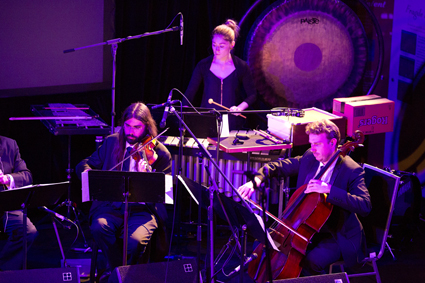
Decibel performing Alvin Curran’s Way Out Back
photo Brad Serls
Decibel performing Alvin Curran’s Way Out Back
Drawing attention to the relationships that constitute musical phenomena is crucial for Agostino Di Scipio, who opened the International Computer Music Conference with a critical discussion on the cybernetic relationships between musicians and technologies as shaped by the acoustic space.
In Di Scipio’s model of composition, the computer affects itself through the performer and the performer affects him/her self through the computer, transforming the acoustic soundscape. Di Scipio addresses these relationships in Condotte Pubbliche (Public Conduct/Conduits), an electroacoustic sound installation where the ambient sounds of visitors are filtered through two brass tubes fitted with two microphones and two earphones atop two loudspeakers feeding back the manipulated sounds via a laptop. This use of the acoustic space as an explicit object of the composition is reminiscent of Alvin Lucier’s 1969 composition I am Sitting in a Room .
Performed by Decibel, Di Scipio’s Texture/Residue (2006) for violin, cello, flute, bass clarinet and computer, explored the detritus of the classical repertoire by having the performers read Brahms without bowing or blowing to expose usually inaudible, rhythmic key taps and string scrapes. These sounds are fed back into the resonant spaces via computer processing, showcasing the underlying factors that bear heavily on any performance.
Alvin Curran’s keynote address was an eloquent call to arms for proponents of new music. Listing styles and influences like a beat poet he derided hackneyed occidental mentalities and business-as-usual compositional devices while recognising the difficulties for contemporary composers competing with the ubiquity of recorded musics of the past, a situation he admits the electronic artists of his generation helped to create.
Curran’s Way Out Back, commissioned and premiered by the Decibel ensemble, echoes the stylistic impasses of Western art music discussed in the composer’s address. The beginning of the work (a synchronised three-note, rhythmically displaced melody) sounds like an ironic take on minimalism. The rhythms fall apart then pick up again, climbing to a shrieking cacophony of murderous screams alongside piercing electronics and strings.
The Key Note: Works by Agostino di Scipio, Alvin Curran, Haco and Warren Burt, The West Australian Museum, 11 August
For Haco and Warren Burt’s performances see also Matthew Lorenzon’s account.
RealTime issue #117 Oct-Nov 2013 pg. 43
© Steve Paraskos; for permission to reproduce apply to realtime@realtimearts.net
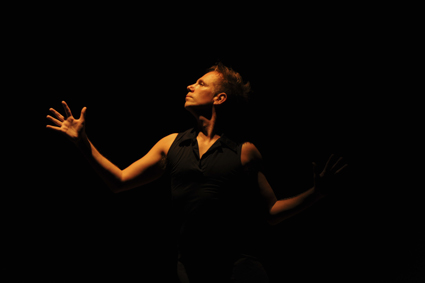
Martin del Amo, The Little Black Dress Suite
photo Heidrun Löhr
Martin del Amo, The Little Black Dress Suite
The ‘black dress’ is unparalleled in its iconic status as elegant, timeless, classic. One need only think of Audrey Hepburn in Breakfast at Tiffany’s to understand this powerful feminine symbol that shuttles between sexy and demure. So what is choreographer Martin del Amo doing with this fashion archetype in his direction of the four solos in The Little Black Dress Suite?
The threads are historical and cumulative. Del Amo attests that the little black dress emerged intuitively as a costume in three earlier works in very different contexts. It’s a potent, recurring element “reimagined” in this new suite of works through juxtaposition and gender disruption.
Each solo and instance of the little black dress varies in duration and musical accompaniment—noting grammatically that definite article ‘the’ refers to the single form/idea and not the use of one garment. One ‘dress’ is worn by Miranda Wheen in a collaboration with composer and musician Alex Pozniak. This relationship was established in 2012 under the direction of del Amo for Synchronicity, a co-production between Dirty Feet and Chronology Arts (see RT109). In redux, Wheen will again precariously “negotiate an imaginary environment of invisible forces” on high heels (another Del Amo symbol) in a tight, little black dress—the physical reality of her movement pushing against, yet tightening the image. In this tensile elaboration we can only ask: “is she appropriately dressed?”
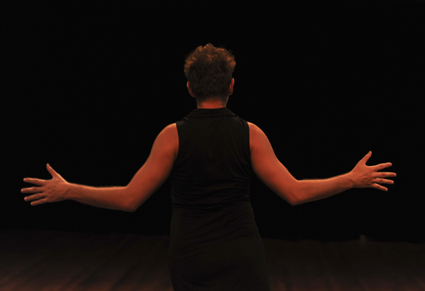
Martin del Amo, The Little Black Dress Suite
photo Heidrun Löhr
Martin del Amo, The Little Black Dress Suite
A second dress, worn by del Amo himself, was unleashed in all its Bob Fosse glory at Campbelltown Arts Centre in 2010. What Good is Sitting Alone in your Room was a tribute to the Master of Jazz. An incompatible aesthetic equation—del Amo and Fosse—but one balanced through likened compositional strategies (ie isolation of body parts). Del Amo in a cocktail dress is no transvestite. Dancing del Amo dissociates ideas of the feminine from the frock and his embodiment in order to make new.
Kristina Chan wears a third dress, more in the style of Wheen’s—tight and short. This will be a new solo, something along the lines of Jane McKernan’s powerful downstage finale from Slow Dances for Fast Times (2013, see RT114). Surprisingly this is the first time del Amo has choreographed Chan in a piece and ideally not the last.
Sue Healey presents a fourth and final dress, described by del Amo as “worn in the vein of the sassy.” Developed from scratch, this work consciously starts with the dress and is informed by its final position in the suite. Long-time chorographer Healey has recently appeared as a dancer on Sydney stages, including in a duet with del Amo for the IOU Dance 2 season at UNSW. Together they have been developing a regular studio practice, born from one of del Amo’s famous performative birthday presents to dancers.
The dresses connect the solos through a stylistic and symbolic unity. Each is moved, extended and worn differently. From this coherency of eclecticism (also a del Amo trademark) individual meanings can be massaged. Musically we can expect something similar, with compositions by Alex Pozniak (with Wheen) and Gail Priest (with del Amo), whose original pieces will be placed next to an operatic aria from Mozart (for Chan). Healey’s music co-conspirator (be they dead or alive) will be revealed on the night.
The solo is a fragile and difficult mode of performance. We demand of the solo performer an attention without slack; anyone who has seen del Amo perform will attest to very little slack. This acuity of attention can be seen in the several solos he has made on others: Miranda Wheen, Paul White and the 12 dancers in Slow Dances for Fast Times.
Del Amo speaks of “schizophrenic roles” inherent in creating solo performance work. Simultaneously performer, director, dramaturg and choreographer, he battles many voices that sometimes agree, sometimes don’t. When he choreographs others in a solo, it is not a ‘del Amo possession’ we see, but the transmission of his choreographic thinking—a subtle phenomenon not always transparent to an audience. The compositional strategies and organisation of the body are migratory structures that del Amo generously shares in workshops and the rehearsal room. The dancer moves within set parameters and scores, generating material as a unique product of their attention. It is the appearance of these structures across the many solos that marks the dancer with del Amo’s signature, the mobility of his thinking from one solo to the next—elegant, timeless, classic.
Form Dance Projects: The Little Black Dress Suite, choreographer Martin del Amo, performers Martin del Amo, Miranda Wheen, Kristina Chan, Sue Healey; composers Alex Pozniak, Gail Priest, Mozart, Lennox Theatre, Riverside, Parramatta, 15-17 August; http://form.org.au/2013/01/the-little-black-dress-suite/
RealTime issue #115 June-July 2013 pg. web
© Jodie McNeilly; for permission to reproduce apply to realtime@realtimearts.net
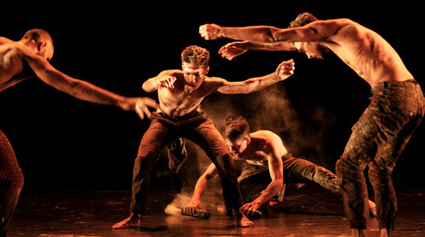
Hunter Page Lochard, Leonard Mickelo, Luke Currie Richardson, Daniel Riley McKinley, Blak, Bangarra
photo Greg Barrett
Hunter Page Lochard, Leonard Mickelo, Luke Currie Richardson, Daniel Riley McKinley, Blak, Bangarra
Choreographically and musically Daniel Riley McKinley takes Bangarra into new realms in Scar, a work focused on young urban Indigenous men who, without access to initiation rites, struggle to emerge into manhood (see the interview with McKinley in RT114).
Held together by a circle of unanimity and their shiny black hoodies the men reveal collective artistry, rising and dipping deep, sliding and stamping against the cry of didjeridu which soon takes on the buzz of a digitised world. The movement, textured with subtly integrated street dance gestures is free of overtly traditional Indigenous steps or Western contemporary dance moves.
A line forms, from which individuals break into athletic leaps and rolls until a siren sounds and the group scatters, like a gang on the run. Amid the breakout of fights and one man wielding a knife against others and then himself (performed with discombobulated brilliance by Waangenga Blanco), the youngest of the men (Hunter Page-Lochard) and the most observant, solos slowly and with great delicacy as if the one most self-conscious of the mysteries of achieving manhood.
Behind the action hangs what appears to be a huge bone, perhaps the traditional scarring tool of initiation denied these young men, but which still hangs over their psyches. An alternative ceremony emerges as the men remove their tops, shape them like weapons and, whiting up their faces and adding their voices to the soundtrack, they circle Page-Lochard, the bone above them now sparkling silver. The incantation of traditional songman Djakapurra Munyarryun soars, clearly spoken in Language, then becoming sung and didjerudi-like against a fast deep bass pulse and percussive techno-layering on a rising scale, the dancing ending as it began, in a circle with escalating energy and confidence, the youngest breaking into his own dance—a symbol of individual maturation in a powerful collective. The supple Page-Lochard excels, his dancing enhanced with additional layers of telling detail.
Paul Mac’s hard-edged score, created with David Page, is an antidote to Page’s broad, often synth-driven hyper-melodic themes. The two composers merge urban and traditional musics into a satisfying and atypical score for Bangarra, true to the challenges facing the men in Scar. If not traditional initiation, Scar at least proposes the importance of some kind of ceremony, physically or psychologically, for a lost rite of passage.
Stephen Page’s Yearning, created with the female dancers of Bangarra, is typically lyrical, cleanly symmetrical, contemporary Western dance infused with traditional shuffling and hopping in the circling and clustering of the earthed first part. Other scenes are more literally dance theatre episodes focused on domestic violence, suicide and constraints on Indigenous identity. In the most strikingly choreographed and staged scene, a TV monitor flickers with white static on one side of the stage while on the other deep yellow light and shadow wrap around three dancers who sink and rise up as if tormented, a voiceover intoning “I feel nothing.” The dancers struggle to support each other. A final angry “No!” leaves the trio immobilised. In the final scene, a radio program asks, “Who is Aboriginal and how can they be identified?” The dancers in line hang their heads low and move with sinuous angularity, their collective centre of gravity lowering until they sit, looking out at us. Surtitles for the recorded passages of Language and Aboriginal English were not provided, making some of the critical situations faced by the women quite unclear.
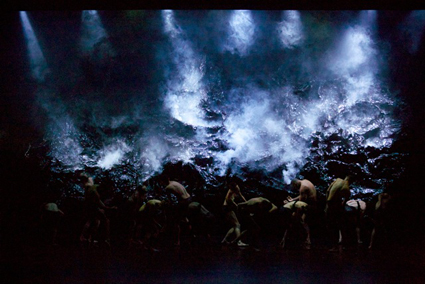
Blak, Bangarra
photo Greg Barrett
Blak, Bangarra
Keepers, the third work in Blak, a joint creation by Page and McKinley for the whole company, benefits from a magnificent set design, a vast rocky wall before which, in an overarching sense of ceremony, the dancers tuck into themselves, unfold and display their dancing prowess. The rock face glows and smokes, suggesting the primal power of the land, pulling the swaying dancers to it, its presence amplified by the sound of ‘ancient’ voices and a pulsing beat (Page with Mac). The dance becomes celebratory with heterosexual pairings creating images suggestive of procreative power. With a glance back to Scar, Lochard-Page cuts a singular figure in this adult world. Finally the steaming rock and the exhilarated dancers are cooled by cascading rain—a waterfall of well-being.
Once again, Jacob Nash proves himself to be a truly inventive designer, complemented by Luke Ede’s spare costuming and Matt Cox’s acute play with light. Blak, a popular and critical success for Bangarra, signals a tension between a Bangarra style that has not substantially progressed in recent years and indications of new possibilities—in McKinley’s more contemporary dance vocabulary, in moments in Page’s Yearning, and in the music for Scar.
Bangarra Dance Theatre, Blak, Drama Theatre, Sydney Opera House, 7-29 June
RealTime issue #115 June-July 2013 pg. web
© Keith Gallasch; for permission to reproduce apply to realtime@realtimearts.net
A super loop to tide you over till late August while we’re pumping out the RT116 Arts & Education edition.
Darwin Festival
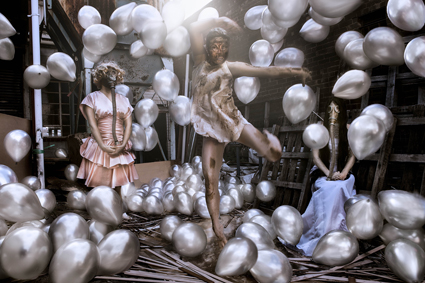
DasSHOKU SHAKE!, Yumi Umiumare & Theatre Group GUMBO
photo Vikki Shayen
DasSHOKU SHAKE!, Yumi Umiumare & Theatre Group GUMBO
If Spring is taking too long to come to you head north to Darwin and take in the festival. Yumi Umiumare presents the latest work in her DasSHOKU series, DasSHOKU SHAKE!—an absurdist Butoh cabaret created with Theatre Group GUMBO from Japan. Queensland ensemble Polytoxic present their site-responsive performance/installation Trade Winds down at the waterfront. Several touring works land in Darwin: Roslyn Oades’ I’m Your Man, Shaun Parker’s Happy as Larry and Ilbijerri Theatre Company’s Jack Charles vs the Crown. Darwin’s own Tracks Dance Company will present a new work, Zombies in the Banyan Tree, creating “a world of opposing forces, where popular culture and tradition collide” (website). RealTime Managing Editors Keith Gallasch and Virginia Baxter will also be in town reporting on the festival and conducting a workshop with local writers.
Darwin Festival, 8-25 August; www.darwinfestival.org.au
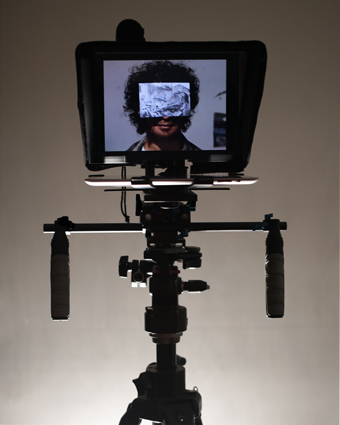
Hydra Poesis, Prompter
photo Sete Tele
Hydra Poesis, Prompter
Arts House Season 2
The second half of the year at Arts House, North Melbourne Town Hall is populated with many wonders. Kicking off the season is Prompter by Perth company Hydra Poesis, an ambitious work of “magic-political-(quasi-science-fiction)-realism” (website) involving dance, performance and broadcast (9-18 Aug; see RT97). Side Pony Productions presents The Confidence Man, a Hitchcockian tale acted out by the audience in large masks with headsets (28 Aug-Sept 1). Olaf Meyer works with the building itself in his projection installation Permanent vs Impermanent 2 (28 Aug-2 Sept). Later in the season there are multiple Melbourne premieres: Roslyn Oades’ I’m Your Man (4-8 Sept, see RT107); Branch Nebula, Matt Prest and Clare Britton’s Whelping Box (4-8 Sept, see RT112); Ilbijerri, Belvoir and Version 1.0’s Beautiful One Day (26 Nov-1 Dec) and Andrée Greenwell, Jordie Albiston and Abe Pogos’ music theatre work The Hanging of Jean Lee (7-8 Dec, see the 2006 RT73 interview and RT75 review). There’s also the world premiere of Stephanie Lake and Robin Fox’s A Small Prometheus as part of the Melbourne Festival (15-20 Oct). To round it off the forum Is Art for Art’s Sake? looks at participatory performance making (13 Sept).
Arts House, North Melbourne Town Hall and Meat Market, August-December; www.melbourne.vic.gov.au/artshouse
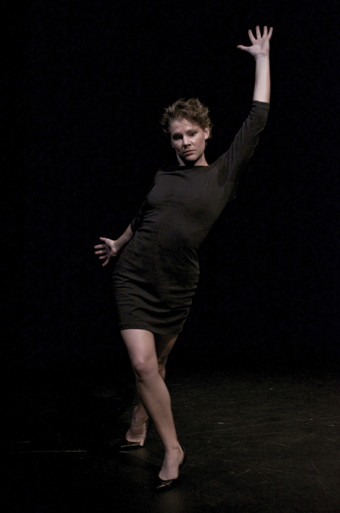
Miranda Wheen, Vitality, Dirty Feet & Chronology Arts
photo Heleana Genaus
Miranda Wheen, Vitality, Dirty Feet & Chronology Arts
Vitality, Dirty Feet & Chronology Arts
Focused on creating opportunities for emerging practitioners these two companies have come together to investigate the relationship between choreographer and composer. Quest, the result of the collaboration between Martin del Amo and Alex Pozniak and performed by Miranda Wheen, was well received during Aurora 2012 (see RT109 and is getting the redux treatment in the upcoming The Little Black Dress Suite, see our Martin del Amo interview). There are also new pieces by the collaborative teams of Kathryn Puie working with Daniel Blinkhorn and Sarah-Vyne Vassallo with Andrew Batt-Rawden.
Vitality, Dirty Feet & Chronology Arts, Seymour Centre, 8-10 August; http://www.seymourcentre.com/events/event/vitality/
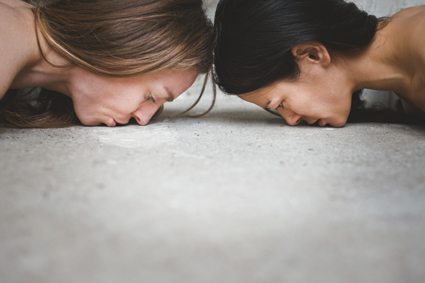
Floored, Victoria Chiu (with Amelia McQueen)
photo Lucy Spartalis for Dancehouse
Floored, Victoria Chiu (with Amelia McQueen)
Floored, Victoria Chiu, Dancehouse
Current Dancehouse Housemate Victoria Chiu is about to reveal the results of her labours in Floored. A duet danced by Chiu and Amelia McQueen with sound by Roland Cox, Floored investigates our need for comfort and the slippery-slide into complacency. Chiu trained at the VCA and has worked with choreographers Fiona Malone and Berndate Walong as well as performing and creating works in Geneva, Switzerland.
Floored, Victoria Chiu, Dancehouse, 14-18 August; http://www.dancehouse.com.au/performance/performancedetails.php?id=163
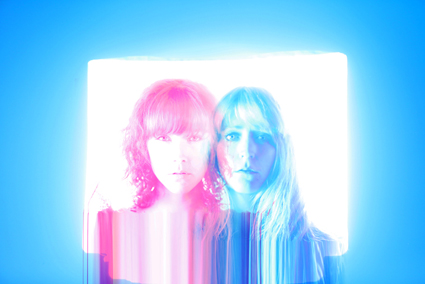
Hedda, This One Show & The Blue Room Theatre
Hedda, This One Show & The Blue Room Theatre
Currently based in Perth, Norwegian actress Marthe Snorresdotter Rovik feels that the current English translations of the Ibsen classic Hedda Gabler are missing something. Actor/director Renato Fabretti and Rovik are producing their own version in which Rovik says she wants to show Hedda as “Ibsen intended. Not a victim, nor an icon for feminist revolt, but a complete woman making a decision about how she will live her life within her circumstances” (press release). Sections of the dialogue will be spoken in Norwegian to convey the emotional intensity of the play’s original language.
This One Show, Hedda, The Blue Room Theatre, 3-31 August; http://blueroom.org.au/
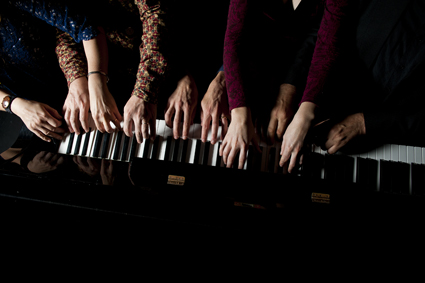
Topology, Ten Hands
courtesy the artists
Topology, Ten Hands
Ten Hands, Topology
Brisbane-based ensemble Topology has just released their 10th album and will be touting their CD wares in a series of not to be missed concert launches in Sydney, Melbourne, Buderim and Brisbane. The album Ten Hands has been collectively composed by the five musicians over the last four years through a process of improvisation and distillation. Violinist Christa Powell says, “When we first got together we were individuals and we’ve spent this many years…getting to know each other. And this piece collectively is an entity” (press release).
Topology Ten Hands Tour: Sydney, Camelot Lounge, Marrickville, 4 August; Melbourne, Chapel Off Chapel, Prahran, 11 August; Brisbane Powerhouse, New Farm, 15 August; Sunshine Coast, Matthew Flinders Performing Arts Centre, Buderim, 1 September; http://www.topologymusic.com/
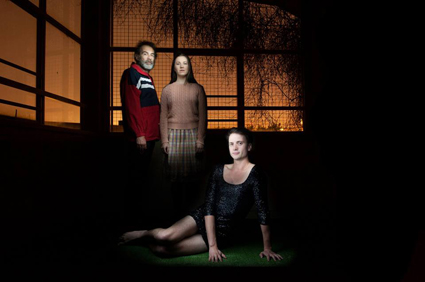
Stuck Pigs Squealing, Night Maybe
photo Sarah Walker
Stuck Pigs Squealing, Night Maybe
Stuck Pigs Squealing, Night Maybe
Melbourne ensemble Stuck Pigs Squealing’s latest project, Night Maybe, follows Sasha, a girl abandoned on the side of the road by her brother. Her search to find him “peels back the layers of their shifting relationship; past the unreliability of gender, sexuality and both their bodies” (website). Directed by Luke Mullins and written by Kit Brookman the collective promise a “free-fall through the subconscious.”
Stuck Pigs Squealing, Night Maybe, TheatreWorks 15 August-1 September; http://www.theatreworks.org.au/whatson/event/?id=182
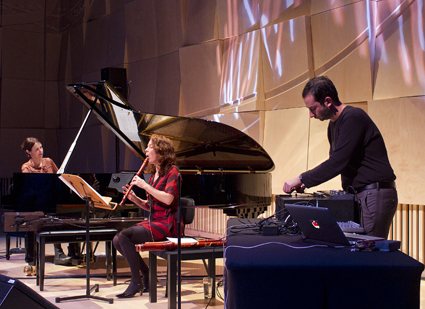
Three Lanes, Andrea Keller, Genevieve Lacey, Joe Talia, Capital Jazz Project
courtesy the artists
Three Lanes, Andrea Keller, Genevieve Lacey, Joe Talia, Capital Jazz Project
Capital Jazz Project, Street Theatre
As part of Canberra 100 celebrations, ANU School of Music and the Street Theatre are presenting the Capital Jazz Project featuring over 90 concerts in 10 days. Intriguing groupings include Three Lanes with Andrea Keller on piano, Genevieve Lacey on recorders and Joe Talia on Revox B77, electronics and percussion (7 Aug); The Tawadros Brothers—Joseph on oud (Aarbic lute), James on raq (Egyptian tambourine)—with Steve Hunter on electric bass (4 Aug); and artists-in-residence, The Raah Project, “investigating cross-pollination between diverse modern music genres” (program) performing with a 20-piece ensemble from the ANU School of Music (10 Aug).
Capital Jazz Project, presented by Canberra 100, Street Theatre and ANU School of Music; 2-11 August; http://www.thestreet.org.au/
![Soda_Jerk, The Phoenix Portal [2005]](https://www.realtime.org.au/wp-content/uploads/art/68/6806_loop_sodajerk_phoenix.jpg)
Soda_Jerk, The Phoenix Portal [2005]
courtesy the artists
Soda_Jerk, The Phoenix Portal [2005]
Dark Matter, Soda Jerk
Movie mash-up mavens Soda Jerk (Dom & Dan Angeloro) have been investigating “the speculative hypothesis that a form of dark matter pervades the star systems of screen culture” (website). This exhibition brings together three of their latest installations in which stars confront their past, present and future selves.
Soda Jerk, Dark Matter, UTS Gallery, 30 July-30 August; http://www.art.uts.edu.au/gallery/current/index.html
Totally Huge New Music Festival
A reminder that the biennial celebration of exploratory music is about to take over Perth, this year also incorporating the International Computer Music Conference. Read RT115 interview with director Tos Mahoney for more details on guests Haco, Alvin Curran, Agostino di Scipio, Speak Percussion, Decibel and Clocked Out. Matthew Lorenzon, who presents the new music blog Partial Durations with RealTime, will be on the ground in Perth reviewing performances for the full duration of the festival as well as mentoring emerging music reviewers.
Tura: Totally Huge New Music Festival; 9-18 August; www.tura.com.au
Ian Potter Cultural Trust 20th Anniversary
The Ian Potter Cultural Trust has given out over 1200 grants in its 20 years of existence. To celebrate the trust is throwing a gala ball and is inviting every one has been a recipient. However IPCT has lost track of some of you. If you’ve received funding from the organiation in the past, check out this link on the website and update your details so IPCT can let you know of all the upcoming celebrations.
http://www.ianpotterculturaltrust.org.au/desperately-seeking
Still in the loop
Janis II, The Commercial Gallery & MCLEMOI Gallery
26 July-17 August
www.thecommercialgallery.com http://mclemoi.com
Owen Wingrave, Sydney Chamber Opera
Carriageworks, 3, 5, 7, 9, 10 August
http://sydneychamberopera.com
Shilpa Gupta, MAAP Space
27 July-30 Aug
www.maap.org.au/
Suburban, Ian Strange
NGV Studio, 27 July-15 September 2013
www.ngv.vic.gov.au
Russian Resurrection Film Festival
Sydney, Chauvel Paddington & Event Cinemas Burwood, 24 July-7 August; Brisbane, Palace Centro, 26 July-4 August, Perth, Cinema Paradiso, 1-11 August; Byron Bay, Palace, 2-4 August
http://russianresurrection.com/
SALA
various venues across South Australia, 2-25 August
http://www.salafestival.com/
NMN:Tangents And Cycle ~440
Sound Lounge, Seymour Centre, 1 August
http://www.seymourcentre.com
Winter, Arts Centre Melbourne
from July 27-18 August
artscentremelbourne.com.au
White Rabbit, Red Rabbit, Malthouse
23 July-3 August
www.malthousetheatre.com.au
Here&Now13, Lawrence Wilson Gallery
27 July-28 September
www.lwgallery.uwa.edu.au; www.dadaa.org.au/
TeleScope: Visions from the EU, online screenings
Melbourne International Film Festival
25 July-11 August
http://miff.com.au/program-categories/telescope
Fraught Outfit, Persona
Belvoir, 24 July-18 Aug
http://belvoir.com.au
Live and Deadly, Carriageworks
27 Jun-1 Aug
http://www.carriageworks.com.au/?page=Event&event=LIVE-AND-DEADLY
My Country, I Still Call Australia Home: Contemporary Art from Black Australia
Queensland Art Gallery/Gallery of Modern Art, 1 June-7 October
http://www.qagoma.qld.gov.au/exhibitions/current/my_country
Helium Season, Malthouse
8 June-5 Oct, see website for following productions
www.malthousetheatre.com.au/helium-2013/
Finucane & Smith’s The Glory Box…Paradise
45 Downstairs, Melbourne, 10 July -11 August
http://www.fortyfivedownstairs.com/events/
RealTime issue #115 June-July 2013 pg.
© RealTime ; for permission to reproduce apply to realtime@realtimearts.net
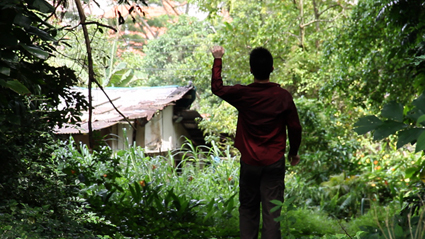
Sarah Kaur, 2011 Resident, Singapore, still, Kampong Buangkok, featuring Guohui Chen
Asialink Arts Residency Program
Applications are now open for Asialink’s program which offers artists and artworkers three-month residencies in a range of Asian countries. There are a number of established relationships with host organisations or artists may initiate their own residency-host arrangements with arts organisations in specified countries.
Deadline 30 September, http://asialink.unimelb.edu.au/arts/residency_program/2014_asialink_arts_residency_program_application_information
MONA Scholarships
Another of the many things that MONA [Museum of Old and New Art, Hobart] has done to invigorate the cultural life of Tasmania is the MONA Scholarship. It provides an emerging Tasmanian artist with $12500 to buy materials and equipment to present an exhibition at MONA in the Library Gallery. MONA also selects one piece of work for its permanent collection.
Applications close 23 August; http://www.mona.net.au/scholarship
Gasworks Midsumma call for works
Gasworks is now calling for applications for productions to take place as part of the 2014 Midsumma festival celebrating queer culture running 12 Jan to 2 Feb. Some shows meeting certain conditions may be eligible for discount hiring rates.
Applications close 16 September; http://www.gasworks.org.au/applications-for-midsumma-2014-eois-now-open
2013 Expanded Architecture at the Rocks
The Expanded Architecture team and Rocks-Pop-Up project is calling for “spatial art practitioners (artists & architects) to undertake a one month residency which will culminate in an exhibition, catalogue and symposium as part of Sydney Architecture Festival. Proposals are sought for projects that draw on the Rocks as site but can be exhibited in the indoor Rocks-Pop-Up site (yet to be confirmed). Academic papers are also being called for.
Applications due 26 August; http://expandedarchitecture.com/
Still in the loop
Metro Screen Seminars
Are You Indigenous And Want To Work In Film And TV? information session, 6 August; Story World Seminar, 9 August
http://metroscreen.org.au/7-events-opportunities-you-dont-want-to-miss/
2high Festival 2013 Artist Call Out
Applications close 16 August
http://www.backbone.org.au/2high-festival.cfm
Bundanon Artist Residencies
Applications close 2 August
www.bundanon.com.au/content/residencies
PauseFest
Registration and final design submission August 15
http://pausefest.com.au/download_docs/pausefest2014_eoi_details.pdf
Tele Visions, call for screen works
Applications close 29 August
http://televisionsproject.org/
Australia Council upcoming deadlines
(for full list see http://www.australiacouncil.gov.au/grants)
Emerging and Experimental Arts: Creative Australia – New (Art Creative Development), 01 August 2013
http://www.australiacouncil.gov.au/grants/2013/inter-arts-creative-australia-new-art-creative-development
Theatre: Cultural Leadership Skills Development, 5 August 2013
http://www.australiacouncil.gov.au/grants/2013/cultural-leadership-skills-development-theatre
Theatre: New Work, 5 August 2013
http://www.australiacouncil.gov.au/grants/2013/theatre-new-work
Theatre: Fellowships, 5 August 2013
http://www.australiacouncil.gov.au/grants/2013/theatre-fellowships
Creative Australia – Emerging Presenter, 12 August 2013
http://www.australiacouncil.gov.au/grants/2013/Creative-Australia-Emerging-Presenter
Creative Australia – New Digital Theatre, 12 August 2013
http://www.australiacouncil.gov.au/grants/2013/Creative-Australia-New-Digital-Theatre
International Markets – Music managers (Previously Live On Stage – Music Managers). 14 August 2013
http://www.australiacouncil.gov.au/grants/2013/international-markets2-music-managers-14-aug-2014
Dance: Artform Development, 16 August 2013
http://www.australiacouncil.gov.au/grants/2013/dance-artform-development
Dance: Fellowships, 16 August 2013
http://www.australiacouncil.gov.au/grants/2013/dance-fellowships
Dance: Projects – Creative Development, 16 August 2013
http://www.australiacouncil.gov.au/grants/2013/dance-projects-creative-development-16-august
Dance: Projects – Presentation, 16 August 2013 http://www.australiacouncil.gov.au/grants/2013/dance-projects-presentation-16-august
Dance: Creative Australia – New Work, 16 August 2013
http://www.australiacouncil.gov.au/grants/2013/dance-creative-australia-new-work
Visual Arts: Skills and Arts Development – Residencies, 19 August 2013
http://www.australiacouncil.gov.au/grants/2013/visual-arts-skills-and-arts-development-residencies
Visual Arts: Presentation and Promotion, 21 August 2013,
http://www.australiacouncil.gov.au/grants/2013/visual-arts-presentation-and-promotion
Visual Arts: Skills and Arts Development – General, 21 August 2013
http://www.australiacouncil.gov.au/grants/2013/visual-arts-skills-and-arts-development-general
RealTime issue #115 June-July 2013 pg. web
© RealTime ; for permission to reproduce apply to realtime@realtimearts.net
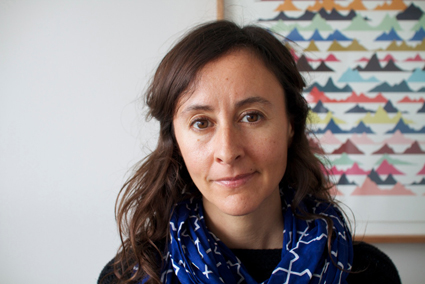
Nat Cursio
photo Pete Brundle
Nat Cursio
Natalie Cursio has assumed many roles over the years: dancer, choreographer, international collaborator, teacher, mentor, creator and curator. As well as making her own work, she has inaugurated a number of projects around dance in innovative settings.
For example, in 2010, she created Private Dances (Next Wave Festival), where one person would watch another perform inside a series of tents (see RT98), for which she won a Green Room award (Best concept and Realisation). She is currently Choreographer in Residence at the Newport Substation, where she is about to show a new work, Blizzard.
There’s nothing obvious about Cursio’s new work Blizzard that shouts Green. And yet Cursio speaks of Blizzard in relation to the planet, as a plea for care towards our dwindling bio-diversity. Her perspective is intriguing, relating to what she calls the “rawness” of the work, that is, its lack of artifice and theatricality. Through keeping the work raw, Cursio means to distil our attention towards the dancing and its sensory milieu: no music nor fancy lighting, just three bodies at work.
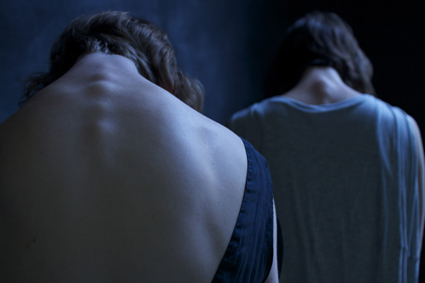
Blizzard, Nat Cursio Co
photo Nat Cursio
Blizzard, Nat Cursio Co
It’s not a big thing, dance. I am regularly struck by the fact that, digital work aside, dance is ultimately and always about the body. The greatest star might take the stage, but their medium is still their own body. Perhaps it’s this smallness which reminds us of the need for care. The audience must come to the work, paying attention to its quiet intensity. Cursio wants her audience to work on their experience rather than have it served to them on a plate. As a reminder that perception is a two-way deal, Blizzard, begins with an extended section that calls for eyes closed on the part of its audience.
We are in the old Newport power (sub)station, in a massive room flanked by epic windows, red bricks and a wooden floor. The train station is nearby. Cars pass, sounds of the city swell. Shuffling noises approach then fade. I cannot see what the dancers (Alice Dixon, Melissa Jones, Caroline Meaden) are doing but I can hear them. Their bodies are mechanisms for producing sound. My body is alert. Their movement provokes a kind of Doppler effect, consistent rhythms which perceptually vary according to their proximity to the observer. I feel them approach and retreat. Sitting in self-imposed darkness draws attention to my own body as mediator or rather receptor of the work. If vision launches itself into the world, hearing recoils towards home base. The dance is a cipher, muffled in the darkness.
When I open my eyes, there is a sense of familiarity as well as novelty, like meeting a relative for the first time. This is an unadorned piece. Cursio calls it raw but it is equally cooked. Blizzard was initiated in 2011 as an invitation from the three dancers who wanted some mentorship and direction from Cursio. Blizzard developed out of a series of improvisations by the dancers. Over time, Cursio became choreographer, working with a 20-minute section of improvised material as a basis for the work.
There is a feeling that the dancers retain a close relationship to their material. It belongs to them. That said Cursio sees her role as taking responsibility for the piece as a whole—to assume a global perspective—while the dancers retain responsibility for their own performative relation to the choreography. Hence a gentle enquiry from Cursio regarding their experience eking out the work after such a long break. The conversation is quietly geared towards some reflection on the part of the performer; how can I be present to this choreography, alert to its elements, stay involved in its minutiae? The dancers articulate their experience of the run-through. The task ahead is to find a way back into the choreography that sustains its complexity. That way may differ for each dancer. They recognise their mutual differences in approach. There is no effort to iron out these differences. Rather what is important is for each in their own way to find the depths of the movement, to stay in touch with the sensory present and to flesh out their own attention.
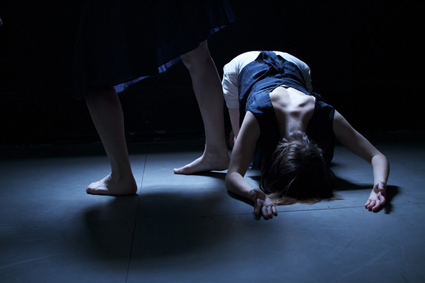
Blizzard, Nat Cursio Co
photo Nat Cursio
Blizzard, Nat Cursio Co
I won’t tell you what it looks like. I only viewed the beginnings of the last rehearsal period. One hint (hopefully not a spoiler) is that the audience will be seated in a circle. I mention this because of the ethical dimension of Cursio’s working with her dancers, that there is a kind of flow between them which manifests a certain kind of care. It would not be possible to make a work to inspire care on the part of humanity without practising that as a means of production. The circle signifies a kind of holding pattern, to be traversed by the dancers.
Things to come? Cursio has been commissioned as one of the artists for Carriageworks 24 Frames Per Second. She will also be performing solo (for the first time in a decade) in her own apartment in The Middle Room as part of Theatreworks’ ENCOUNTER(S) season in December. In development are Recovery, a work about grief and endurance performed with Shannon Bott and directed by Simon Ellis and the hilariously titled John Utans Was My Teacher (he was, so wait for that one), created by Cursio with Utans, Don Asker, Fiona Bryant and Tamara Saulwick.
Nat Cursio Co, Blizzard, The Substation, Newport, Melbourne, 30 July-4 Aug; http://www.natcursio.com
RealTime issue #115 June-July 2013 pg. web
© Philipa Rothfield; for permission to reproduce apply to realtime@realtimearts.net
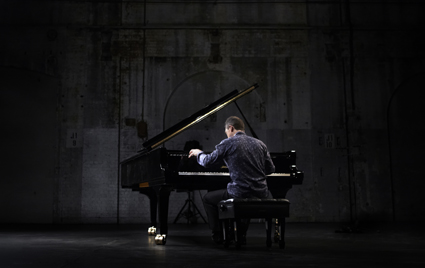
Michael Kieran Harvey, 2013, Carriageworks
photo Zan Wimberley
Michael Kieran Harvey, 2013, Carriageworks
At the end of Michael Kieran Harvey’s concert of three demanding Australian works for piano, played without an interval, I wandered onto the stage with curious others from the enthusiastic audience to inspect the magnificent Shigeru Hawai grand piano with which the pianist collaborated to produce sound on an orchestral scale. Harvey, his shirt sweat-drenched, had left the stage, looking pleased if somewhat frayed, providing only one curtain call while the audience clapped for more. I inspected the keyboard—no blood.
As a child I saw Cornell Wilde as the consumptive Chopin in the hugely popular, clunky biopic A Song to Remember (1946) coughing up blood mid-performance, Tyrone Power as popular American pianist and band leader Eddy Duchin (in the tear-jerker The Eddy Duchin story, 1956), his hand freezing over the keyboard (Duchin died of leukemia), and Dirk Bogarde who, oddly cast as Franz Liszt in Song Without End (1970), apparently practised the piano parts for filming until his fingers bled (Jorge Bolet provided the pre-recorded notes).
The heroic pianist, as Harvey reminded us in his witty introduction, was largely an invention of the piano virtuoso Liszt, whose aura quickly enveloped this concert in densely scored works that engaged both thunderingly and subtly with the entire keyboard. Recalling the death of Tatiana Nikolayeva as she played the Shostakovich Preludes and Fugues in a concert in 1993 Harvey regarded the huge Kawai with amused reserve.
An exacting performance for Harvey proved to be deeply pleasing for the audience, warranting considerable concentration. A champion of the Australian pianist and composer Raymond Hanson’s rarely performed Piano Sonata (1938-63; 20 minutes), Harvey told us that the work had been received as too radical at its first hearing and as too conservative in the 1960s. The sonata’s powerful, driving opening and the subsequent alternations between emphatic bass lines sparkling high note reprieves, a rippling middle ground, near-jazz inflections and overall building intensity felt nothing less than Lisztian, and certainly more romantically emotional than might be expected of a composer under the influence, said Harvey, of Hindemith.
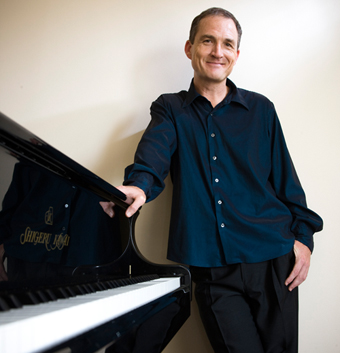
Michael Kieren Harvey
courtesy and © the artist
Michael Kieren Harvey
As promised, the second movement was lovely, its “air of mystery” rising from the left hand “like a fog horn,” and ending with a soft, rumbling, troubled gait. As with the opening movement, we were immediately plunged into intensely emotional drama on its way to gigantic waves of cascading notes (“The last two pages,” admitted Harvey, “are almost unplayable”). In between there were passages of great beauty, warm, lush, sweetly rippling and deeply chiming. Sonata and performance were wonderfully memorable.
Although the sonata is not programmatic, Harvey thought that it might have been prompted by the fall of France in World War II. It certainly is passionately defiant, withdrawing into reflection only to return more aggressive than ever. To complete the saga of death and the pianist with which I began, Hanson received the published score of his underrated sonata on the day he died in 1963. The good news was an instance of synchronicity—Hanson had played at the Eveleigh railway works, the site of Carriageworks, for the Railway Union Workers “on their 20-minute lunch breaks where he would also discuss his ideas for an Australian Trades Union Orchestra” (program note).
Psychosonata, Piano Sonata 2 (2012, 25 minutes), is one of Michael Kieran Harvey’s own compositions, a work, he said, that came out of “a low ebb.” He had intended to dedicate it to a helpful psychologist, but having done so with his first Sonata, he gave this one to his cat, Psycho.
Structuring the sonata around rising and descending nine-note lines, Harvey, like Lizst, if quite humbly, sees himself as attempting to create “a sound world different from anything before.” Like the Hanson, Psychosonata commences with a grand attack. Thundering bass lines and then upper note shocks and relentless riffing soon depart from high modernist hard-edged juxtapositions with sublime fluency, waves of notes rising and sinking into the deep against an insistent return to the unnerving counterpoint between the highest notes and the lowest. After the briefest of pauses, high notes, sweet but assertive are soon subsumed in a dense, cathartic fury, stutteringly staccato—a provisional finale to the fearful and liberating waves of ascent and descent that constitute Psychosonata.
Before commencing Elliot Gyger’s Inferno (After Dante, 2013), a 20-minute selection of eight movements from an hour-long cycle written for Harvey, the pianist sits perfectly still, hands on lap, seemingly staring deep into the score. This time the attack is vocal: a growl alternating with a squeal and other sounds, almost words, soon textured with piano notes in The Prelude: The Gates of Hell Canto III. The strikingly ‘unpretty’ vocal is reminiscent of the ‘non-operatic’ sounds of Ligeti’s Le Grand Macabre. “The nine lines of the inscription above the Gate of Hell…are transcribed, syllable by syllable, into rough-hewn piano gestures.” It’s an unsettling opening, performed by Harvey with conviction. In Acheron, low notes and high pulse and tinkle asynchronously to represent the disturbing movement of the river of Hades. We encounter the unbaptised (on an even more disorienting plane), the lustful (passionate, obsessed, opening up the range of the keyboard), the gluttonous (rhythmically furious, tormenting), the traitors (“frozen in everlasting ice” in the lowest depths of the piano) and Cocytus, the river of ice, moving in huge, heavily chorded shards. Relief comes with Postlude: The Stars, “as Dante and his guide emerge to see the night sky above them.” As in the Prelude, Harvey voices syllables from The Inferno, here with almost sub-vocal softness, in and out of synch with the piano, generating an eery, melodic and deeply satisfying beauty that evaporates into silence. It’s as if we’ve been unburdened of the emotional weight of the concert’s three works that had taken hold of our psyches.
Gyger writes that “each etude explores a different subset of the piano’s range,” which accounts for the work’s richness and the opportunities on offer for a brilliant pianist with a Lizstian vision and capacity. I long to experience the complete work. Congratulations to Carriageworks and its new music curator Louis Garrick for an adventurous program, so determinedly rewarding, promoting and celebrating bold Australian composition.
Carriageworks, piano, Michael Kieran Harvey, works by Raymond Hanson, MK Harvey, Elliott Gyger, new music curator Louis Garrick, Carriageworks, Sydney, July 19
RealTime issue #115 June-July 2013 pg. web
© Keith Gallasch; for permission to reproduce apply to realtime@realtimearts.net
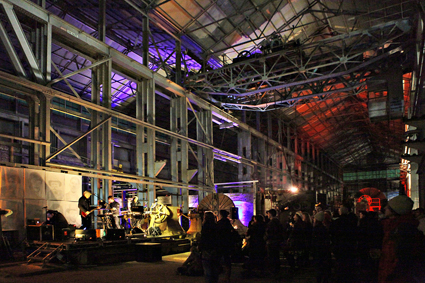
Underbelly 2011, Turbine Hall
photo Prudence Upton
Underbelly 2011, Turbine Hall
Underbelly (the arts festival not the television empire) was founded by Imogen Semmler in 2007 with the intention of bringing to the light underground creative activities that were going on in dark warehouses and shady loungerooms around Sydney (see interview RT103). The first event was a shoestring affair developed in partnership with the then newly opened Carriageworks (RT80). After a second year there the event moved to the streets of Chippendale and then the fourth iteration, in 2011, took over Cockatoo Island.
The last event was so successful it sold out, bringing 2,200 people across the harbour on a glorious winter’s day to take in experimental and emerging art nestled among the skeletons of heavy industry (RT104). With this success under her belt, Semmler decided that it was a good time to pass the baton and so the 2013 festival is headed by Eliza Sarlos as Artistic Director with Jain Moralee as Executive Director. (Sarlos has been incubating more than the festival program over the last nine months, so will in fact be on maternity leave as the event actually takes place.)
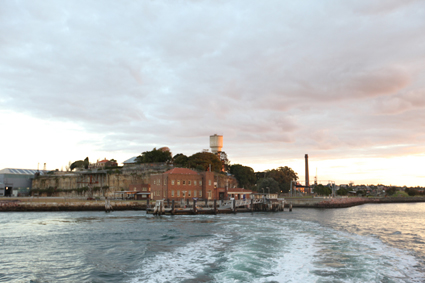
Cockatoo Island
photo Catherine McElhone
Cockatoo Island
What sets Underbelly apart from other festivals for emerging artists is its focus on creative development. Built into the structure of the event from its inception has been an intensive lab (two to three weeks) in which the artists research and develop their work onsite, granting the public daily access to the process. The lab culminates in the festival day, expanded this year to two days, in which the close-to-final products are shown. Sarlos says of this change, “Obviously it’s more of an investment but ultimately one of the aims of Underbelly Arts is to introduce new audiences to work we think is great from the next generation of artists. After selling out in 2011, going to two days really made sense for us. It was an opportunity to grow the festival—to continue that trajectory of growth that had been established by Imogen.”
Sarlos came on board in 2012 with a background in a range of activities: Executive Director of Music NSW; co-director of Sound Summit one of the then This Is Not Art Festivals; radio broadcaster on both 2SER and FBi (at the latter introducing the first talk-based program); and manager of various alternative bands. When she was invited to apply for the Underbelly position she realised that she’d “never taken pause to reflect and see how the very different things that I’d been involved in all had that one same link—working with artists to make things that I think are pretty incredible happen.”
I asked how she has approached being the first director after the founding mother had moved on. “Imogen had done such an amazing job at building Underbelly that there was so much I didn’t want to change at all. Although it had grown organically at every step of the way I felt like it had been a really considered process.” The main shift Sarlos has introduced is to give artists more preparation time by introducing earlier application rounds. “I think the process of doing that this year means that those artists have had maybe seven or eight months [preparation]. I think for 2015 we’ll try and do that even earlier. It’s worked really well. It has a lot of potential in growing what the works can be and making it easier to realise really ambitious ideas.”
The 2013 program really does offer very large scale dreaming with 30 projects by over 100 artists, many of them quite new names to the art scene. Sarlos refused to play favourites so here’s my sampling.
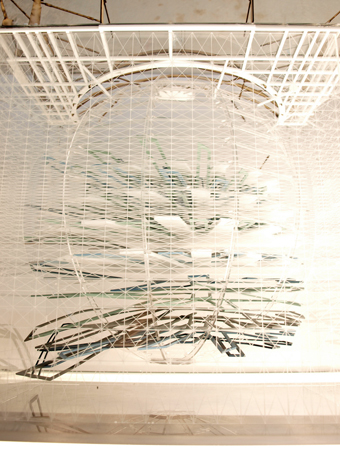
My Nourooz, Kink Studio
Mammoth: The Anti-Artifact Project will hopefully live up to its name as a team of young architects, The Lot, use Cockatoo Island’s graveyard of old machines as a creative playground in an “open-source conversation about urban decline and architectural mystery” (website). Taking a completely opposite approach, the young designers of Kink Studio will use their state-of-the-art fabrication technology to build clean geometric shapes that will be suspended in their work, titled My Nourooz, in one of the mammoth warehouses The collaborative team Ess.E.Kai will be picking up everyone else’s refuse created during the lab to make Assemblage, a kind of archive of discarded creativity.
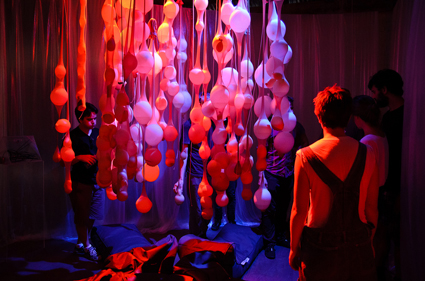
I Met You In A City That Isn’t On The Map, We Do Not Unhappen
photo Lucy Parakhina
I Met You In A City That Isn’t On The Map, We Do Not Unhappen
On the performance front, Nick Keys, writer and raconteur, will attempt a filibuster (planned way ahead of recent events in Texas). Underbelly regulars Applespiel will recreate the Stations of the Southern Cross, a roving performance “wrestling with notions of time and space like Dr Who in an Akubra” (website). A dance work, 10,000 Small Deaths, by Mischa Baka, Martyn Coutts, Kelly Ryall and Paula Lay combines live performance, looped footage and live video streams to explore “impermanence, immediacy and our relationship to the past, present and imagined futures” (website). Also a favourite from the 2011 festival, the collective now named We Do Not Unhappen (previously Fetish Frequency) will further develop their adventures in immersive game play around the island with their task-based interactive performance I Met You In A City That Isn’t On The Map.
While Sarlos maintains that the open call for applications democratises the curatorial process, her own interest in media art-based integrations gives a slightly more teched-up angle to this year’s festival. In Forms of Thought, media artist Warren Armstrong will use local environmental sensors and weather feeds to generate 3D take-home models of participants’ thoughts. In her future world fight club, Game On, Michaela Davies will be wiring up performers with her electro-muscle stimulation system and handing the controls over to the audience! Mobile Projection Unit will create a multiplayer game experience that turns real bricks into interactive pixels. In an artistic Big Brother format, Greg Pritchard and the husband and wife team The Ronalds will allow viewers on the island to interfere, in realtime, with the creative routines of four artists in distant locations in their project Virtual Reality.
Sarlos’ musical background accounts for some interesting sonic programming as well, such as the Macrophonics team exploring the island’s shipping history in the audiovisual performance Ghost Ships; Soundland by Super Critical Mass who mobilise large ensembles playing the same instrument to create epic, analogue drones; and the Electronic Resonance Korps (ERK), an all laptop orchestra for the ultra-surround sound experience.
Looking at the scope and ambition of these projects I suggested to Sarlos that maybe there’s a new generation of artists who are really not afraid of large scale dreaming. Sarlos says, “I think the applications we received were thinking big and were thinking about how to engage with a space like Cockatoo Island which instantly gives you opportunities that you wouldn’t have if you were in a gallery or a theatre. I think what Underbelly tries to do is create a really supportive environment for artists to take risks…Some of those risks may not pay off. The ones that do I think will be spectacular.”
Underbelly Art, artistic director Eliza Sarlos, executive director Jain Moralee, festival manager Michelle O’Brien, program manager Kate Britton; Lab 24 July-2 Aug; festival days 3-4 Aug; http://underbellyarts.com.au/
Disclaimer: Gail Priest is a card-carrying member of the Electronic Resonance Korps (ERK).
RealTime issue #115 June-July 2013 pg. web
© Gail Priest; for permission to reproduce apply to realtime@realtimearts.net
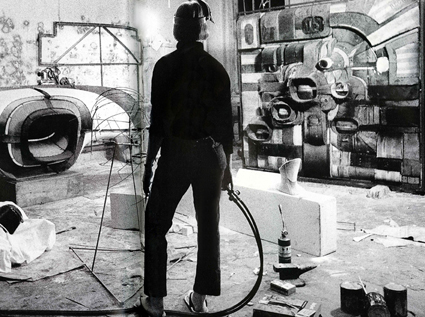
Lee Bontecou in studio 1963
photo Ugo Mulas, courtesy The Commercial Gallery and MCLEMOI Gallery, Sydney
Lee Bontecou in studio 1963
Janis II, The Commercial & MCLEMOI Galleries
Janis encompasses a range of activities initiated by Kelly Doley (a member of Brown Council) focusing on female artists, writers and thinkers allowing them “to be heard a little louder, to take up more space and more time in the world” (website). She has teamed up with Amanda Rowell to curate the second Janis exhibition spanning two Sydney inner city galleries, The Commercial and MCLEMOI. Janis II features abstract, conceptual and minimalist work by Bonita Bub, Jenny Christmann, Sarah Goffman, Gail Hastings and Sarah Rodigari (who will be performing at the opening, 26 July). A publication featuring short pieces by an impressive list of female artists and thinkers will also accompany the exhibition. (For the amusing significance of the Lee Bontecou image read Gail Hastings’ insightful essay Thank goodness Donald Judd wasn’t a misogynist.)
Janis II, The Commercial Gallery & MCLEMOI Gallery, 26 July-17 August; www.thecommercialgallery.com http://mclemoi.com
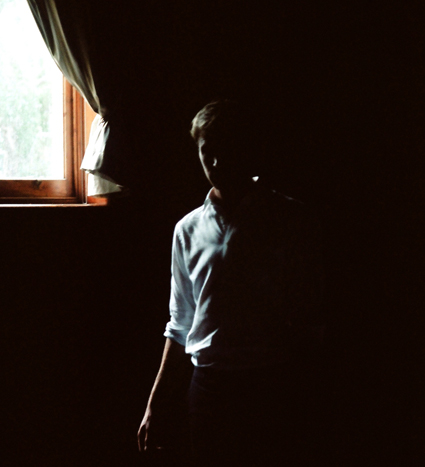
Sydney Chamber Opera, Owen Wingrave
photo Samuel Hodge
Sydney Chamber Opera, Owen Wingrave
Owen Wingrave, Sydney Chamber Opera
An interesting development in Sydney’s contemporary classical musical landscape has been the rapid rise of Sydney Chamber Opera under the leadership of Louis Garrick and Jack Symonds. The company has continued to impress with what Keith Galllasch described as “strong programming, quality musicianship, brave directors and very strong design” (RT113). Their next production is Benjamin Britten’s Owen Wingrave (1967), exploring familial bonds, war and pacifism. Directed by Imara Savage it presents an interesting challenge as the opera, based on a story by Henry James, was originally commissioned by the BBC as a work for television.
Owen Wingrave, Sydney Chamber Opera, Carriageworks, 3, 5, 7, 9, 10 August; http://sydneychamberopera.com
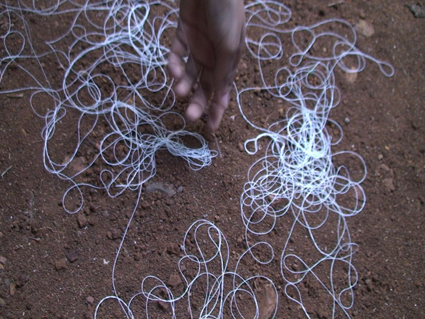
Shilpa Gupta, Untitled, video still, 2012
Shilpa Gupta, MAAP Space
Indian artist Shilpa Gupta has garnered attention on the international media art scene since the late 90s with her intelligent blending of politics, social commentary and playfulness. Gupta will be exhibiting four works at MAAP Space in Brisbane—two single channel video pieces, an interactive sound installation and an embroidered wall hanging—continuing her conceptual interrogation of borders and nationality.
Shilpa Gupta, MAAP Space, 27 July-30 Aug; www.maap.org.au/
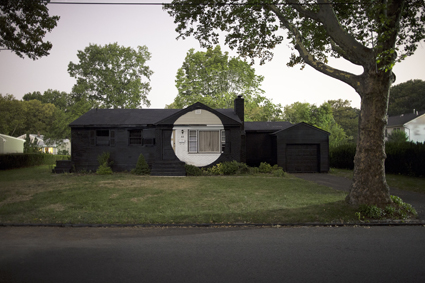
Ian Strange, Corinne Terrace 2011 archival digital print
collection of the artist, New York © Ian Strange
Ian Strange, Corinne Terrace 2011 archival digital print
Suburban, Ian Strange, NGV
Perth street artist Ian Strange now lives mostly in New York and is becoming world renowned for his ambitious projects. In Suburban, Strange travelled around America—Ohio, Detroit, Alabama, New Jersey, New York and New Hampshire—painting directly onto houses that were slated for demolition. The actions, which even included burning down a property, have been documented and will form the basis of a multichannel video installation, accompanied by large format prints and relics from the houses themselves.
Suburban, Ian Strange, NGV Studio, 27 July-15 September 2013; www.ngv.vic.gov.au
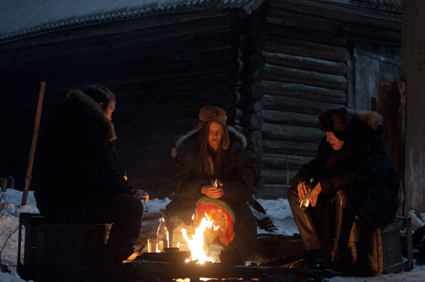
Me too, Alexei Balabanov
Russian Resurrection Film Festival
It’s the 10th anniversary of the Russian Resurrection Film Festival and while it has already played Melbourne and Canberra, the Sydney, Perth, Brisbane and Byron Bay iterations are still to come. Possible highlights: Me too (2012) by controversial director Alexei Balabanov (recently deceased), a contemporary Tarkovsky-inspired search for happiness in a no-go zone; the road movie Artefact (2010), a debut feature by actor Andrey Sokolov; the brutally honest documentary Anton’s right here (2012), following the life of a young man with mental illness, directed by Lyubov Arkus; and the 1966 comedy Beware of the Automobile, Eldar Ryazanov’s take on a Soviet Robin Hood.
Russian Resurrection Film Festival, Sydney, Chauvel Paddington & Event Cinemas Burwood, 24 July-7 August; Brisbane, Palace Centro, 26 July-4 August, Perth, Cinema Paradiso, 1-11 August; Byron Bay, Palace, 2-4 August; http://russianresurrection.com/
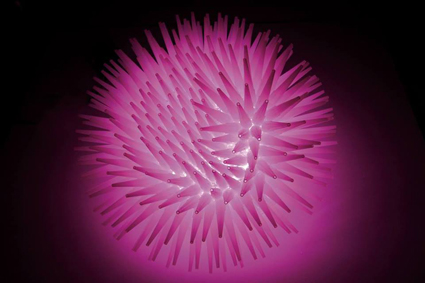
Jemimah Davis, Silicone Nozzles (2013, installation detail), nozzles, Tupperware, LED lights
South Australian Living Artists (SALA)
Every August, South Australia celebrates its living artists. This year there are 4,917 artists involved ranging from amateur to emerging to established with over 500 exhibitions on offer. Highlights include Crystal Palace at Flinders University City Gallery which places the work of nine contemporary artists ‘in conversation’ with objects from South Australian museums and archives” (website). Emerging artist Jemimah Davis takes ordinary objects and transforms them into magical glowing ones in Fluorescence at Urban Cow Gallery. Outside of Adelaide on the Fleurieu Peninsula you can catch Where are you? What time is it? How do you know? by Margaret Worth at Signal Point Gallery working with projection group Illuminart and sound artist Tom Harrer to play with the viewer’s image, seemingly shifting it through time and space.
SALA, various venues across South Australia, 2-25 August; http://www.salafestival.com/
Tangents And Cycle ~440, Sound Lounge
The New Music Network presents an evening of exploratory electro-acoustic music with two relatively new ensembles, Tangents and Cyle ~440. Tangents is a kind of super group including Ollie Bown (Icarus), Shoeb Ahmad and Evan Dorrian (Spartak), Andrian Klumpes (Triosk) and Peter Hollo (Four Play), playing a kind of “post-everything mesh of styles” (website). Cycle ~440 is a duo from Perth featuring RealTime writer Sam Gillies on laptop and Kevin Pen on piano performing semi-improvised settings from their soon to be released album The Topography of Ascending Structures.
New Music Network presents Tangents And Cycle ~440, Sound Lounge, Seymour Centre, 1 August; http://www.seymourcentre.com
Still in the loop
Winter, Arts Centre Melbourne
from July 27-18 August
artscentremelbourne.com.au
White Rabbit, Red Rabbit, Malthouse
23 July-3 August
www.malthousetheatre.com.au
Hello, Becky Hilton & Producciones La lagrima
1000 £ Bend, Melbourne, 23-25 July
www.helloprojectmelbourne.com/
Here&Now13, Lawrence Wilson Gallery
27 July-28 September
www.lwgallery.uwa.edu.au; www.dadaa.org.au/
Home 3, Olaf Breuning
Institute of Modern Art, Brisbane
8 June-27 July
www.ima.org.au/pages/exhibitions.php
Queensland Music Festival
Various venues, QLD, 12-28 July
www.qmf.org.au
TeleScope: Visions from the EU, online screenings
Melbourne International Film Festival
25 July-11 August
http://miff.com.au/program-categories/telescope
Intra-action: Multispecies becomings in the Anthropocene
MOP Gallery, 11-28 July
http://intraactionart.com/
Fraught Outfit, Persona
Belvoir, 24 July-18 Aug
http://belvoir.com.au
Live and Deadly, Carriageworks
27 Jun-1 Aug
http://www.carriageworks.com.au/?page=Event&event=LIVE-AND-DEADLY
My Country, I Still Call Australia Home: Contemporary Art from Black Australia
Queensland Art Gallery/Gallery of Modern Art, 1 June-7 October
http://www.qagoma.qld.gov.au/exhibitions/current/my_country
Helium Season, Malthouse
8 June-5 Oct, see website for following productions
www.malthousetheatre.com.au/helium-2013/
Finucane & Smith’s The Glory Box…Paradise
45 Downstairs, Melbourne, 10 July -11 August
http://www.fortyfivedownstairs.com/events/
Anne Ferran, Box of Birds
Stills Gallery, Sydney; 26 June to 27 July 2013
www.stillsgallery.com.au
Vocal Folds, Gertrude Contemporary
21 June-20 July; performances 11 July, 18 July
www.gertrude.org.au/exhibitions
RealTime issue #115 June-July 2013 pg. web
© RealTime ; for permission to reproduce apply to realtime@realtimearts.net
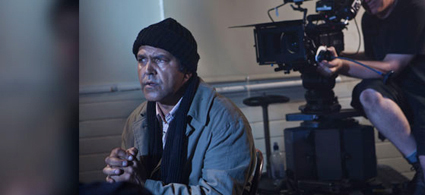
Rose Tatoo, Alanna Rose (funded by Metro Screen)
Metro Screen: Indigenous programs & Storyworld Seminar
This free information session for Indigenous people interested in working in film and television will introduce a variety of programs including free short courses in digital, TV, and film skills, scholarships and funding opportunities. Metro Screen is also presenting the Storyworld Seminar, a panel discussion around the development and production of interactive multiplatform stories. There’s a range of other information sessions and panels too on offer over August.
Are You Indigenous And Want To Work In Film And TV? information session, 6 August; Story World Seminar, 9 August; http://metroscreen.org.au/7-events-opportunities-you-dont-want-to-miss/
2high Festival 2013 Artist Call Out
Backbone Youth Arts is now calling for applications from emerging artists around Australia to participate in the annual 2high Festival. The festival is programmed and run by 12 emerging artists and will take over Brisbane Powerhouse on 2 Nov.
Applications close 16 August; http://www.backbone.org.au/2high-festival.cfm
Still in the loop
France 24 – Rfi Web Documentary Visa D’or Award 2013
Entry deadline 26 July, 2013
http://www.france24.com/en/webdocumentary-award-2013
2013 INSITE Award
Deadline 26 July
www.awg.com.au
Abbotsford Convent, Spiritous 2014
Applications due 29 July 2013
http://www.abbotsfordconvent.com.au/venues-hire/cultural-programming
Bundanon Artist Residencies
Applications close 2 August
www.bundanon.com.au/content/residencies
PauseFest
Registration and final design submission August 15
http://pausefest.com.au/download_docs/pausefest2014_eoi_details.pdf
Tele Visions, call for screen works
Applications close 29 August
http://televisionsproject.org/
Australia Council upcoming deadlines
(for full list see http://www.australiacouncil.gov.au/grants)
Hopscotch, 19 July 2013
(for Market Development; National Touring, International touring)
http://www.australiacouncil.gov.au/grants/2013/hopscotch
Music: International Pathways – Round 4, 22 July 2013
http://www.australiacouncil.gov.au/grants/2013/music-international-pathways-22-july
Music: Peggy Glanville-Hicks Residency, 22 July 2013
http://www.australiacouncil.gov.au/grants/2013/peggy-glanville-hicks-residency
Emerging and Experimental Arts: Creative Australia – New (Art Creative Development), 01 August 2013
http://www.australiacouncil.gov.au/grants/2013/inter-arts-creative-australia-new-art-creative-development
Theatre: Cultural Leadership Skills Development, 5 August 2013
http://www.australiacouncil.gov.au/grants/2013/cultural-leadership-skills-development-theatre
Theatre: New Work, 5 August 2013
http://www.australiacouncil.gov.au/grants/2013/theatre-new-work
Theatre: Fellowships, 5 August 2013
http://www.australiacouncil.gov.au/grants/2013/theatre-fellowships
Creative Australia – Emerging Presenter, 12 August 2013
http://www.australiacouncil.gov.au/grants/2013/Creative-Australia-Emerging-Presenter
Creative Australia – New Digital Theatre, 12 August 2013
http://www.australiacouncil.gov.au/grants/2013/Creative-Australia-New-Digital-Theatre
International Markets – Music managers (Previously Live On Stage – Music Managers). 14 August 2013
http://www.australiacouncil.gov.au/grants/2013/international-markets2-music-managers-14-aug-2014
Dance: Artform Development, 16 August 2013
http://www.australiacouncil.gov.au/grants/2013/dance-artform-development
Dance: Fellowships, 16 August 2013
http://www.australiacouncil.gov.au/grants/2013/dance-fellowships
Dance: Projects – Creative Development, 16 August 2013
http://www.australiacouncil.gov.au/grants/2013/dance-projects-creative-development-16-august
Dance: Projects – Presentation, 16 August 2013 http://www.australiacouncil.gov.au/grants/2013/dance-projects-presentation-16-august
Dance: Creative Australia – New Work, 16 August 2013
http://www.australiacouncil.gov.au/grants/2013/dance-creative-australia-new-work
Visual Arts: Skills and Arts Development – Residencies, 19 August 2013
http://www.australiacouncil.gov.au/grants/2013/visual-arts-skills-and-arts-development-residencies
Visual Arts: Presentation and Promotion, 21 August 2013,
http://www.australiacouncil.gov.au/grants/2013/visual-arts-presentation-and-promotion
Visual Arts: Skills and Arts Development – General, 21 August 2013
http://www.australiacouncil.gov.au/grants/2013/visual-arts-skills-and-arts-development-general
RealTime issue #115 June-July 2013 pg. web
© RealTime ; for permission to reproduce apply to realtime@realtimearts.net
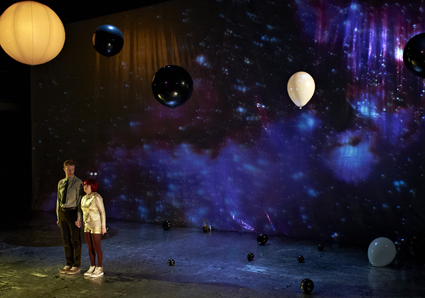
Robert Jago, Natalie Holmwood, ALIENATION, Perth Theatre Company
photo Richard Jefferson
Robert Jago, Natalie Holmwood, ALIENATION, Perth Theatre Company
Three individuals contacted by an otherworldly power are thrown into an existential quandary; beliefs are interrogated, relationships torn and internal isolation grows. Drawing on interviews with alien abductees in Australia, Perth Theatre Company’s ALIENATION seeks to tell the stories of those who have been touched forever by ‘close encounters’ that are rationally inexplicable yet life-changing, psychologically and philosophically.
The aesthetic vision of director Melissa Cantwell and her designers is simultaneously stark and textured. However there is a tonal ambiguity and lack of narrative impetus that weakens the piece overall. Based on interviews ALIENATION very quickly shapes into a type of verbatim theatre with a proclivity towards static story-‘telling’ rather than showing—confessional outpouring with little action or interactive dynamic to drive the scenes forward.
This approach is coupled with a meta-narrative structure in which the actors reveal they will be playing themselves as well as the interviewees. Perhaps an attempt to acknowledge that the characters are based on real people, instead the device undermines the interviewees’ experiences. By having the ‘actors’ (also characters) reveal varying degrees of belief ranging from ambivalent to facetious to explicitly sceptical, a tone of doubt is created. This forms the subtext in which there is little conviction given to the source material—at times seeping into the actors’ portrayal of the interviewees, manifesting as an undertone of ironic distance. This would be fine if ALIENATION intends to plant seeds of doubt in our acceptance of the characters, but this never seems explicit, rather it is an underdeveloped device exploring the thoughts of both sceptic and believer with limited success.
This is possibly a reason why the writer—who has expressed his compassion for the interviewees’ and their experiences—has distanced himself from the piece. A note written by the playwright Lachlan Philpott (Truck Stop, Silent Disco) is handed out to each audience member stating the production does not reflect his intentions. Subsequently his name has been removed from the program and Perth Theatre Company’s website since the production opened and the Sydney season of the production cancelled. (A statement has since been issued by Philpott through the Australian Writers Guild. Eds.)
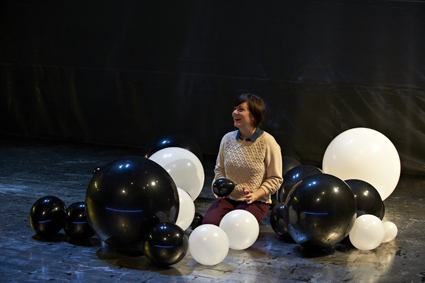
Natalie Holmwood, ALIENATION, Perth Theatre Company
photo Richard Jefferson
Natalie Holmwood, ALIENATION, Perth Theatre Company
You will want to see this work for Natalie Holmwood’s portrayal of Katherine, a woman who was first abducted at a very young age. Katherine is a rich and well-developed character and Holmwood embodies all of her pained, oddball yet awkwardly endearing traits. She extracts audience sympathy for Katherine as she tries to make sense of her experiences, to become something more than a victim, a curiosity and a pariah. With her flashbacks, night terrors, numbness and self-loathing she is clearly a survivor of unexplained horrors whatever their source may be.
The rest of the cast are committed to their roles but are working with thin material: their characters have not emerged as fully formed as Katherine. They are tenuous, opaque and sometimes clichéd, which makes the meta-narrative perspective even more—ahem—alienating.
The audiovisual and lighting designs—by Roly Skender and Benjamin Cisterne respectively—bring a dreamy tension to the piece and could perhaps have been further utilised to construct the sense of disorientation and discombobulation experienced by each character, rather than these being, in the main, reported in long expository monologues. Peter Dawson’s sound design is sparse and delicate, but bookended and punctuated by some overbearing popular music choices—including overt space-themed classics by Bowie and The Byrds and a swooning love ballad from Aerosmith—adding to the overall tonal discrepancy of the work.
There are pockets of whimsy and sardonic humour throughout; there is sadness and an unsettling tremor in each character. However the vacillation between parody and drama results in a less than captivating work.
Perth Theatre Company, ALIENATION, director Melissa Cantwell, performers Naomi Hanbury, Luke Hewitt, Natalie Holmwood, Robert Jago, designer Bruce McKinven, lighting Benjamin Cisterne, sound designer Peter Dawson, audiovisual designer Roly Skender, research consultant Mary Rodwell (Founder of the Australian Close Encounter Research Network); Studio Underground, State Theatre Centre of Western Australia, 28 June-13 July
RealTime issue #115 June-July 2013 pg. web
© Astrid Francis; for permission to reproduce apply to realtime@realtimearts.net
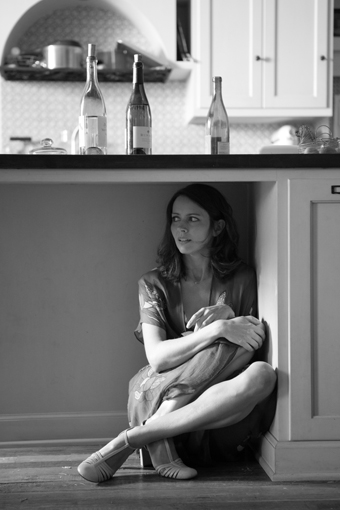
Much Ado About Nothing, Joss Whedon
courtesy Sharmill Films
Much Ado About Nothing, Joss Whedon
Look, I’ll admit it. I loved literature but I initially found Shakespeare hard work. We studied one play every year at high school. Romeo and Juliet. Macbeth. The Merchant of Venice. They are the ones that spring to mind.
I remember the terrible Dire Straits song that we had to listen to (our teacher being very ‘modern’) and a lot of wringing hands—blood that could never wash off. I remember little deaths and the screams of laughter when our teacher, blushing, revealed what those words meant. I remember terrible films, full of arch overacting and stiff costumes, that were an endurance test. Or, even worse, the outings to plays where the whole audience of schoolies could not stop giggling at the sight of men in tights, the laughter so loud it drowned out the actors’ lines.
I found Shakespearean language and most poetry (until I came to Emily Dickinson) like a locked box. I couldn’t find a key until Year 11 when I had a teacher who was a passionate guide. As he started to work carefully through the language with precision, I began to realise that Shakespeare was funny. And possibly relevant. I started to enjoy the shape of it on my tongue. Sex and death? As a teen I was obsessed with both. Wasn’t everyone?
Baz Luhrmann’s Romeo + Juliet put an end to my lingering distrust. It was fresh, exciting, operatic in scope, full of sound and fury (of course it signified something) and the romance was palpable. I remember sitting in the Orpheum, thinking about whether to buy another ticket and start over again. Most of all, I finally understood the writing, the language, without having to struggle.
Look, I’ll admit it. I’m a fan of Joss Whedon. I’m one of those people who came late to his shows, but I watched Buffy episodes all in a row on Friday nights with my best friend and then Angel in parallel so I could enjoy the interconnecting narrative. Then I watched everything else he ever made. I saw him speak at Melbourne Town Hall when he toured here. A friend commented that he could make toast and it would be interesting to watch.
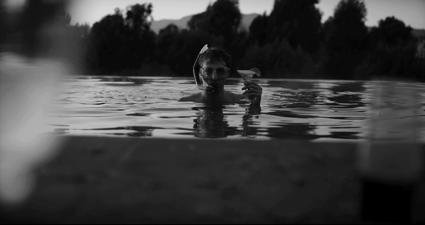
Much Ado About Nothing, Joss Whedon
courtesy Sharmill Films
Much Ado About Nothing, Joss Whedon
When I heard he was taking on Shakespeare, I wasn’t really surprised. He chose Much Ado About Nothing because of its location (it could be made all in one spot) and then filmed it in the house where he lives in Santa Monica with his family, over 12 days. I saw the film in an audience of fans. And this time the crowd was laughing for the right reasons. Like Luhrmann, Whedon has a talent for translation. The film is shot in black and white, yet contemporary, with parties that never end and paparazzi who capture the dregs. It traces the oblique nature of relationships and the shifting spaces between what men/women say and what they really mean.
The actors deliver their lines with Whedonesque drollness and the physical staging is innovative in confined spaces. Amy Acker as Beatrice and Alexis Denisoff as Benedick battle it out wordily in screwball comedy style, while Whedon brings in all his other regulars, often against type. It feels like a family affair and in fact it was. His co-producer on the film (and wife) Kai Cole did a Skype interview at the film session I attended. She said that for many years they had regular Shakespeare readings in their home and the film emerged with the same actors involved. Much Ado has the manic energy that low-budget collaboration with great actors seems to create, even though it’s not improvised. (This “real” feel reminds me of Cassavetes.)
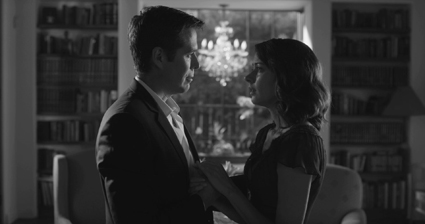
Much Ado About Nothing, Joss Whedon
courtesy Sharmill Films
Much Ado About Nothing, Joss Whedon
As a writer and director, Whedon has always been interested in girls and women—their place in society, how they subvert the stereotypes—and here he cleverly questions Shakespeare’s assertions about women’s rights and virtues from within, while sticking tenaciously to the script. Lines I remember as tedious he manages to subvert with a quick nod of the head, or a smirk, so they can also mean the opposite. And as always he remains focused on nerds—the smart, cute, funny types who win using brain rather than brawn. For teenagers (or adults like me) coming to Shakespeare today, this film is a great way in to the heart and energy of the language; Whedon is a passionate, acerbic and sexy guide.
Much Ado About Nothing, director Joss Whedon, Australian distributor Sharmill Films, in cinemas from 11 July; http://www.sharmillfilms.com.au
RealTime issue #115 June-July 2013 pg. web
© Kirsten Krauth; for permission to reproduce apply to realtime@realtimearts.net
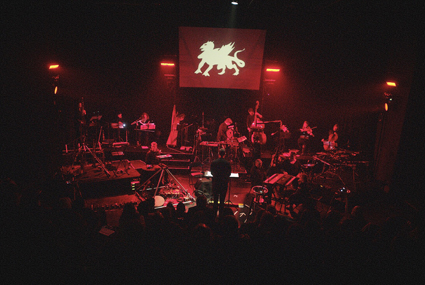
The NIS, The Amplified Elephants, BOLT Ensemble
photo Tim McNeilage
The NIS, The Amplified Elephants, BOLT Ensemble
A recording of the roar of a vast crowd fills the pitch-black auditorium of the Footscray Community Arts Centre for the opening of The NIS, an all-abilities sonic arts show featuring The Amplified Elephants and the BOLT Ensemble. They could have just left the lights on, because the house was packed with an excited audience who had braved the wind and rain to see the show.
A red searchlight reveals the winds, strings, harp and percussion of the BOLT Ensemble. Downstage, The Amplified Elephants are seated next to gleaming robotic structures: a frame of bells and an apparatus, the Gotholin, which draws violin bows across four violins. Teagan Connor punctuates the ambience with an eerie scraping from the instrument. A harp line (Mary Doumany) follows in its wake. Activated via a synthesiser keyboard, Robyn McGrath releases a jangling peal of bells from a robotic carillon. As Doumany begins playing sweeping glissandi, an incredible oscillating sound rises from the Whirling Dervishes—power drills with sound-producing bowls attached. Flashing coloured lights heighten the tension in the Lost World Auditorium, as the piece is entitled, signaling our entrance into the dream-like, symbolic world of The NIS.
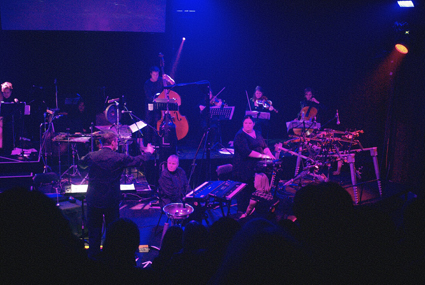
The NIS, The Amplified Elephants, BOLT Ensemble
photo Tim McNeilage
The NIS, The Amplified Elephants, BOLT Ensemble
“Worker,” “god” and “wolf” are some of the archetypes explored through the concert’s nine movements with the help of Tien Pham’s dark animations and a series of interviews and field recordings. Connections are developed between the symbols of the politician and the wolf, corporations and global warming, even god and the wolf, as well as a host of other characters, at times subjects, at others objects of discourse: workers, children and animals. The animations also double as games, generating parts of the music. In one animation, a crowd of figures wanders between traffic lights in a sun-baked wasteland, fragments of musical scores for different instruments appear onscreen prompting changes in the sonic landscape.
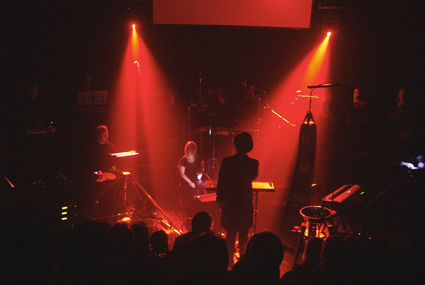
The NIS, The Amplified Elephants, BOLT Ensemble
photo Tim McNeilage
The NIS, The Amplified Elephants, BOLT Ensemble
First performed in 2009 at Fortyfivedownstairs, this show has developed over the years. At the Footscray Community Arts Centre the theatrical interventions of The Amplified Elephants were missed, though Kathryn Sutherland’s playing of a punching bag fitted with pressure-sensitive triggers echoes the show’s original physicality. The ensemble has also grown to include Thomas Lutze (Pedal Triggers), Teagan Connor (Whirling Dervish and Gotholin) and Daniel Munnery (Tiny Tappers and sampler). The dynamic lighting and impressive technological resources of The NIS add drama to the relatively static composition, where fleeting gestures and sudden whispers disappear into the soundscape as soon as they appear.
As Director James Hullick writes in his program note, linear narrative is not the only way in which to understand ourselves and works of art. Sometimes a freer juxtaposition of ideas and sounds is needed, even when they may only appear once, undeveloped and do not have any real-world correlates. This approach is summed up in the show’s title, The “NIS,” which, like the famous hapax “ptyx” of the French poet Stéphane Mallarmé, is a word invented by Katherine Sutherland to signify nothing. This play of signifiers is not entirely empty, however, as through this juxtaposition of ideas The NIS also brings together communities, as the large list of collaborators shows, to produce a thought-provoking and multi-faceted performance.
The Click Clack Project: The NIS, The Amplified Elephants, BOLT Ensemble, Footscray Community Arts Centre, 4 July; http://www.clickclackproject.org/
RealTime issue #115 June-July 2013 pg. web
© Matthew Lorenzon; for permission to reproduce apply to realtime@realtimearts.net
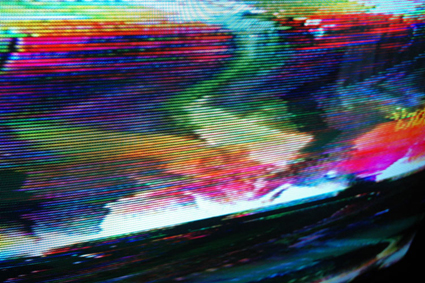
Tele Visions
Tele Visions, call for screen works
Another new screen-based festival has just been announced. Directed by Alex White and Emma Ramsay, Tele Visions celebrates the last days of analogue TV broadcasting and is calling for works for possible broadcast and exhibition that engage with “TV as a medium, the end of TV, TV’s history, TV’s content forms, the production and language tropes of performance for TV” (press release). Tele Visions will form part of the Performance Space 30 year celebrations later in the year.
Applications close 29 August; http://televisionsproject.org/
City of Sydney, accommodation grants
Subsidised spaces will be available from the beginning of 2014 in five City of Sydney properties in Erskineville, Glebe, Ultimo and Redfern. Applications are open to non-profit community and cultural groups for access to office space, meeting rooms, studios and workshops.
Applications close 23 July; http://www.cityofsydney.nsw.gov.au/community/grants-and-sponsorships/the-citys-programs/accommodation-grants
Still in the loop
Waverley Artist In Residence Program 2014
Deadline Monday 22 July 2013; http://www.waverley.nsw.gov.au/things_to_do/arts_and_culture/AIR_program/about_the_program
France 24 – Rfi Web Documentary Visa D’or Award 2013
Entry deadline 26 July, 2013
http://www.france24.com/en/webdocumentary-award-2013
2013 INSITE Award
Deadline 26 July
www.awg.com.au
Abbotsford Convent, Spiritous 2014
Applications due 29 July 2013
http://www.abbotsfordconvent.com.au/venues-hire/cultural-programming
Bundanon Artist Residencies
Applications close 2 August;
www.bundanon.com.au/content/residencies
PauseFest
Registration and final design submission August 15; http://pausefest.com.au/download_docs/pausefest2014_eoi_details.pdf
Australia Council upcoming deadlines
(for full list see http://www.australiacouncil.gov.au/grants)
Hopscotch, 19 July 2013
(for Market Development; National Touring, International touring)
http://www.australiacouncil.gov.au/grants/2013/hopscotch
Music: International Pathways – Round 4, 22 July 2013
http://www.australiacouncil.gov.au/grants/2013/music-international-pathways-22-july
Music: Peggy Glanville-Hicks Residency, 22 July 2013
http://www.australiacouncil.gov.au/grants/2013/peggy-glanville-hicks-residency
Emerging and Experimental Arts: Creative Australia – New (Art Creative Development), 01 August 2013
http://www.australiacouncil.gov.au/grants/2013/inter-arts-creative-australia-new-art-creative-development
Theatre: Cultural Leadership Skills Development, 5 August 2013
http://www.australiacouncil.gov.au/grants/2013/cultural-leadership-skills-development-theatre
Theatre: New Work, 5 August 2013
http://www.australiacouncil.gov.au/grants/2013/theatre-new-work
Theatre: Fellowships, 5 August 2013
http://www.australiacouncil.gov.au/grants/2013/theatre-fellowships
Creative Australia – Emerging Presenter, 12 August 2013
http://www.australiacouncil.gov.au/grants/2013/Creative-Australia-Emerging-Presenter
Creative Australia – New Digital Theatre, 12 August 2013
http://www.australiacouncil.gov.au/grants/2013/Creative-Australia-New-Digital-Theatre
International Markets – Music managers (Previously Live On Stage – Music Managers). 14 August 2013
http://www.australiacouncil.gov.au/grants/2013/international-markets2-music-managers-14-aug-2014
Dance: Artform Development, 16 August 2013
http://www.australiacouncil.gov.au/grants/2013/dance-artform-development
Dance: Fellowships, 16 August 2013
http://www.australiacouncil.gov.au/grants/2013/dance-fellowships
Dance: Projects – Creative Development, 16 August 2013
http://www.australiacouncil.gov.au/grants/2013/dance-projects-creative-development-16-august
Dance: Projects – Presentation, 16 August 2013 http://www.australiacouncil.gov.au/grants/2013/dance-projects-presentation-16-august
Dance: Creative Australia – New Work, 16 August 2013
http://www.australiacouncil.gov.au/grants/2013/dance-creative-australia-new-work
Visual Arts: Skills and Arts Development – Residencies, 19 August 2013
http://www.australiacouncil.gov.au/grants/2013/visual-arts-skills-and-arts-development-residencies
Visual Arts: Presentation and Promotion, 21 August 2013,
http://www.australiacouncil.gov.au/grants/2013/visual-arts-presentation-and-promotion
Visual Arts: Skills and Arts Development – General, 21 August 2013
http://www.australiacouncil.gov.au/grants/2013/visual-arts-skills-and-arts-development-general
RealTime issue #115 June-July 2013 pg. web
© RealTime ; for permission to reproduce apply to realtime@realtimearts.net
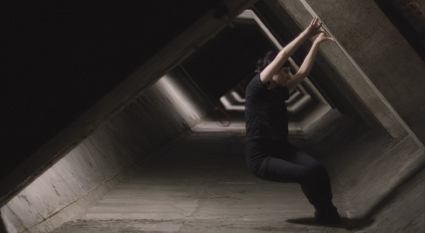
Gabriella Mangano and Silvana Mangano, Hidden Spaces, Ready Stages
courtesy of the artist
Gabriella Mangano and Silvana Mangano, Hidden Spaces, Ready Stages
Winter Season, Arts Centre
In addition to a very impressive season of major works in the main theatres— Philip Glass and Robert Wilson’s Einstein on the Beach (31 July-4 Aug), ADT’s Proximity (15-18 Aug) and US Dance company MOMIX’s Botanica (7-11 Aug)—Melbourne’s Arts Centre is also filling its hallways, foyers and rehearsal rooms with new commissions and site-responsive works. Visual artists Gabriella and Silvana Mangano have been prowling the underground tunnels and forgotten chambers of the complex to create a video installation titled Hidden Spaces, Ready Stages (27 July-4 Aug). Poet-in-residence Kate Larsen will be live tweeting poems displayed on the venue’s signage in Poetry by LED (5-11 Aug). An interactive audio tour, 5 x 5 x 5, sees emerging composers, mentored by leading artists, create works for five different locations around the centre experienced via personal MP3 players (27 July-18 Aug). Showing in the rehearsal rooms will be Saskia Moore’s Dead Symphony, a music and light show inspired by near-death accounts (7-10 Aug) and Swiss company Trickster-p will present .h.g., a haunted house version of Hansel and Gretel through which the audience amble with torch and iPhone app (8-11 Aug).
Winter, Arts Centre Melbourne; from July 27-18 August; artscentremelbourne.com.au
Old Kings in Exile, Soundstream Collective
Guest curator Brett Dean will be conducting the Adelaide-based Soundstream Collective in this program featuring leading Australian composers. Along with Dean’s Sextet (Old Kings in Exile) will be Richard Meale’s Incredible Floridas (the inspiration for Dean’s work), along with pieces by Anthony Pateras and James Ledger. The concert is co-presented by the New Music Network in both Adelaide and Melbourne. Look out for a review on the Matthew Lorenzon-RealTime new music blog, Partial Durations http://partialdurations.wordpress.com/.
Old Kings in Exile, Soundstream Collective; Adelaide, Elder Hall, 19 July, 7:30pm; Melbourne Recital Centre, 23 July, 7pm; www.soundstream.org.au/
The Capital Gains Consultation Project, Teik-Kim Pok
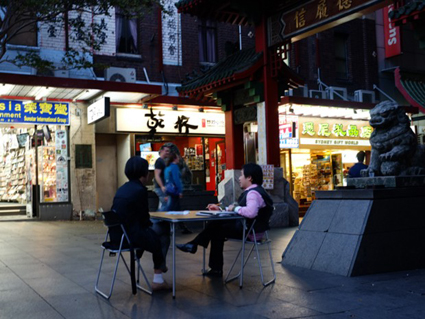
Teik-Kim Pok, The Capital Gains Consultation Project (2013)
courtesy of the artist
Teik-Kim Pok, The Capital Gains Consultation Project (2013)
Performer Teik-Kim Pok has been chatting to passersby and business owners in the Haymarket/Chinatown area of Sydney for the last year in an attempt to formulate a new transactional economy based on micro-narratives. You can join him for a meaningful exchange of wares on Friday night at the Dixon Street Markets. You can also submit stories and images to the blog.
4A Centre for Contemporary Asian Art, The Capital Gains Consultation Project, Teik-Kim Pok, Dixon Street Night Markets, Sydney, 19 July 2013, 5-9pm; www.4a.com.au/
White Rabbit, Red Rabbit, Malthouse
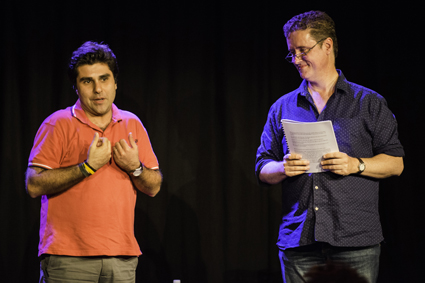
White Rabbit Red Rabbit, writer Nassim Soleimanpour stops the performance by Richard Fidler and introduces himself to the audience at WTF2013, Brisbane
photo Studio Impressions
White Rabbit Red Rabbit, writer Nassim Soleimanpour stops the performance by Richard Fidler and introduces himself to the audience at WTF2013, Brisbane
Witnessing Nassim Soleimanpour’s White Rabbit, Red Rabbit at the World Theatre Festival in Brisbane this year Stephen Carleton wrote: “It is an extraordinary theatrical experiment… It will influence writers, theatre stylists and experimenters of form and structure for years to come” (RT114). Melbourne audiences can now witness this unique theatrical creation in which, each night, a different actor is handed the script (previously unsighted) and must perform it, ably assisted by his or her audience.
White Rabbit, Red Rabbit, project curator Janice Muller, performers Rodney Afif, Alison Bell, Alan Brough, Shareena Clanton, Daniela Farinacci, Ming-Zhu Hii, Bert LaBonté, John Leary, Caroline Lee, Brian Lipson, Genevieve Morris, Brian Nankervis, Sam Pang; Malthouse, 23 July-3 August; www.malthousetheatre.com.au
Hello, Becky Hilton & Producciones La lagrima
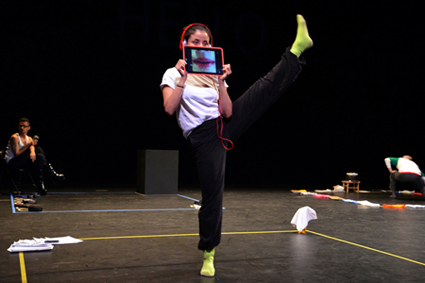
Alejandra Lopez Guerrero, Hello
courtesy Producciones La lagrima
Alejandra Lopez Guerrero, Hello
Hello is a cross-cultural long distance collaboration between Melbourne choreographer Becky Hilton and four young dancers from regional Mexican dance company Producciones La lagrima. Hilton has worked with the dancers via all communication conduits—Skype, Facebook, YouTube, text and chat—as well as face-to-face to create intimate dance portraits of these young people’s lives. The audience experiences the work first as an installation followed by a seated “traditional spectacle.”
Hello, Becky Hilton & Producciones La lagrima, 1000 £ Bend, 361 Little Lonsdale Street, Melbourne, 23-25 July;
www.helloprojectmelbourne.com/
Here&Now13, Lawrence Wilson Gallery
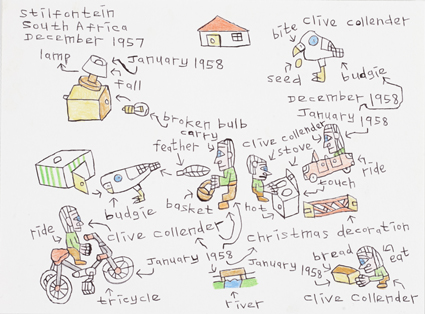
Clive Collender, Stilfontein, South Africa, December 1957, 2013, pencil and pen on paper
image courtesy and © the artist, photo Acorn Photo Agency
Clive Collender, Stilfontein, South Africa, December 1957, 2013, pencil and pen on paper
Here&Now13 is a survey exhibition showcasing the work of 11 Western Australian artists. The artists have been in a year-long development and mentorship program produced by DADAA (Disability in the Arts, Disadvantage in the Arts WA). Curator Katherine Wilkinson sees the exhibition as part of a “growing national and international trend to contextualise disability arts practice within the larger narratives and discussions of contemporary art…not attempting to define its lineage or rely on the model of Outsider Art” (press release). The exhibition will be accompanied by a symposium featuring keynote speaker Carrie McGee, Educator in Community and Access Programs, Department of Education at MOMA, New York.
Here&Now13, artists Katrina Barber, Patrick Carter, Clive Collender, Aquinas Crowe, David Guhl, Tim Maley, Julian Poon, Jane Ryan, Robert Turpin, Lisa Uhl and Robin Warren, Lawrence Wilson Gallery, University of Western Australia, Perth; 27 July-28 September; www.lwgallery.uwa.edu.au; http://www.dadaa.org.au/
Home 3, Olaf Breuning, IMA
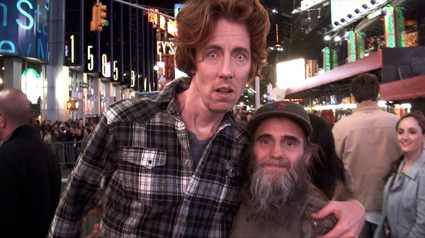
Home 3, Olaf Breunings
courtesy the artist
Home 3, Olaf Breunings
Wandering through a gallery in Denmark a few years ago I came across Swiss artist Olaf Breuning’s Home 2. It’s a disturbing half-hour video in which a bumbling American, Brian Kerstetter, with alarmingly red hair and reptilian contact lenses, tramps through Japan, Papua New Guinea, Switzerland and Ghana. He talks incessantly, portraying the Western world at its most idealistic, naïve, misguided and often offensive. Kerstetter (who possibly may be Breuning—one of art’s little secrets) has all the cringe-worthy yet compelling and revelatory qualities of Ali G. The final work in the Home trilogy sees Kerstetter take on New York, and is currently screening at IMA.
Home 3, Olaf Breuning, Institute of Modern Art, Brisbane; 8 June-27 July; http://www.ima.org.au/pages/exhibitions.php
Still in the loop
Queensland Music Festival
Various venues, QLD, 12-28 July
www.qmf.org.au
TeleScope: Visions from the EU, online screenings
Melbourne International Film Festival
25 July-11 August
http://miff.com.au/program-categories/telescope
Intra-action: Multispecies becomings in the Anthropocene
MOP Gallery, 11-28 July
http://intraactionart.com/
Maude Davey, My life in the Nude
La Mama Theatre, 21 July;
http://lamama.com.au/
Fraught Outfit, Persona
Belvoir, 24 July-18 Aug
http://belvoir.com.au
Personal Space, Tanya Lee
Fremantle Arts Centre
until July 21
http://fac.org.au
Live and Deadly, Carriageworks
27 Jun-1 Aug
http://www.carriageworks.com.au/?page=Event&event=LIVE-AND-DEADLY
My Country, I Still Call Australia Home: Contemporary Art from Black Australia
Queensland Art Gallery/Gallery of Modern Art, 1 June-7 October
http://www.qagoma.qld.gov.au/exhibitions/current/my_country
Helium Season, Malthouse
8 June-5 Oct, see website for following productions
www.malthousetheatre.com.au/helium-2013/
Finucane & Smith’s The Glory Box…Paradise
45 Downstairs, Melbourne, 10 July -11 August
http://www.fortyfivedownstairs.com/events/
Anne Ferran, Box of Birds
Stills Gallery, Sydney; 26 June to 27 July 2013
www.stillsgallery.com.au
Vocal Folds, Gertrude Contemporary
21 June-20 July; performances 11 July, 18 July
www.gertrude.org.au/exhibitions
RealTime issue #115 June-July 2013 pg. web
© RealTime ; for permission to reproduce apply to realtime@realtimearts.net
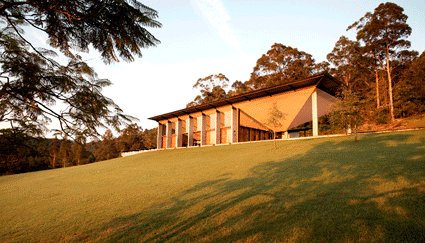
Bundanon Trust
photos Keith Saunders
Bundanon Trust
Bundanon Artist Residencies
Bundanon Trust, 45 minutes out of Nowra in regional NSW, offers a year-long program of residencies in a range of cottages and studios across the homestead and Riversdale sites. Allowing time for research and collaboration, residencies are open to all artists and groups working in all artforms.
Applications close 2 August; www.bundanon.com.au/content/residencies
2013 INSITE Award
Presented by the Australian Writers’ Guild (AWG) and the Adelaide Film Festival, the INSITE award is for unproduced screenplays. The award is open for AWG members. A submission requires a synopsis and sample of the work. (You can join AWG as part of the submission process.) The winner will be invited to meet selected directors and producers at the 2013 Adelaide Film Festival to discuss potential development.
Deadline 26 July, www.awg.com.au
Still in the loop
Abbotsford Convent, Spiritous 2014
Applications due 29 July 2013
http://www.abbotsfordconvent.com.au/venues-hire/cultural-programming
France 24 – Rfi Web Documentary Visa D’or Award 2013
Entry deadline 26 July, 2013
http://www.france24.com/en/webdocumentary-award-2013
Digital Associates Program, QUT Creative Industries Precinct
Friday 12 July 2013
http://www.ciprecinct.qut.edu.au/dap/
Waverley Artist In Residence Program 2014
Deadline Monday 22 July 2013; http://www.waverley.nsw.gov.au/things_to_do/arts_and_culture/AIR_program/about_the_program
PauseFest
Registration and final design submission August 15; http://pausefest.com.au/download_docs/pausefest2014_eoi_details.pdf
Australia Council upcoming deadlines
(for full list see http://www.australiacouncil.gov.au/grants)
Art Fare: Australian Art Export, 12 July 2013
http://www.australiacouncil.gov.au/grants/2013/artfare-12-july
Aboriginal and Torres Strait Islander Arts: Presentation and Promotion 16 July 2013
http://www.australiacouncil.gov.au/grants/2013/aboriginal-and-torres-strait-islander-arts-presentation-and-promotion-16-july
Aboriginal and Torres Strait Islander Arts: Skills and Arts Development 16 July 2013
http://www.australiacouncil.gov.au/grants/2013/aboriginal-and-torres-strait-islander-arts-skills-and-arts-development-16-july
Aboriginal and Torres Strait Islander Arts: Indigenous Arts Workers’ Program, 16 July 2013
http://www.australiacouncil.gov.au/grants/2013/indigenous-arts-workers-program
Hopscotch, 19 July 2013
(for Market Development; National Touring, International touring)
http://www.australiacouncil.gov.au/grants/2013/hopscotch
Music: International Pathways – Round 4, 22 July 2013
http://www.australiacouncil.gov.au/grants/2013/music-international-pathways-22-july
Music: Peggy Glanville-Hicks Residency22 July 2013
http://www.australiacouncil.gov.au/grants/2013/peggy-glanville-hicks-residency
Emerging and Experimental Arts: Creative Australia – New (Art Creative Development), 01 August 2013
http://www.australiacouncil.gov.au/grants/2013/inter-arts-creative-australia-new-art-creative-development
Theatre: Cultural Leadership Skills Development, 05 August 2013
http://www.australiacouncil.gov.au/grants/2013/cultural-leadership-skills-development-theatre
Theatre: New Work, 5 August 2013
http://www.australiacouncil.gov.au/grants/2013/theatre-new-work
Theatre: Fellowships, 5 August 2013
http://www.australiacouncil.gov.au/grants/2013/theatre-fellowships
Creative Australia – Emerging Presenter, 12 August 2013
http://www.australiacouncil.gov.au/grants/2013/Creative-Australia-Emerging-Presenter
Creative Australia – New Digital Theatre, 12 August 2013
http://www.australiacouncil.gov.au/grants/2013/Creative-Australia-New-Digital-Theatre
RealTime issue #115 June-July 2013 pg. web
© RealTime ; for permission to reproduce apply to realtime@realtimearts.net
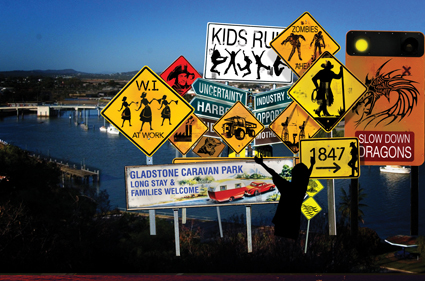
Boomtown, Queensland Festival of Music
Queensland Music Festival
The Queensland Music Festival has always done things big but this year’s director, jazz trumpeter James Morrison, has gone really big. Continuing the festival’s state-wide focus there’s a large-scale community event coming up in Gladstone (18-21 July) and a huge performance in Tambo has already taken place at the end of June. Morrison is also trying to break the Guinness World Record for the largest orchestra (more than 6500 musicians) and the largest trumpet ensemble (more than 1200 players; July 13). More moderately-sized pleasures include 1001 Nights, a collaboration between physical theatre company Zen Zen Zo, Queensland Theatre Company and Persian and Middle Eastern ensemble Pezhvak (18-28 July) and the Brodsky Quartet’s Shostakovich celebration performing the composer’s entire string quartet cycle (19-21 July). The Brodsky Quartet will also team up with Brisbane’s Topology to present Elvis Costello’s Il Sogno (18 July).
Queensland Music Festival, various venues, 12-28 July; www.qmf.org.au
TeleScope online screenings, Melbourne International Film Festival
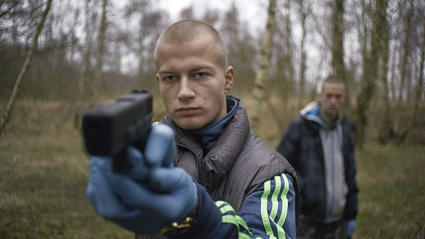
Northwest, Michael Noer
Melbourne International Film Festival is fast approaching and there’s a particularly exciting development for those of us who don’t reside in Melbourne. All films from the TeleScope: Visions from the EU program will be available for online screening around Australia (at a cost of $10 per stream). Twelve films will be available for 24 hours after they first screen at the festival and include films by directors Mark Cousins (UK), Katrin Grebbe (Germany), Sophie Letourneur (France) and Michael Noer (Denmark).
TeleScope: Visions from the EU, online screenings, Melbourne International Film Festival, 25 July-11 August http://miff.com.au/program-categories/telescope (There’s also a selection of previous festival fare available on iTunes – http://miff.com.au/itunes)
Intra-action, MOP Gallery
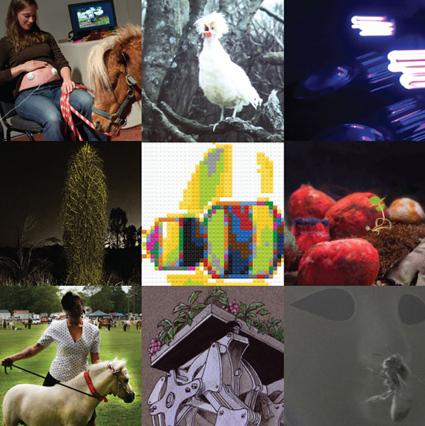
Intra-action, MOP Gallery
courtesy the artists
Intra-action, MOP Gallery
A companion event to the Australian Animal Studies Group Conference (University of Sydney 8-10 July), Intra-action is an exhibition featuring work by Australian and US artists exploring “multispecies entanglements” (website). Artists include Trish Adams whose Urban Swarming is a locative interactive work inspired by bees; Maria Fernanda Cardoso whose oeuvre includes performing fleas and a Museum of Copulatory Organs; and Andre Brodyk who creates images using genetically modified DNA.
Intra-action: Multispecies becomings in the Anthropocene, curators Eben Kirksey, Madeleine Boyd; MOP Gallery, opening 11-28 July, http://intraactionart.com/
Taking Centre Stage–Telling Indigenous stories in Australian theatres
As part of their Creative Forum series NIDA will present a panel discussion on “where indigenous arts practitioners in Australia fit into the mainstream theatre landscape” (press release). Discussion will be led by UK director Kristine Landon-Smith, currently a lecturer in Acting at NIDA who previously ran “black and minority ethnic” theatre company Tamasha, joined by Lydia Miller (Australia Council), Jane Harrison (playwright), Nakkiah Lui (playwright) and Glenn Shea (actor and playwright).
Creative Forum: Taking Centre Stage–Telling Indigenous stories in Australian theatres, NIDA Parade Theatres, 15 July, http://www.nida.edu.au/default.aspx?ArticleID=690
My Life in the Nude, Maude Davey
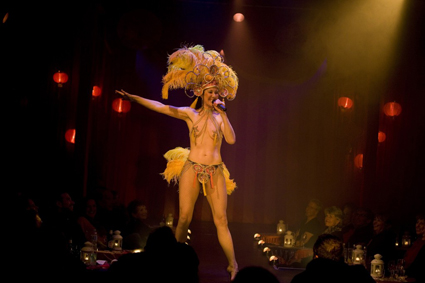
Maude Davey, My Life in the Nude
photo Ponch Hawkes
Maude Davey, My Life in the Nude
Even though it’s chilly, it seems some Melbourne performers can’t keep their clothes on (see last week’s entry on Finucane & Smith’s Glory Box Paradise). Maude Davey, member of Crying in Public Places and former artistic director of Vitalstatistix, is a veteran of the performance scene starting back when it was de rigueur to disrobe to be contemporary. She’s decided maybe it’s time to cover up but is going out with one last naked hurrah in this one-woman show, directed by twin sibling Anni Davey.
Maude Davey, My life in the Nude, till 21 July, La Mama Theatre, Carlton; http://lamama.com.au/
Ensemble Offspring Sizzle
Rapidly becoming an annual event is Ensemble Offspring’s Sizzle, a winter afternoon frolic at the Petersham Bowling Club. This year, curated by percussionist Bree van Rey, the Sizzle features contemporary classical music by John Cage, Erik Griswold and Elena Kats-Chernin in the mix with folk ballads by Grand Salvo and new and newly arranged works for the Bellevue Public Wind Ensemble. And of course, there’s also the lawn bowls.
Sizzle, Sunday 14 July, 3pm, Petersham Bowling Club, http://ensembleoffspring.com/the-music/upcoming-shows/sizzle-2/
Persona, Fraught Outfit
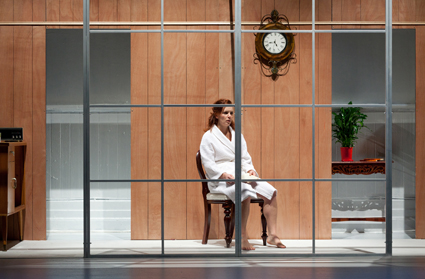
Meredith Penman, Persona
photo Pia Johnson
Meredith Penman, Persona
In RT112 Andrew Fuhrmann wrote about Fraught Outfit’s adaptation of Ingmar Bergman’s Persona: “In order to escape the cinema-face and rise above a mere capitulation of doubtful events, Persona must be de-faced for the stage. It must discover, to use the vocabulary of Deleuze and Guattari… the ancient ‘volume-cavity system’ of the theatre, or the theatre-body.” For those who missed it last time there are a few days left to catch its reprise at Malthouse before it moves to Belvoir.
Fraught Outfit, Persona, based on the film by Ingmar Bergman, conceived by Adena Jacobs, Dayna Morrissey & Danny Pettingill; directed by Adena Jacobs; Malthouse, Melbourne; until 14 July; www.malthousetheatre.com.au; Belvoir 24 July-18 Aug, http://belvoir.com.au
Personal Space, Tanya Lee
Personal Space at Fremantle Arts Centre is a series of playful performative interactions with the flatlands of suburbia. In her debut solo exhibition Tanya Lee creates short videos of figures elaborately camouflaged to match the fencing of the houses they walk past. While part of the landscape the wandering figures are also essentially walled or fenced in.
Personal Space, Tanya Lee, Fremantle Arts Centre, until July 21http://fac.org.au
Instrument Builder’s Project, Yogyakarta
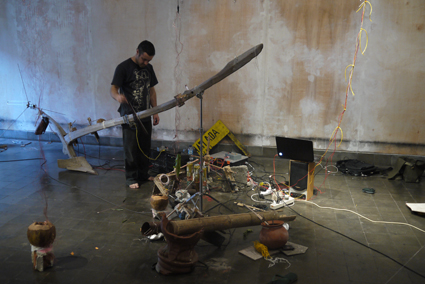
Dylan Martorell, Instrument Builder’s Project, Yogyakarta
photo Joel Stern
Dylan Martorell, Instrument Builder’s Project, Yogyakarta
A merry band of Australian instrument makers has been in residence at the Indonesian Contemporary Art Network (iCAN) in Yogyakarta working with local artists “to create new sounds and new ways of playing” (website). Co-curator Joel Stern tells us that one team, Pia van Gelder, Michael Candy and Andreas Saigain will actually be installing their sensor ‘instruments’ on the side of Merapi volcano. For those on the balmy isle, the residency will culminate in a performance and discussion.
Instrument Builder’s Project, curators Joel Stern, Kristi Monfries, artists Michael Candy, Rodney Cooper, Dylan Martorell, Pia Van Gelder, Ardi M P Gunawan, Asep Nata, Lintang Radittya, Andreas Siagian, Wukir Suryadi; iCAN (Indonesian Contemporary Art Network); Yogyakarta;
https://www.facebook.com/pages/Indonesia-Contemporary-Art-Network-iCAN
Still in the loop
NAIDOC Week
7-14 July
http://www.naidoc.org.au/
Live and Deadly, Carriageworks
27 Jun-1 Aug
http://www.carriageworks.com.au/?page=Event&event=LIVE-AND-DEADLY
My Country, I Still Call Australia Home: Contemporary Art from Black Australia
Queensland Art Gallery/Gallery of Modern Art, 1 June-7 October
http://www.qagoma.qld.gov.au/exhibitions/current/my_country
Collaborateurs, Artereal
3-11 July
http://artereal.com.au/home/collaborateurs
With Open Arms
Blindside, 10-13 July
http://www.blindside.org.au/2013/screen-series.shtml
Revelation Film Festival
various venues, Perth, 4-12 July
www.revelationfilmfest.org/
Show Off, Performance Space
till 17 July; Carriageworks
www.performancespace.com.au/2013/show-off-season/
Helium Season, Malthouse
8 June-5 Oct, see website for following productions
www.malthousetheatre.com.au/helium-2013/
Finucane & Smith’s The Glory Box…Paradise
45 Downstairs, Melbourne, 10 July -11 August
http://www.fortyfivedownstairs.com/events/
Fright or Flight, 3 is a Crowd,
Judith Wright Centre, Brisbane, 6-13 July judithwrightcentre.com/event/fright_or_flight
Anne Ferran, Box of Birds
Stills Gallery, Sydney; 26 June to 27 July 2013
www.stillsgallery.com.au
Vocal Folds, Gertrude Contemporary
21 June-20 July; performances 11 July, 18 July
www.gertrude.org.au/exhibitions
RealTime issue #115 June-July 2013 pg. web
© RealTime ; for permission to reproduce apply to realtime@realtimearts.net
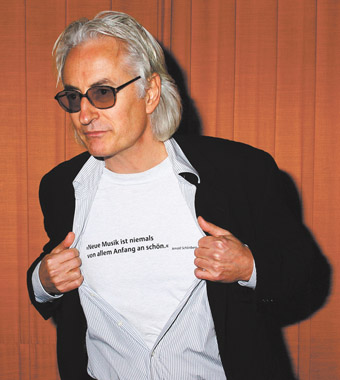
Jon Rose, “Neue Musik ist niemals von allem Angfang an Schön” (New music is never very nice at the beginning)
The title of the City Conversation on 26 June was “You Can’t Stop the Music…unless you have a properly approved Noise Abatement Order.”
You can't stop the music. But you can certainly hinder public debate on the matter.
I've earned my living as a musician for 40 years, mostly playing music that could be described as ‘unpopular,’ but somehow I've survived as the situation for both popular and unpopular music has recently reached impossibly low levels of general interest and sustainability. The public won't pay what it costs to support live, kicking musicians of any genre; they will pay for expensive meals, holidays and the latest shiny piece of technology, but they will not pay the true cost of live music.
Without government subsidy (ie arts funding or the dole—most performing musicians’ income) the entire edifice of music performance in Sydney (and most places in Europe) would crumble, leaving the practice of music as an amateur past time. I care about this; so much so, that I wrote a small book on the subject—suggesting options for changing the situation.
The City Conversation at The Sydney Town Hall on 26 June left me wondering if the whole event was trying to do something to transform the dire situation for live music in Sydney for the better, or the worse.
A colleague and I had with us a small flyer advertising the existence of two books published by nonprofit Sydney publisher Currency House: History is Made at Night: Live Music in Australia by Clinton Walker, and my own The Music of Place: Reclaiming A Practice—both relevant reads to the task in question. Could we leave these flyers on the seats? No, we could not, I was informed. Why not? I asked. Because this event does not allow advertising, was the reply.
I explained that it is on the very subject we are discussing, it is not for profit etc, but to no effect. I asked a gentleman sitting in the next row if he would like one. Yes, he said. So I handed one to him. The official in black swooped—and demanded he give it up immediately, adding that if I continued, I would be removed from the proceedings. I acquiesced, wishing to hear what the panel of experts had to say and not wishing to add to my list of confrontational events on the subject of live music (such as being apprehended by security guards for playing the violin in front of The Sydney Opera House). I underline that we had no books with us to sell; I would be just as happy if people accessed this nonprofit book at their local library.
On taking my seat, one thing became clear. The Sydney Morning Herald was the sponsor, and they told us so on three huge screens. I wondered, was this the same newspaper that used to run several pages of arts reviews in the 1970s, and that these days is mainly content free of such writing? Ah, and here is the first speaker–you guessed it—from The Sydney Morning Herald. He [Bernard Zuel] is described as the “Senior Music Reviewer,” inferring there is a whole team of others out there reviewing concerts right, left and centre. The chair is Meagan Loader, described as “Content Director of Triple J.” That, after decades of ABC management's destructive policies of removing home grown original content from all networks, must be a contradiction of terms.
An opening Australian country duo features a guy singing with a non-ironic put-on American accent. Aren't we supposed to be further on than this by now?
But this is a diversion, as it becomes clear what kind of live music is on parade here. The panel, with the exception of the representative from FBI radio, is really only talking about one kind of music—rock bands. Okay, so we are having a discussion about pub rock, sticky carpets, moshpits and large PA systems. Then why is the whole event set up like a corporate or political party function with 20 or so goons in black patrolling the aisles to make sure no one causes trouble? Why are there three or four rows of VIPs—some look much too young to have ever experienced rock in its Sydney heyday, others look like successful accountants or real estate dealers. Why are our questions moderated through SMS texts or bloody twitter feeds? I'm sitting five meters from the people talking; why can't I ask a question directly to them, face to face? This is symptomatic of our paranoid society, and the control freaks that run and censor free debate, and it has as much to do with the decline of live music as the rise of poker machines, building codes and public liability insurance. The music this panel is discussing used to be in opposition to such hierarchies.
I want to ask Mark Geber, 'the boss' of the Oxford Art Factory, how much he pays his bands when he has his freebie nights—in other words, how much does he think live music (without a minor celeb involved) is actually worth? But I know if I stand up and ask him, I'll be ejected from the meeting, so I bite my tongue instead. Actually, if you listen to the opening remarks from 'the boss' and the agent (I think that was Brett Murrihy, CEO Artist Voice), you would get the impression that everything is going great guns for live music, lots of talent, lots of new ‘acts’ (these two blokes at any rate), couldn't be doing better. Then WTF are we all doing here if there is no problem?! Anybody who comes out with ‘it's all about the music’ and is in arts management, well you better wash your hands after dealing with them. Their breed has not changed since the characters I first met in the late 1960s. The atmosphere in the Town Hall is compliant and conformist—and if that is what Rock and Roll has become, then it deserves to die. The presence of Dave Faulkner of the Hoodoo Gurus only reinforces that we are talking about one kind of live music from the past. The truly mediocre, soft rock that ends the proceedings, confirms it.
The only one who seems to be engaged with the problem of live music in all forms as a necessary component of culture is the quietly spoken and thoughtful John Waddle. As it turns out, he is the Chair of the City of Sydney live music task force. So there is some hope.
If you are involved with other kinds of live music in Sydney, it is important that you raise your voice: creativecity@cityofsydney.nsw.gov.au; www.sydneyyoursay.com.au, facebook.com/cityofsydney
See also Julian Knowles' review of Jon Rose’s Platform Paper, The Music of Place: Reclaiming a Practice and a review Jon Rose's 60th Anniversary CD box set Rosin
RealTime issue #115 June-July 2013 pg. web
© Jon Rose; for permission to reproduce apply to realtime@realtimearts.net
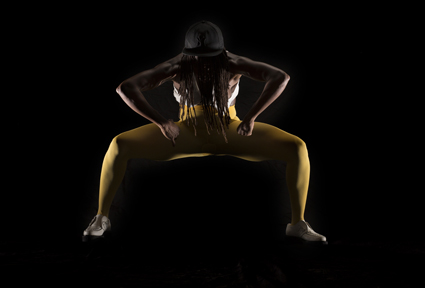
Dana Michel, Yellow Towel
photo Maxyme G Delisle
Dana Michel, Yellow Towel
Recent scholarship in performance and neuroscience reveals that spectatorship is a skill. Perception—visual, aural, olfactory and tactile—is something we learn and get good at. As spectators, we look for a challenge. Too much and we disconnect. Too little and we’re bored. Theatre scholar Bruce McConachie says spectators are always looking for a worthy play partner (Engaging Audiences, 2011). I have five days at Montréal’s FTA and I’m looking for artists with good game.
Dana Michel, Yellow Towel
A figure in black hoodie, baseball cap and pants has descended almost to the floor in an awkward splits. She has one foot in a white inflatable toilet that is beginning to collapse. The other foot is falling out of a black-and-white platform sneaker, revealing a yellow sock. Finger, arm, hip and leg move in contrary directions, each with a mind of its own. Taken as a whole, the gestures are a strange assemblage of North American Black culture clichés—everything from gangsta to Rasta to Fat Albert cartoons mashed together. Choreographer-performer Dana Michel (Band of Bless, Canada) stretches the stereotypes about as far as you can. She also transcends the clichés through uniqueness of movement and an uncompromising ability to be in the moment. Michel gives the impression of not knowing what she’s going to do from one nano-second to the next. Reporting on the weather, she gathers materials as if by accident, tearing a patch of paper from a roll and producing a marker. In a rambling manner she describes meteorological conditions that never quite add up to a forecast—all the while shifting randomly between various Black dialects. By the time she gets to the task of drawing on the paper it has been reduced to a scrunched-up ball. Dutifully and haphazardly she makes a mark on it. Yellow Towel is weird, insightful and hilarious without resorting to predictable contrivances. It achieves a state of imbalance that is revelatory.
Thomas Ostermeier, An Enemy of the People
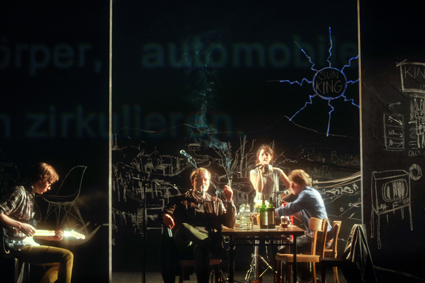
Un Ennemi du Peuple, Thomas Ostermeier
photo Arno Declair
Un Ennemi du Peuple, Thomas Ostermeier
In director Thomas Ostermeier’s (Germany) version of Ibsen’s classic play, hipster versions of Dr. Stockman and his family live in an artist warehouse where they eat, hang out with friends and rehearse covers of Gnarles Barkley and “Eye of the Tiger.” The overall impression is of a laid-back community that values creativity, free speech and the environment. But when Stockman attempts to alert the townsfolk that the local baths, a major source of revenue for the town, are polluted, he is blocked by interests at City Hall and the homeowners’ association. Science versus profit. Truth versus the evils of majority rule. What to do?
Ostermeier hands the question to the audience at Théâtre Jean-Duceppe. The furniture is pushed to the side. The actors literally try to whitewash the issue by throwing paint over the set, which now becomes the site of a town hall meeting. Actor Stefan Stern as Stockman steps up to a podium to address the house directly. Fellow cast members circulate among the audience encouraging responses.
By timely coincidence, the City of Montréal is experiencing its own water contamination issues, the result of corruption and poor management at the civic government level, so the spectators are vocal. But the issues appear to be unresolvable. This is, after all, a middle-class theatre-going crowd. Fixing such problems might require personal sacrifice in the form of higher property taxes and the like. Can a society built on the individual’s right to own property put collective good ahead of material loss? The debate is exciting, but the tendency of this theatrical form and its relatively wealthy audience is to keep the confrontation within manageable limits. We won’t be spilling into the streets to tear down the little castles—too many of us own one of them (I don’t, but I often wish I did). All things considered, the appropriate response is resignation.
Marie Brassard, Trieste
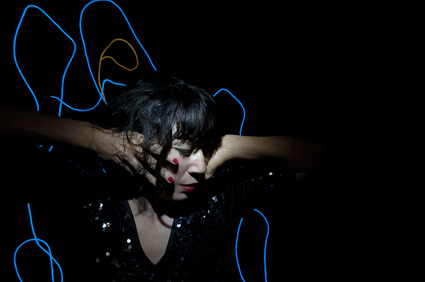
Marie Brassard, La Trieste
photo Minelly Kamemura
Marie Brassard, La Trieste
Marie Brassard (Canada) sits on a high stool front-and-centre. Clad in black from neck to foot, she recedes into the dimly lit surroundings. Her pale face seems at times to float, ghost-like, in space. She speaks of Trieste, a city haunted by literary figures of the past—Dante, Rilke, Joyce. As in her other work, Brassard creates a romantic dialogue with memory and literary history. Faded sepia images of Trieste flicker in the background, always just out of focus, as if viewed through the scratched lenses of a 19th century stereoscope. Two musicians at a table stage-left perform a sound score that is… well… typical of such sound scores—atmospheric, with even tempo and dynamically narrow. Brassard’s narration is likewise measured. Too measured—she seems hypnotised by her own voice; Trieste seems caught in its own spell. Apparently, literary ghosts are legato creatures—they don’t break rhythm. Trieste could use a staccato spectre to inject a jagged surprise or two.
Markus Ohrn, Conte d’amour
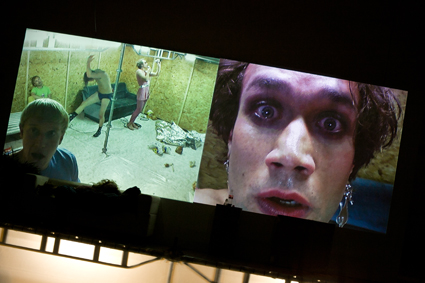
Conte d’Amour, Markus Ohrn
photo Robin Junicke
Conte d’Amour, Markus Ohrn
Spectatorship is never a passive act. We imitate what we see on a neuromuscular level. With our feeling bodies we also make predictions about what will happen next—where or how the actor will move, what she will say. Even in a seemingly static human-centred installation there is micro-movement. There is a particular quality to the unfolding of time. Unpredictability is what engages us. This seems to be lost on too many performance makers and curators. I can’t count the number of shows I’ve seen where one thing happens, I understand that thing early, and it does not change. I’m so far ahead that there is no game to play.
Markus Ohrn, director of Conte d’Amour, says he isn’t worried about boring the audience. He creates an interesting mise en scène: a two-storey structure with a living room on top and a basement underneath, the interior obscured by a thick plastic sheet. Through the sheet several figures are just barely visible, but we get plenty of close-ups of them through live video-feeds from inside the room. A father figure keeps three young men hostage there. For three hours of performance-time he plays a game of dominance and submission with them, feeding them, playing sex games etc. For about 10 minutes the feeling is of creeping horror. Then, as Ohrn intended, the banality of the situation takes over. Horror gives way to boredom and disinterest.
Ohrn, citing his favourite literary critic, argues that the act of paternalistic sex slavery, based as it is on real-life incidents of this nature, is a deviation that transforms love into its opposite. But the situations in Conte d’Amour’s and its real-life equivalents are so extreme they offer no insight into the nature of possessive love. Love has nothing to do with it. Ohrn, however, intends to drive his thesis home with facile, ‘ironic,’ biblical references to fatherhood and with too many live renderings of English-language pop songs that are oh so on-message—“Love will tear us apart again.”
From this I must conclude that Ohrn is a traditional moralist. To ensure we understand that perpetrators of such crimes are not Hollywood villains, but very banal creatures, he drip-feeds us three hours of tedium. Tough medicine, but it’ll strengthen our moral resolve. If, however, you happen to be looking for a greater aesthetic challenge, if you want to wrestle with real moral complexity, watch an episode of The Wire.
Xavier Le Roy, Le Sacre du Printemps
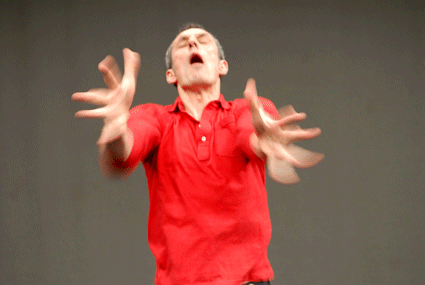
Xavier Le Roy, Le Sacre du Printemps
photos Vincent Cavaroc
Xavier Le Roy, Le Sacre du Printemps
Xavier Le Roy, one of the innovators of contemporary French non-danse, performs the part of conductor in a deconstruction of Stravinsky’s groundbreaking orchestral work The Rite of Spring. He stands alone and conducts in the direction of the audience. Audio speakers have been placed beneath our seats so that we may take on the part of specific instruments. Le Roy might gesture toward one of us as the piccolos sound, and the piccolos will announce themselves from where we sit. He does not use a baton. Rather his whole body is a hopping, thrusting, multi-limbed wand. My understanding of the word deconstruction is “to open something up to multiple meanings.” Le Roy, by embodying The Rite of Spring in this way, is opening it up to multiple hearings. I listen to the score in a new way. But, as Le Roy puts it, I also “listen to movement,” in a new way.
Festival TransAmériques (FTA), Montreal, Canada; 22 May-8 June; http://www.fta.qc.ca/en
This article first appeared as part of RealTime’s online e-dition July 10, 2013
RealTime issue #116 Aug-Sept 2013 pg. 24-25, web
© Alex Lazaridis Ferguson; for permission to reproduce apply to realtime@realtimearts.net
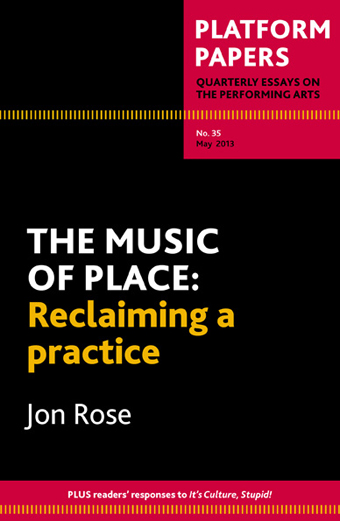 Opportunities for focused debate on the arts in Australia are somewhat rare. The Currency House Platform Papers series provides an important forum and addresses a range of issues around the changes or decline (whichever way you see it) in Australian arts practices and major performing arts institutions. A glance through the catalogue suggests a reasonable commitment to music from a range of voices, albeit one primarily focused on contemporary classical music and jazz.
Opportunities for focused debate on the arts in Australia are somewhat rare. The Currency House Platform Papers series provides an important forum and addresses a range of issues around the changes or decline (whichever way you see it) in Australian arts practices and major performing arts institutions. A glance through the catalogue suggests a reasonable commitment to music from a range of voices, albeit one primarily focused on contemporary classical music and jazz.
Perhaps reflecting a desire by the editors to expand the frame for Australian music, the series recently departed from more mainstream voices to include a paper on live music from popular music writer Clinton Walker, History is Made at Night. Such diversification has been bolstered by the latest paper, The Music of Place: Reclaiming a Practice, by musician Jon Rose, perhaps Australia’s best known and most senior improvising musician, whose early career grew out of the Australian and European free improvisation scenes in the 1970s and 80s. Rose operated for many years in artist-led underground scenes and came to prominence via his prolific output and collaborations with key international players in improvised music and ‘progressive’ new music.
Rose’s offering is a bold manifesto for arresting the decline in the value of music in Australian society, underpinned by a sense of cultural amnesia around the complex interwoven musical histories across Indigenous and non-indigenous cultures. The paper is structured on a thematic level around a critique of the dominant understanding of Australian music history; the relationship of music to place, landscape and society; perceptions of the value of music; music in public life; and the condition of music in an increasingly technologised world.
To set the tone for the paper Rose writes, “not so long ago a musicologist at a Sydney University seminar observed, ‘Everybody knows that music in Australia didn’t really get going until the mid-1960s.’” This historical lie becomes a ‘hook’ that provides the paper with a sense of real purpose and throws into stark relief the prevailing myopic academic and institutional view of Australian music that becomes one of Rose’s key targets. It is not so much the injustice arising from a situation where “the loudest lie becomes the truth” (as John Zorn writes in the preface) so much as the way in which this kind of skewed outlook prevents us from understanding the true role (and value) that music has had, currently has and may potentially have within Australian culture.
Rose confronts this somewhat absurd portrayal of Australia as an outpost of Europe in which little of historical value might have occurred and suggests that such readings of Australian music have contributed to its devaluing, not just historically and culturally, but also economically. In response, he sets about the task of constructing an alternative narrative (which he calls “the other Australia”) that connects the history of Indigenous music making with Australia’s colonial history in useful and persuasive ways. Rose sketches the musical interactions between the Indigenous population and ‘whitefellas’ from the early 19th century, the influence of the church missions of Hermannsberg and New Norcia with their curious syncretic musical outcomes, and the idiosyncratic musical scenes that grew out of 19th century Australia. He concludes with an outline of Australia’s rich history of musical instrument design and early experiments in electronic music that challenge the dominant view that electronic music started in the 1950s.
In compiling this alternative narrative, Rose draws heavily on the work of musicologists John Whiteoak and Alison Rabinovici, supplemented by private conversations with a range of practitioners. Rose’s main contribution here is the idea that this false history around Australian music constitutes a major stumbling block for its future—that the fundamental lack of awareness of our own history found among musicians and major institutions presents us with a kind of dead end.
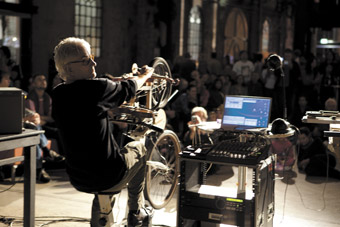
Jon Rose, Pursuit
photo Alex Davies
Jon Rose, Pursuit
Rose proposes, as an alternative, a rethinking of music that grows out of a return to first principles—where music reconnects with concepts of place, landscape, everyday life and the Australian vernacular. Invoking ironic references to European modernism, Rose offers examples of Australian sprechstimme—the race-caller or auctioneer and, with a nod to Olivier Messiaen, suggests that our native bird-song “should be standard knowledge and repertoire.” He further outlines the possibilities for outdoor performances and suggests that Australians’ love of sport could be seen as a fruitful site for musical engagement, citing his own work Perks (1995)—“an interactive badminton game based on the mind and obsessions of Percy Grainger”—and Pursuit (2009) “a bicycle powered orchestra event of hand-made musical instruments.” The thrust of these arguments rests on notions of “embeddedness,” where music is interwoven once again into the fabric of everyday life and connects in authentic ways with our environment and culture.
Rose offers a range of provocations around funding arrangements for major arts institutions and how they may act as barriers to achieving the aim of increasing the value of music and musicians. In a section entitled Resisting the capitalists, Rose cites Australia Council funding distributions where in 2009 “Opera Australia received more funding…than all the applicants for all six of the Australia Council’s major boards combined…That’s one opera company receiving more than seven hundred and eighty one separately funded projects across all those forms.” In the following section, New buildings or new resources?, Rose cites a $1.148 billion spend on major public buildings in the last decade, yet “none of this actually goes to employing musicians to play music…How many open-air concerts of new music could we get for $1.148 billion, hiring ten musicians a concert at $500 each? Some 2,296,000 concerts.” Much of Rose’s argument centres on the idea that we have a system of institutional support that is poorly calibrated towards achieving a vibrant and distinctive future for Australian music. He proposes that we consider what would happen if all this funding were removed and music needed to find a new context that arose out of authentic expression and basic value exchange.
In respect of new technologies Rose takes a fairly dim view of the promise of the internet, arguing that it has provided little concrete assistance to musicians (“the internet is a self-replicating, self-reflective system of almost pure noise”), and further, that the old way of organising tours via letters and telephones was more fruitful and efficient. He concludes his assessment of our digital present and future by re-asserting the value of physical presence and the body as key agents in musical exchange, “music without the agency of the body is music without breath.”
This is an expansive and engaging view of the state of Australian music. Rose’s approach to this Platform Paper closely resembles his prolific and influential musical output. His arguments demonstrate a lateral, creative form of thinking that challenges traditional understandings of history, culture and genre, resulting in a provocative collision of ideas out of which a powerful logic emerges.
Plaftform Papers: Jon Rose, The Music of Place: Reclaiming a Practice, Currency House http://www.currencyhouse.org.au/node/278
See Jon Rose’s response to City of Sydney public conversation on live music 26 June; and a review of Jon Rose’s 60th Anniversary CD box set, Rosin
This article fist appeared as part of RealTime’s online e-dition July 10, 2013
RealTime issue #116 Aug-Sept 2013 pg. 48
© Julian Knowles; for permission to reproduce apply to realtime@realtimearts.net
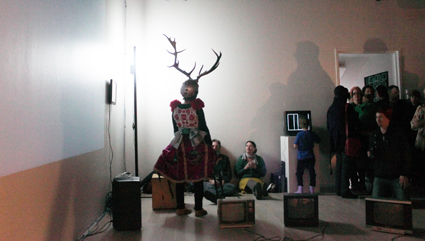
Selena de Carvalho, (un)popular culture
photo Nancy Mauro-Flude
Selena de Carvalho, (un)popular culture
There is a low hum of voice and technology as the artist kneels within a circle of television monitors. She wears a collage of ritualistic gear, a little Hungarian folk, a little found material. On her head an adapted bike helmet, sprouting antlers, balances precariously. With smartphone amplified, she follows the instructions given by a male American voice. He guides a séance for the participants—this circle of obsolete devices.
Asked to hold hands (read cords) of those gathered, artist Selena de Carvalho becomes the conduit between the living and the dead as she attempts to make contact with a lost analogue television signal. I half expect to see a monitor flicker into life. There is so much electronic gear in this gallery space, surely something could flash us a message from the technological afterlife. It doesn’t.
De Carvalho’s (un)popular culture is part of Notorious R + D, an exhibited outcome of Networked Art Forms and Tactical Magick Faerie Circuits (NAF:TMFC), a festival developed by curator Nancy Mauro-Flude and producer Pip Stafford with CAST as part of the DARK MOFO festival. The provocatively long title covers a range of happenings including performances, symposia, radio broadcasts, networking events, exhibitions and workshops and the intentions behind NAF:TMFC are equally multifarious. Stafford describes it as an opportunity to connect a network of people working with similar materials, a chance to share skills among participants and a means to crack open the ‘case’ of technologies that we are often too scared to tinker with. Empowerment is a key expression and in this context hacking is far from a dirty word, instead a means to this end. Within what Mauro-Flude describes as a hothouse environment, eight local artists have made works in response to their NAF:TMFC experience.
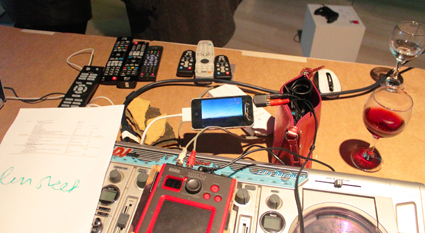
Networked Art Forms and Tactical Magick Faerie Circuits (NAF:TMFC) Presentation Desk. featuring Rahni Allen’s video stream from HELIUM BALLOON LAUNCH # 5 Smartphone Satellite Love Letter to the Universe TEST #1 ( SSLLUT #1 )
photo Nancy Mauro-Flude
Networked Art Forms and Tactical Magick Faerie Circuits (NAF:TMFC) Presentation Desk. featuring Rahni Allen’s video stream from HELIUM BALLOON LAUNCH # 5 Smartphone Satellite Love Letter to the Universe TEST #1 ( SSLLUT #1 )
The evening begins with Rahni Allan’s HELIUM BALLOON LAUNCH # 5, Smartphone Satellite Love Letter to the Universe TEST #1 (SSLLUT #1 – see video of launch by Emma Bugg). In an artist’s statement, she describes herself as being on a mission to communicate her love to the universe. The packed gallery empties into the courtyard to watch Allan, in astronaut-style overalls, release SSLUT #1—an android device strapped to a bunch of orange helium balloons. Launch successful, the crowd pours back in to watch a projected video call to the device. Amusingly, the image we receive is on its side (the gyro function perhaps), so we all tilt our heads accordingly. It is hard not to personify this small climbing phone as it sends back poor quality video like a tiny data-naut. We watch it until it stops—“we ran out of credit,” proclaims Stafford—and the crowd shifts focus. I wonder where SSLUT#1 went, with last frames showing it high above the city, looking down on the winding river at dusk.
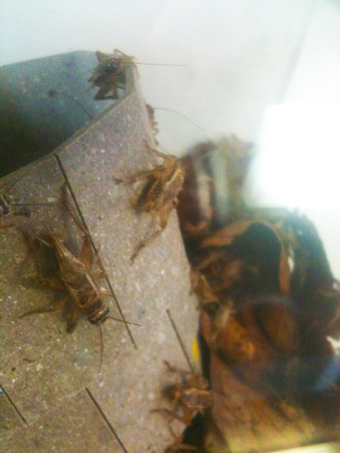
Astrid Joyce, Holla, detail still
photo Nick Smithies
Astrid Joyce, Holla, detail still
In Holla, Astrid Joyce eschews any plugged-in technology. The work is constructed of several clear perspex ‘speaker boxes’ fixed to the wall, containing tiny colonies of crickets nesting within leaf matter. In the dark of the gallery they come to life; we can listen in to their chatter through ‘amplifiers’ on the tops of the boxes. Joyce’s statement suggests that the work draws on an underpinning concept of technology—communication. The delicate, incessant squeaking of the crickets makes me think that this could be the sound of Twitter, as tiny missives roll endlessly into the Twittersphere. (See also Jon Drummond’s Twitter driven sound installation, part of Echosonics, UTS Gallery on realtime tv.)
Jeweller Emma Bugg has constructed a romantic response to NAF:TMFC. Using Instagram, Facebook and a blog site, she has crowd-sourced imagery of accidental hearts—in the footpath, in a fence, in the lichen on a rock. She has crafted a silver-smithed QR code to be worn on the body as a brooch. When the pin is scanned it connects directly to the gallery of found hearts. When I speak to her at the event, Bugg tells me that the call out has produced a kind of positive virus, where her ‘crowd’ is seeing hearts everywhere. If they are seeing hearts, Bugg thinks they’ll be thinking love, so her pin could be an index to a collective mind shift.
Perhaps it is appropriate that I review NAF:TMFC because it sits just outside my comfort zone. I embrace a range of technologies in my daily life, but there is a point at which my mind turns to white noise and the alternate language of artists like these flows over and around me without sticking. Initially I really felt that the aspiration for accessibility and empowerment wasn’t available to me and I would still argue that many will be locked out by the cult-like feel of the event. But with persistence, understanding came. The works, like those described above, where the heart, the ritual, the idea of frailty, are returned to technology, seem to capture the spirit of the endeavour. They hold something I can grasp or identify with. And with time, exploring the exhibition in a near empty gallery, I see that the collected works cultivate potential for play and discovery—qualities that chip away at the white noise and allow for a singular experience.
CAST, Networked Art Forms and Tactical Magick Faerie Circuits, curator Nancy Mauro-Flude, producer Pip Stafford, CAST facilitator/producer Kylie Johnson; http://tacticalmagick.net/; http://www.darkmofo.net.au/program/notorious-rplusd/
RealTime issue #115 June-July 2013 pg. web
© Judith Abell; for permission to reproduce apply to realtime@realtimearts.net
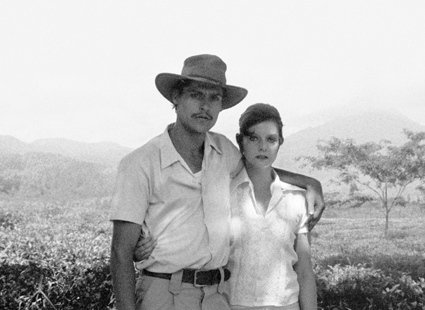
Tabu
With the hype that accompanied it long behind us, it seems fair to say today that Michel Hazanavicius’ The Artist (2011) was little more than a parlour trick: a blatant retelling of Singin' in the Rain that convinced moviegoers it was original; a picture with wall-to-wall music and diegetic sound that convinced them it was silent. It was trickle-down formalism: the inevitable middlebrow stalagmite formed by the steady dripping over time of more ambitious and avant-garde films like Guy Maddin's Eisenstein-Lang mash-up, The Heart of the World (2000), and Steven Soderbergh's cold, airlessly note-perfect recreation of the Classic Hollywood Cinema in The Good German (2006).
Miguel Gomes' Tabu (2012) sits somewhere between Hazanavicius and his betters, but is nevertheless still a parlour trick. Without necessarily meaning to, it makes history disappear, and it is for this reason that it is both a much more interesting and much more problematic film than the Oscar winner that preceded it.
The film is broken up into two parts of roughly equal length. It opens with a prologue: a 1920s silent film about a heartbroken adventurer who, haunted by his dead lover, seeks refuge in the wilds of Africa. The film is being watched by Pilar (Teresa Madruga), a lonely middle-aged woman living in contemporary Lisbon. Pilar's loneliness is as acute as Rui Poças's photography is dismal and grey: her only contact is with an overeager suitor who falls asleep at the movies (Manuel Mesquita); her confused and aging neighbour, Aurora (Laura Soveral); and Aurora's Cape Verdean maid, Santa (Isabel Cardoso).
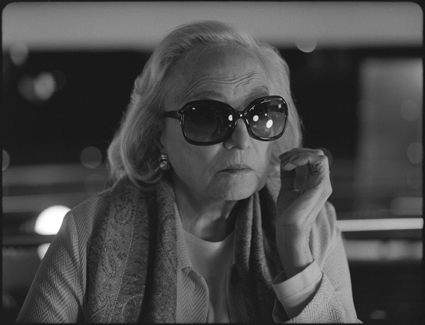
Tabu
Aurora grows ill and asks Pilar to track down one of her former lovers. Pilar does, but is too late: Ventura (Henrique Espírito Santo) never gets to reunite with the love of his life. And so the second part begins: Ventura tells Pilar and Santa the story of his doomed affair with Aurora (Ana Moreira) in an unnamed African colony years earlier. From austerity-hit Lisbon to the sun-drenched foothills of the fictional Mount Tabu, it's Out of Africa or The Short, Happy Life of Francis Macomber meets a Douglas Fairbanks romance-adventure, and while both parts of the film are shot in black-and-white the entire palette suddenly changes.
Like The Good German or Pablo Berger's silent bullfighting fairy-tale, Blancanieves (2012), The Artist was marked by an essential parallelism between its form and the setting of its narrative. Tabu's second part takes a different, rather more ambitious route. There is a distinct gap between the place and period Ventura is recalling—Portuguese Africa at the beginning of the 1960s—and the much older style in which it is being rendered. What's more, unlike Soderbergh's or Berger's, Gomes' rendering is intentionally unfastidious. Yes, when the characters move their mouths to speak, we hear no dialogue. But rather than The Artist or Blancanieve's title cards we get Ventura's style-inappropriate voiceover. Then when the characters open their mouths to sing—early doo-wop tunes, mostly—their lips and the lyrics are perfectly synched. So what is going on here?
The most likely explanation is that Tabu's second part is not the filmmaker's cinematic fetish object—or, at least, not completely—but rather to a significant extent Pilar's. It is a product of an imagination highly but imperfectly influenced by cinema: as in a dream, the films Pilar turns to escape her humdrum existence influence how she imagines Ventura's story.
While this reading might go some way towards explaining why the film seems reluctant to deal with questions about colonialism and its legacy—because they fall outside of the character's frame of reference—it need not go any way towards justifying it. In a European art cinema landscape that has grappled mightily with these questions—think Herzog, Denis, Haneke and the Dardennes, just to name a few—a film that approaches them with purely aesthetic answers is to be viewed with some degree of suspicion.
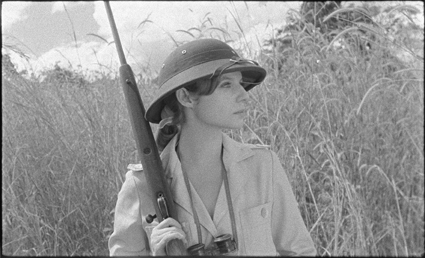
Tabu
Indeed, as idealised by Pilar and aestheticised by Gomes, Aurora's past can't help but come across as somehow preferable to the dreary present, even as black women serve lemonade on the patio and black men move the ping pong table that the white men have left out in the rain. If these glimpses of servitude are intended to come across as somehow damning, they fail to without a lot of heavy lifting from the viewer who must constantly struggle against the niggling feeling that the film is somehow longing for the colonial period. Yes, the appearance of these servants retrospectively situates Santa's life in Lisbon on a spectrum of experience that covers both the colonial and post-colonial periods. But these are hardly the Greek chorus of blue-collar cleaners that populate Sally Potter's Yes (2004), those unseen but all-seeing reminders of the system of oppression that allows these imperial follies to take place. They are, rather, akin to scenery.
What is being explored here, first and foremost, is a romance between two privileged whites: colonial Africa is a setting like any other, seismic events potential plot points, history a mere surface. Along with films like Claire Denis' White Material (2009), I occasionally found myself comparing Tabu unfavourably to Quentin Tarantino's Inglorious Basterds (2009) and Django Unchained (2012). Tarantino shares Gomes' impulse towards homage and bricolage, but to degrees of success that are open to debate, also seeks to channel that impulse towards at least some kind of historical inquiry. Tarantino may be the least theoretical, least philosophical filmmaker working today, but he nevertheless uses his ultra-cinematic style to place certain problems front and centre. Tabu, in striking contrast to this, uses its style to brush such problems aside.
Tabu, director Miguel Gomes, distributor Palace Films; http://www.palacecinemas.com.au/movies/tabu/
See also Philip Brophy’s take on Tarantino’s soundtracking of Django Unchained in RT114’s Audiovision
RealTime issue #115 June-July 2013 pg. web
© Matthew Clayfield; for permission to reproduce apply to realtime@realtimearts.net
NAIDOC Week
The second week of July brings NAIDOC week celebrating Aboriginal and Torres Strait Islander people and culture. This year’s theme, “We value the vision: Yirrkala Bark Petitions 1963,” commemorates the Yolgnu people’s missive to the Australian House of Representatives in which they protested mining in Arnhem Land and demanded recognition of the traditional owners and their land rights. There is an enormous range of activities across all states including the NAIDOC Awards, performances and screenings. Check the website for activities near you.
NAIDOC Week, national, 7-14 July http://www.naidoc.org.au/
For more on Yirrkala Bark Petitions see http://australia.gov.au/about-australia/australian-story/bark-petitions-indigenous-art
Live and Deadly, Carriageworks
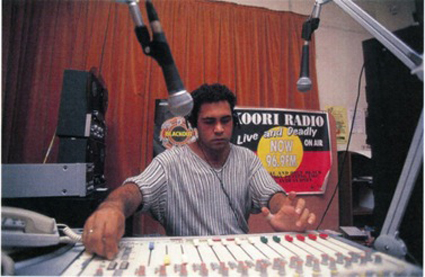
Trevor Dodds – Koori Radio 93.7FM Presenter
courtesy of Gadigal Information Service
Trevor Dodds – Koori Radio 93.7FM Presenter
Extending the NAIDOC week spirit across the month Live and Deadly celebrates 20 years of the Gadigal Information Service in Redfern which also houses Koori Radio (93.7FM). Across July Carriageworks will host an exhibition of archives, photos, films and radio recordings documenting this vital and groundbreaking community organisation. There’s also live music including Klub Koori (July 4) and forums such as The Foundations of Koori Radio (July 4) and The Digital Future: Kooris in Space (July 25).
Live and Deadly, Carriageworks, 27 Jun-1 Aug; http://www.carriageworks.com.au/?page=Event&event=LIVE-AND-DEADLY
My Country, I Still Call Australia Home, Queensland Art Gallery
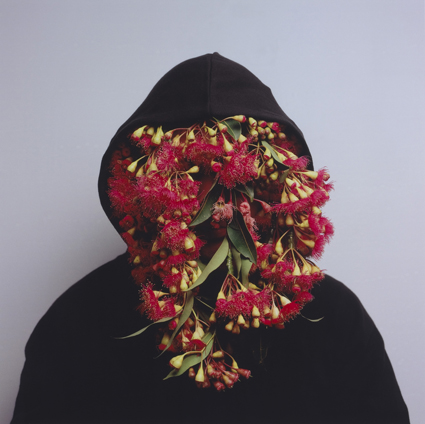
Christian Thompson (Bidjarra/Kunja people)
Black Gum 2 (from ‘Australian Graffiti’ series) 2008
Purchased 2008, The Queensland Art Gallery Foundation Grant, collection: Queensland Art Gallery
Christian Thompson (Bidjarra/Kunja people)
Black Gum 2 (from ‘Australian Graffiti’ series) 2008
This exhibition offers the largest display of Indigenous art to date for QAG/GOMA featuring the work of 116 artists from across the country. Curated by Bruce McLean the 300 works on display are divided into three themes: My History, My Life, My Country. Artists include Vernon Ah Kee, Michael Riley, Brook Andrew, Judy Watson, Warwick Thornton, Destiny Deacon, Fiona Foley and Christian Thompson. There are also two site-specific commissions from Reko Rennie and Megan Cope, and Gordon Hookey has been commissioned to make Kangaroo Crew, a large-scale interactive work for the children’s centre. Accompanying the exhibition is a screening program at the cinematheque, My Life as I Live It: First Peoples and Black Cinema.
My Country, I Still Call Australia Home: Contemporary Art from Black Australia, Queensland Art Gallery/Gallery of Modern Art, 1 June-7 October; http://www.qagoma.qld.gov.au/exhibitions/current/my_country
The Western Australian Composers Project Concerts, PICA
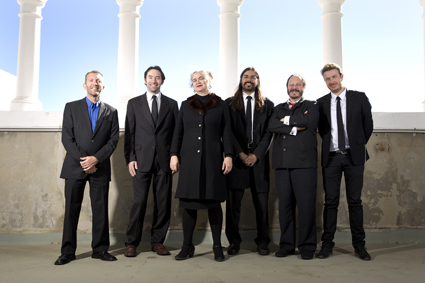
Decibel in the PICA Clock Tower
photo Brad Serls
Decibel in the PICA Clock Tower
While PICA is undergoing some upheaval with urgent building repairs that have meant the postponement of the exhibition Improvised Sound Project, there’s still plenty going on. Decibel have been in residence with the Western Australian Composers Project presenting open rehearsals and honing their compositional methods and innovative score reading systems. The residency concludes with two concerts featuring works by Western Australian composers Christopher Tonkin, Rachael Dease, Sam Gillies, Johannes Luebbers, Henry Anderson and Decibel members Cat Hope, Lindsay Vickery and Stuart James.
The Western Australian Composers Project Concerts, PICA, 5 & 6 July, 6.30pm; http://www.pica.org.au/view/WA+Composers+Project+Residency/1664/
The Glory Box…Paradise, Finucane & Smith
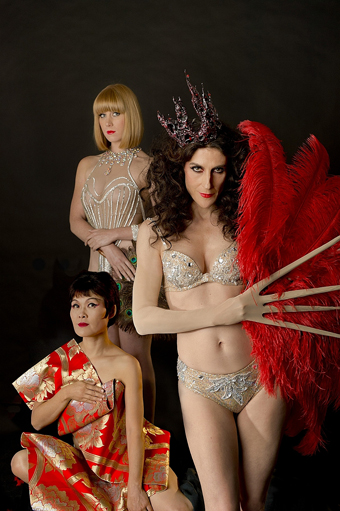
(l-r) Yumi Umiumare, Holly Durant, Moira Finucane, Glory Bok…Paradise
photo Jodie Hutchinson
(l-r) Yumi Umiumare, Holly Durant, Moira Finucane, Glory Bok…Paradise
Moira Finucane and Jackie Smith have been presenting bent burlesque for around 20 years, leading the way for the recent resurgence of interest in naughty cabaret. They will be presenting their annual winter showcase at 45 Downstairs over July with special international guests “dance siren” Holly Durant from Paris and red hanky stripper Ursula Martinez from London as well as the always captivating Yumi Umiumare and Circus Oz Ring Mistress Sarah Ward. The show will then tour to the Festival de Internacional de Buenos Aires in Argentina in October.
Finucane & Smith’s The Glory Box…Paradise, 45 Downstairs, Melbourne, 10 July -11 August; http://www.fortyfivedownstairs.com/events/
Collaborateurs, Artereal
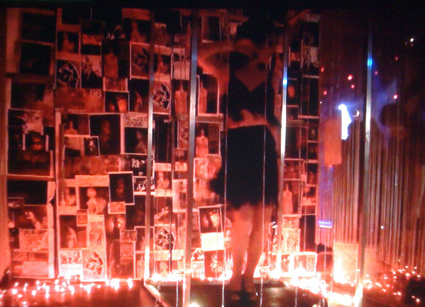
Bridie Connell, Free Fall performance 2012
Over nine days a three by three meter white cube at Artereal will be home to nine collaborative explorations. The resulting works will utilise a range of techniques from flower arranging to choreography and illustrate how “collaboration has moved into the mainstream of visual arts practice in the past decade” (press release). Artists include David Capra continuing his fetish for the Wizard of Oz here rendered in clay; brother and sister duo Michael and Karina Wikamto who will simultaneously make their family tree via computer generated images and sculptural collage; and Liam Benson working with Nic Atkins to create a pas-de-deux on masculinity.
Collaborateurs, artists Ella Barclay, Liam Benson, David Capra, Bridie Connell, Tully Arnot & Charles Dennington, Nola Diamantopoulos, Leahlani Johnson, Sylvia Schwenk, Michael & Karina Wikamto, Artereal, Rozelle, 3-11 July; http://artereal.com.au/home/collaborateurs
With Open Arms, Blindside
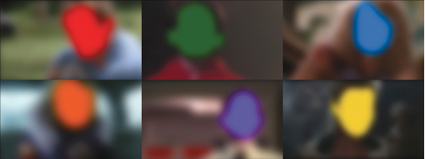
Daniel McKewen, Untitled (after Steven and John) (2013), single channel video installation
courtesy the artist
Daniel McKewen, Untitled (after Steven and John) (2013), single channel video installation
With Open Arms is an exhibition of video art reflecting the variety of ways young artists are manipulating the medium of video. Appropriated footage features strongly, for example Josephine Skinner has collected hundreds of YouTube clips of people singing “Hopelessly Devoted to You,” while Daniel McKewan explores abstraction via the filmic close-up. Antoinette J Citizen’s work takes a playfully subversive line as she attempts to cheat facial recognition software.
With Open Arms, curators Raymonda Rajkowski, Felicity Strong, also includes Tara Cook and Jonathon Nokes, Blindside, 10-13 July; http://www.blindside.org.au/2013/screen-series.shtml
Cache in Point, Red Rattler
This concert is a curatorial collaboration between vocalist Sonya Holowell and flautist Elia Bosshard who will be presenting “obscure classical music in an interdisciplinary landscape…with a ‘touch’ of theatrics” (website). The program includes works by Xenakis, Stockhausen, Schoenberg and Carl Vine juxtaposed with improvisations and dance for good measure.
Cache in Point, performers Elia Bosshard, Sonya Holowell, Ivan Cheng, Pat Keith, John Napier, Dean Kennedy, Jonathan Holowell, James McCaffrey, Liam O’Keefe, Red Rattler, Thursday, July 4, 7.30pm; https://www.facebook.com/events/575714642449943/?fref=ts
Christy Dena, The Block Digital Writing Residency
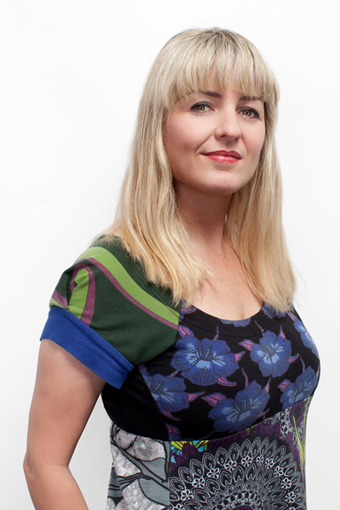
Christy Dena
Congratulations to sometime RealTime writer Christy Dena who has been awarded the inaugural QUT Digital Writing Residency. Her project, Robot University will explore the relationship between humans and robots and the development of ethics in this area. She will be collaborating with programmer Adam Single and sound composer Jacek Tuschewski utilising the game engine Unity to create an interactive narrative experience for viewers. The project is expected to be completed early 2014.
http://www.thecube.qut.edu.au/about/residency.php
Still in the loop
Revelation Film Festival
various venues, Perth, 4-12 July
www.revelationfilmfest.org/
Show Off, Performance Space
till 17 July; Carriageworks
www.performancespace.com.au/2013/show-off-season/
Helium Season, Malthouse
8 June-5 Oct, see website for following productions
www.malthousetheatre.com.au/helium-2013/
Fright or Flight, 3 is a Crowd,
Judith Wright Centre, Brisbane, 6-13 July judithwrightcentre.com/event/fright_or_flight
Anne Ferran, Box of Birds
Stills Gallery, Sydney; 26 June to 27 July 2013
www.stillsgallery.com.au
Vocal Folds, Gertrude Contemporary
21 June-20 July; performances 11 July, 18 July
www.gertrude.org.au/exhibitions
RealTime issue #115 June-July 2013 pg. web
© RealTime ; for permission to reproduce apply to realtime@realtimearts.net
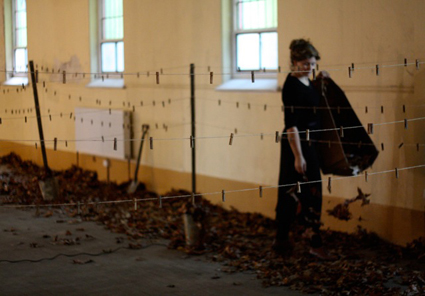
Jody Cleaver in the Chapel installing her site responsive Spiritous project Within/Out. 1-24 June 2013, Sacred Heart Oratory, Abbotsford Convent
Abbotsford Convent, Spiritous 2014
The Abbotsford Convent Foundation in Melbourne is calling for proposals for their site-specific residency program Spiritous. All artforms are considered and applicants should address ideas around “Indigenous heritage, local culture, history, geographical position and the diversity of the local demographic” (website).
Applications due 29 July 2013; http://www.abbotsfordconvent.com.au/venues-hire/cultural-programming
Quickfire residencies, Performance Space
Just announced 5 x 1 week residencies across August/September for artists at any stage in their careers to start the development of a performance work. You'll receive space, some technical and curatorial support and a stipend.
Deadline 8 July, 2013, 5pm; http://www.performancespace.com.au/2013/call-for-proposals-quickfire-residency-program/
France 24 – Rfi Web Documentary Visa D’or Award 2013
Run by the international TV news channel FRANCE 24, radio station RFI and the festival for photojournalism Visa pour l’Image, this competition offers a whopping 8000 euro prize to the best web documentary. Defined as an “online documentary that uses image, text, sound and videos and has an interactive dimension,” interesting examples can be viewed on their website. Entries must have been made in the last year and be in either English or French.
Entry deadline: July 26th, http://www.france24.com/en/webdocumentary-award-2013
ADT Youth Ensemble
South Australia's leading dance company Australian Dance Theatre is forming a youth ensemble. Dancers aged between 14 and 18 are invited to apply to participate in tuition and rehearsals across school terms.
Applications due July 5, auditions July 11; http://adt.org.au/
Still in the loop
Dancehouse, Housemates Performance 2014
Deadline (extended) July 5; http://www.dancehouse.com.au/research/researchdetails.php?id=81
Small Screen 2014, Screen Space
Deadline 8 July
http://screenspace.com/proposals.html
Digital Associates Program, QUT Creative Industries Precinct
Friday 12 July 2013
http://www.ciprecinct.qut.edu.au/dap/
Waverley Artist In Residence Program 2014
Deadline Monday 22 July 2013; http://www.waverley.nsw.gov.au/things_to_do/arts_and_culture/AIR_program/about_the_program
PauseFest
Registration and final design submission August 15; http://pausefest.com.au/download_docs/pausefest2014_eoi_details.pdf
Australia Council upcoming deadlines
(for full list see http://www.australiacouncil.gov.au/grants)
Art Fare: Australian Art Export, 12 July 2013
http://www.australiacouncil.gov.au/grants/2013/artfare-12-july
Aboriginal and Torres Strait Islander Arts: Presentation and Promotion 16 July 2013
http://www.australiacouncil.gov.au/grants/2013/aboriginal-and-torres-strait-islander-arts-presentation-and-promotion-16-july
Aboriginal and Torres Strait Islander Arts: Skills and Arts Development 16 July 2013
http://www.australiacouncil.gov.au/grants/2013/aboriginal-and-torres-strait-islander-arts-skills-and-arts-development-16-july
Aboriginal and Torres Strait Islander Arts: Indigenous Arts Workers' Program, 16 July 2013
http://www.australiacouncil.gov.au/grants/2013/indigenous-arts-workers-program
Hopscotch, 19 July 2013
(for Market Development; National Touring, International touring)
http://www.australiacouncil.gov.au/grants/2013/hopscotch
Music: International Pathways – Round 4, 22 July 2013
http://www.australiacouncil.gov.au/grants/2013/music-international-pathways-22-july
Music: Peggy Glanville-Hicks Residency22 July 2013
http://www.australiacouncil.gov.au/grants/2013/peggy-glanville-hicks-residency
Emerging and Experimental Arts: Creative Australia – New (Art Creative Development), 01 August 2013
http://www.australiacouncil.gov.au/grants/2013/inter-arts-creative-australia-new-art-creative-development
Theatre: Cultural Leadership Skills Development, 05 August 2013
http://www.australiacouncil.gov.au/grants/2013/cultural-leadership-skills-development-theatre
Theatre: New Work, 5 August 2013
http://www.australiacouncil.gov.au/grants/2013/theatre-new-work
Theatre: Fellowships, 5 August 2013
http://www.australiacouncil.gov.au/grants/2013/theatre-fellowships
Creative Australia – Emerging Presenter, 12 August 2013
http://www.australiacouncil.gov.au/grants/2013/Creative-Australia-Emerging-Presenter
Creative Australia – New Digital Theatre, 12 August 2013
http://www.australiacouncil.gov.au/grants/2013/Creative-Australia-New-Digital-Theatre
RealTime issue #115 June-July 2013 pg. web
© RealTime ; for permission to reproduce apply to realtime@realtimearts.net
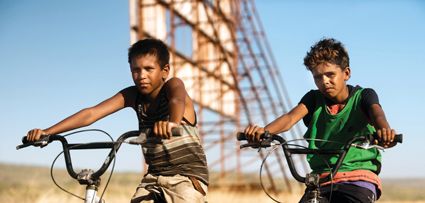
Cameron Wallaby, Joseph Pedley, Satellite Boy
In Catriona McKenzie's Satellite Boy, two Indigenous 12-year-olds take a journey into country, and we walk the land with them.
Charting the experience of Pete, who runs away with his best friend Kalmain in search of the mining company which has repossessed the home he shares with his grandfather Jagamurra (David Gulpilil), Satellite Boy is a meditative, expansive film which enfolds us in its depiction of the remarkable Kimberley region of Western Australia. Though effective as a film for adults, it possesses the archetypal qualities of a classic children's story: resourceful child heroes, a voyage of self-discovery and a pervasive innocence.
This is McKenzie's first feature film, but the assurance gained through an extensive career in short films and Australian television drama (including such series as RAN, The Circuit and Redfern Now) is apparent in her sensitive use of imagery and her ability to convey the essence of a story without distraction. Satellite Boy has a mythic simplicity: at its heart is the land itself and our relationship with it. McKenzie, who is Gurnai from the Gippsland region in Victoria, chose to set the film in the Kimberley because “the country is strong. It hums with stories” [production notes]. As the film's young protagonists divert from the road into the wilderness, we move into country which is sometimes stark and at other times surprising in its richness.
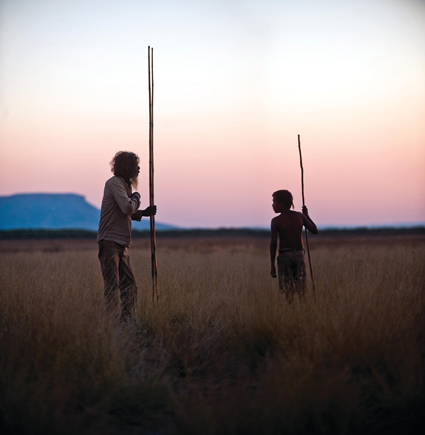
David Gulpilil, Cameron Wallaby, Satellite Boy
McKenzie and her DOP Geoffrey Simpson (Shine, Romulus My Father, Sleeping Beauty) give us both intimate detail and the bigger picture, dividing the cinematography between majestic landscape shots and close-ups of faces and bright details (a green frog under a dripping tap; Pete's red toy robot). There is a sense of great space throughout the film, of magnificent isolation. The boys ride their bikes over cracked earth, dwarfed by the landscape. Aerial shots display the Kimberley's vastness. Skillfully, McKenzie creates a sense of events unfolding in real time, her attention to the rhythms and changing light of each day enveloping us in the boys' experience. Sound is for the most part naturalistic, David Bridie's breezy refrain brought in strategically during Pete and Kalmain's most playful scenes.
The land in Satellite Boy is an active presence. Formidable yet reassuring, its message merges with the voice of Jagamurra, as it prompts, “Who are you? Listen!” While Pete and Kalmain are in a sense lost and struggling with issues of identity, the country they walk through is far from the malignant entity represented in the archetypal 'lost child' narrative of European Australian fiction. Though not to be treated lightly, it is ultimately a place of belonging for Pete, a protective force. As Pete says, quoting his grandfather: “You look after country; country will look after you.” The sacredness of country is emphasised verbally by the refrain “everything is connected” and visually by the recurring elemental motifs of stars and fire.
Satellite Boy has similarities to Australian children's classic Storm Boy (1976), whose name it echoes and Nicholas Roeg's Walkabout (1971), both of which McKenzie has cited as formative influences [Filmink, May 2013]. In all three films, characters are caught between the powerful, sustaining world of the land, with its ancient lore; and the fast-paced, less trustworthy world of modern commercialised Australia, with each film offering a very different outcome.
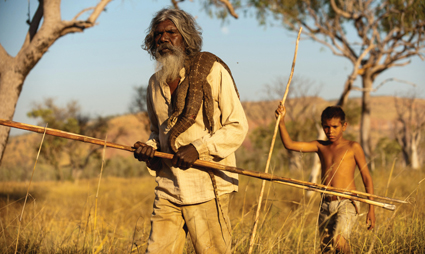
David Gulpilil, Cameron Wallaby, Satellite Boy
David Gulpilil plays the role of guide and protector in all three films: a mediator between the land and the other characters. In Walkabout, he's the adolescent boy who leads the deserted sister and brother to safety, with devastating consequences for himself. As the nomadic Fingerbone in Storm Boy, he becomes friend and mentor to the free-spirited young protagonist. In Satellite Boy, he's the grandfather who steps in to care for his grandson after the boy's mother leaves for the city, and who teaches him the survival methods and lore of his people.
Performances in Satellite Boy are uniformly strong. Young leads Cameron Wallaby and Joseph Pedley convey the highs and lows of their characters' journey with expressive naturalism, their rapport seemingly authentic. It would be easy for McKenzie to allow the sublime quality of the landscape to overshadow her protagonist's story, but this doesn't happen. In this deceptively simple film, all elements are balanced. The humans are part of the land, and the land is part of them in turn. This is a thoughtful, arrestingly beautiful film with a warm and inclusive approach to both characters and audience. A celebration of friendship, belonging and the infinite significance of country, it's a worthy addition to the Australian cinematic canon.
Satellite Boy, writer-director Catriona McKenzie, cinematography Geoffrey Simpson, editor Henry Dangar, sound designer Liam Egan, composer David Bridie, Hopscotch and Satellite Films in association with Screen Australia, Screen NSW, Screen West and ABC TV, 2012; in national release June 20
RealTime issue #115 June-July 2013 pg. web
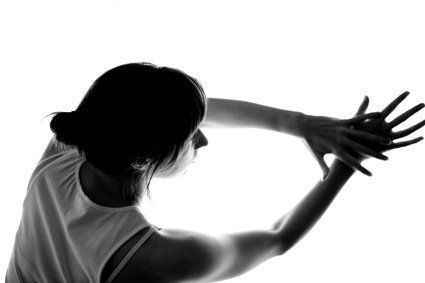
Phoebe Robinson Housemate Performance I
Dancehouse, Housemates Performance 2014
The Housemate Performance applications have been brought forward six-months and are now open. This is a fully-funded residency programmed for the first half of 2014 at Dancehouse which allows a choreographer the space to develop a new work.
Deadline (extended) July 5; http://www.dancehouse.com.au/research/researchdetails.php?id=81
PauseFest
Pausefest is calling for submissions for installations to be exhibited at Federation Square as part of their 2014 Festival. Applications need to address the theme Connected. A short list of 10 designs will be selected to appear on the PauseFest website and Federation Square’s big screen. The two winners will be awarded $5000 to realise their installation for the festival.
Registration and final design submission August 15; http://pausefest.com.au/download_docs/pausefest2014_eoi_details.pdf
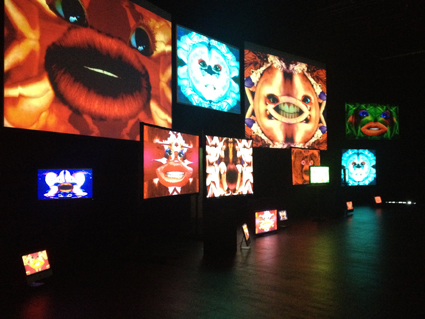
Majena Mafe, Soundage 2012 at The Block, QUT
Digital Associates Program, QUT Creative Industries Precinct
Applications are now open for artists and curators to propose media art and digital projects that will make use of QUT’s The Block and associated facilities. Through the Digital Associates Program successful applicants will receive subsidised access to the space and infrastructure. This round is timed to assist with applications to state and federal funding bodies.
Friday 12 July 2013; http://www.ciprecinct.qut.edu.au/dap/
Waverley Artist In Residence Program 2014
Waverley Council in Sydney is offering three studios rent-free for six months in the School of Arts (138 Bondi Road). Applications are open to all artforms including collaborative practices.
Deadline Monday 22 July 2013; http://www.waverley.nsw.gov.au/things_to_do/arts_and_culture/AIR_program/about_the_program
Small Screen 2014, Screen Space
Dedicated to the exhibition of video work, Screen Space in Melbourne is calling for applications for their Small Screen program which features single channel works on a large LCD monitor in the foyer.
Deadline 8 July; http://screenspace.com/proposals.html
Brisbane Fringe Festival
Young Brisbane entrepreneurs who felt the city was big enough for an open platform, free-for-all fringe festival running parallel to the Brisbane Festival, have established the Brisbane Fringe Festival, playing 1-14 September this year. Registrations are now open for all forms of festivities.
Deadline for submission 27 July; http://brisbanefringefestival.com/
RealTime issue #115 June-July 2013 pg. web
© RealTime ; for permission to reproduce apply to realtime@realtimearts.net
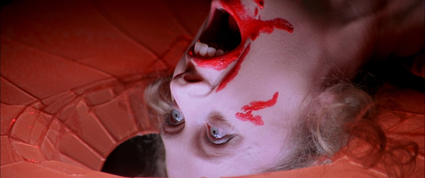
Suspiria, Dario Argenta
Revelation Film Festival
Jack Sargeant once again offers an eclectic and comprehensive program for the 2014 instalment of Revelation: Perth International Film Festival. Highlights include 1970s prog-rock band Goblin performing their original soundtrack to Dario Argenta’s Suspiria; the opening night documentary feature Burn which follows fire-fighters in Detroit, city of extreme arsonists; and the Iranian drama Facing Mirrors about female liberation and transgender issues. There are also a host of documentaries with subjects such as Divine, John Fahey (the late, much celebrated American guitarist) and Pussy Riot. Then there’s RevCon, the associated conference and its associated conference RevCon Academic for the even deeper thinking film buff.
Revelation Perth International Film Festival, various venues, Perth, 4-12 July; www.revelationfilmfest.org/
Show Off, Performance Space
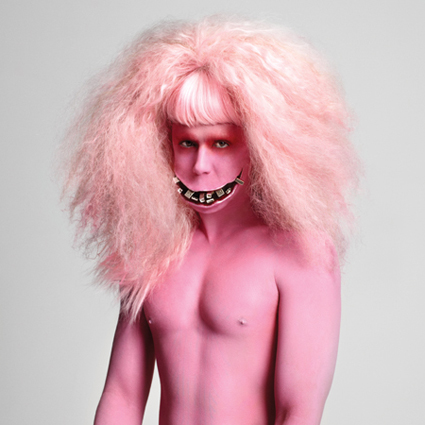
Justin Shoulder, The River Eats (2013)
photo Jordan Graham
Justin Shoulder, The River Eats (2013)
One of the most arresting promotional images to float into my inbox this year is from Justin Shoulder’s The River Eats. A kind of Leigh Bowery meets Matthew Barney, Shoulder’s performances at Underbelly 2011 and Next Wave 2012 (where this show debuted) certainly impressed with their extravagant visual theatricality. The River Eats (3-13 July), is part of Performance Space’s Show Off program along with those popular culture tricksters Team MESS who are making a new cop show, Bingo Unit (10-13 July), and Roslyn Oades’ I’m Your Man (10-17 July), a hit in the 2012 Sydney Festival set in the world of boxing.
Performance Space, Show Off, til 17 July; Carriageworks; www.performancespace.com.au/2013/show-off-season/
Helium Season, Malthouse
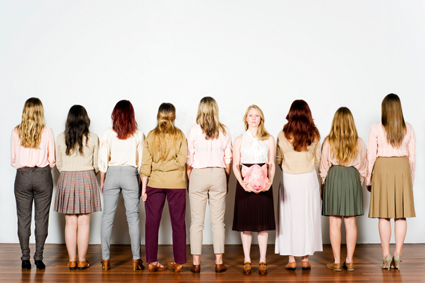
Lord of the Flies, US-A-UM
photo Marnya Rothe
Lord of the Flies, US-A-UM
The annual season of works by independent artists and collectives will roll out at Matlhouse from July through to September and the first two shows look particularly terrifying and tasty. New theatre company US-A-UM headed by Kip Williams (whose STC Under Milkwood impressed last year, see RT109) will present an all-female cast adaptation of William Golding’s The Lord of the Flies (28 June-14 July). The Public Studio also proved itself a complex force to be reckoned with in the recent production Until Then, Then (see RT114). This Will be Beautiful, their installation-come-film-come-performance, looks to similarly challenge theatrical expectations (19 July-3 August).
Malthouse Helium Season, 28 June-5 Oct, see website for following productions; www.malthousetheatre.com.au/helium-2013/
pulse:heart:beat, Synergy, TaikOz
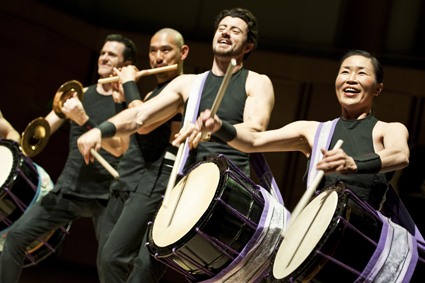
TaikOz, pulse:heart:beat
photo Karen Steains
TaikOz, pulse:heart:beat
This concert brings Sydney’s leading percussion outfits Synergy and TaikOz together in an epic drum-off. Program highlights include Masae Ikegawa’s Four Winds in Hachijo-daiko drum style using complex choreographed gestures; the rousing rhythmic complexity of Timothy Constable’s Cannons of Navarro; and Anton Lock’s epic Rhythm River, the title perhaps speaking for itself. Some works will be accompanied by video, both live and prerecorded by Tokyo Love-In, Chris Wilson, Colin Rich and Brad Kremer.
pulse:heart:beat, Synergy, TaikOz, City Recital Hall, 28-29 June; www.cityrecitalhall.com
Staging Broome Stories, Playwriting Australia
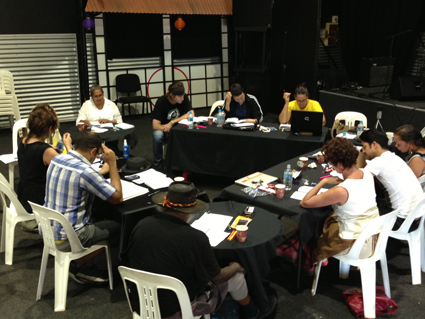
Staging Broome Stories, Playwriting Australia
photo Teik-Kim Pok
Staging Broome Stories, Playwriting Australia
Since 2009 Playwriting Australia has been working with emerging writers in Broome to create full-length plays reflecting the diversity and uniqueness of the Kimberley region. After extensive workshopping at the National Playwriting Festival (2012) and Yellamundie (2013) these works by Jub Clerc, Dan Lee, Jacqui Wright, Deb Hannagan and Sermsah Bin Saad will now be presented as staged readings in their home town, directed by Yirra Yaakin’s Artistic Director Kyle Morrison with dramaturg Mari Lourey.
Staging Broome Stories, Goolarri Gimme Club, Broome; 27 June, www.pwa.org.au/broome-play-readings/
Fright or Flight, 3 is a Crowd
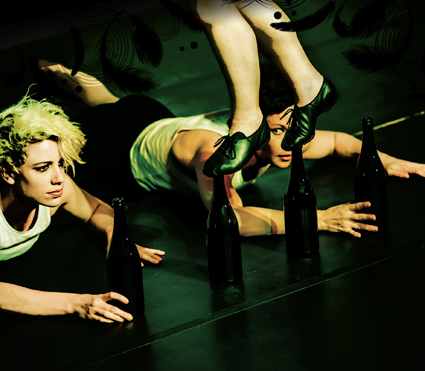
Fright or Flight, 3 is a Crowd
courtesy the artists
Fright or Flight, 3 is a Crowd
In a recent article for RT115 “Circus: second class artform?” Antonella Casella surveys a selection of emerging circus artist and groups exploring “the possibility of circus as pure spectacle, as part of the interplay of form and content.” Further evidencing a resurgence of the form here’s another new ensemble, 3 is a crowd. The all girl trio’s bird-themed Fright or Flight (winner of Best Circus and Physical Theatre in Adelaide Fringe Festival 2013) is about to play Brisbane’s Judith Wright Centre.
Fright or Flight, 3 is a Crowd, Judith Wright Centre, Brisbane, 6-13 July; judithwrightcentre.com/event/fright_or_flight
Box of Birds, Anne Ferran
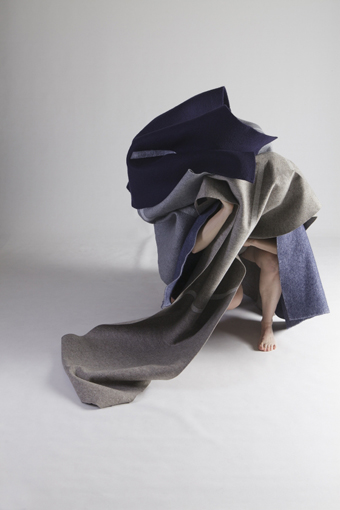
Anne Ferran, Slender-throated warbler, 2013
courtesy the artist & Stills Gallery
Anne Ferran, Slender-throated warbler, 2013
Box of Birds uses as its source material a series of photographs from the 1940s depicting nameless women in a Sydney psychiatric hospital. Photographer Anne Ferran has drawn on this material previously (see her work 1-38) but here she departs dramatically from the subject matter. Ferran has re-staged the images abstractly asking female performers to improvise with large pieces of felt that represent the crumpled clothing of the original images. Through this process Ferran attempts to “elicit the energy… trapped in those 1940s photographs, their unquiet spirit” (website).
Anne Ferran, Box of Birds, Stills Gallery, Sydney; 26 June to 27 July 2013; www.stillsgallery.com.au
Vocal Folds, Gertrude Contemporary
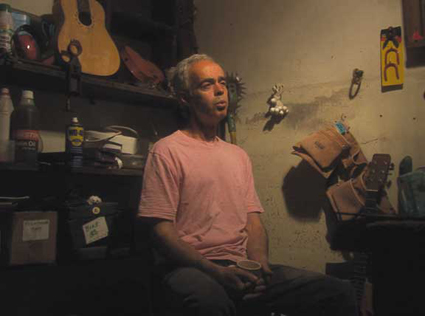
Marcus Coates, Dawn Chorus (video still)
courtesy the artist
Marcus Coates, Dawn Chorus (video still)
The latest exhibition at Gertrude Contemporary celebrates the voice in a variety of ways. At the core of the exhibition are three video installations by international artists Marcus Coates (UK), Manon de Boer (Netherlands) and Valie Export (Austria). There’s also a comprehensive listening room featuring selections of works by Australian and international artists focusing on the voice and several playlists by guest curators around particular vocal music styles. Finally, there will be a series of performances by artists such as Jenny Barnes, Alice Hui-Sheng Chang, Carolyn Connors and Tarquin Manek and a screening night curated by OtherFilm featuring Dirk de Bruyn.
Vocal Folds, curator Jacqueline Doughty, Gertrude Contemporary; exhibition 21 June-20 July; performances 27 June, 11 July, 18 July; www.gertrude.org.au/exhibitions
RealTime issue #115 June-July 2013 pg. web
© RealTime ; for permission to reproduce apply to realtime@realtimearts.net
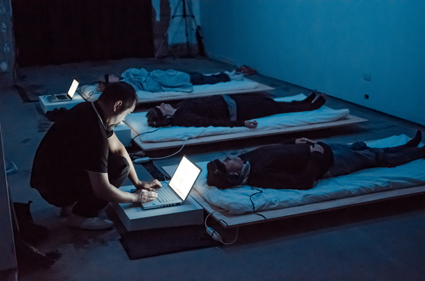
George Poonkhin Khut, James Brown, Theta Lab
courtesy the artists
George Poonkhin Khut, James Brown, Theta Lab
The inside of my head, as the old saying goes: “nice place for a holiday but you wouldn’t want to live there.” If one of the defining features of contemporary arts experiences is that they show us something about the way we think, then ThetaLab takes this idea to a whole other level, creating a real-time interaction between participants’ brainwaves and a responsive soundscape.
In the waiting room a wall-sized video monitor shows what’s to come: a dimly lit chamber with three futon-like beds on which three participants lie inert. Attendants quietly walk past, adjusting computer settings, keeping watch. Now and then a shaft of brighter light falls across the room as someone leaves, parting the dark curtains between the ‘pod’ and the foyer. Outside, punters are swarming around The Rocks for the final night of Vivid Lights. Here, it’s like a monastery or a health retreat, minus the whale music.
The EEG monitor is strapped around my head. Artist George Poonkhin Khut explains that over 30 minutes I will listen through headphones to a soundtrack influenced by my own brainwaves. As my mind calms, the initial loud crackle of Alpha waves will recede, giving way to other sounds. While there’s no ‘desired result,’ the system is set to respond to Theta waves, which usually occur in a state of ‘wakeful awareness,’ such as when meditating or just before sleep.
Immersed under headphones, the next half hour is challenging, illuminating and intensely interactive, considering that my body lies still and is not in communication with anyone else. It’s just me and the neurofeedback system: a half-hour mental dance of confidence, calm, impatience, frustration, surprise, wonder and occasional self-punishment in the arms of ThetaLab.
The sounds I hear range from a constant, throbbing murmur that travels through my whole body, to bell-like tones that seem to call a higher consciousness. My Alpha wave activity settles a little—the loud crackle subsides—but the beating bass tones continue, and I know my heart rate is going up, not down. I try a bit of yoga nidra relaxation—and get some bell sounds, yay! As soon as I think ‘yay’ the harsh crackle is back. This is the trick of meditation, and ThetaLab is creating an aural window into my process of ‘trying’ to achieve it. As my time in the lab proceeds, I experience a few moments of real calm, where soft roads of sound like low cello begin to hum in one ear before eluding me again. And at the end, feeling a little like I can’t drum up a Theta wave to save myself, I can only think, wow, is that what it’s like inside my head?
But seriously, as I leave the building (after ‘describing’ my experience in a blackboard drawing and completing a short exit interview) I realise: this sound, whether grumbling, crackling, smooth or harmonic, is me. It holds a mirror to who I am, in a particular situation. All the conflicting feelings are reflected; the unstoppable ping-ponging between awareness, in-the-moment-ness, thought, peace, the arts-journalist self, the curious self, the self-judging self, the playful self. And I really wish I could take it home and do it more, learn to really find those Theta waves. Co-creator James Brown later tells me that an intensive workshop of ThetaLab-—say, 10 hours a day for a week—is something the artists would love to experiment with.
ThetaLab renders a particular experience of the brain and the mind accessible—one that for all but the mystic is usually beyond perception. For me, it was challenging—but an incredibly illuminating, warm and embracing experience nonetheless. Some people fall asleep, some people access those elusive Theta waves easily. It made me want to lie down and chat to my brainwaves more often.
—————
Here’s a bit of background to Theta Lab, from a short interview with George Poonkhin Khut:
George, can you give me a brief history of Theta Lab? How/when/why did it come about?
I’ve been wanting to work with Alpha and Theta brainwaves since I first got interested in body-focussed interaction in the early 2000s, but it wasn’t something that I could pursue at the time within the context of my doctoral research, because of the very stringent human-research ethics approval process… The idea of brainwave-based interactions – as a creative practice – would have been just too much. So I focussed instead on breath and heart-rate based interactions [for an example see BrightHearts as part of Synapse: A Selection at Powerhouse], and did some private experiments with Alpha and Theta neurofeedback, with Dana Adam, a psychologist working with these technologies in a private practice.
A collaboration with Max Lyandvert and students from the NIDA Costume and Props departments in 2011 gave me the opportunity to begin exploring recent developments in affordable and easy to use brain-computer interfaces – and the Theta Lab project developed from this opportunity. [Winning] the National New Media Art Award in 2012 gave me some extra time and money to invest in affordable hardware and to commission the development of software to integrate these technologies into my existing Max-MSP tool set.
I was also very keen to work with a sound designer…. I’d been really impressed with James Brown’s approach to sound for performance – his work for Victoria Hunt’s Copper Promises and Matthew Day’s Intermission – and also his interest in multi-sensory performance and altered states of consciousness (Aisthesis at PACT); and sensed that Theta Lab would align closely with his own interests in music and live art.
What’s been most surprising or illuminating about this project
The actual experience of the work itself. We intuitively knew that it would be great to incorporate vibro-tactile sub-bass sounds into the neurofeedback sound design – but actually feeling it, in connection to the changes in the Alpha brainwaves and the way it blended with the headphone component of the sound design, was something else entirely. The unusual combination of mental and visceral action and sensation is very hard to describe, but very sensual and pleasurable.
At what stage is the work now?
Very much at the prototyping and testing phase. There’s so much more to explore with how we sonify these brainwave dynamics, and also technologies for measuring and calibrating the brainwave signals. We really hope we can find some opportunities to develop the work further over the coming 12 months – through some combination of artist residencies, living-lab type creative workshop events and live arts festival events.
What exactly are brainwaves anyway? What makes the wave?
Brainwaves are rapid oscillations in voltage (0.1Hz – 40Hz) between parts of the cerebral cortex, that can be measured with an electroencephalograph. The relative mix and power of these oscillations can be seen to vary according to mental task and process.
See George Poonkhin Khut’s article, Solace in the Sensorium as part of the RT117 Art, Wellness and Death feature.
You can also read many reviews of George Poonkhin Khut’s work in RealTime’s Media Arts Archive.
Theta Lab, George Poonkhin Khut and James Brown, MCA Shop, 9 & 10 June; http://www.isea2013.org/
This article first appeared on RT’s ISEA2013-in RealTime blog
RealTime issue #117 Oct-Nov 2013 pg. web
© Urszula Dawkins; for permission to reproduce apply to realtime@realtimearts.net
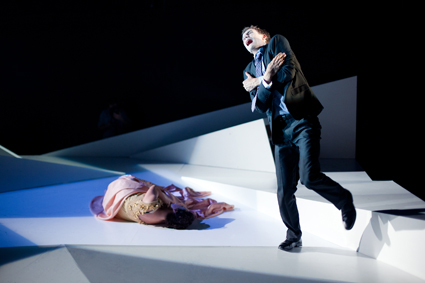
Maya Gavish, Mitchell Riley, Climbing Toward Midnight
photo Louis Dillon-Savage
Maya Gavish, Mitchell Riley, Climbing Toward Midnight
A response to Wagner’s Parsifal, using the Act II libretto, Jack Symonds’ Climbing Toward Midnight is a strange work, if blessed with excellent singing and a bracing, richly textured score for piano, viola, cello and bass clarinet with the composer conducting vigorously from the keyboard.
The transposition of Act II of Wagner’s Parsifal to our own time is not problematic in itself, but the ‘hero,’ shorn of his role in the Holy Grail quest, is cast here as a suited businessman—a rather insubstantial ‘fool.’ What remains is a secularised psychodrama in which Parsifal’s mother and Kundry, the woman intent on seducing him (which she achieves in this version), are represented by the same woman. Well, not quite. Because of a physical indisposition, the soprano (Lucinda-Mirikata Deacon) sings from a window above, while a dancer (Maya Gavish ) performs the two roles onstage.
This contextless ramping up of the Oedipal drama and the intensification of its associated imagery—Kundry as seducer, lover, corrupter and, a non-Wagnerian addition, mother-to-be (in a deliberately gross fat suit)—is further amplified by action in which the repressed is unleashed as violent action. The revelatory kiss in Wagner’s Parsifal is not for Symonds. Instead a swooning quasi-dance floor embrace to destabilising glissandi is prelude to Parsifal’s sexual sinning and his subsequent brutal rejection of Kundry, dragging her about the stage, dispersing a tonne of her lingerie, pouring sand over her (an inversion of the empty nourishment she offers him earlier), scrubbing her with bread and forcing a bottle of wine into her mouth from which obscenely froths white, not red, liquid. If Symonds’ aim is to underline the misogyny in Wagner’s opera he and his director (Netta Yashchin) well exceed the master. This Parsifal is finally a brute, far removed from his naïve antecedent and certainly unable to offer anyone redemption. Had Symonds wanted to be even tougher on Wagner he might have addressed the composer’s more problematic indicators that Kundry is a woman from the East.
The excesses of Climbing Toward Midnight are many. On a spare, white polyhedral set (designer Jessica O’Neill) that evokes an emotionally empty Arctic space (its geometric pleasures depleted by very ordinary table and chairs) the action commences sparely but is soon awash with constant, very ordinary dance movement (if by a very able and expressive dancer) that alternates with the singing from the soprano or in conjunction with it. Symonds’ challenging score needs space to breathe, for the audience to focus its attention, for the work to gain unlaboured momentum. Another layer of complication comes in the form of fragments of poetry by the German Expressionist poet Georg Trakl, difficult to absorb, let alone read through the haze that obscures surtitles placed behind the action.
Had Lucinda-Mirikata Deacon not been replaced onstage by dancer Maya Gavish, doubtless we would have seen, and especially heard, a very different Climbing Toward Midnight. Deacon’s singing is at once powerful and mellifluous, a highly nuanced indicator of the range of Kundry’s feelings, which, as danced, are choreographically one-dimensional. Mitchell Riley’s Parsifal is finely sung, acted and bravely moved, but restricted by the role’s limitations. This character’s curiosity, submissiveness, confusion and anger are without anchor, lacking something like the Christian Mysticism that underpins Wagner’s Parsifal. Regardless of the production’s relentless busy-ness, his feelings come across as abstract, and as icy as the set design (even when lighting designer Ross Graham swathes it in passionate reds and oranges).
If not one of Sydney Chamber Opera’s best, musically Climbing Toward Midnight is a work I’d at least like to hear again, for the seductiveness and melancholy of its quieter passages and an otherwise energising rawness, deceptively cloaking its complexity.
Sydney Chamber Opera, Climbing Toward Midnight, composer, conductor Jack Symonds, director Netta Yashchin; The Parade Playhouse, NIDA, Sydney, 15, 17, 19, 20 April
RealTime issue #115 June-July 2013 pg. 48
© Keith Gallasch; for permission to reproduce apply to realtime@realtimearts.net
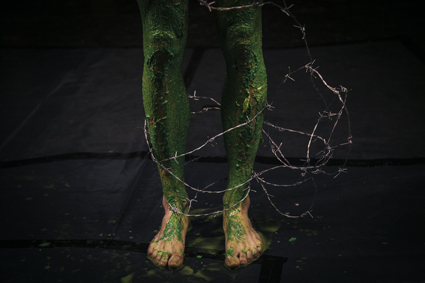
Martin O’Brien, Last(ing), SPILL Festival
photo Guido Mencari
Martin O’Brien, Last(ing), SPILL Festival
In The Body in Question, writers Ilana Cohn, Barbara Campbell, Antonella Casella and Robert Reid respond to changes in practice, presentation, expectations and artist-audience relations in performance art, circus, dance, live art and new game theatre.
Cat Jones, Julie Vulcan and Madeleine Hodge report on further unusual engagements with the body at the SPILL Festival of Performance in London.
Dancer Rennie McDougall talks with dancer and choreographer Luke George about a work-in-development, Not About Face, in which George plays medium to an audience covered in bedsheets with eyeholes cut out in a fantasy version of spirituality which will reveal “languages of movement from past teachers and choreographers, the traces of which remain present long after.”
Anne Thompson kickstarts our new series, Women+performance, a survey of the current generation of innovative contemporary performance, live art and cutting edge theatre artists across Australia, starting with an interview with Adelaide-based Tessa Leong and Emma Beech.
RealTime issue #115 June-July 2013 pg. 3
© RealTime ; for permission to reproduce apply to realtime@realtimearts.net
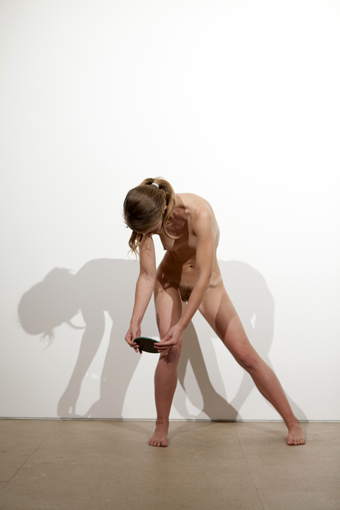
Joan Jonas, Mirror Check, 1970, re-performed for Kaldor Public Art Project 27: 13 Rooms,
photo Jamie North/Kaldor Public Art Projects
Joan Jonas, Mirror Check, 1970, re-performed for Kaldor Public Art Project 27: 13 Rooms,
When Hans Ulrich Obrist met Eugène Ionesco many years ago, the playwright told Obrist how pleased he was that his play, La Cantatrice Chauve (The Bald Soprano), had been performed every single night for over 40 years in a Paris theatre. To Ionesco’s mind, this constant staging had cemented the play as a mainstay of Parisian cultural life, enabling it to achieve the kind of permanence that normally eludes time-based performance and is instead reserved for public sculptures cast in bronze, marble or stone.
Obrist, who is co-director of London’s Serpentine Gallery, cites this encounter as a source of inspiration for 13 Rooms, a project for which he has teamed up with Klaus Biesenbach, director of MoMA PS1 in New York. Together they have created a travelling exhibition of performance art. Or, as they term it, ‘living sculpture.’ The line-up of artists includes some of the biggest names in performance from the 1960s and 70s until now, but Obrist and Biesenbach insist that 13 Rooms is not a showcase of performance art but more “like a sculpture gallery where all the sculptures go home at 6pm.”
First presented at the 2011 Manchester International Festival as 11 Rooms, and then as 12 Rooms at Germany’s Ruhrtriennale in Essen the following year, the show has been brought to our shores by Sydney arts patron John Kaldor as the 27th project to be mounted by Kaldor Public Art Projects. One new artist is added with each presentation and here it is Brisbane-based duo Clark Beaumont. They join 140 local performers reproducing the works of the international artists during the exhibition’s 11-day run at Walsh Bay’s Pier 2/3, where 12 pristine white cubes have been constructed, each containing a living and breathing work of art.
Yes, there are only 12 rooms in 13 Rooms. Many visitors are likely to remain oblivious to this anomaly because the first artwork is easy to miss: following the usual greeting that meets each visitor upon entering the exhibition space, a gallery attendant recites a headline from that morning’s newspaper. Tino Sehgal famously forbids any documentation of his art; not even a wall label accompanies this work, and it is only by listening closely to the attendant’s subsequent words—“This is New, Tino Sehgal, 2003”—that we catch a clue as to what we have just experienced. It’s a rather surreal interaction that heralds the collection of equally curious, playful and, at times, confronting works which are to follow.
A more material exchange is at the heart of Roman Ondák’s Swap, in which visitors are encouraged to exchange an object in their possession for whatever is on the table in the centre of the room, while Damien Hirst’s whimsical contribution involves a rotating cast of identically-dressed identical twins who chat cheerfully to visitors while seated beneath two of Hirst’s almost-identical spot paintings. The muscular male in Simon Fujiwara’s Future/Perfect won’t speak back however, as he lies still on a tanning bed reciting English lesson phrases from an iPod.
Opening the door to Xu Zhen’s In Just a Blink of an Eye reveals a breathing body frozen impossibly in mid-air. If it’s true that the average amount of time visitors to the Louvre spend in front of the Mona Lisa is 15 seconds, then Xu Zhen’s floating figure is more successful than most art objects in holding our attention. In fact, many of the works in 13 Rooms put into question the very act of looking—at art and at people. In Laura Lima’s Man=flesh/Woman=flesh-Flat, the visitor must crouch or lie on the ground to encounter a performer with a physical disability who is positioned horizontally within a confined opening 45 centimetres high, and the rotating dancers that make up Allora and Calzadilla’s Revolving Door demand not only a visual but a physical negotiation of the space. In Xavier Le Roy’s Untitled we actually see nothing at all; at least, that is, until our eyes have adjusted to the almost pitch black room to reveal the shadowy outlines of two hooded figures rolling on the floor in an intimate, slow-moving choreography.
The feverish diversity of works on show at 13 Rooms is an important ingredient in the exhibition’s tremendous appeal and accessibility, but they do share one common tie. With the notable exception of Clark Beaumont’s piece, they are all evidence of the increasingly popular practice of ‘delegated performance.’ Rather than using their own bodies as the site and material for their art, performance-based artists nowadays are just as likely to provide a set of instructions that enables other people to undertake their work. There is perhaps no artist working today who interrogates more explicitly both the material and representational politics of delegation than Santiago Sierra. In Veterans of the Wars of Afghanistan, Timor-Leste, Iraq and Vietnam Facing the Corner, a real war veteran stands stiffly facing the corner of an otherwise empty room, hands held behind him. Why has he or she been relegated to this position? And how are we to behave in that ambiguous presence? On the back of a t-shirt worn by one of the men I encounter is the slogan, “War IS Terrorism.” For all his apparent stoicism, this Sydney veteran has found a way to pierce through the negation and nihilism of Sierra’s instructions, to speak a protest against war and against the very silence he has been employed to enact.
Re-performance has also emerged as a hugely popular strategy over the past decade, restaging for a contemporary audience historical works previously considered to exist as non-reproducible events. John Baldessari’s 1977 video work Six Colorful Inside Jobs is reinvented here as Thirteen Colourful Inside Jobs, and 10 female performers rotate in 30-minute shifts between Marina Abramovi?’s 1997 Luminosity and Joan Jonas’ Mirror Check, first performed in 1970. The naked performer in Luminosity balances precariously atop a bicycle seat attached high on the wall. Vulnerability is belied in the way she returns the audience’s voyeuristic gaze with sometimes confronting force, making us question who of us is more exposed. The dynamics of the gaze are inverted in Jonas’ piece; the performer does not acknowledge our presence as she carefully examines her reflection in a hand-held mirror which she moves progressively down her naked body.
What is gained and lost when these historical works move away from their creators and are taken up by other people? One of the women re-performing Mirror Check is Melbourne-based dancer Atlanta Eke, who uses her naked body in her own practice to aggressively subvert conventional representations of femininity, as in her recent project Monster Body (RT114). For those familiar with Eke’s work, hers is a body that is already brimming with significations that were necessarily absent from Jonas’ quietly feminist 1970 performance. Eke’s presence in this 2013 Mirror Check highlights the inevitable diversification of the work’s meanings as it is displaced across time and space onto other performing bodies.
No longer bound to the body of a singular artist or to the fleeting moment of a once-in-time event, this is performance art made mainstream, as confirmed by the eager Sydney audiences lining Walsh Bay. Purists will nostalgically decry the loss of risk and rebellion that has proudly characterised a form that was, until recently, the underdog of the art world. But if you can manage to push past the crowds, the works at 13 Rooms still attest to the thrill of the live encounter and affirm its power to make us question our relationship to art and to others—even if here those encounters for the most part lack the presence of the artists themselves.
The only room in which the artists are physically present is Clark Beaumont’s Coexisting, which sees young Brisbane duo Sarah Clark and Nicole Beaumont sharing the top of a plinth for the duration of the exhibition. In a modest, tender portrait of the intimacy and mutual reliance that come with friendship and artistic collaboration, they channel Gilbert & George’s self-described living sculptures and render somewhat literal Obrist and Biesenbach’s curatorial pronouncements about the works in 13 Rooms being more akin to sculpture than performance. Clark Beaumont do however interrupt their statuesque posing to indulge in three 10-minute breaks per day. It’s certainly the first time I have encountered a sculpture that needed a toilet break.
Kaldor Public Art Projects, 13 Rooms, curators Hans Ulrich Obrist, Klaus Biesenbach, 11-21 April, Pier 2/3, Walsh Bay, Sydney
RealTime issue #115 June-July 2013 pg. 4-5
© Ilana Cohn; for permission to reproduce apply to realtime@realtimearts.net































































































 Academics in the humanities and the social sciences like to write about popular culture. They like to use ‘high’ theory, the accredited and validated discourse of the academy, to do so.
Academics in the humanities and the social sciences like to write about popular culture. They like to use ‘high’ theory, the accredited and validated discourse of the academy, to do so.






















 Eight artists presented their imaginary projects for the not too distant future; 2033. Performance director Nigel Jamieson, whose As the World Tipped—an impressive aerial show in Hyde Park for the 2012 Sydney Festival—was created in reaction to the Copenhagen Climate Change conference, presented an image in which future monsoons and floods in Asia result in hundreds of millions of boat people coming to Australia. Playwright Hannie Rayson took this idea further, talking about naval-like flotillas of people heading for Australia in 2033, resulting in our fighting a war to defend ourselves and ultimately losing. Australia, now Java Granda, is divided between African, Indian, Chinese and Indonesian territories, with the Republic of Australia holding on to Tasmania and a section of Victoria. Rayson proposed to create an exhibition, Birds of Passage, in the Melbourne Exhibition Centre, exploring bird and human migration [with 129 exhibits showing bird flights between the 129 nations of the Earth as trajectories for better cultural communication. Eds].
Eight artists presented their imaginary projects for the not too distant future; 2033. Performance director Nigel Jamieson, whose As the World Tipped—an impressive aerial show in Hyde Park for the 2012 Sydney Festival—was created in reaction to the Copenhagen Climate Change conference, presented an image in which future monsoons and floods in Asia result in hundreds of millions of boat people coming to Australia. Playwright Hannie Rayson took this idea further, talking about naval-like flotillas of people heading for Australia in 2033, resulting in our fighting a war to defend ourselves and ultimately losing. Australia, now Java Granda, is divided between African, Indian, Chinese and Indonesian territories, with the Republic of Australia holding on to Tasmania and a section of Victoria. Rayson proposed to create an exhibition, Birds of Passage, in the Melbourne Exhibition Centre, exploring bird and human migration [with 129 exhibits showing bird flights between the 129 nations of the Earth as trajectories for better cultural communication. Eds].













































![Soda_Jerk, The Phoenix Portal [2005]](https://www.realtime.org.au/wp-content/uploads/art/68/6806_loop_sodajerk_phoenix.jpg)













































 Opportunities for focused debate on the arts in Australia are somewhat rare. The Currency House Platform Papers series provides an important forum and addresses a range of issues around the changes or decline (whichever way you see it) in Australian arts practices and major performing arts institutions. A glance through the catalogue suggests a reasonable commitment to music from a range of voices, albeit one primarily focused on contemporary classical music and jazz.
Opportunities for focused debate on the arts in Australia are somewhat rare. The Currency House Platform Papers series provides an important forum and addresses a range of issues around the changes or decline (whichever way you see it) in Australian arts practices and major performing arts institutions. A glance through the catalogue suggests a reasonable commitment to music from a range of voices, albeit one primarily focused on contemporary classical music and jazz. 
































